
Home » Travel Guides » Poland » 15 Best Things to Do in Gdańsk (Poland)

15 Best Things to Do in Gdańsk (Poland)
Poland’s largest port flourished during Medieval times as a merchant city trading Baltic amber. In the 20th century events took place in Gdańsk that would affect the course of world history.
On 1 September 1939 the Wehrmacht launched their Invasion of Poland at the Westerplatte peninsula north of the city. And just over four decades later in 1980 Lech Wałęsa would found Solidarity.
As the Soviet Bloc’s first independent trade union, Solidarity would eventually lead to an end to communist rule in 1989. Both the war and Solidarity are remembered with world-class museums. Gdańsk’s Old Town, rebuilt after the Second World War, is a trelliswork of streets skirted by tall patrician and merchant tenements, while hulking gates defend the landward and water-side entrances.
Let’s explore the best things to do in Gdańsk :
1. Trakt Królewski (Royal Way)

To cut to Gdańsk’s core and see a host of top monuments in one walk, take this horizontal route east towards Motlawa River between two city gates.
Along Ulica Długa (Long Street) and then Długi Targ (Long Market), the Royal Way first got its royal designation in 1457 when King of Poland Casimir IV Jagiellon entered Gdańsk.
Starting in the west at the Upper Gate and finishing at the Green Gate, the way is flanked by tall, narrow patrician tenements painted in jaunty colours and capped with gables.
There are way more attractions and noteworthy sights on Trakt Królewski than we could cram into one paragraph.
But at Długi Targ 44 do stop for a photo of the Artus Court, a Renaissance meeting place and stock exchange, now a branch of Gdańsk’s Historical Museum.
Suggested tour : Gdansk Royal Route Private Walking Tour
2. St Mary’s Church

This humungous Gothic church was started in the 14th century and, with a volume of up to 190,000 cubic metres, is counted among the three largest brick-built churches in the world.
Standing in the 66-metre-long nave you’ll need to take a moment just to wrap your head around the dimensions of this epic building that can hold 25,000 worshippers.
A major reconstruction was needed after the Second World War, but all of its valuable fittings were saved.
You can peruse treasures like an astronomical clock from the 1460s, the high altar raised in the 1510s and a marvellous Gothic stone pietà carved at the start of the 15th century.
If you’re up for climbing nearly 400 steps you can battle your way to the top of the monolithic 77.6-metre main tower.
3. Neptune’s Fountain

On Long Market, a few steps from the Artus Court is an enduring symbol for Gdańsk.
Neptune’s Fountain is a Mannerist monument cast in bronze in the city in 1615, but wouldn’t be installed for another 18 years.
The sculptor was Abraham van den Blocke, originally from what is now Kaliningrad, but with Flemish parents.
Located by the palatial townhouses where Poland’s royalty would stay in Gdańsk, the fountain’s sculpture shows Neptune bowing his head slightly as a sign of deference.
On the basin beneath him are ornamental fish and cherubs.
And if you’re wondering, the fig leaf on his private parts wasn’t in the original design, but was added in a restoration in 1988.
Recommended tour : Gdańsk Private Walking Tour: Legends and Facts
4. Golden House

Staying on the Long Market, two doors to the right of the Artus Court is a building often lauded as the most beautiful in the city.
It’s not easy to disagree when you glimpse the white and gold facade.
With Mannerist architecture, the Golden House was made for Jan Speyman, mayor of Gdańsk at the start of the 17th century.
Designed by Abraham van den Blocke once more, the house has Gdańsk’s signature narrowness and height.
But where it stands out is for its sculpted friezes, 16 busts on its pilasters representing the Polish kings and the statues atop its balustrade for Achilles, Antigone, Cleopatra and Oedipus.
5. Main Town Hall

The Main Town Hall was drawn up by a team of Dutch architects in the middle of the 16th century.
You’ll have to crane your head back to see him, but there’s a life-sized gilded statue of Sigismund II Augustus, the king of the period, on the pinnacle 83 metres above street level.
The interior is also managed by the Historical Museum and has sumptuous state rooms in the Dutch Mannerist style.
The Small Council Hall, Great Council Chamber, White Hall and Winter Hall have gilded stucco, coffered ceilings, marble floors, frescoes, sculptures and tapestries . You can head to the observation gallery for a vertical view of the city and hear the 37-bell carillon chime on the hour.
6. Ulica Mariacka (St Mary’s Street)

Beginning at St Mary’s Church and continuing east towards the Motlawa River and St Mary’s Gate, Ulica Mariacka is a delightful cobblestone street edged by narrow merchants’ houses with regal portals.
You can understand why this street is often used as a shooting location for period movies, and like a lot of Gdańsk it had to be pieced back together after taking extensive damage in the Second World War.
All of the entrances to these houses are on little terraces a few steps up from the street itself, and the restaurants that line the way have tables in these cute spaces, often with ornamental reliefs on their low walls.
7. Gdańsk Crane

An emblem for the city, the Gdańsk Crane on Motlawa’s Long Embankment dates back to the 14th century.
This piece of machinery harks back to the time when Gdańsk was in the Hanseatic League, and could load or unload four tons of cargo, lifting it to a height of 11 metres.
The power came from humans, as groups of men would walk inside two large wooden wheels as if they were hamsters.
The crane doubled as a waterside city gate and was in use up to the 1800s.
Now maintained by the National Maritime Museum, you can go in to see the wheels and an exhibition about work and daily life in the port from the 1500s to the 1700s.
8. Dlugie Pobrzeze (Long Embankment)

Before the port was relocated to the mouth of the Dead Vistula River in the 19th century, this quay was where all of Gdańsk’s loading and unloading took place.
In those times defence was vital, and so there’s a “water gate” defending the entry to each of the streets running perpendicular to the river here.
These seven gates, the old warehouses on the opposite bank, and the characteristic narrow gabled houses overlooking the water, conjure old-time maritime magic.
But while the scene is now rather quaint, the docks here had a nasty reputation in the old days when thugs would prowl the quayside.
This popular tourist route has lots of outdoor seating if you’d like a meal by the water.
9. Museum of the Second World War

This landmark museum was inaugurated in March 2017 and stands on a quarter that had been flattened in the war.
It makes sense that Gdańsk should have a museum of this calibre about the conflict because the Invasion of Poland began in earnest in the Free City of Danzig on 1 September.
Many of the museum’s 2,000 exhibits were donated by families that were caught up in the conflict, putting a human face on the devastation.
The exhibitions are designed in an unorthodox way and so are difficult to describe in a paragraph, but there are many immersive walk-through installations.
One that will stay with you is a Warsaw apartment, with rooms from before, during and after the war.
There are also two tanks, a Sherman M4 Firefly and a Soviet T34, placed in war-damaged street scenes that had to be built around them.
10. Westerplatte

Afterwards you can make the brief trip to the peninsula that curves around the final bend of the Dead Vistula.
Here you’ll set foot on ground zero for the Second World War.
A Polish military transit depot was installed here in the 1920s by permission from the League of Nations, and was seen by the Germans as a vital first domino for their invasion.
With dwindling supplies and no effective way of responding to the attack, the depot withstood bombardment from the sea and for seven days before surrendering on 7 September.
After the war one of the guardhouses was restored and turned into a museum, while the others have been left in ruins.
At the highest point of Westerplatte there’s also a memorial to the “Coast Defenders”, erected in 1966 and made of 236 granite blocks rising to 25 metres.
Suggested tour : Private Westerplatte Tour by Car or Cruise Transport
11. Golden Gate

At the western end of Long Street, this beautiful Mannerist gate is in a string of fortifications in front of the fearsome Prison Tower and High Gate.
The Golden Gate is from the 1610s and was raised to replace a Gothic gate that had come before.
Abraham van den Blocke, the man behind Neptune’s Fountain and the Golden House came up with the design for this structure.
The gate has a balustrade on its roof and on both sides are four allegorical statues representing the qualities of an ideal citizen based on the classical cardinal virtues: Peace, Freedom, Wealth and Fame on the west side, and Harmony, Justice, Piety and Prudence facing Long Street.
These figures are at the top of four Ionic columns with golden capitals.
12. Oliwa Catheral

As you see it now, this church in the Oliwa District, some 10 kilometres northwest of the Old Town , dates to the 14th and 15th centuries.
A fire gutted the interior in 1577 during the city’s rebellion, so nearly all the ornamentation is Renaissance, Mannerist and Baroque.
There’s a solemn Baroque portal from 1688 at the entrance, below two narrow towers, each 46 metres tall.
The nave, chancel and 23 altars are festooned with paintings by Gdańsk’s foremost artists in the 17th century.
There are two main altars, one “Old” in the Late Dutch Renaissance style from 1605, and the other “New”, from 1688 and viewed as the finest piece of Baroque art in Pomerania.
13. European Solidarity Centre

Solidarity was a trade union and civil resistance movement founded at the Lenin Shipyard in 1980 and led by future president Lech Wałęsa.
To understand Solidarity’s context and progress you can come to the six exhibition rooms at the Solidarity Centre on its namesake square.
The centre opened in 2007 and its rusted facade points to Solidarity’s industrial beginnings.
There’s a lot of substance at the exhibition, which uses imaginative design to make sure you’re never overwhelmed by facts.
You’ll get to know the key characters, find out about Solidarity’s core philosophy and the role of the church in the movement, and also how it quickly spread to other Soviet satellite states.
14. Amber Museum

That Prison Tower dwarfing the Golden Gate has a museum all about Gdańsk’s relationship with this gemstone.
The amber deposits in the Baltic are the richest in the world, and amber helped fuel the city’s economy after a guild for this gemstone was formed in 1472. Poland’s first museum dedicated to amber documents this history, showing how it was extracted in Medieval times and how it was ascribed magical and even medicinal properties.
There’s a stunning collection of amber art from the 16th, 17th and 18th-centuries, as well as modern, artistic contemporary jewellery crafted in Gdańsk.
Check out the Jurassic Park-style “inclusions”, where insects have been trapped in this fossilised tree resin for tens of millions of years.
15. Jelitkowo Beach

After a day or two on the streets of Gdańsk you may be ready to rest up on a beach on the Baltic for an afternoon.
The closest is on the waterfront of the Jelitkowo District to the northwest of the Old Town.
This beach has a clean ribbon of fine sand backed by a chain of parks and curving for several kilometres up the coast to the west.
Behind the foreshore there’s a paved cycling path if you’d like to break even further from the city.
But wherever you are you’ll never be more than a short walk from a beach bar in summer, and there are bouncy castles and trampolines to keep littler members of the clan entertained.
You can get to Jelitkowo via trams 2, 6 or 8.
15 Best Things to Do in Gdańsk (Poland):
- Trakt Królewski (Royal Way)
- St Mary's Church
- Neptune's Fountain
- Golden House
- Main Town Hall
- Ulica Mariacka (St Mary's Street)
- Gdańsk Crane
- Dlugie Pobrzeze (Long Embankment)
- Museum of the Second World War
- Westerplatte
- Golden Gate
- Oliwa Catheral
- European Solidarity Centre
- Amber Museum
- Jelitkowo Beach

20 Best Things to Do in Gdańsk: Our Ultimate Guide
Gdańsk is a city of less than half a million people, and yet it packs a powerful architectural and historical punch. Thus, the best things to do in Gdańsk are also amongst the best to do in Poland, and visiting Gdańsk should be high on your list of cities in Poland to visit . From UNESCO World Heritage Sites to important historical sites important to all of Europe, to unique chances to experience culture, Gdańsk has it all. Additionally, there is stellar nature to enjoy in Gdańsk, including the beaches of the Baltic Sea , with some of the best beaches in Poland near to Gdańsk.
With so much to offer, it is easy to see why Gdańsk is so popular amongst Poles and foreign tourists alike, with over 2 million tourists in Gdańsk in 2022, with around 25% of those being from abroad. However, these numbers are much lower than other popular places in Europe, and if you visit in the off season, you will feel like you have the city to yourself! All in all, Gdańsk is one of my favorite cities in Poland, and I think it will become yours if you choose to visit.
Best Things to do in Gdańsk: City Icons
These attractions are the best of the best Gdańsk has to offer. All are centered in the historic Gdańsk Old Town, the first entry on the list, and the place where you will likely spend most of your time in Gdańsk. These 4 entries are, in my opinion, must-dos if you decide to visit Gdańsk. Read on to learn more about these city icons that are amongst the best things to do in Gdańsk.
1. Explore the streets of the Old Town
Description: The Old Town of Gdańsk is one of the most beautiful places in all of Poland, and thus certainly one of the best things to do in Gdańsk. What makes this part of Gdańsk unique is its architectural style! It is completely distinct from other cities in Poland. In fact, every time I go, I am reminded of Amsterdam, or Copenhagen, while walking around the Old Town. This is due to the city’s past as part of the Hanseatic League, and close ties with the Netherlands! As you walk down the streets, you will find row after row of narrow houses, which are bright and colorful, and fun to look at.
Gdańsk has been city much longer than its Dutch-influenced architecture. Since 1050, the city has existed in some form, centered around the Old Town. Whether called Gdańsk or Danzig, much of the commerce of the Baltic Sea arrived here, making Gdańsk a wealthy town, thus resulting in the rich townhouses you see now. However, these townhouses are not original. Like many cities in Poland, Gdańsk was absolutely leveled during WWII, with over 90% of the city’s buildings destroyed by bombing and fire. Thus, what you see today is a complete and faithful reconstruction, a symbol of the resilience of the Polish people.
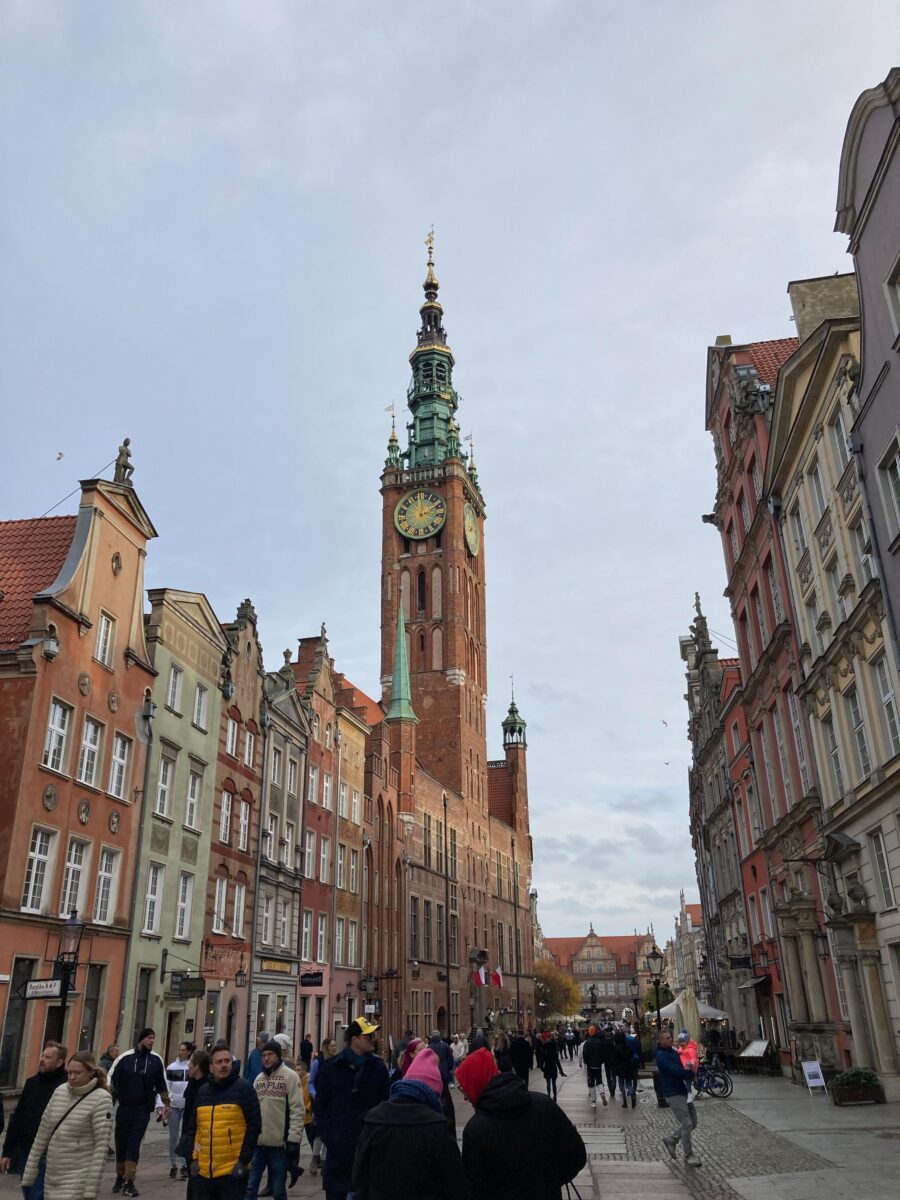
Today, the Old Town of Gdańsk is the center of everything. Each of the 2 million tourists that come to Gdańsk each year will walk the streets of the Old Town, admiring the buildings and visiting some iconic spots, some which will be listed later in this list. Much of this is centered on Ul. Długa . Running from the gold gate to the green gate, here you will find the most beautiful buildings of Gdańsk, as well as its most iconic monument, the Fountain of Neptune . Take a picture here and admire the architectural beauty. For the full experience, take some steps on ul. Piwna , and ul. Mariacki .
All in all, the Gdańsk Old Town is one of the best places to see in all of Poland, and it would be remiss to skip it on a trip to Gdańsk. It is truly the best of the best things to do in Gdańsk, a place that should leave you inspired and satisfied.
Cost: Walking around the Old Town of Gdańsk is free! However, I am sure you will stop in a restaurant, souvenir shop, or bar along the way, so any costs are of your own choice!
Hours: The Old Town is open 24/7, as people do live on these streets. The most popular times are from just before lunchtime, until after dinnertime. Earlier in the morning is the best time to walk around the city if you want to do it with more peace. Also, do note that many of the better bars in Gdańsk are in the Old Town, so at night, it might get a bit rowdy in some places, but it should never be unsafe.
Transit Information: The Old Town is well connected to other places in Gdańsk by public transport. Firstly, there are two train stations within walking distance of the Old Town. Additionally, there are multiple tram lines running to the south and the west of the Old Town, as well as many buses. These trams and buses go pretty much anywhere in the city. If you are trying to park, do note that parking is scarce. But one place you might try to park is at Forum Gdańsk , a large mall right next to the city center. Otherwise, there are parking lots spread across the city.
2. Explore the famous canals of Gdańsk
Description: As mentioned in the earlier entry, Gdańsk feels like Amsterdam. This is due to the canals present in the city! In earlier history, the mighty Vistula River flowed into the Baltic Sea near Gdańsk, but since the river has been rerouted, canals have taken over the landscape of Gdańsk. These canals are very important to the history of Gdańsk, a major maritime power and the former busiest port on the Baltic Sea! Many thousands of ships have stopped in these canals to drop off their goods, and you too should walk around the canals.
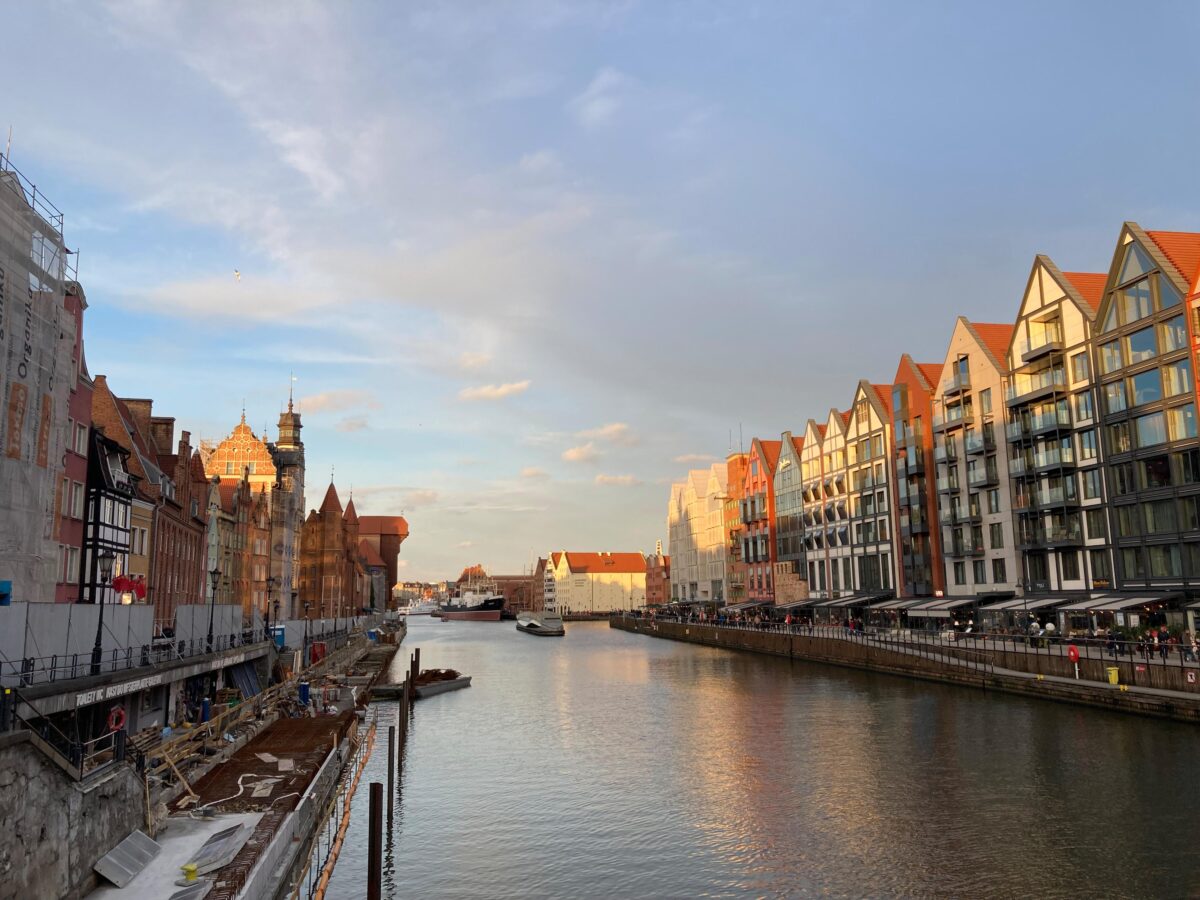
While the canals have their history in shipping, today, the canals are a beautiful place to walk, with massive townhouses lining both sides of the main canal. On the east side, after crossing Zielony Most , the green bridge, you will find a massive number of delicious restaurants to try, with stunning views of the city across the canal. One of the things to see is Stary Żuraw Portowy . This used to be a crane that lifted the goods out of the ship onto the dock below. While temporarily closed as of writing, it is still a view to admire!
Otherwise, just walk around the various synthetic islands and enjoy the views or walk across some of the bridges! These bridges are unique, in that they lift to let ships come through and dock. One is Kładka Św. Ducha , a bridge that rotates sideways to create a barrier with two shipping lanes. The other is Kładka Zwodzona na Ołowiankę , which lifts high in the sky every 30 minutes to let big ships through to the marina. All in all, the canals are a charming and romantic place to take a walk, and certainly amongst the best things to do in Gdańsk.
Cost: Walking around the canals, like the Old Town, is also free. All costs are of your own choice!
Hours: You can walk around the canals any time you like. Like the Old Town, it will be especially busy around lunch and dinner, and the most peaceful time will be in the morning.
Transit Information: Given the canals are close to the Old Town, read the earlier entry for information about transit!
3. Visit the historic Town Hall
Location | Website
Description: If the Old Town is the most iconic part of Gdańsk, the Town Hall, right in the center of the Old Town, is the most iconic place in Gdańsk. This building has been in existence since the Middle Ages, hundreds of years ago, and has historically been the seat of the government in Gdańsk, managing the ports, taxes, and keeping the city functioning. However, this building is not your bland, boring town hall. The Town Hall was built in the Gothic-Renaissance style, with gaudy towers of gold, painted clock faces, a brick exterior, and other fancy touches. And its tower towers high into the sky, making it visible from all over the city.
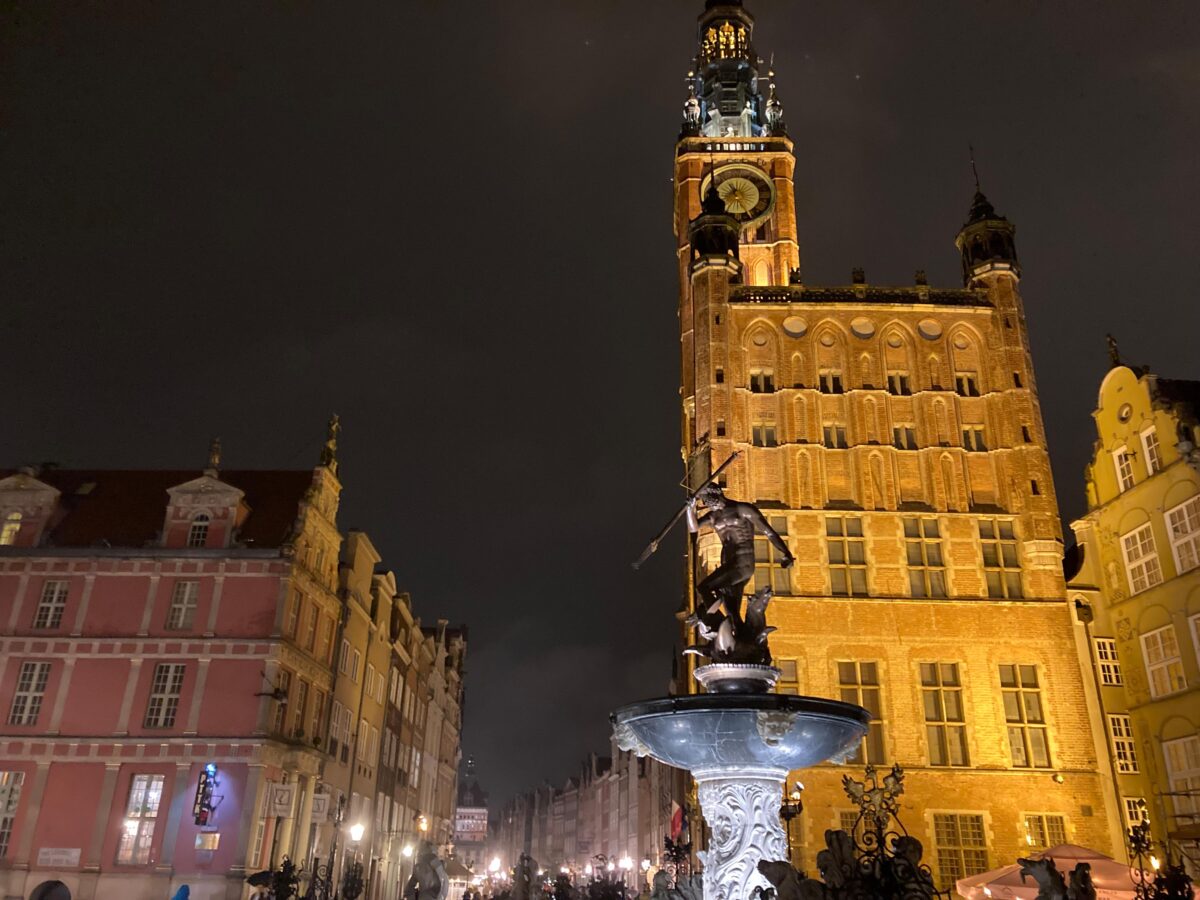
While many tourists choose to admire the building from the outside, you can also go inside via the Museum of Gdańsk . This museum tells you the town’s history through various exhibits, placed on various interior floors. This not only teaches you some interesting facts, but also gives you access to the beautiful interior of the building. Finally, if you have the legs for it, you can scale the 80-meter (260 feet) Town Hall Tower, for a panoramic 360-degree view of the Old Town, and Gdańsk beyond. I believe this view is the best you can get anywhere in Gdańsk and is worth the admission price.
The final highlight of this beautiful building, one of the best things in Gdańsk, is the historic carillon in the tower. First built in 1561, this hefty instrument plays a tune on the hour every hour (except in the middle of the night). The current edition was built in 2000 and consists of 37 bells. On Saturdays at noon, you can get an extra special treat when a professional musician plays a longer concert with the carillons. No matter where you are in the city, you are sure to hear these beautiful bells ringing and echoing through the streets.
Cost: A ticket to enter costs 23 PLN/16 PLN reduced. Or you can buy a family ticket, for 2 adults and up to 6 children, for 60 PLN. This includes admission to the view tower during the summer. Of course, you can also admire the outside for free. Finally, you can visit the interior and tower for free on Mondays. Tickets are sold until 45 minutes before closing.
Hours: The Museum is open for different hours depending on the season. During the summer (usually from June to October), the museum is open from 10 AM to 6 PM from Wednesday to Sunday, and from 12 PM to 6 PM on Mondays. During the rest of the year, those hours change to from 10 AM to 4 PM on all days the museum is open. The museum is always closed on Tuesdays and most major holidays.
Transit Information: Given that the Town Hall is in the Old Town, view that entry for all relevant transit information. Do be aware you will have to walk at least a little to get to the Town Hall, but the walk is flat and paved.
4. Climb St. Mary’s Basilica
Description: The other icon of the Gdańsk Old Town is St. Mary’s Basilica. Built in the Brick Gothic style like many other churches and buildings in this part of Poland, it is one of the largest brick churches by volume in the entire world! And this makes sense, everywhere you walk in the city you are bound to notice this looming, but beautiful Basilica. As you walk inside, you will get to experience this massive feel even more, with high vaunted ceilings above the main worship area that allegedly fits 25 thousand people (I am not so sure that would be comfortable).
Walking around the church provides you views of the gaudy side altars, artwork, and other typical Catholic church things. But overall, the building, originally finished in 1496, this church has a long history, from Catholicism, to Lutheranism, back to Catholicism, and control by Germans and Poles. You can learn a little bit about this history on the boards inside the church. You can also attend screenings of a movie about the history of the church, shown at 1 PM on Fridays in English, or otherwise in Polish every day at 12:15 PM.
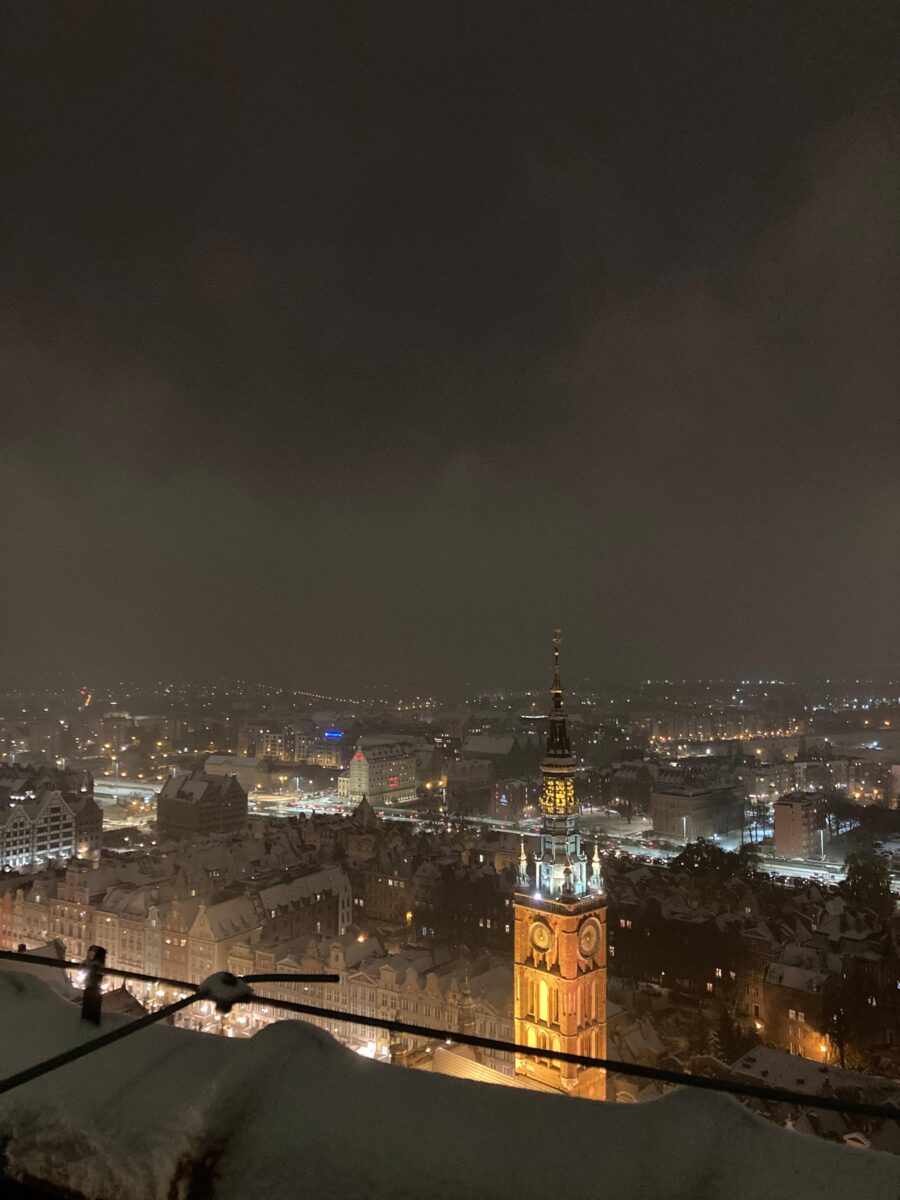
This Basilica’s final attraction is the viewing tower at the top of it. You will have to work hard for the view provided, walking up multiple claustrophobic spiral staircases, and then a full set of wooden stairs, 402 in total, to get to the top. And once there, the viewing platform is small, and in my opinion, not quite as good as the view provided by the Town Hall. But, if you are visiting in the winter, this is your only choice, and still a good choice to get an amazing view of the city of Gdańsk.
Cost: Entering the Basilica is free. You do have to pay if you want to go up the viewing tower. But the price is inexpensive. A ticket to the top costs 16 PLN/8 PLN reduced .
Hours: The Basilica is open year-round. From Monday to Saturday, you can visit from 8:30 AM to 5:30 PM (note that these hours are different on Google, but these are the hours provided by the website). On Sundays, you can visit from 11 AM to 12 PM, and then again from 1 PM to 5:30 PM. During July and August, these hours extend by one hour to 6:30 PM . Entry to the Basilica by tourists is not allowed during times of Holy Mass, unless you plan to dress nicely and attend the Mass yourself.
For the viewing tower, hours are from 11 AM to 4 PM from Monday to Thursday, and from 10 AM to 6 PM from Friday to Sunday (except during mass). The last entry to the tower is done at the listed closing time. Additionally, during bad weather, the tower will be closed to visitors.
Transit Information: As St. Mary’s Basilica is in the Old Town, view that entry for complete transportation information.
Best Things to do in Gdańsk: Museums
Gdańsk has a lot of top-notch museums to visit. While Gdańsk is not a large city, it has had some very important events, both for Poland and the entire world, start within its city limits. You can also learn about some important industries of the area, or just admire some art. Read on to learn about these museums that are some of the best things to do in Gdańsk.
5. Visit the European Solidarity Center
Description: The European Solidarity Center is an important place to visit in Gdańsk, due to the important historical moment in Poland it focuses on. Gdańsk was the center of the Polish Solidarity Movement, a movement to undermine the Polish Communist Government during the 20 th century, when Poland was a Soviet satellite state. Led especially by Lech Wałęsa , an electrician at the Gdańsk shipyard, it was an attempt to gain freedom and protest for a trade union to give better rights to workers. This was the first of many moments in the 1980s in Poland that eventually led to Poland becoming a democratic nation once again.
At the museum, you will learn all about the lead-up to this event, the details of the event, and the repercussions of the event. There are many engaging rooms, with artifacts, letters, informative signage, and video archives telling the full tale of this event. When I visited, it was easy to spend at least 2 hours at the museum, if not more. I would highly recommend a visit!
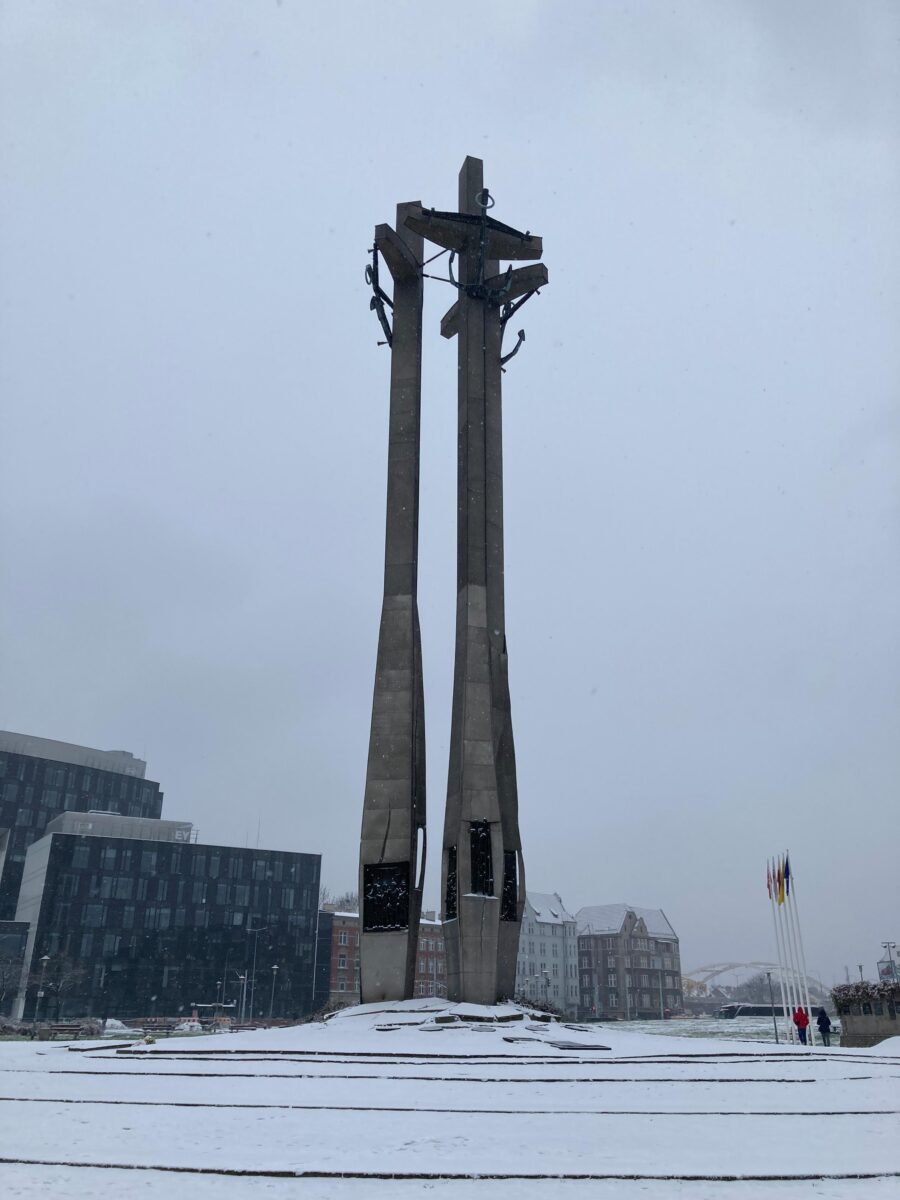
Cost: A ticket for the museum costs 30 PLN/25 PLN reduced . There are also a variety of family packages available. You can buy tickets in advance at the website listed above, but I would say you do not need to unless you plan to visit on a busy summer weekend.
Hours: The hours change depending on the season. From May to September, the exhibits are open from 10 AM to 7 PM from Monday to Friday, and from 10 AM to 8 PM on weekends. From October to April, the exhibits are open from 10 AM to 5 PM on Mondays, Wednesdays, Thursdays, and Fridays, and from 10 AM to 6 PM on weekends, with the exhibits closed on Tuesdays. Otherwise, the museum is closed on major holidays.
Transit Information: The European Solidarity Center is found just north of the Old Town. In fact, using either Tram 8 or Tram 10 from the main train station, it is only 1 tram stop north to get to the dedicated stop for the museum, Plac Solidarnosci . Otherwise, it is about a 20-minute walk from the center of the Old Town, which is a good walk, as it takes you through many other important sites of the city.
6. Visit the Museum of World War II
Description: World War II might be one of the most studied events in world history. For those of you interested in such history, or just in a very engaging museum experience, the Museum of World War II in Gdańsk is certainly one of the best things to do in Gdańsk. The invasion of Poland by German forces was the event that started WWII, and while some air raids happened in other parts of Poland, German forces first set foot on Polish territory in Gdańsk. Thus, the museum focuses on the effects of the war on Gdańsk, but also Poland as a whole, telling a complete and comprehensive story.
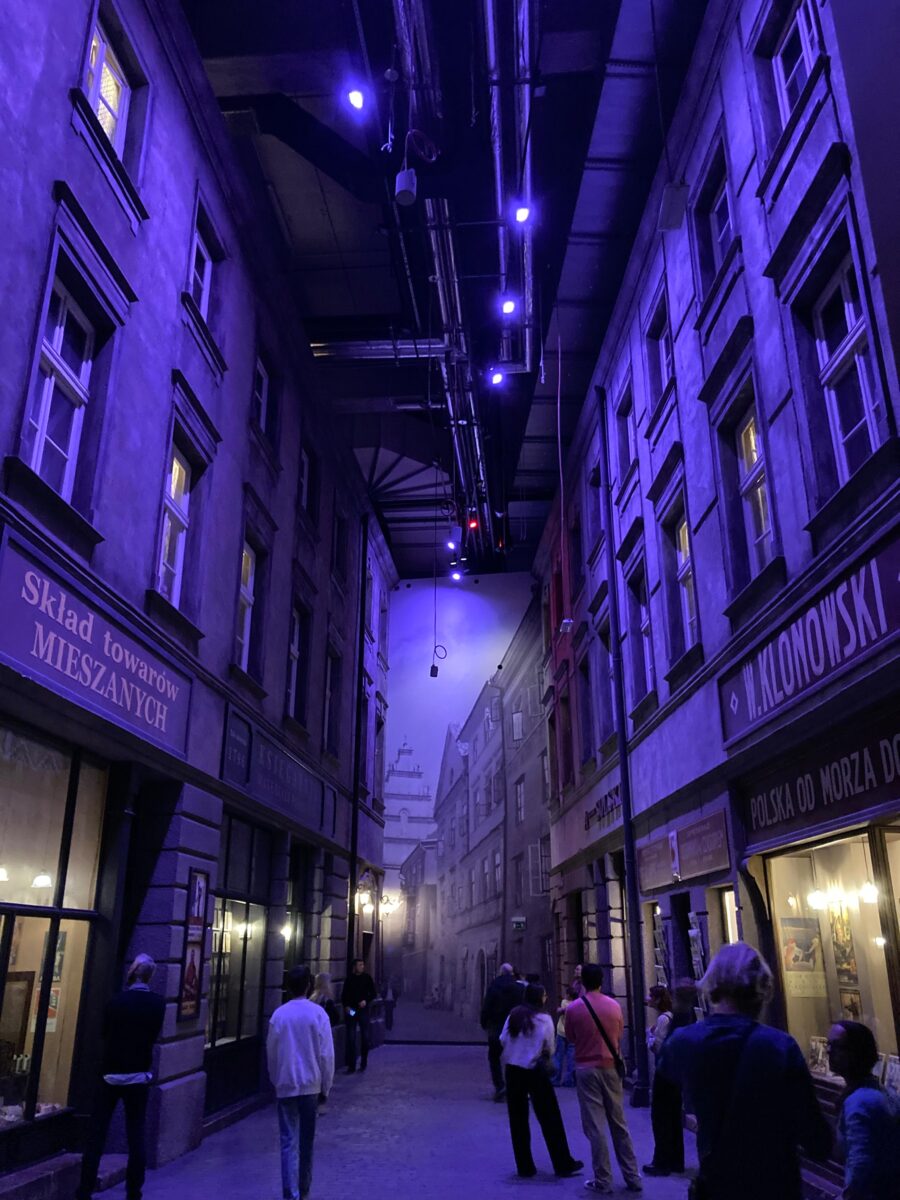
The museum is made up of almost 20 different exhibits. It starts with the uprising of fascism in European powers, and moves quickly into the invasion of Poland, and all the horrors associated with the Nazi occupation of Poland. It covers the first invasion in detail, but also what life was like in Poland during the war. It also has a large section dedicated to the Holocaust and other war crimes, and then finally a section dedicated to the ending of the war, and Poland’s quest to become whole again after the war. All in all, this museum is very good, and this museum should be at the top of your list of museums to visit in Gdańsk.
Cost: A ticket to the main exhibition costs 25 PLN/18 PLN reduced . There are also family tickets available for 60 PLN, which includes admission for 2 adults and 2 children, a savings of 26 PLN. If you want to race through the exhibition in 30 minutes, then tickets only cost 15 PLN/10 PLN reduced . Do note the size of the museum means you might want to allot at least 2 hours, if not 3, to see the entirety of the museum.
Hours: The hours depend on the season. From September to June, the museum is open on Tuesday from 10 AM to 4 PM , and from Wednesdays to Sundays from 10 AM to 6 PM. During July and August, the museum hours extend from 10 AM to 8 PM, Wednesday to Sunday. The museum is always closed on Mondays and major holidays.
Transit Information: The Museum of World War II is about a 15-minute walk north from the Old Town. Additionally, the museum has its own bus stop. There are three buses with service from the central train station, Bus 106, Bus 130, and Bus 208, each also serving other parts of Gdańsk. If you are interested in seeing the destination associated with the museum, Westerplatte (more on this location later), Bus 106 goes directly between the two. Parking, if you have a car, is scarce in the area, so I would recommend walking or using public transport.
7. Visit the Amber Museum
Description: Amber is one of the most important industries in Gdańsk. Gdańsk is oftentimes termed as the Amber capital of the world. Amber has been abundant in the area for many centuries due to the Baltic Sea practically being a gold mine for amber. In fact, the Kaliningrad area, an exclave of Russia, is full of amber. Sea winds blow amber across the Baltic Sea to the beaches of Gdańsk and the northern cities of Sopot and Gdynia. Even today, you can try to find amber on the beaches. Nevertheless, amber became an important part of Gdańsk’s wealth and trading power.
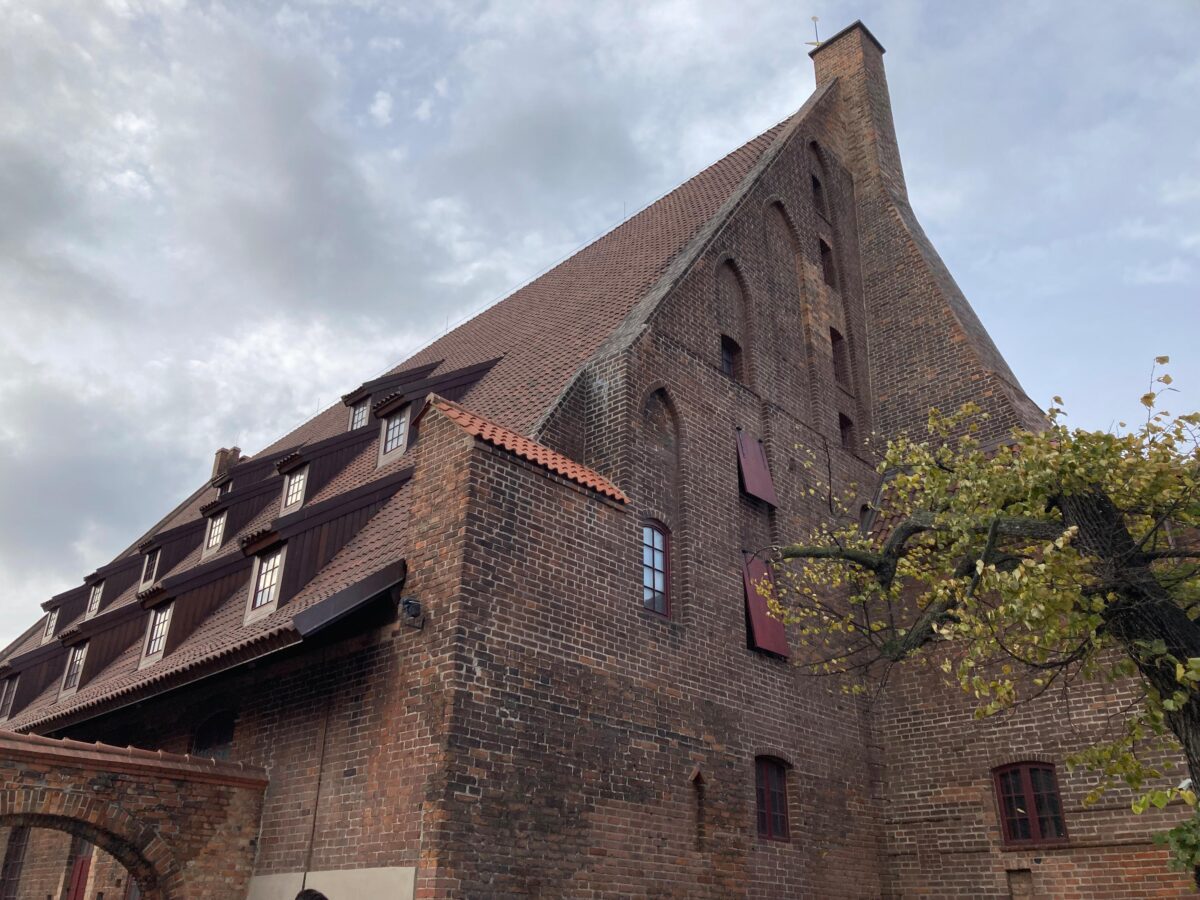
With this history in mind, the Amber Museum aims to explain all this history with engaging exhibits. Located in an old mill building found between two canals, you will find an exhibition detailing the history of amber back many years of time, and a detailed description of how amber was created. As you move upwards, you will find exhibits about how amber has been included in culture, especially in Gdańsk, and great displays of artifacts and artwork made from the abundant amber found in Gdańsk. Finally, visit the museum shop to buy a souvenir to take home! All in all, this is a great place to spend some time, and certainly one of the best things to do in Gdańsk.
Cost: A ticket costs 32 PLN/22 PLN reduced . You can also buy a family ticket for up to 2 adults and 6 children for 80 PLN. The museum is free on Mondays.
Hours: The museum is open from 10 AM to 6 PM every day except Tuesdays, when the museum is always closed. Additionally, the museum is closed on major holidays.
Transit Information: The Amber Museum is on the northern edge of the Old Town. So, view that entry on the list for complete information about getting to the museum.
8. Visit the National Museum in Gdańsk
Description: The National Museum in Gdańsk is part of a tradition of great branches of the National Museum in other Polish cities, such as Warsaw and Wrocław. while the branch in Gdańsk is not as big, or holding as impressive artwork, it is still worth a quick visit. The building itself is beautiful, part of a former monastery. Inside, you will find large collections or religious art, Polish artifacts from Gdańsk, and some special collections, such as the impressive assortment of tiles and ceramics, or one of the largest collections of tin in the world.
All in all, while this museum may be small, you should still pay a visit! It is a good way to kill time for an hour and is much less crowded than other museums in the area. Again, while it is not huge, there is still enough to be interested in! But I might recommend visiting on the free day, which is Friday, to really get your money’s worth. But this museum is still one of the best things to do in Gdańsk, especially when the temporary exhibit is a good one!
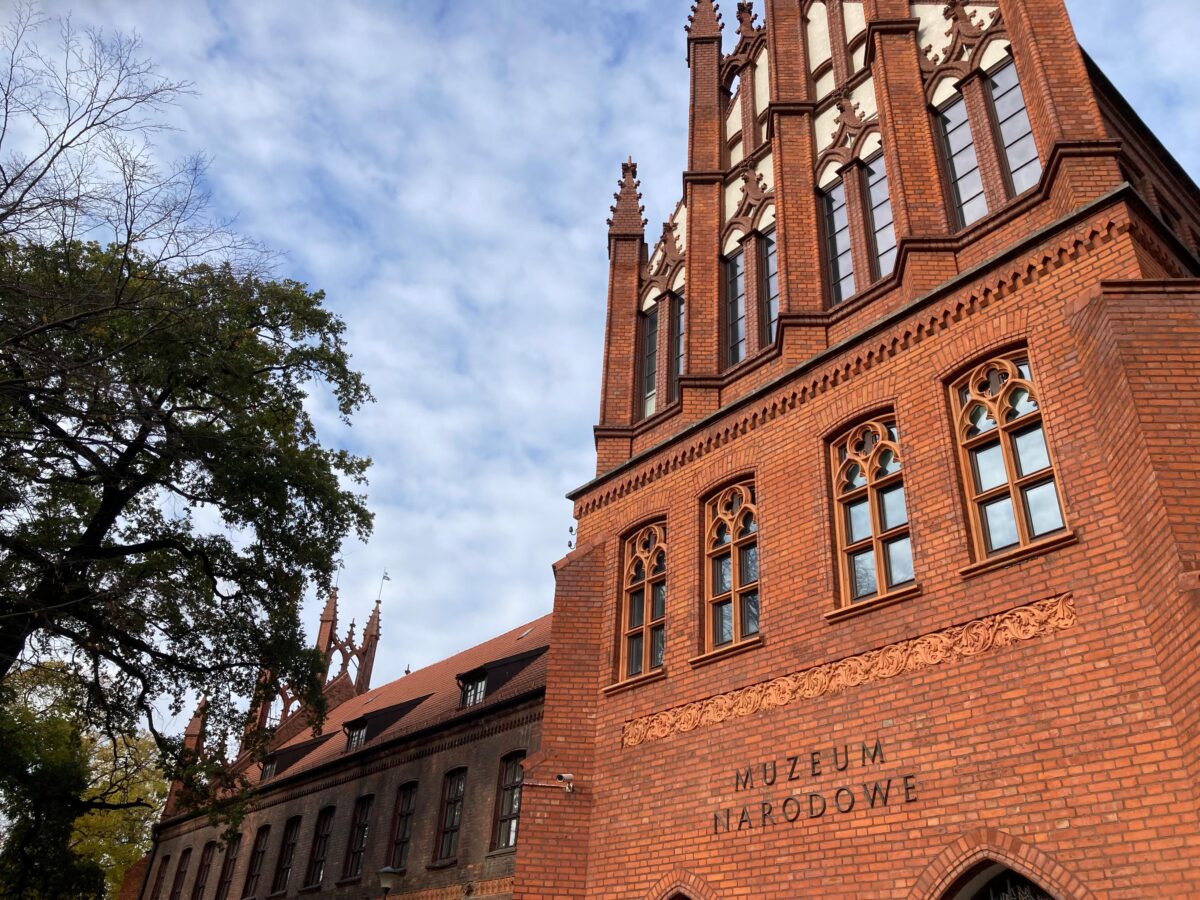
Cost: Tickets cost 20 PLN/12 PLN reduced. If you are a Polish student reading this, you get in for 1 PLN! As mentioned previously, the museum is free on Fridays.
Hours: The museum is open from 11 AM to 6 PM, from Tuesday to Sunday and closed on Mondays. The museum is sometimes open on major holidays, so check their website, linked above for more specific details if you are visiting Gdańsk on a holiday.
Transit Information: The museum is found just south of the Old Town, about a 10-15-minute walk away. There are also a couple of bus stops near it if you are arriving from other parts of town. Torunska is served by buses from almost anywhere in the city, except the north. Muzeum Narodowe bus stop is served by Bus 106 and Bus 111 from the city center. If arriving from the north, just take the regional train into Gdańsk Śródmieście train station. For parking, there is a small lot across the street to the east.
9. Visit the National Maritime Museum in Gdańsk
Description: Gdańsk has always been an important maritime center. Thus, the National Maritime Museum in Gdańsk is a must-see, one of the best things to do in Gdańsk. Here, you will learn all about the heritage of the Poles along the Baltic, with the museum’s goal to protect this heritage as a major cultural institution of Poland. Upwards of 350 thousand people visit this museum every year, and there are many different exhibits to visit. The main location is the Granaries on the east side of the canals, home to the major exhibits detailed the history of maritime activities in Gdańsk, and Poland.
Other places to visit of note included the SS Sołdek ship, the oldest remaining post-WWII seagoing ship in Poland. It has a storied history as a workhorse of Polish commerce. You can learn all about this history while onboard. Additionally, you can cross the canals to the Maritime Cultural Center, a more modern exhibit where you can visit two permanent exhibitions, one about people, ships, and ports, and the other about boats of the world. This center is attached to the old crane mentioned previously, which is currently under renovation. All in all, this museum supplies a lot of information, and has many fun engaging exhibits, making it worth your time.
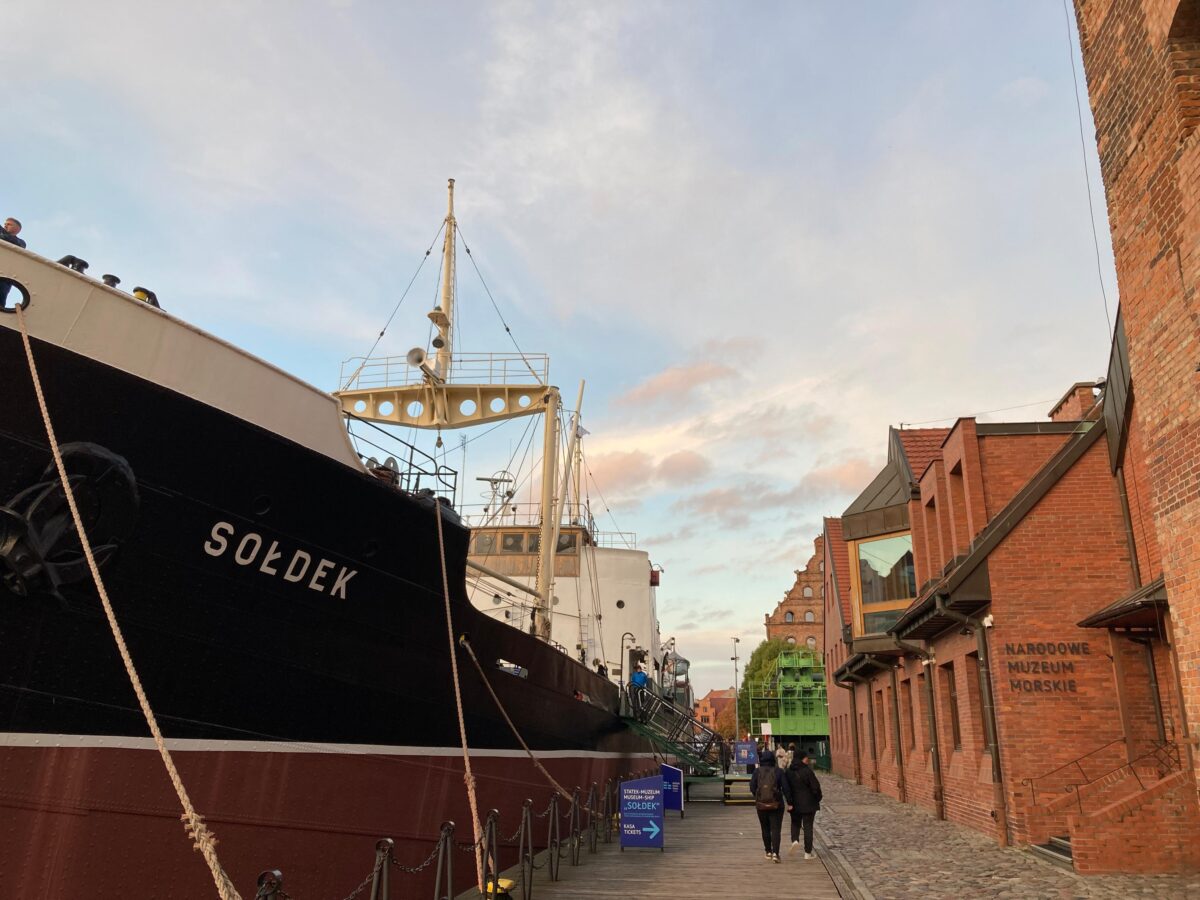
Cost: Tickets can be bought for various places at the museum. Tickets to the permanent and temporary exhibitions cost 15 PLN/10 PLN reduced. On Wednesday, these exhibits are free. For just the temporary exhibitions plus the Maritime Gallery, tickets cost 10 PLN/8 PLN reduced. To board the ship, you will have to buy a joint ticket with the permanent and temporary exhibits, for 47 PLN/35 PLN reduced . Tickets to the Maritime Cultural center cost 17 PLN/13 PLN or 20 PLN/15 PLN depending on which exhibit you choose. To add the Cultural center to everything else, you will pay 64 PLN/48 PLN . Visit the website for more information about this complicated ticket scheme.
Hours: The hours of this museum are unpredictable and change quite often. For this reason, please visit the website linked above for the hours. There is no clear pattern about when and why they are changed, with sometimes even the opening days being changed from one week to another. But, except the museum to only be open for short hours in the winter during the week, and for slightly longer on weekends, and for longer hours throughout the summer.
Transit Information: The museum is along the canals of Gdańsk in the Old Town. So, please view the prior entry on the Old Town for information about getting to the museum.
Best Things to do in Gdańsk: Outdoors
Gdańsk is also in a beautiful part of Poland. From beaches to tree-filled hills ripe for hiking, those of you who are nature lovers will find some lovely things to do. And best of all, this nature is easily accessible using Gdańsk public transportation. Read on to learn more about these outdoor treasures, amongst the best things to do in Gdańsk.
10. Walk around Westerplatte
Description: Westerplatte is one of the most important historical sites in all of Europe, one of the top landmarks of Poland , and one of the best things to do in Gdańsk. Westerplatte pairs nicely with a visit to the Museum of WWII, as the German land invasion started at the army bastion found on the Westerplatte peninsula. Here, a small cohort 180 of Polish soldiers fought bravely against the 570 Nazi invaders, succeeding in holding them off for an entire week. The Poles fought so bravely that the commander of the Polish forces, Major Henryk Sucharski, was allowed to keep his sword as he was taken prisoner.
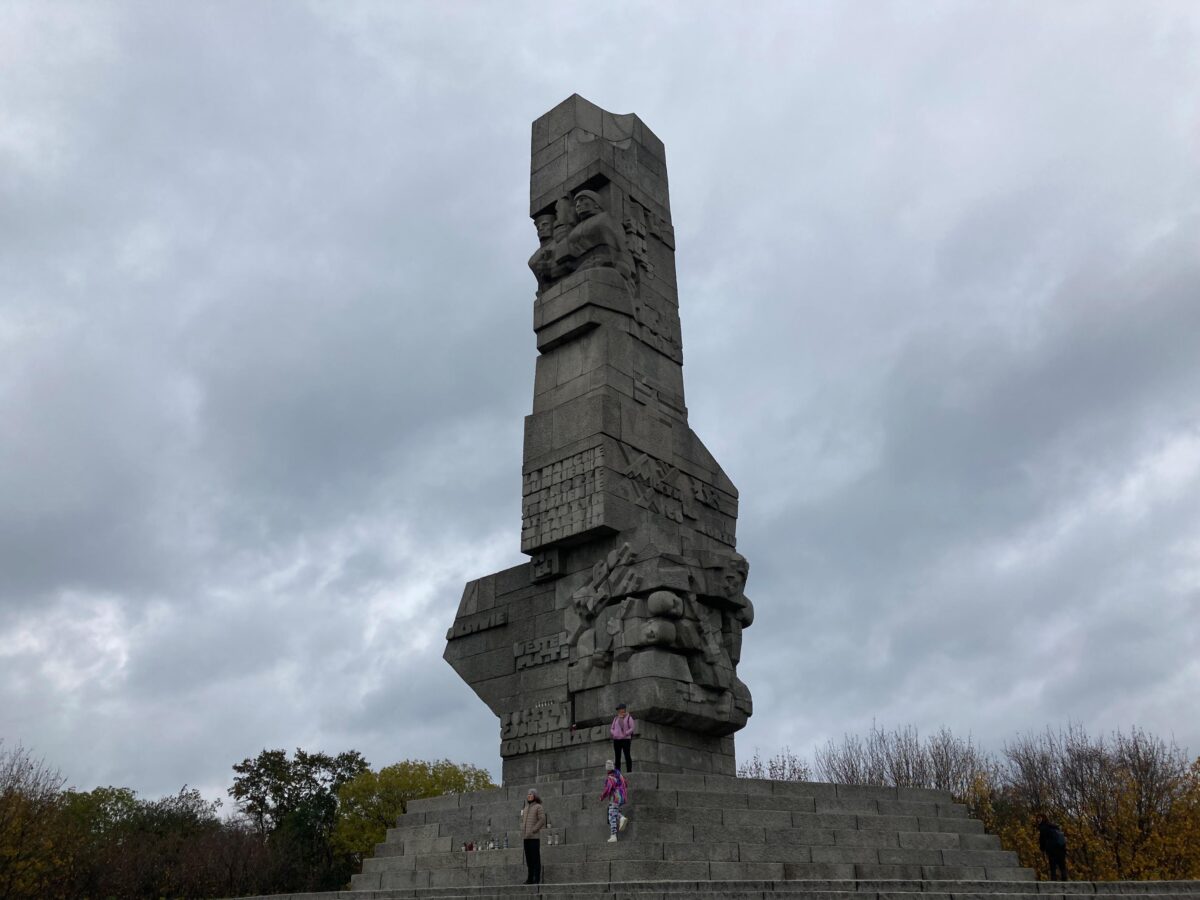
Today at Westerplatte lies an imposing stone monument dedicated to all the victims of WWII, with symbolism also present to stop all future wars. Additionally, as you walk around, you will find signs with more details about what happened at Westerplatte during the war, remains of the old fort of Westerplatte that was bombarded mercilessly, and the mass grave site of the many Poles who died fighting protecting Westerplatte. There is also a nice promenade where you can walk along the beach for quite a long way. All in all, Westerplatte is a must-do when coming to Gdańsk, both for history, and the quiet and solemn nature present at Westerplatte.
Cost: Walking around Westerplatte is entirely free!
Hours: Westerplatte is open 24/7, as it is part of a public park. Note that going at night is a bad idea, as you will have to take an expensive taxi to get home if you do not have a car.
Transit Information: Westerplatte, while not far in terms of actual distance from the city center, takes quite a while to get to. For public transport, you can take Bus 106 from the main train station, or Bus 138 from the same place. Both take long winding routes on the way there that means a trip to Westerplatte requires about 45 minutes by bus. Also note that during the offseason, these buses run quite infrequently, so you will have to spend at least an hour there, if not more, before being able to get a bus back. Also note there is no ticket machine at Westerplatte, so buy your transit tickets in advance.
The best way to get to Westerplatte is by car. There is ample parking space, which may cost between 5-10 PLN depending on the season and how long you plan to spend. Another choice is the Westerplatte tourist ferry that leaves from near the Old Town along the canals and takes you on a short boat ride to Westerplatte. However, this choice is quite expensive, at 75 PLN/60 PLN reduced for a round-trip ticket, which is almost 10 times more expensive than a bus ticket, and still takes 40 minutes. Thus, only do the ferry if you want the experience.
11. Tan on Jelitkowo Beach
Description: Jelitkowo Beach is a beautiful stretch of sandy beach north of the center of Gdańsk, the best beach Gdańsk has to offer, and one of the best beaches in all of Poland . It is slightly less busy than some of the more famous beaches nearby, but still equally beautiful, with stunning views of the Baltic Sea. And it is easy to get to via public transportation, and with the changing rooms and showers provided, you do not have to worry about having a car to enjoy swimming and tanning at this beach.
Additionally, there are a few things to do in and around the beach. On the outskirts of the beach is the wooded President Ronald Reagan Park , a nice place to take a breather amongst the trees, with playgrounds, sports fields, and many trails and places to relax to appreciate. Furthermore, if you continue to walk south along the beach, you will make it to Brzeźnie Pier , a free pier that is a perfect place for a photo or to watch the sunrise. Otherwise, just enjoy the sandy stretch the beach has to offer. Jelitkowo Beach is truly one of the best things to do in Gdańsk.
Cost: Jelitkowo Beach is free to take advantage of.
Hours: Jelitkowo Beach is open all hours and days of the year. However, it only makes sense to enjoy the beach during daylight hours. And, during the winter, the weather will not be the most pleasant you have ever experienced. I would recommend getting up early or staying up late to watch the sun rise or set for an amazing experience.
Transit Information: The best way to get to Jelitkowo Beach is to take a tram. Trams 2, 6, and 8 all run to the Jelitkowo tram stop, from the main train station in Gdańsk, as well as other major points in the city. This journey takes about 40 minutes. Your other choice is to take a regional train to Gdańsk Oliwa train station, and then take Bus 143 to the Jelitkowo stop. Otherwise, you can also drive, but parking is sparse.
12. Admire Oliwski Park
Description: Oliwski Park is a beautiful green space found in a quiet part of the city often missed by tourists! During my first visit to Gdańsk, I had a local show me around, and was impressed! Oliwski Park is certainly one of the best things to do in Gdańsk, and you should not skip it. The history of the park is based on the history of the Oliwski Stream that runs through it, where monasteries were headquartered as far back as the 10 th century. In the 16 th century, these monks created a garden that became popular for famous visitors, such as Polish kings.
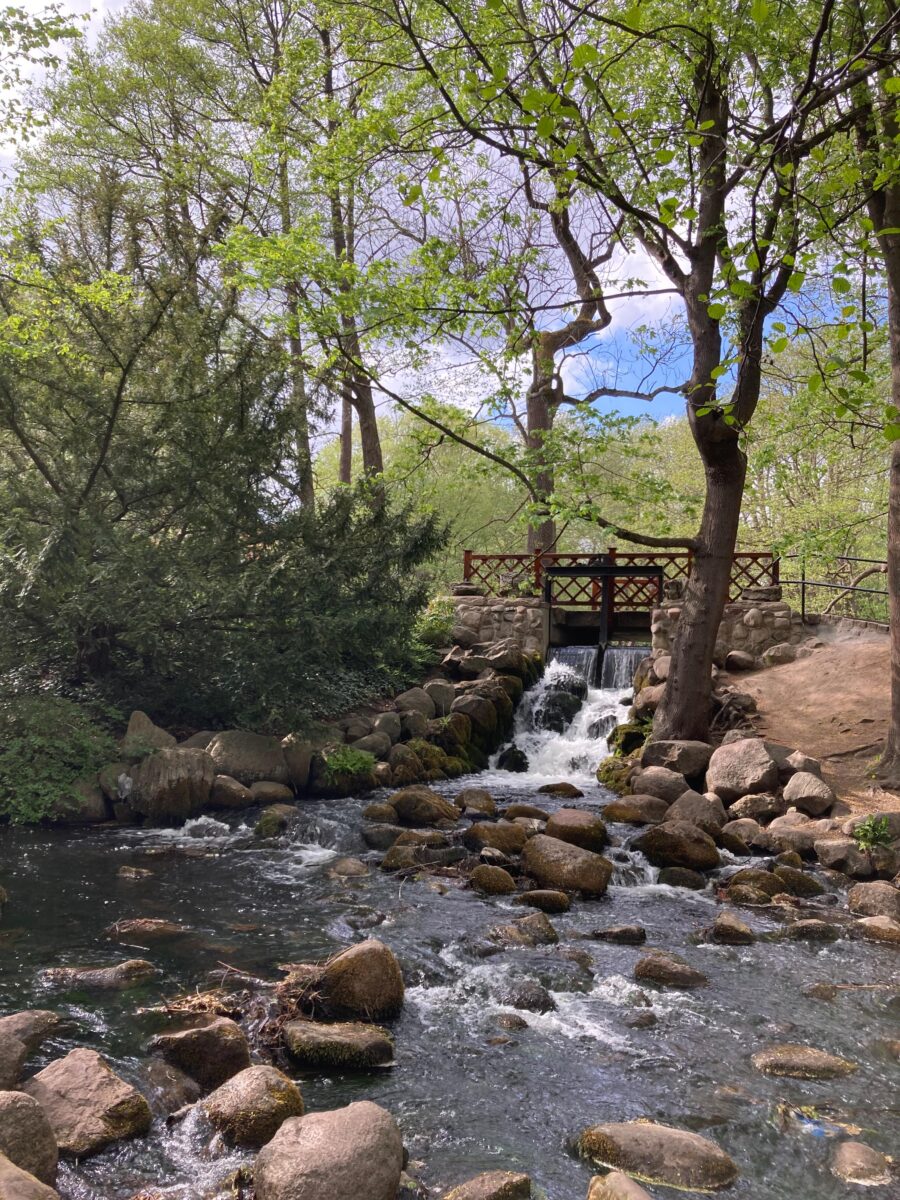
Eventually, it became open to visitors in the 18 th century, and has been open ever since. Within the park, you will find a bunch of beautifully manicured gardens, rows of trees covering wide paths, ponds and streams, and even little waterfalls. Special gardens include the English and Chinese Garden, the Japanese Garden, and the Botanical Garden. There is also a Palm House on site where you can admire the plants of warmer climates.
The other attraction within the park is the Oliwska Cathedral , a beautiful baroque and rococo church, full of gaudy art and other religious iconography. A step inside is a step back in time. Overall, Oliwski Park is the best park experience you can get in Gdańsk, and it is entirely free! Do not miss it if you have the time.
Cost: Entry to the park, the Palm House and Cathedral is free!
Hours: The park is open from May to September from 5 AM to 11 PM, and from 5 AM to 8 PM from October to April. The Palm House is open from Tuesday to Sunday from 10 AM to 6 PM and is closed on Mondays. I could not find hours for the Cathedral, but assume similar hours to the Palm House, with its being closed to tourists during Mass on Sunday.
Transit Information: There are a lot of options to get to the park. Firstly, there is the Gdańsk Oliwa train station, which is a short walk from the park. Additionally, Trams 5, 6, and 12 serve the Oliwa tram stop from all over Gdańsk, with Trams 6 and 12 directly from the central train station in Gdańsk. Finally, there is some paid parking available, with small lots next to the Cathedral.
13. Climb Pachołek Hill
Description: Found near Oliwski Park, Pachołek Hill is one of many hills west of Gdańsk. In fact, the entire west side of Gdańsk is forested hills, full of beautiful hiking trails. It is yet another area skipped quite often by tourists, which is a mistake in my opinion. But, if you have the time, and are already at Oliwski Park, climbing to the top of Pachołek Hill is worth it. You start by walking up ul. Tatrzanska, and then start climbing up the hill through a peaceful forest.
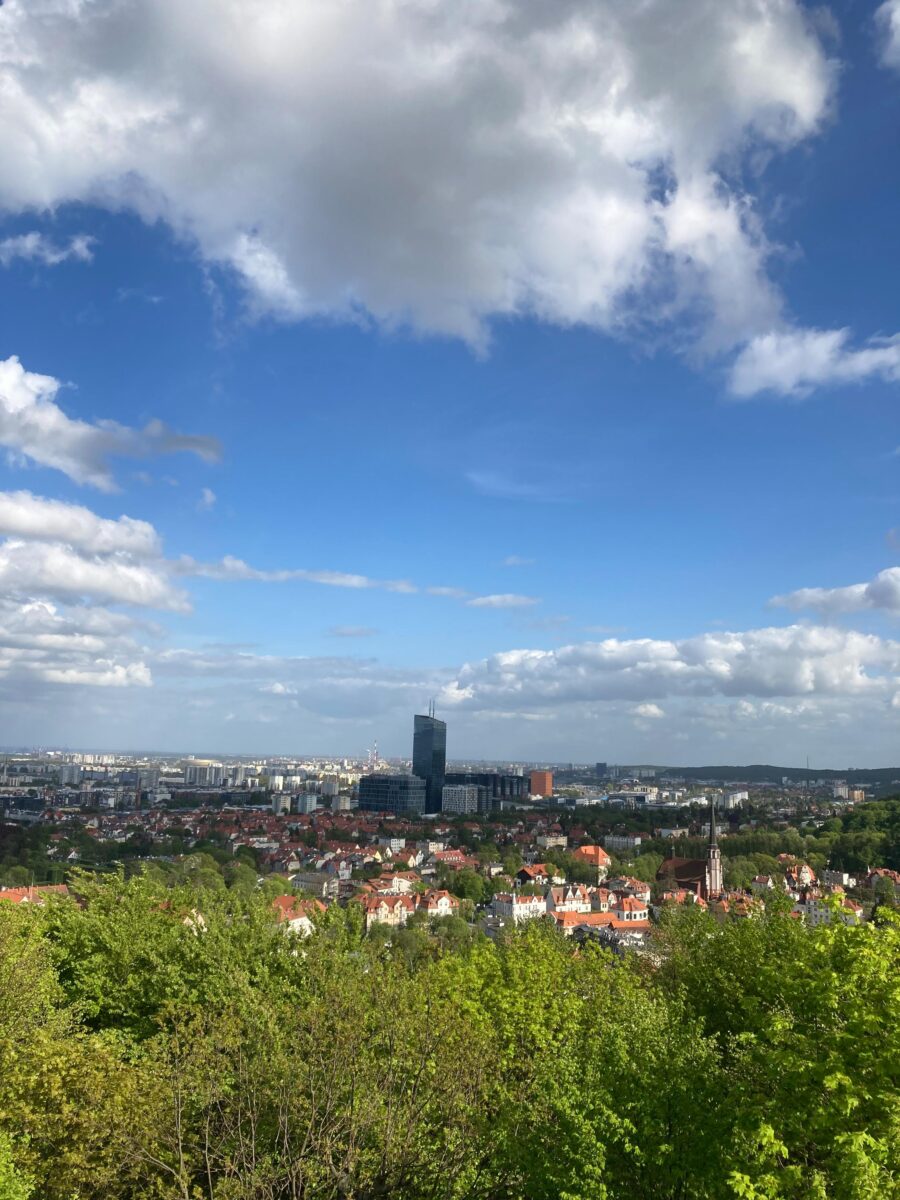
As you get to the top of this 107-meter (350 ft) hill, you will have a 15-meter (50 ft) observation tower to climb. At the top, you will be treated to stunning views of Gdańsk and the Baltic Sea! With the foliage cleared a bit to make the view even better recently, now is a better time than any to appreciate these amazing, 360-degree and entirely free views! Once you are done with the tower, climb down to Staw Młyński for a cute pond that may or may not have beavers, swans, and ducks. All in all, the climb up Pachołek Hill is a treat, one you should not skip.
Cost: Pachołek Hill is entirely free to use!
Hours: Pachołek Hill is accessible at all hours of the day and all hours of the year! Just be careful in rainy and icy weather while climbing the tower.
Transit Information: As Pachołek Hill is right next to Oliwski Park, follow the instructions for that entry to get to this location!
14. Explore the Bastions of Gdańsk
Description: For a final underrated outdoor excursion that I recently tried, consider visiting the Bastions of Gdańsk. The Bastions used to be part of the extensive fortification system that protected the southern part of what is now the historic Old Town of Gdańsk. Originally built in the 17 th century, these Bastions, from the air, look like the bottom of a star, with a distinct zigzag pattern of canals, and fortifications. Today, 5 Bastions remain, mostly named after animals.
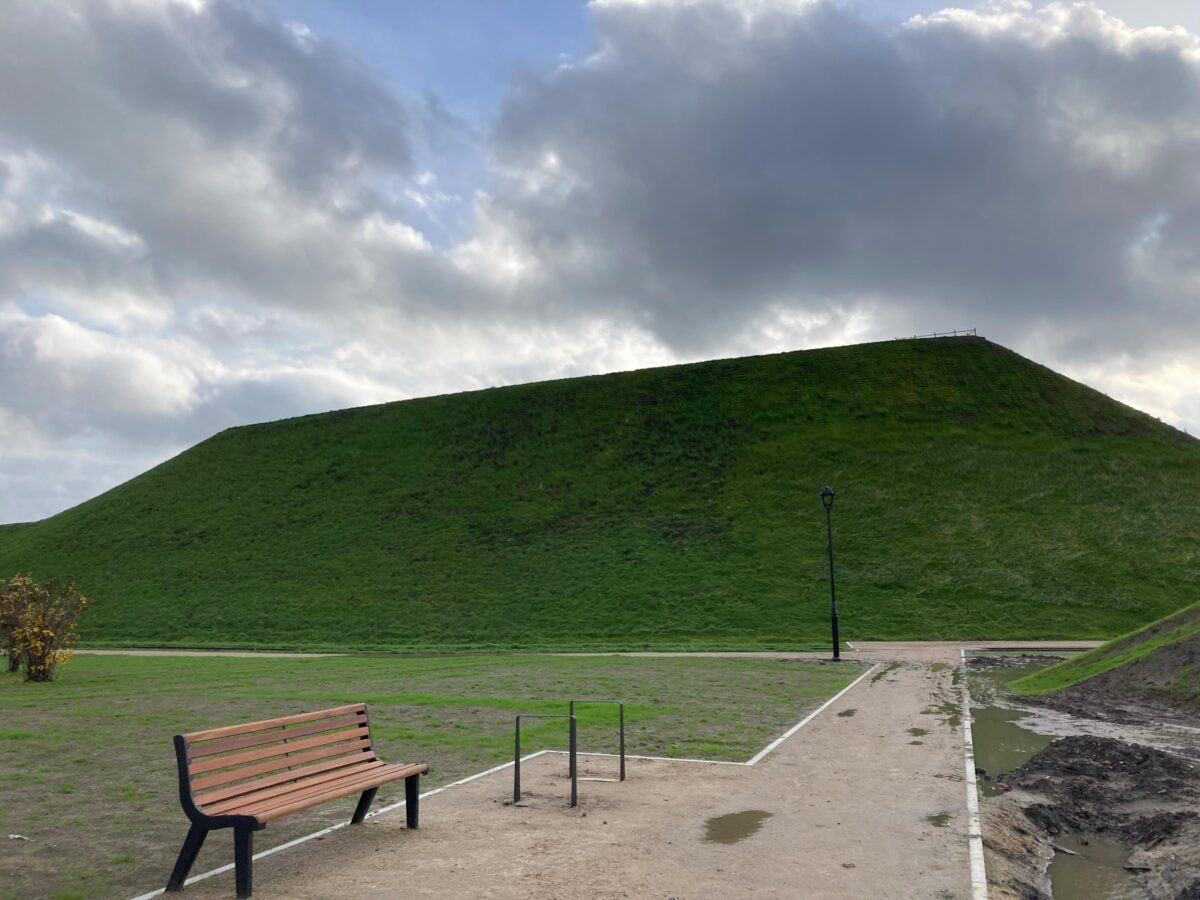
The appeal of the Bastions today is how quiet they are. Despite being only about 15 minutes away from the Old Town, when I visited recently, there was almost no one there, except a few locals walking their dogs. This is a great place to ride a bike up and down the canals. Additionally, with some new renovations soon to be done, there will be some artificial mounds in place with great views of the city. Come visit before this place gets popular!
Cost: The Bastions are free to explore.
Hours: The Bastions are open 24/7. Do note that some are under renovation right now, and are not open, but should be open soon based on when I last visited (as of November 2023).
Transit Information: You can take the bus to Bram Nizinna , taking Bus 123 from the main train station. Or you can take Bus 106 or 111 from near the main train station to Wróbla , and then walk a short distance from there. There is also a small amount of street parking available by Bastion Żubr .
Best Things to do in Gdańsk: Attractions
If you are looking for some more touristy things to do in Gdańsk, these next entries fit that bill, without being a huge tourist trap (like a haunted tower, or a wax museum). These exhibits can be kid friendly, or even a chance to experience the amazing Polish culture. Read on to learn about these attractions that are amongst the best things to do in Gdańsk.
15. Visit Gdańsk Zoo
Description: Visiting the Gdańsk Zoo is a great opportunity if you have children! With affordable tickets, and almost 150 different species of animals. This zoo has been around since the 1950s, supported by the people of Gdańsk and the surrounding area ever since then. In fact, the zoo had almost ended before it even started, when funding ran out. But the citizens of the area donated money to keep it going, including the children of nearby Sopot donating 1 PLN each! Today, the zoo is dedicated to preserving animals, especially those endangered, with the zoo taking part in a project to breed the vulnerable Andean Condors for example.
Today, the Gdańsk Zoo should be your number one destination if you have children. Not only are the many cool animals to see, such as lions, tigers, elephants, giraffes, penguins, and even the illusive European Bison, there are lots of other activities. From a zoo train to a ropes course, to fun photo booths, there is lots to keep your family entertained throughout the whole day. Thus, I recommend the Gdańsk Zoo as one of the best things to do in Gdańsk, especially for families!
Cost: The ticket prices depend on the month. You can buy regular tickets, discounted tickets for children and students, and a family ticket for 2 parents and 3 children. From November to March, these tickets cost 20 PLN/15 PLN/55 PLN . From April to June, as well as September and October, these tickets cost 30 PLN/25 PLN/90 PLN . Finally, in July and August, they cost 40 PLN/35 PLN/120 PLN.
Hours: The hours for the zoo are very complex, so I recommend checking the website for complete details. Typically, expect the zoo to be open from 9 AM to 3 PM in the winter months, 9 AM to 5 PM in the spring and fall (with extended hours on weekends), and from 9 AM to 7 PM throughout the busy season in the summer. Last entry with a ticket is 1 hour before closing.
Transit Information: The zoo is located near Oliwski Park. Thus, take a tram or the regional train to the Gdańsk Oliwa area. Starting at Oliwa 07 , you then take Bus 169 for about 7 minutes to the zoo stop. Alternatively, there are also lots of massive parking lots, mostly just grassy lots, near the zoo if you would like to drive. This will cost you money, however, but you can pay at machines with cash or card.
16. Got to a Lechia Gdańsk Football Game
Description: Lechia Gdańsk is the largest, most popular, and most successful football club (or soccer for my fellow Americans) in Gdańsk. With rabid fans, going to a match is a unique experience if you have never been to a European football match before. Make sure to wear green and white upon attending for the best experience, or you can buy some gear at the team shop before entering the stadium. While this team has had great success in Poland, at time of writing (November 2023), Gdańsk was recently relegated from the top Polish league Ekstraklasa and are struggling. But attending is still a fun experience!
The stadium Lechia Gdańsk plays in is also a big draw. Polsat Plus Arena Gdańsk was opened in 2011 and was built to be used for the 2012 Euro Championships hosted by Poland and Ukraine. If you want to avoid the rowdy atmosphere of an actual match, you can also just take a guided tour of the stadium. The guided tour will allow you to see much of the stadium, including locker rooms, media rooms, walking on the pitch, and more. Additionally, there is a viewpoint on the stadium that you can also buy a ticket for! Overall, there are plenty of activities to choose from that make visiting Lechia Gdańsk one of the best things to do in Gdańsk.
Cost: The ticket price for a match depends on the opponent. As of writing, tickets are a likely a bit cheaper due to Lechia Gdańsk’s recent relegation to the Polish 1 st League. A stadium tour ticket costs 25 PLN/18 PLN reduced per person, or 18 PLN if for some reason you are arriving with a group larger than 15 people. Finally, a ticket for just the viewpoint of the stadium costs 13 PLN and is free for children 4 and younger.
Hours: The hours are completely variable, depending on the match time. Do be aware that it can take a while to get to the match due to increased traffic to the stadium, so give yourself enough time to make it. Additionally, if you want to take a tour, the time is decided based on which day you choose to visit. Tours are typically for one hour in the afternoon. Additionally, you can only reserve a spot on a tour in the same month as you plan to visit.
Transit Information: From the Gdańsk central train station, you can get to the arena in about 15 minutes via Tram 3, 7, or 10, arriving at the Stadion tram stop. There is also a lot of parking surrounding the stadium if you choose to drive.
17. Ride the AmberSky Ferris Wheel
Description: The AmberSky Ferris Wheel is an icon in the Gdańsk skyline, sitting on the east side of the canals, right behind the Gdańsk city sign. Named after the amber that is abundant in Gdańsk, riding this 50-meter (165 ft) Ferris Wheel is no more special than any other. However, it is still a great experience, as you can get some great views of the city skyline while going around. I recommend riding at sunset for the best experience, especially on a clear day.
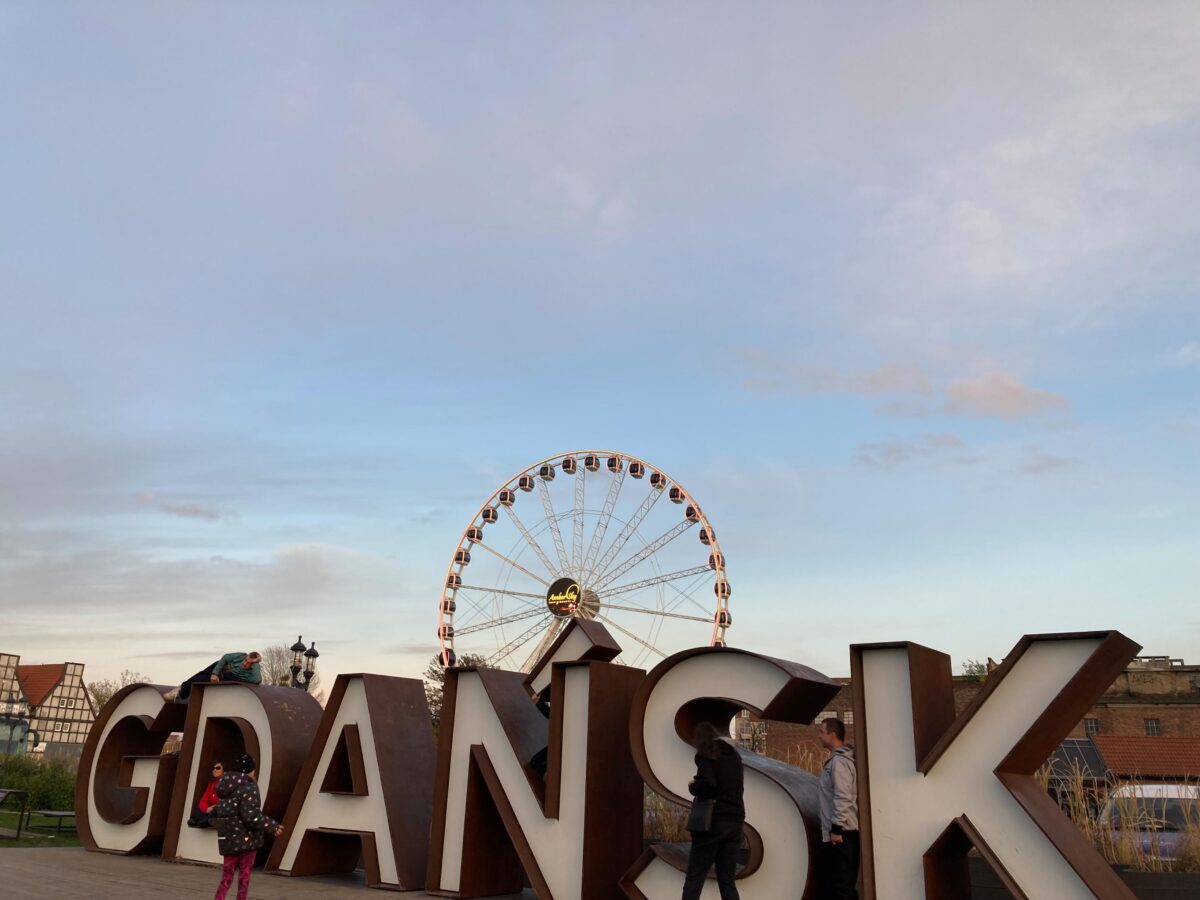
In my experience, you will get at least 5-6 full rotations of the wheel, with multiple stoppages, so that you get 15-20 minutes on the wheel. This is ample time to enjoy the views. Maybe you will even see a pair of foxes playing on a nearby rooftop as I did one time! Additionally, the carriages are heated or air-conditioned, so it is a nice respite depending on the weather outside. So, do not skip the AmberSky, it is one of the best things to do in Gdańsk.
Cost: A ticket costs 37 PLN. If you have a child less than 1.40 meters tall (around 4 ft 7), they only cost 27 PLN . Children 3 or under are free. There is also a student discount available on Mondays down to 27 PLN during the school year.
Finally, there is a VIP experience that you can also choose from! You will be treated to a 30-minute ride with armchairs, a TV, a full glass floor, and even a mini-fridge with Prosecco if you would like. This costs 350 PLN for the entire cabin, or 400 PLN if you want the Prosecco included.
Hours: The Ferris Wheel is open every day. From Monday to Friday, it is open from 10:30 AM to 10 PM. On Fridays and Saturdays, it is open from 10:30 AM until Midnight. Finally, on Sundays, it is open from 10 AM to 10 PM .
Transit Information: The AmberSky Ferris Wheel is found along the canals of the Old Town, so view the entry for the Old Town to learn how to use public transport to get to the Old Town, and thus the Ferris Wheel. There is, however, a large parking lot right in front of the wheel if you need to park.
Best Things to Do in Gdańsk: Day Trips
While Gdańsk certainly has a lot to do, its location is near some other amazing landmarks of Poland means you should take advantage of this and take a day trip somewhere. Below, you will find three-day trips that are possible, including one that is technically still in the Gdańsk city limits. While there are certainly more, these three are the most interesting, in my opinion.
18. Visit Sopot
Description: Sopot is a charming city found north of Gdańsk. It is the middle city of the three cities part of the Trójmiasto , wedged between Gdynia (a city that is not too exciting to visit) and Gdańsk. Sopot has been visited as a tourist destination since the 19 th century, when it was established as a health spa. Today, millions of tourists still visit Sopot each year to admire the sparkling Baltic Sea, as well as the Sopot Beach . Many tourists also choose to walk up and down the Sopot Pier , the longest wooden pier in all of Europe.
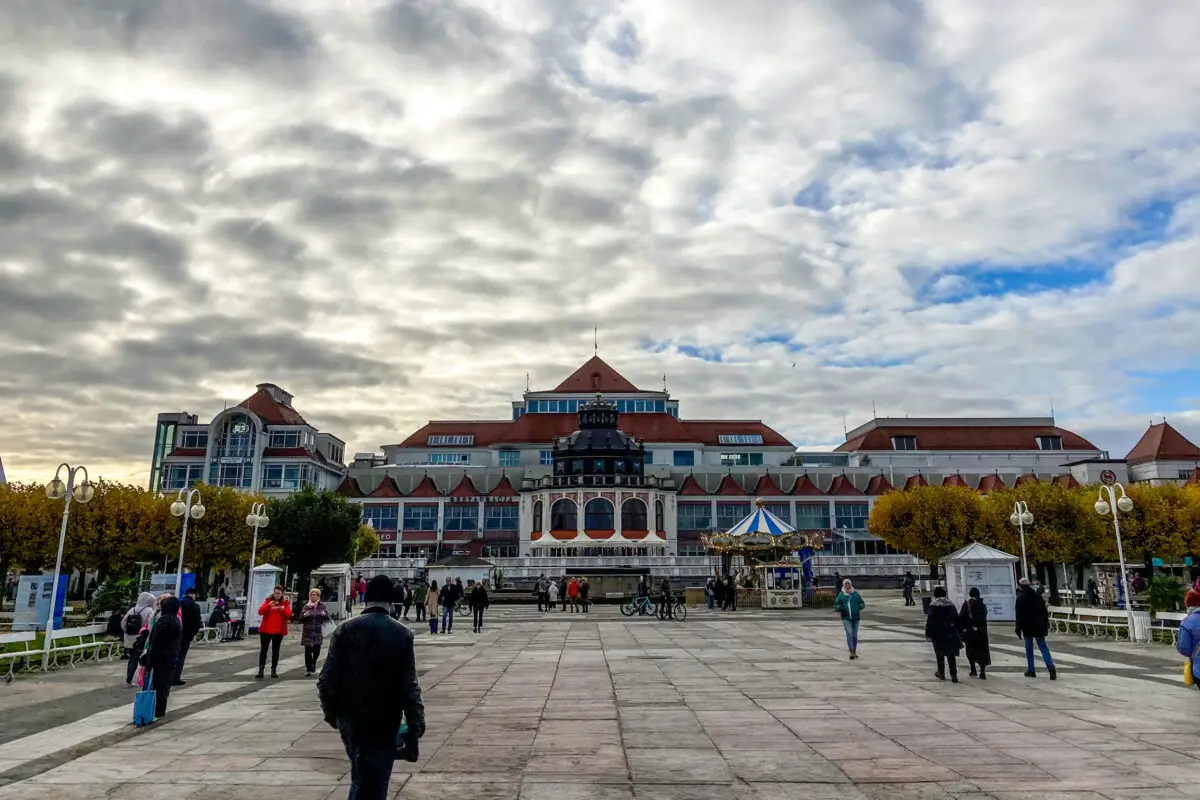
Beyond the beach and the pier, there is much else to do in Sopot. Walking up the main promenade on ul. Bohaterów Monte Cassino will take you past many shops and restaurants worth a visit. Some other sights on the promenade include Wojtek the Bear , a statue commemorating the Polish soldier bear who “fought” in WWII, and Krzywy Domek , a crooked building that now serves as a small shopping mall. Other attractions to consider are a bike ride along the beach, visiting a museum such as the Sopot Museum , or relaxing at a spa at Aqua Park Sopot .
For a complete guide to Sopot, view the recently published blog article about Sopot !
Cost: How much you spend in Sopot depends on your budget! A typical meal will cost between 40-70 PLN. Entry to some of the museums and the pier will probably cost you around 20-25 PLN per person. Otherwise, all costs will be what souvenirs and snacks you buy along the way.
Hours: Check each individual attraction in Sopot for hours. However, the pier in Sopot is often open 24 hours, as is the beach.
Transit Information: Getting to Sopot from Gdańsk is easy. You can take one of the SKM trains from any train station in Gdańsk to Sopot. From the Old Town it takes about 20 minutes by train and costs around 5 PLN. I would not recommend taking a bus, as it takes a long time compared to the trains and is not much cheaper. If you want to drive, there is parking throughout the city, but it is limited, so getting to the city early increases your chances of snagging a spot!
19. Explore Malbork Castle
Description: Malbork Castle is an impressive landmark within a short train ride of Gdańsk. Thus, when visiting Gdańsk, I highly recommend taking a trip down! Malbork Castle is one of the largest castles in the world. What makes it most impressive is that it is built entirely out of brick. The castle’s beautiful coppery color is what makes it stand out, as well as its impressive walls, gates, and grounds. The castle is the work of Teutonic Knights, who used Malbork to protect their lands for many years, before selling the castle to the Polish royal family, who then made it a royal residence.
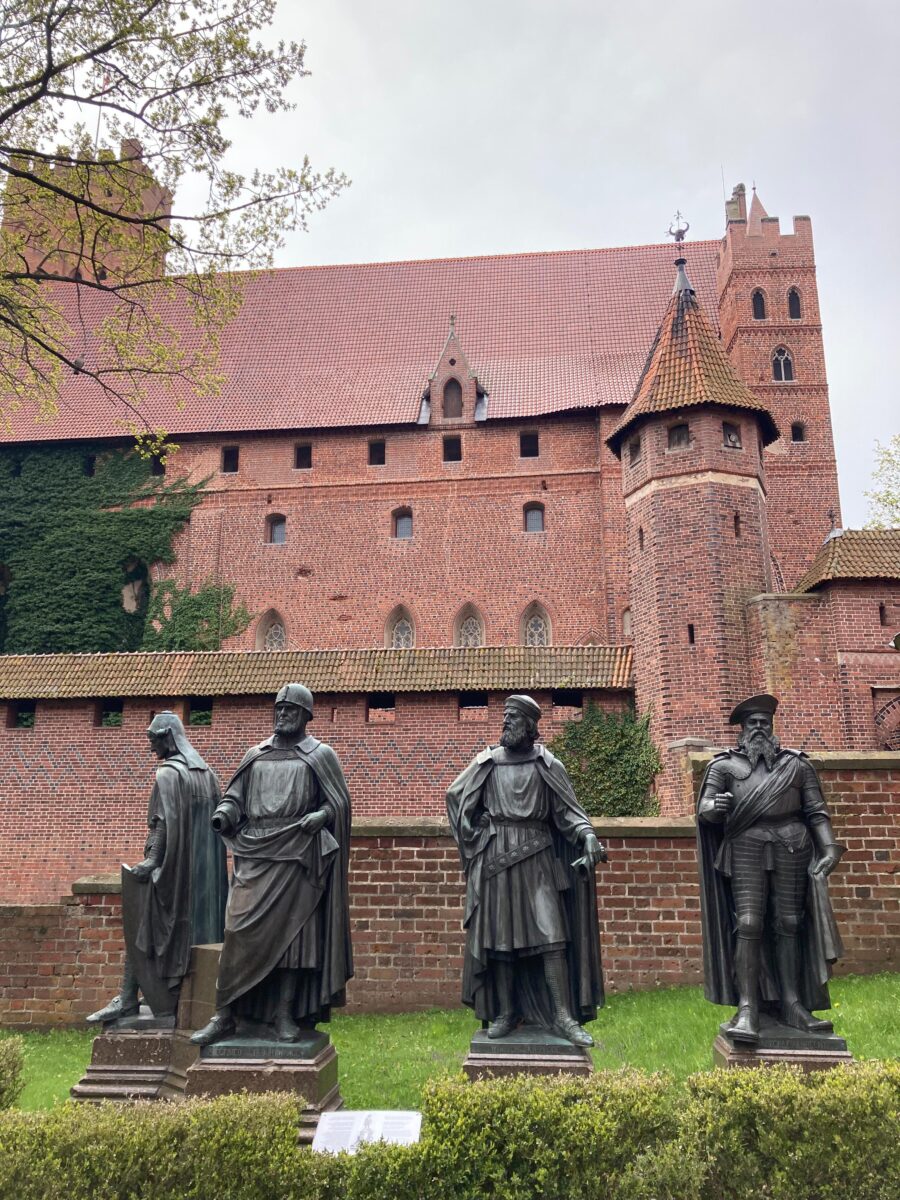
When visiting now, you start by walking across a drawbridge, through a gate, and into the central courtyard of the castle. From here, you walk from room to room of the castle, learning about the history of the Teutonic knights, the Polish royal family which lived here, and the many wars fought around the castle. You will also see what artifacts remain from the original castle, as well as large collections of artworks, weapons, and more. Then, you can walk some of the outdoor routes of the castle to get amazing views of the next-door river. All in all, Malbork is a must visit when in Poland, and Gdańsk is the perfect place to start you journey to Malbork from.
Cost: The cost of admission is on the pricier side, at 70 PLN/50 PLN reduced . But, considering the number of things you can see with this ticket, I feel it is more than worth it. Additionally, if you have a family of four with two adults and 2 children, consider buying the 2+2 family ticket for 220 PLN for a small savings. I recommend buying tickets online in advance, especially if visiting during a holiday, or on a summer weekend. Otherwise, you may be stuck in a very long line waiting for the tickets.
Hours: The hours for Malbork are inconsistent based on the season and each individual attraction at the castle. I would recommend visiting their website linked above for the schedule on the day you plan to visit.
Transit Information: From Gdańsk, it is about a 30-minute train ride to Malbork. You can use the regional train service, which takes slightly longer, or maybe find a cheap inter-city service. Otherwise, you will have to drive, with there being a very large parking lot on site at the castle.
20. View the mouth of the Vistula River
Description: As mentioned in prior entries, the Vistula River is one of the most important rivers in Poland, but especially to Gdańsk. Originally, the river flew through Gdańsk into the Baltic, but today, it has been engineered to enter the Baltic 21 km (13 miles) away from the Gdańsk Old Town. This has helped reduce flooding in the Gdańsk area significantly. Today, visiting the mouth of the river is still possible as a day trip, despite the distance from the city. You can visit the mouth at the Mewia Łacha Reserve , which protects the area on the left bank of the Vistula as it enters the sea.
The reserve is home to lots to do. You can walk along the sandy beaches, or along the trails through the forest. There is also the opportunity to see lots of nature, including a population of Baltic seals, who use the beach by the river to relax, and eventually breed. There is also one of the largest populations of gulls here, and lots of other birds to find. During the summer, the reserve offers on-site experts to learn about the birds. Otherwise, just walk along the beach, or watch the sunset from the viewing tower. This place is beautiful, peaceful, and an important place in Poland, so visiting it while in Gdańsk is worthwhile if you have the time!
Cost: Visiting the nature reserve at the mouth of the Vistula River is entirely free! Take out all your trash to keep the beach a nice place for future visitors.
Hours: You can visit the nature reserve at the mouth of the Vistula River any time you want throughout the year. Just keep track of the bus schedule so you do not get stranded! And even so, there are two different night buses at midnight and 3 AM that will get you back to the city if you really want a late night on the beach.
Transit Information: Even though the mouth of the Vistula is quite a distance from the center of Gdańsk, it is still technically in Gdańsk, and thus there are city buses that reach it! You can take Bus 112 from the central train station to the stop Przystan 02 in about 45 minutes, and then it is about a 3 kilometer (2 mile) walk to the beach from there. If you want to go to the east side of the mouth, there is a ferry that runs every day to cross the river. Once crossing, it would be a similar walk to get to the beach. Even when driving, you must park in the Swibno neighborhood and walk from there.
Best Things to do in Gdańsk: Conclusions
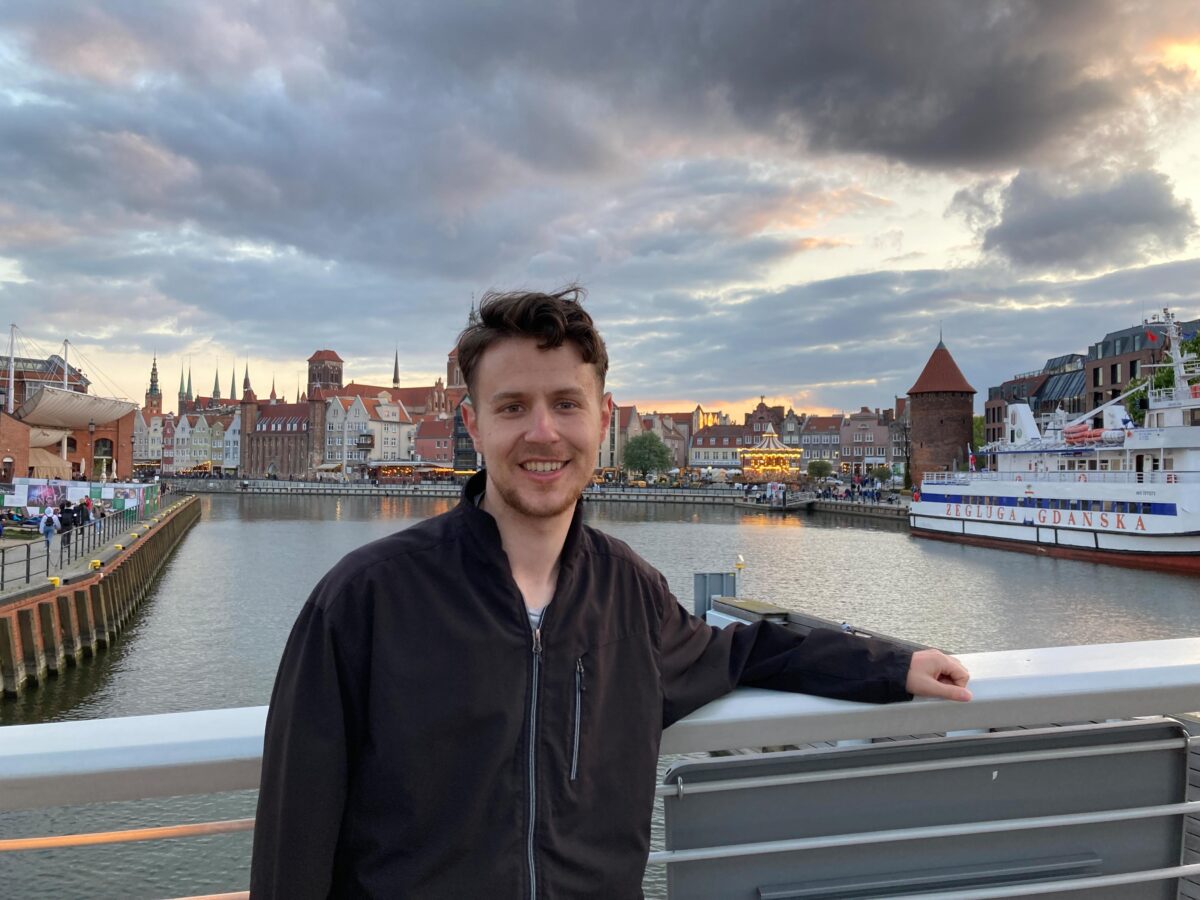
Gdańsk truly is a lovely city. There is a reason I have made 4 separate trips to visit it, and I still have not seen all the city has to offer. Not only is the city beautiful, and a completely different feel from other Polish cities, the people there are extremely kind! There is so much to explore, and I would recommend visiting Gdańsk as soon as you can! Finally, below you will find a short description of some final important things to know about traveling to Gdańsk! Look out for some future articles about restaurants and hotels!
Getting to Gdańsk: Gdańsk is served by its own international airport with flights from all over Europe. The airport is served by Gdańsk’s public transportation, so you do not need to use a taxi to get to and from the airport. Additionally, the recently renovated Gdańsk Główny train station, an icon itself, will get you all over Poland via train. You can also choose to rent a car and drive to Gdańsk, it is a manageable guide. For some specific information on how to get to Gdańsk from Warsaw, read this article .
Getting Around Gdańsk: Gdańsk has decent public transportation, that is rapidly improving. There is a network of trams and buses that will get you almost anywhere. But, as many of the main attractions are in the center, walking will be your main mode of transport. But, if you need to use public transportation, a warning! Tickets are hard to buy! As of writing this, it looks like Gdańsk is going to soon introduce a way to buy tickets on the bus, but as of writing this, you can only buy tickets at ticket machines, or on apps!
You can find bus ticket machines at most major tram and bus stops, including at the central train station. On these you can buy single-use tickets, or longer-term tickets if you plan to stay in Gdańsk a while and use the transport a lot. However, some important places you might want to visit, like Westerplatte, do not have ticket machines. Instead, you can buy tickets through some mobile apps. My favorite is Jakdojade , but you can also use GoPay, moBilet, MPay, Skycash, or Zbiletem.
Be warned that often the apps will ask for authorization from your credit card, so make sure the app will be able to text your number a security code so you can buy! And contact your bank in advance to inquire about whether this might happen or not.
Another great public transportation choice is MeVo . This is a bike sharing service available as an app with English-language options. On MeVo, you register, pay a small 10 PLN fee, and then are allowed to reserve bikes for up to 2 hours per day entirely free! There are stations throughout Gdańsk, so you might find this is the best choice for getting to a place you want to visit, or just to take a leisurely ride around beautiful Gdańsk! Do note that if you do not leave the bikes at the proper station, you will get charged a 10 PLN fee.
Safety in Gdańsk: Poland is a very safe country ! In Gdańsk, you should also not have to worry about your safety. You will find people trying to coax you into your restaurant with flyers or trying to get you to take a picture with an owl or hawk, but these are not scammers, they are rather entrepreneurs. I would just be careful at night in the Old Town sometimes, as this is where any rowdy drunk people might hang out (no judgement if you want to join!).
Hotels and Restaurants: Look out for future, more detailed, articles on these topics! Gdańsk has lots of great hotels and Airbnb’s to choose from. If you are conscious about which Airbnb you want to rent, I will say that some of the newer apartment buildings tend to be bought up by Airbnb investors and may contribute to raising local rent prices. However, there are lots of gems too. The one I recently stayed at was right in the city center with views of the Town Hall! Of course, if you are concerned, there are lots of hotels in the center, or some cheaper ones on the outskirts.
As far as restaurants go, most of the higher-rated ones are in the Old Town or along the canals. I would always check reviews before choosing a place to eat. There are lots of good restaurants in these locations, but also many touristy chains. In fact, if you notice there is more than one location in the Old Town, I would be wary about choosing that restaurant. Do note that restaurants in Gdańsk get crowded quickly, so eat early, late, or get a reservation if you can!
How Long to Stay: Gdańsk, despite not being the largest city in the world, does have a lot to do. Even beyond the 20 things on this list, you can find many other museums to peruse, streets to explore, and natural wonders to appreciate. Gdańsk is also found in a part of the country where you can access many other beautiful sites, such as those mentioned, or even further to the north Baltic coast, or east to the lake region of Masuria.
If you want to see Gdańsk (and Sopot), you need at least 2 nights to do it properly. But, if you want to do a full exploration, with some day trips beyond, I recommend 4 days to an entire week , if you have the time.
When Should I Visit: Gdańsk is an extremely popular city for Polish travelers. So, if you want fewer people, the best months to visit are March and April, or October and November. The weather will be a bit colder, but Gdańsk is beautiful year-round. If you visit in October and November, you also get the benefit of seeing the beautiful Polish autumn colors. I would, however, recommend looking up some of the key important holidays. The beginning of May is especially a busy time for Polish travelers due to the long holiday weekend to start the month, so book in advance if you want to go then!
The summer is a great time to visit too, even if popular. The weather is warm enough to fully enjoy the beautiful beaches of the area or have a nice drink along the canals. However, I feel that going to Gdańsk in the winter is extremely underrated. Not only are things cheaper, but Poland in the winter is also very beautiful, especially with snow! Additionally, you can appreciate the amazing Christmas Market, a Polish Christmas tradition worth experiencing, that happens in December. All in all, every season is a good season for Gdańsk!
University Student
Hi everyone! My name is Jeremy, and I am a staff writer for Poland Insiders. I first came to Poland in May of 2022, fell in love with it, applied to go to university here, got accepted, and have now been living in Warsaw since September 2022! I love traveling and sharing about what I find along the way, whether food, culture, or events. Being born and raised on the West Coast of the US, I also love nature, Asian food, and a good (non-alcoholic) beer. I am happy to share my adventures in Poland as I continue to live and study here for the near future.
Similar Posts
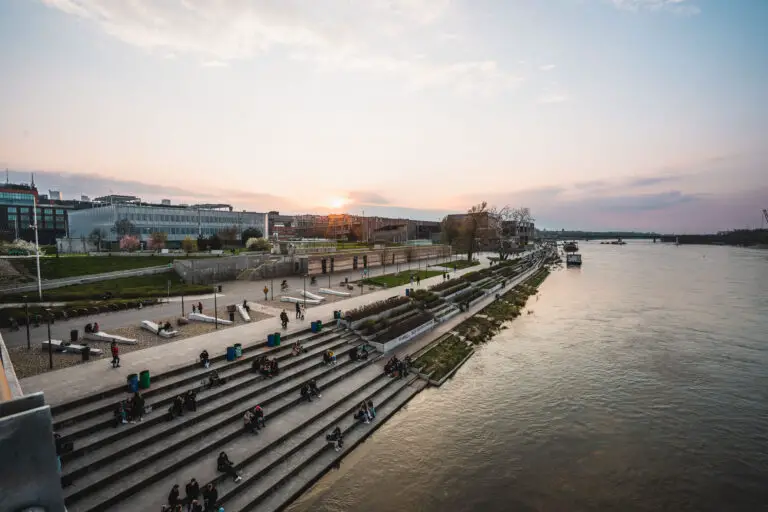
Poland in June: Weather Info & 5 Best Things to Do in 2024
Considering an early summer trip to Poland? Visiting Poland in June is a great time to do so! The weather is wonderful, the days are long, there are lots of activities, and everything else Poland normally has to offer is still available to enjoy! But even more is unlocked during the summer months. The warmer…
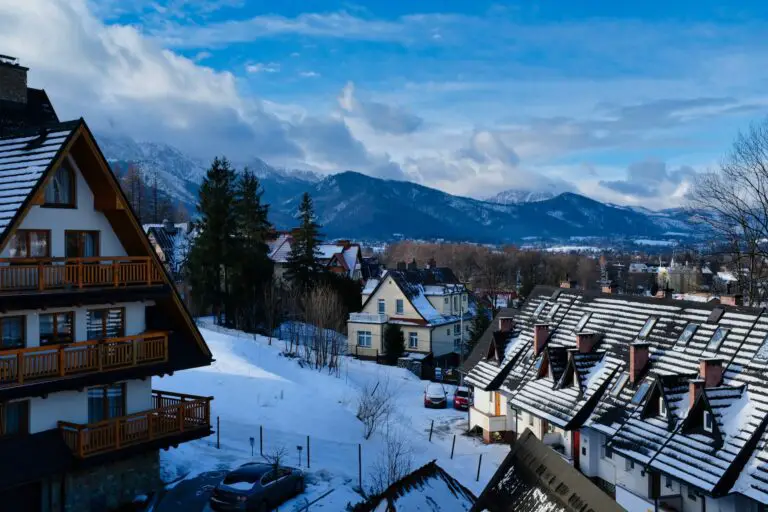
Poland in the Winter: Our Ultimate 2024 Guide
If you are considering a wintertime vacation in Europe, Poland in the winter should be on your list! Poland’s location in Europe makes for what you would imagine winter should look like, with a good amount of snowfall, winter activities like ice skating amidst beautiful buildings in the centers of cities, and lots of good…
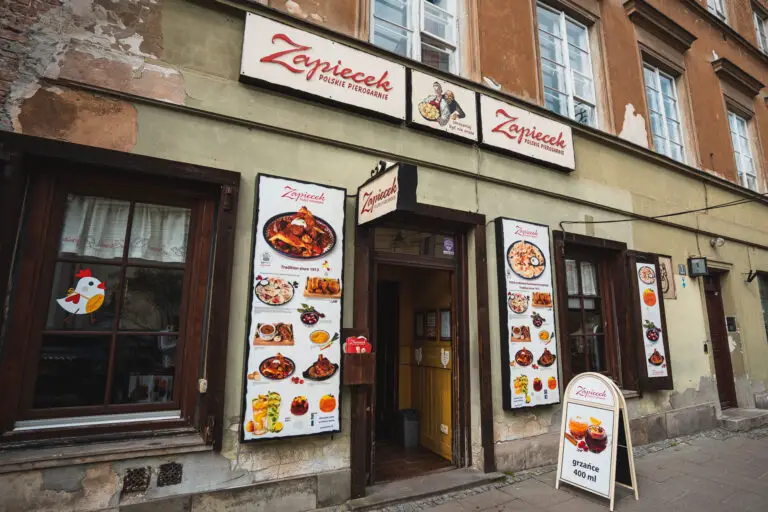
Tipping in Poland: Customs and Etiquette Guide for 2024
Tipping in Poland is straightforward. Do it when the service is very good or very difficult, or if you feel compelled to do it every time, no more than 10% is good. Always tip tour guides, you should tip delivery drivers for bad weather especially, and in general, tip where you want. Poland is a…
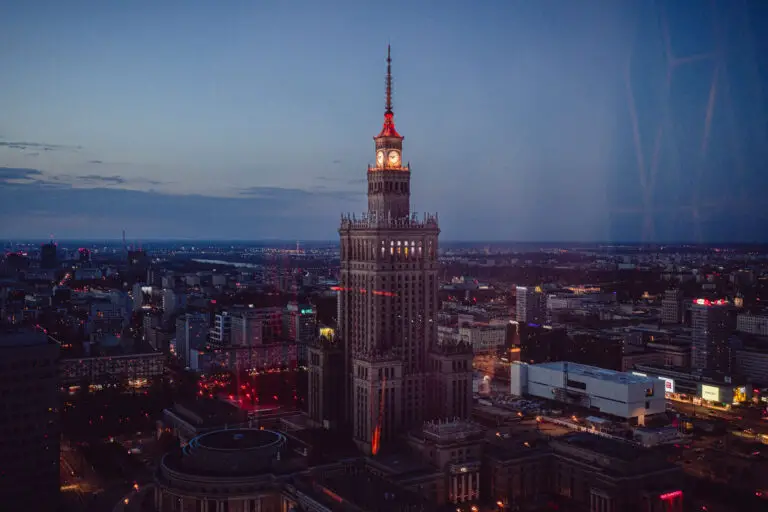
20 Most Famous Landmarks in Poland You Must See
What landmarks in Poland are worth visiting? When you think of France, you think of the Eiffel Tower, or Mt. Fuji for Japan. Poland does not have as distinctive as a landmark as those countries. But there are many landmarks in Poland that are 100% worth visiting. Many of these landmarks are within major cities…
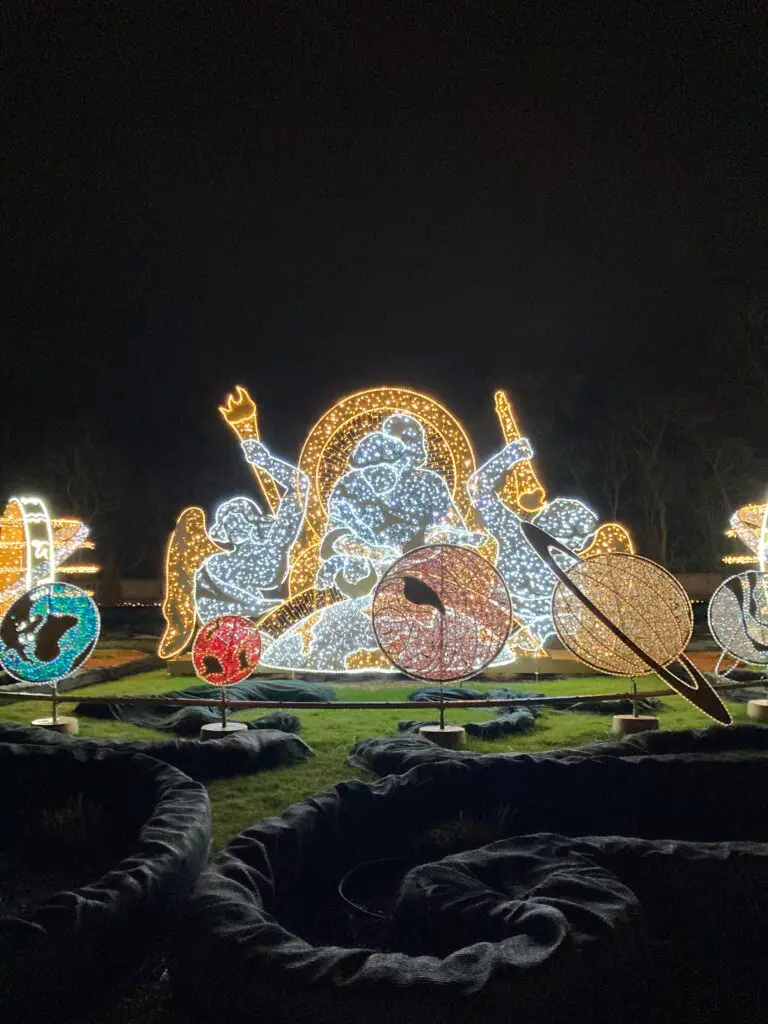
5 Best Polish Christmas Traditions: Everything To Know & City Guide
If you are looking for a European country with good Christmas traditions and events, Poland might be a good choice for you. Polish Christmas traditions range from the commonplace in other countries across Europe and the world, to unique superstitions and events that you can only find in Poland. Some traditions are based in Catholicism,…
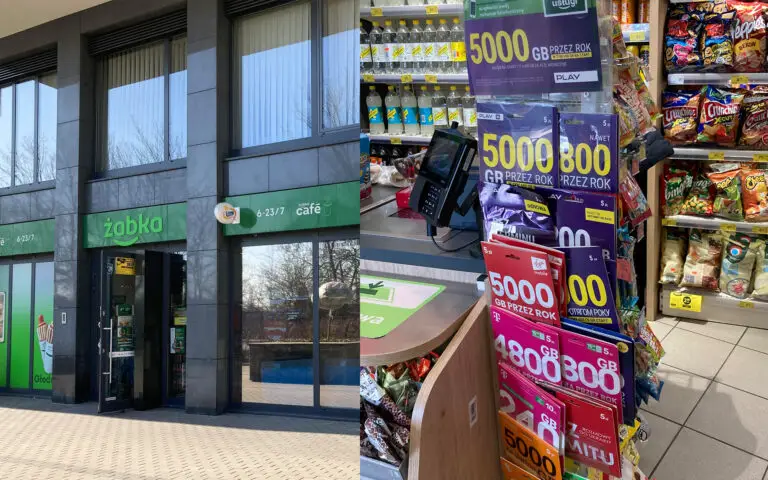
5 Best SIM Cards for Poland for Tourists & Expats
Do you want to stay connected while visiting Poland? Read this list for the 5 best SIM cards for Poland for any traveler! In today’s always-connected world, most people want to remain connected to the Internet even while traveling abroad. However, most cellular providers, especially in the US, have high roaming charges that add up…


20 Wonderful Things to do in Gdansk: Museums, History and Travel Guide
December 30, 2023 | Posted in: Poland
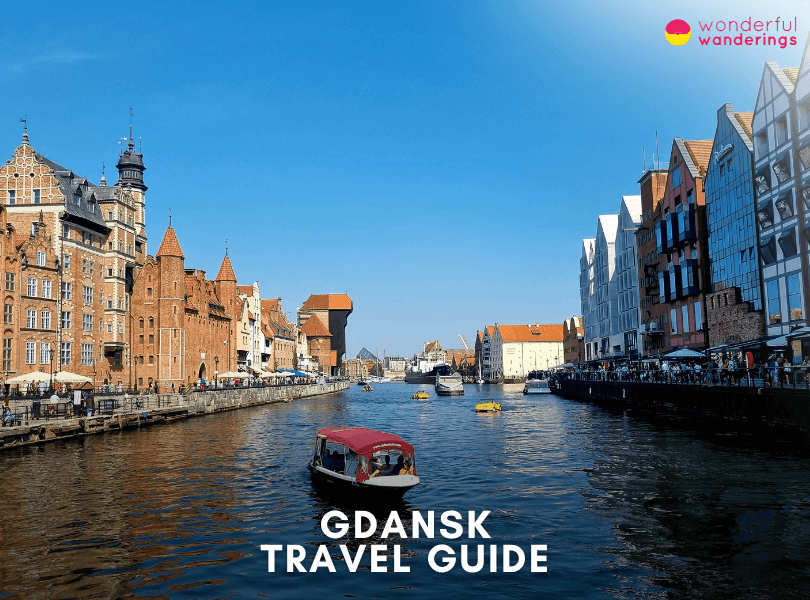
Gdańsk is a major port city on the Baltic Sea coast in northern Poland. It is located at the mouth of the Motława River and lies in the Pomeranian Voivodeship, of which it is the capital and largest city. Gdańsk forms part of the Tricity metropolitan area and the nearby cities of Gdynia and Sopot. Gdańsk is in the Pomeranian Voivodeship, the province's capital and largest city, with a population of 457,298 people as of 2023.
Gdańsk has a long history dating back to the 10th century when it was founded as a fishing village. It was part of the Duchy of Pomerelia before joining the Hanseatic League in 1361, which brought increased trade and prosperity. Gdańsk has endured various rulers over the centuries, from Polish kings to Prussian and German control and back to Poland in 1919 after WW1. Gdańsk was reincorporated into Poland after 1945. Gdańsk was the birthplace of the anti-communist Solidarność movement. Gdańsk has focused on rebuilding, attracting tourists and revitalizing its shipbuilding and maritime industries since the fall of communism.
Gdańsk offers visitors various attractions and activities to discover its complex history and culture as a medieval port city on the Baltic coast. Must-see sites include wandering the historic cobblestone streets of the Main Town to view landmarks like the towering St. Mary's Church, Artus Court and Neptune's Fountain. The iconic shipyard gates lead to the captivating European Solidarity Centre museum recounting the anti-communist movement born in Gdańsk. Visitors can admire views of spires and gabled roofs on a Motława River boat tour. The National Maritime Museum's interactive displays showcase shipbuilding and deep sea artifacts. World War Two history comes alive at Westerplatte and the iconic medieval crane is still towering over the harbor. Sample Baltic amber jewelry and handicrafts between the quirky architecture lining Mariacka Street. Gdańsk rewards pedestrians roaming between Old World trading houses and dramatic churches infused with centuries of Portuguese, Dutch, French and Hanseatic German influences unique to Baltic culture. Gdańsk is in the Central European Time zone, UTC+1. It observes Central European Summer Time (UTC+2) when daylight savings is in effect from late March to late October each year.
Listed below are the things to do in Gdańsk.
- Gdańsk Old Town. Gdańsk Old Town is in northern Poland at the mouth of the Motława River. It was established in the 10th century and joined the Hanseatic League in the 14th century, increasing trade and prosperity. Gdańsk soon became one of the largest and wealthiest cities on the Baltic coast. The old town suffered enormous damage in WWII but was reconstructed. It is renowned for its spectacular medieval and Renaissance architecture along picturesque cobblestone streets. Highlights include the 15th-century Artus Court, St. Mary's Basilica and the iconic Great Armoury building.
- European Solidarity Centre. The European Solidarity Centre (ESC) in Gdańsk, Poland, commemorates Solidarity, the independent trade union born out of worker strikes at the Gdańsk Shipyard in 1980. The ESC opened on the 34th anniversary of the Gdańsk Agreement in 2014. The main attraction is a permanent multimedia exhibition detailing Solidarity's history across seven interactive halls using archival materials, documents, films and art installations. Other facilities include a library, media center, academic research facilities, conference rooms, a winter garden, shops and a restaurant.
- Mariacka Street. Mariacka Street is in Gdańsk's Old Town neighborhood. It is lined with beautiful burgher houses dating back to the Renaissance and Baroque periods. The narrow cobblestone street feels like a step back. Highlights include admiring the decorated architecture, visiting amber jewelry shops, which Gdańsk is famous for and dining at cafes serving Polish fare. The street is also home to attractions like the Archaeological Museum in the Naturalists' House.
- Highgate (Brama Wyżynna). The High Gate (Brama Wyżynna) is a Renaissance-style fortified gate built in 1574 and 1588 as part of Gdańsk's city walls. Inside is a small tourist information center featuring ornately carved decorations and Latin inscriptions highlighting virtues. It features an automated procession of figures, including knights, ladies and the Polish king Jan III Sobieski, on horseback. The structure makes an impressive backdrop for photos.
- Artus Court. Artus Court was a meeting place for medieval Gdańsk's elite merchants and an event venue. Featuring a magnificent interior with colorful ceiling depictions and enormous stoves, it also houses the Gdańsk History Museum, exhibiting artifacts through the ages. Visitors can admire the architecture and decor, learn about the city’s history and attend classical music concerts held in the Grand Hall.
- Neptune's Fountain. Neptune's Fountain in central Gdańsk dates to 1633. The Baroque fountain features a bronze statue of Neptune atop a richly decorated basin, representing the city's maritime trade. The statue was hidden during WWII to save it from being melted by the Nazis. The restored granite fountain remains an atmospheric centerpiece along the historic Long Market, making an excellent photo backdrop.
- Oliwa Cathedral. Oliwa Cathedral was reconstructed from a Gothic monastery into an ornate Baroque-Rococo form after fires and wars. Home to the renowned Oliwa Pipe Organ with over 8,000 elaborately carved, gilded pipes, highlights include admiring the decor, attending frequent organ concerts and visiting the Diocesan Museum of treasures and artifacts.
- Gdańsk Crane. The iconic brick Gdańsk Crane functioned as a harbor loading crane and fortified city gate. Featuring circular towers, walls and elevated wooden machinery operated by men walking inside giant wheels, it could lift 2-tonne loads to 27 meters high. It is a branch of the National Maritime Museum and visitors can tour 17th-century port life exhibits and views from 25 meters up overlooking the Motława River.
1. Gdańsk Old Town
Gdańsk Old Town (Polish. Stare Miasto w Gdańsku) is located in the city of Gdańsk in northern Poland. Gdańsk is situated on the Baltic Sea coast, at the mouth of the Motława River. The exact address of Gdańsk Old Town is Długi Targ, Gdańsk, Poland. Gdańsk Old Town has a long and fascinating history. It was established in the 10th century when Gdańsk was founded by Mieszko I, Duke of Poland. In the 14th century, Gdańsk joined the Hanseatic League, an alliance of merchant guilds and market towns in Northern Europe. This brought increased trade and prosperity to the city. Gdańsk soon became one of the largest and wealthiest cities on the Baltic coast. It continued to thrive for centuries as an important port and trading hub. Gdańsk Old Town suffered enormous damage during World War II, over 90% of its buildings were destroyed. A meticulous reconstruction project was undertaken to rebuild the historic center to its former glory. The architecture and layout of the original buildings were recreated using old paintings and photographs as reference. The beautifully restored Gdańsk Old Town allows visitors to step back in time and glimpse the city's storied past.
Gdańsk Old Town is renowned for its spectacular medieval and Renaissance architecture. Visitors can wander along picturesque cobblestone streets with ornately decorated burgher houses, Gothic churches and historic merchant townhouses. Architectural highlights include the 15th-century Artus Court, St. Mary's Basilica (the largest brick church in the world) and the iconic Great Armoury building. There are many interesting things visitors can see and do in Gdańsk Old Town. A must-do activity is soaking in the atmosphere while strolling down Długi Targ (Long Market), the main thoroughfare dotted with beautiful historic buildings. Check out Neptune's Fountain in the center of Długi Targ, a symbol of Gdańsk created in 1633. Foodies will enjoy sampling traditional Polish cuisine at one of the many restaurants, like the famed Pierogarnia Mandu, which specializes in dumplings. Popular river cruises along the Motława River offer unique vantage points to view Gdańsk's architecture. Visitors interested in history can visit museums like the Gdańsk Museum of Amber to learn more about the city's trading heritage. Shopping aficionados will love hunting for Baltic amber jewelry, ceramics, artworks and handicrafts at souvenir stalls and galleries. Gdańsk Old Town offers fun activities for visitors of all ages and interests.
Gdańsk Old Town is located in the city center and can be accessed on foot. It is easily reached by bus, tram, taxi or Uber. Visitors can also take the train from Gdańsk's main train station, Gdańsk Główny and arrive at Gdańsk Śródmieście station. This train station sits on the edge of the Old Town. Entry to Gdańsk Old Town is free. Visitors only need to pay admission fees for certain attractions like museums or to go up the tower of St. Mary's Basilica.
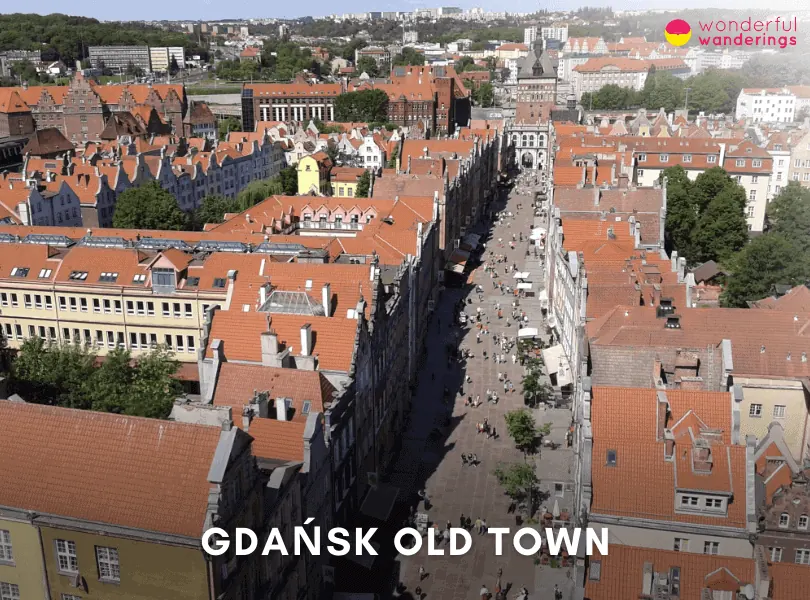
2. European Solidarity Centre
The European Solidarity Centre (ESC) is located in Gdańsk, Poland, at Plac Solidarności 1 (Solidarity Square 1). The ESC opened on August 31, 2014, on the 34th anniversary of the signing of the Gdańsk Agreement, which led to the creation of Solidarity, the first independent trade union in the Communist bloc. The ESC was established to commemorate and promote the ideals of the Solidarity movement, which began with worker strikes at the Gdańsk Shipyard in 1980. Led by electrician Lech Wałęsa, Solidarity grew into a mass social movement that contributed to the eventual fall of communism in Poland and across Eastern Europe. The design of the ESC building, with its rust-colored steel walls, is meant to evoke ships under construction at the Gdańsk Shipyard. The 5-story structure contains over 25,000 square meters of space, including a permanent exhibition, temporary exhibition halls, a multimedia library, archives, conference rooms, a winter garden, shops and a restaurant.
The main attraction at the ESC is the permanent exhibition detailing the history of Solidarity. Spread over seven halls on two floors, the interactive multimedia exhibition utilizes archival materials, documents, photos, films and art installations to immerse visitors in the story of the Solidarity movement. Key items on display include the original 21 demands written by striking workers in 1980, the overhead crane operated by Solidarity activist Anna Walentynowicz, a bullet-pierced jacket from a victim of the 1970 shipyard massacre and the desk of opposition leader Jacek Kuroń. The exhibit walks through major events like the August 1980 strikes, the declaration of martial law in 1981 and Poland's transition to democracy in 1989. The permanent exhibition best suits adults and high school/college students interested in Solidarity and Poland's modern history. Audio guides are available in 11 languages. Visitors should plan on spending at least 2 hours exploring the multimedia exhibit. Other facilities at the ESC include a library with over 100,000 books, a media center, academic research facilities, conference rooms, a winter garden that hosts cultural events and a restaurant and shops on the ground floor. The ESC also has a children's play area called the Play Department.
The ESC can be reached by public transportation, taxi, bike or car. The nearest tram stop is Solidarności. The building has an underground parking garage accessible from ul. Stągiewna. Admission to the permanent exhibition costs 30 PLN ($7, 6€, 4£). Discounts are available for students, seniors 60+ and families. Access to the building and winter garden is free. Temporary exhibitions usually cost extra.
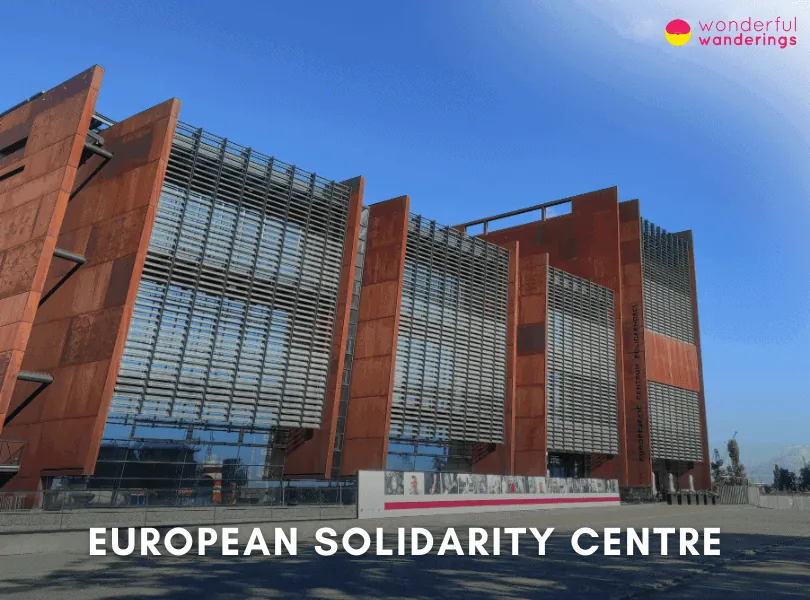
3. Mariacka Street
Mariacka Street is located in the Old Town neighborhood of Gdańsk, Poland. Gdańsk is a port city on the Baltic Sea coast in northern Poland. Mariacka Street has existed since the 14th century. It was originally known as “Our Lady's Street” in Latin, referring to the nearby St. Mary's Basilica. In the Middle Ages, Mariacka Street was home to shoemaking workshops. Gothic tenement houses were built along the street from the late 15th century onward. Mariacka Street is special because of its well-preserved historic architecture and atmosphere. The street is lined with beautiful burgher houses that date back to the Renaissance and Baroque periods. Many houses have decorative terraces and porches protruding over the narrow cobblestone street. Carvings and engravings of religious and mythological scenes adorn the facades. Mariacka Street was destroyed by bombing raids in 1945. A meticulous reconstruction was undertaken between the 1950s and 1970s to restore the street. Mariacka Street feels like a step back in time, allowing visitors to experience the historic charm of Gdańsk.
There are several things visitors can do on Mariacka Street. Wandering along the cobbled lane and admiring the architecture is a must. Visitors can also check out the many amber jewelry shops, as Gdańsk is famous for its amber. Foodies will enjoy the numerous cafes serving Polish fare. The street is also home to art galleries and museums like the Archaeological Museum in the Naturalists' House at no. 25/26. Mariacka Street would appeal most to history and architecture enthusiasts, as learning about its medieval origins and reconstructed buildings is fascinating. It is also a good activity for families with older children who can appreciate the historic surroundings. Photography enthusiasts will find the picturesque streetscapes dotted with gargoyles and ornamentation very photogenic.
Gdańsk is accessible by train, bus or car. Mariacka Street is located in the heart of the Old Town, making it accessible from most accommodations. Public transport like trams and buses can also bring visitors to stops near Mariacka Street from different parts of Gdańsk. Entry along Mariacka Street is free, though individual attractions may charge admission fees ranging from 10 to 20 PLN ($2, 2€, 1£) to ($4, 4€, 2£).
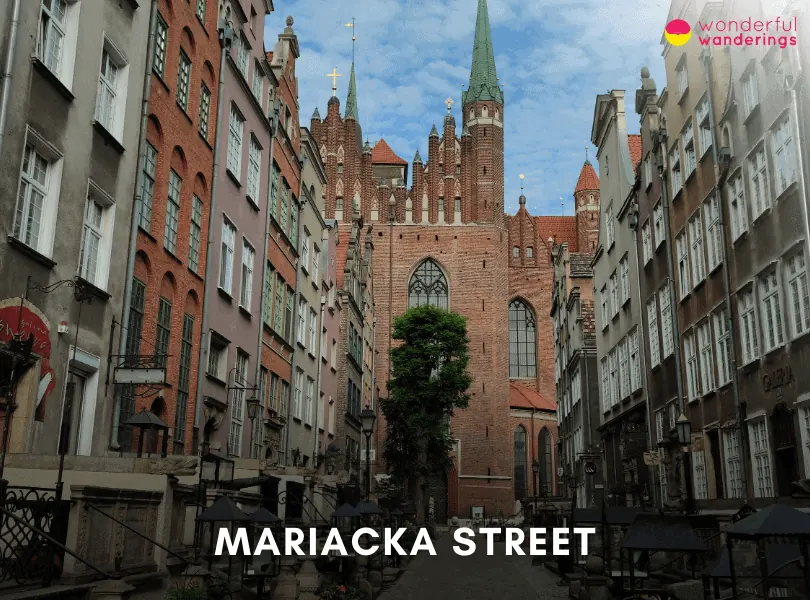
4. Highgate (Brama Wyżynna)
The High Gate, known in Polish as Brama Wyżynna, is located in Gdańsk, Poland at Wały Jagiellońskie Street 2A. The Renaissance-style gate was built between 1574 and 1588 as part of the city's new fortifications. It was designed by architect Willem van den Blocke and served as the main entrance to Gdańsk, opening onto the Royal Route into the city. For almost 300 years until 1878, the High Gate remained part of a larger fortified complex with walls, bastions and a moat. Today, the free-standing gate is a historic landmark in the city. The structure features ornately carved sandstone decorations on the facade, with three coats of arms above the arched passageways – the Polish eagle in the center, the Gdańsk coat on the right and the Royal Prussian coat of arms on the left. The building has two floors, with four lion statues standing guard atop the gate. Latin inscriptions on the walls highlight virtues like justice, piety, peace and wisdom.
Inside the gate is a tourist information center run by the Gdańsk History Museum. Visitors can stop by to learn about the gate's history, pick up maps and brochures or ask the staff questions about attractions in the city. The small space inside also hosts temporary exhibits related to Gdańsk's history. Outside the High Gate, visitors can admire the historic building from the street Wały Jagiellońskie. The structure makes for an impressive photo backdrop. On the hour, an automated procession of figures emerges from the gate, including knights, ladies and the Polish king Jan III Sobieski on horseback. Tour groups often gather to watch the spectacle.
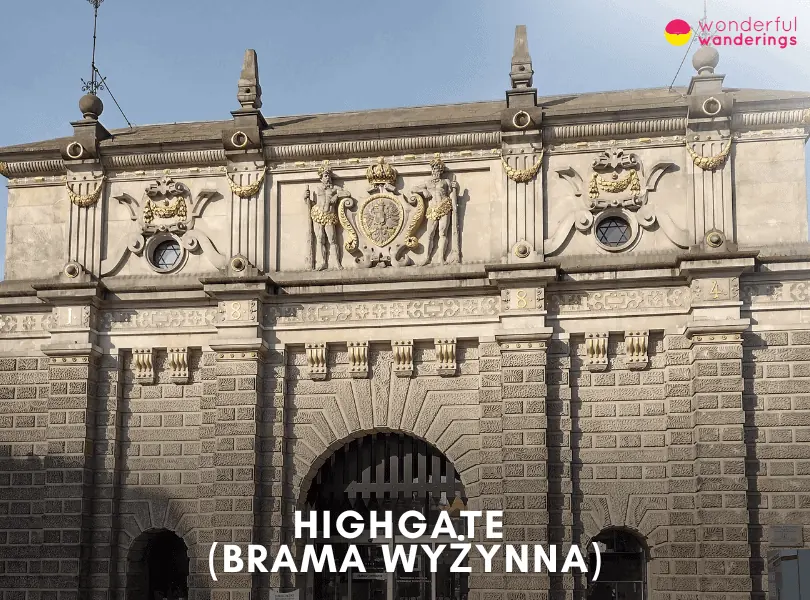
The gate is ideally suited for adults interested in architecture, history and photography. The automated procession draws interest from visitors of all ages. Getting close to the gate can be difficult for those in wheelchairs or with limited mobility, as some stairs and cobblestones lead up to the entrance.
The High Gate is located in Gdańsk's Main Town area, near the Gdańsk Główny train station. It can be reached by local tram (stop Brama Wyżynna), city buses and taxis. Tourists staying in the Old Town area can easily walk. There is some metered parking nearby. Entry to see the small interior exhibits costs 5 PLN ($1, 1€, 0.86£) per person. Access to the street and external facade is free. The tourist information center inside provides free maps and guidance. Guided walking tours in Gdańsk often include a stop at the High Gate to talk about its history and architectural significance.
5. Artus Court
The Artus Court (Polish. Dwór Artusa) is located at Długi Targ 43/44 in Gdańsk, Poland. Gdańsk is a port city on the Baltic coast in northern Poland. The Artus Court has a long and illustrious history. It was constructed between 1348 and 1350 as a meeting place for merchants and a center of social life for the elite members of the city. It was named after the legendary King Arthur and the Knights of the Round Table, as medieval merchants saw themselves as nobles and knights. In its heyday during the 16th and 17th centuries, the court hosted lavish balls, weddings and other events for wealthy citizens and visiting dignitaries. Artus Court features its magnificent interior decor. The Grand Hall features a colorful ceiling from 1617 depicting wildlife hunting scenes. The high walls are adorned with enormous 19th-century Gdańsk-style stoves decorated with biblical reliefs. Displays include precious 16th-century majolica pottery, gold jewelry and goblets for ceremonial occasions. The building also houses the Gdańsk History Museum, exhibiting historical artifacts of the city through the ages.
Visitors to the Artus Court today can admire the ornate architecture and decor, learn about Gdańsk’s history in the museum and attend classical music concerts held in the Grand Hall. Guided tours can allow visitors to view the main halls and take in detailed explanations from knowledgeable guides. The court also houses an upscale restaurant serving traditional Polish cuisine if visitors wish to take a culinary journey into history. The Artus Court appeals most to history enthusiasts interested in learning about Gdańsk's prosperous past as a medieval trade city. Architecture buffs who can admire the excellent craftsmanship of the interior design. Foodies who want to complete the historical immersion by sampling dishes from a bygone era and classical music lovers, as concerts with musicians dressed in period costumes often occur.
The Artus Court is located in the Main Town of Gdańsk, making it very walkable from most accommodations, shops and restaurants in the historic center. It can be reached in 1.6 kilometers (0.9 miles) from Gdańsk Główny train station by local bus, tram or taxi. Entry tickets to the interior of the Artus Court cost 12 PLN ($3, 3€, 1£). Visitors can pay extra for a guided tour and/or a meal at the onsite restaurant. The building exterior can be viewed for free.
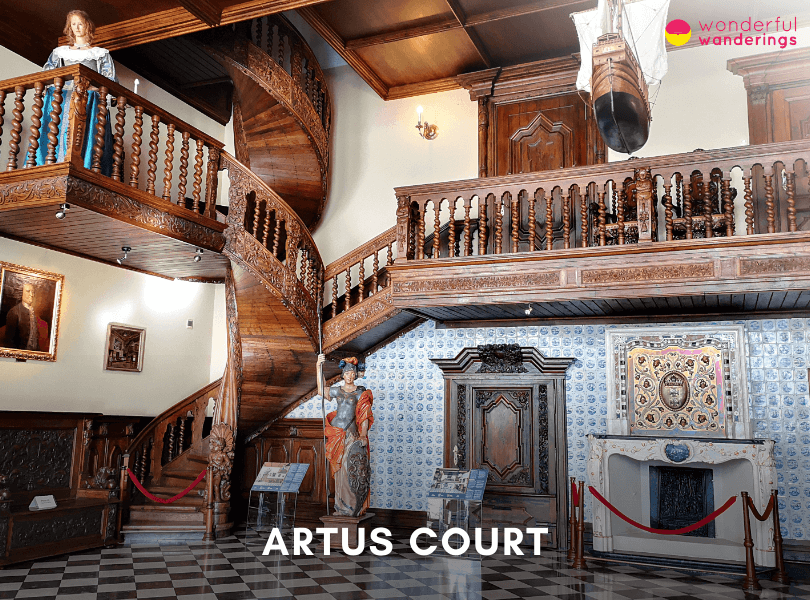
6. Neptune's Fountain
Neptune's Fountain (Fontanna Neptuna) is in the heart of Gdańsk's Main Town at Długi Targ 43/44 (Long Market 43/44). It is along the city's historic Royal Route and the fountain has stood in the center of Long Market since 1633. The Baroque fountain features a bronze statue of Neptune, the Roman god of the sea, standing atop a richly decorated basin. The powerful figure represents Gdańsk's long connection to shipping and maritime trade. The statue was designed in 1617 by architect Abraham van den Blocke and sculpted by Flemish artist Peter Husen using 8 tonnes of bronze. The unique Gdańsk liquor Goldwasser (Goldwater) was born at Neptune's Fountain. When Neptune struck the water with his trident, gold flakes from passing merchant ships spilled into the basin and mixed with the fountain's waters, thus creating the famous drink with floating gold specks. Neptune's Fountain has endured a turbulent history. The original 17th-century fountain was pulled down in 1836 with plans for something grander, but construction stalled. A simpler temporary plaster version was erected, which survived until WWII. The Nazi occupation regime planned to melt the bronze statue for armaments, but Polish resistance fighters hid the figure. A new granite fountain was rebuilt in 1954 using the original Neptune statue.
Visitors gather around the restored fountain to admire the detailed sculpture and flowing water. The striking centerpiece adds old-world charm to the atmospheric Long Market, lined with colorful historic townhouses. Tour groups often pause here while guides recount Gdańsk's maritime heyday when ships laden with goods docked along the Motława River. The fountain makes an excellent photo backdrop, especially when illuminated at night. Visitors can get up close to inspect the god Neptune wielding his trident. The four female figures at the base represent major rivers associated with Gdańsk – the Vistula, Oder, Elbe and Rhine. Intricate reliefs decorate the granite basin. Neptune's Fountain appeals to visitors of all ages interested in art, architecture, history and photography. Families enjoy the impressive statue and flowing water. It also draws shoppers and diners to visit Long Market's restaurants and amber shops.
The fountain is in central Main Town, near Gdańsk Główny train station. It can be reached via tram line #2 or #3 to Brama Wyżynna or various buses to Długi Targ. Limited paid street parking is available nearby. Entry to admire and photograph the fountain is free. Neptune's Fountain is outdoors and always open. Occasional public events like concerts may restrict direct access. Guided walking tours of Main Town often stop here to talk about Gdańsk's maritime history.
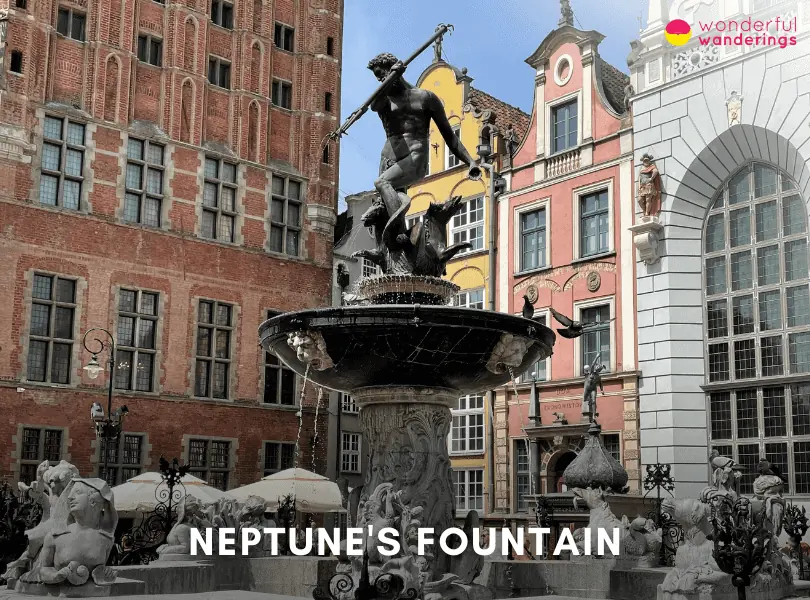
7. Oliwa Cathedral
The Oliwa Cathedral (Polish. Katedra Oliwska) is located at ul. Nowolipie 1, 80-330 Gdańsk, Poland. Gdańsk is a port city on the Baltic Sea coast in northern Poland. The Oliwa Cathedral has a long and fascinating history dating back to the 12th century when it was founded as part of a Cistercian monastery. Fires and wars led to the reconstruction of the Gothic-style cathedral into its present form with exceptional Baroque and Rococo interior decor. Oliwa Cathedral highlights the ornate architectural details and works of art. The centerpiece is the massive Oliwa Pipe Organ, constructed between 1763 and 1788 and renowned as one of the largest and most complex organs in the world. The intricately carved, gilded organ has over 8,000 pipes and is decorated with hand-carved figures of angels, suns and stars. The cathedral also contains many altars, paintings, sculptures and tombstones of great artistic value.
Visitors today can admire the cathedral's architecture and art, attend organ music concerts held regularly and visit the Diocesan Museum to see historical artifacts and treasures. Guided tours are available to view the impressive pipe organ and learn more about the cathedral's history. There is also a restaurant on-site if visitors wish to dine. The Oliwa Cathedral appeals most to classical music lovers, especially organ music lovers, as concerts occur frequently. History and architecture enthusiasts are interested in the cathedral's Medieval origins and Baroque-Rococo reconstruction. Art aficionados who can appreciate the altars, paintings and sculptures. Photography enthusiasts, due to the striking interior and organ views.
The Oliwa Cathedral is located in the Gdańsk district of Oliwa, 5 kilometers (3.1 miles) by car or bus from central Gdańsk. Public bus #122 runs frequently from Gdańsk's main train station (Gdańsk Główny) and stops close to the cathedral. Taxis are also available. Entry to see the cathedral interior costs 8 PLN (2€, $2, 1£) per person. Additional fees apply for photography permits, guided tours, organ recitals and the onsite Diocesan Museum. Visitors can also dine at the cathedral's restaurant or purchase souvenirs from a gift shop.
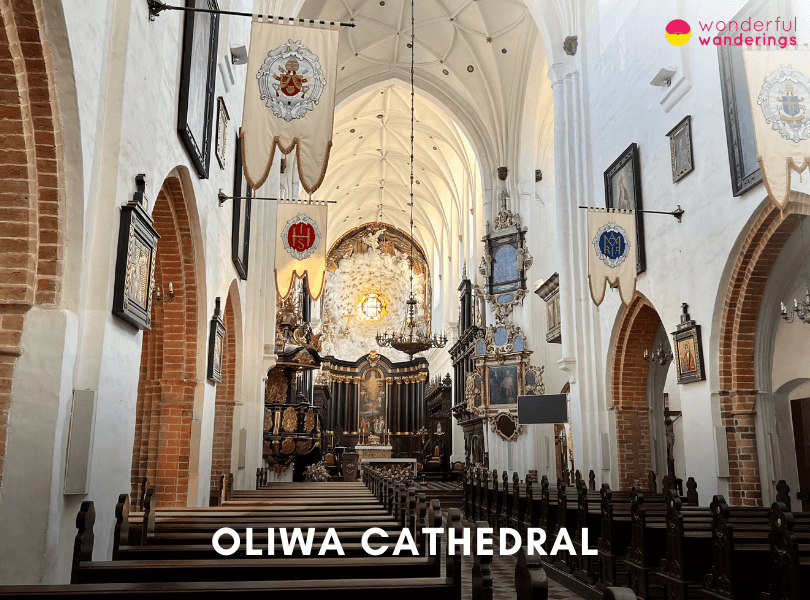
8. Gdańsk Crane
The Gdańsk Crane, known in Polish as Żuraw Gdański, is located in central Gdańsk at Szeroka Street 67/68 along the Motława River. The spectacular Gothic brick structure was built between 1442 and 1444, with an ornately decorated west facade added in 1483. It functioned as a harbor crane for loading goods and a fortified city gate, featuring two circular towers connected by walls and wooden crane machinery in an elevated central section. The Gdańsk Crane could lift loads to 2 tonnes using rope wound around two huge wooden treadwheels, each over 6 meters in diameter. The wheels were powered by men walking inside, enabling the crane to lift cargo from ships on the Motława River up to 27 meters high. The building has defensive features like cannon ports, gun loops and high towers to provide a lookout and protection. It served as an entrance to the city from the harbor. The brick construction and soaring height made it a prominent landmark.
The iconic Gdańsk Crane is a branch of Poland's National Maritime Museum. Visitors can tour exhibits that recreate 17th-century port life, including models of ships, counting houses, granaries and the huge internal wooden gears that operated the crane. The top floor offers excellent views from 25 meters up, overlooking the Motława River and historic harbor. Seeing the massive wooden machinery also gives an appreciation for early lifting technology.
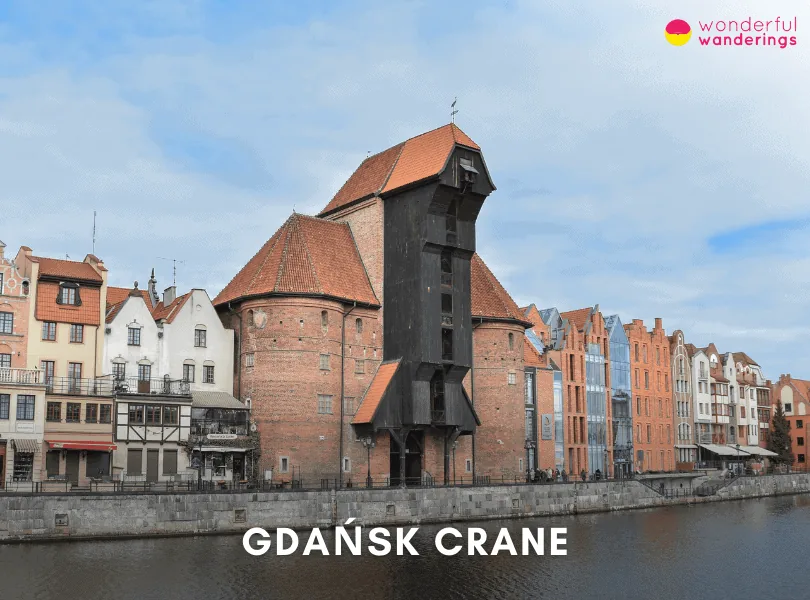
The crane appeals to adults and older children interested in medieval architecture, port history, engineering and photography. The building's narrow spaces and steep stairs make it unsuitable for those with mobility limitations.
The Gdańsk Crane is located in the Main Town area of the city, near the Gdańsk Główny train station. Visitors can take local tram #2 or #3 to the Brama Wyżynna stop or city buses that stop along Długie Pobrzeże. Limited paid street parking is available nearby. Entry to the museum exhibits costs 10 PLN ($2, 2€, 1£) per person. Access to the building exterior and views from Long Embankment are free. Guided walking tours of Gdańsk often stop here to discuss the crane's history and operation.
9. National Maritime Museum in Gdańsk
The National Maritime Museum in Gdańsk (Polish. Narodowe Muzeum Morskie w Gdańsku) is located at Ołowianka 9-13, 80-751 Gdańsk, Poland. Gdańsk is a port city on the Baltic Sea coast in northern Poland. The museum has a long history dating back to 1958 when a Museum's Friends Association was established to create a maritime museum in Gdańsk. It was officially opened on January 1, 1962 and has expanded over the years to encompass several branches across northern Poland. Today, the museum's main branch is housed in the meticulously restored medieval granaries on Ołowianka Island in central Gdańsk.
The National Maritime Museum has an extensive collection of Poland's maritime history and culture over the centuries. The museum holds over 28,000 artifacts, including model ships, naval artillery, ethnographic objects, works of art and archaeological materials recovered from underwater excavations. The granaries contain interactive displays depicting shipbuilding techniques, famous naval battles, artifacts from sunken galleons and Polish maritime exploration around the world. Visitors can explore several permanent exhibitions and temporary displays in the granaries and maritime culture center. Guided tours of the museum ships SS Sołdek and Dar Pomorza are available, bringing history to life by allowing access to these vessels' interior spaces and equipment. The museum also houses conservation workshops, where visitors can observe archaeological preservation. The National Maritime Museum appeals most to Maritime history enthusiasts interested in Poland’s naval past. Nautical archaeology fans can view conserved artifacts firsthand. Ocean exploration aficionados who were eager to learn about Polish maritime exploits and families with children over five who could engage with the interactive shipbuilding exhibits.
The museum's main branch on Ołowianka Island is located in central Gdańsk, near the Gdańsk Główny train station. It can also be reached by local tram or bus. Entry to the permanent exhibitions at the National Maritime Museum costs 18 PLN ($4, 4€, 2£) for adult tickets and 12 PLN ($3, 3€, 1£) for concessions. Extra fees apply for special exhibitions, museum ships and guided tours. Visitors can also purchase combined tickets for 28 PLN ($8, 7€, 4£) to access all branches by ferry and see the full maritime experience.
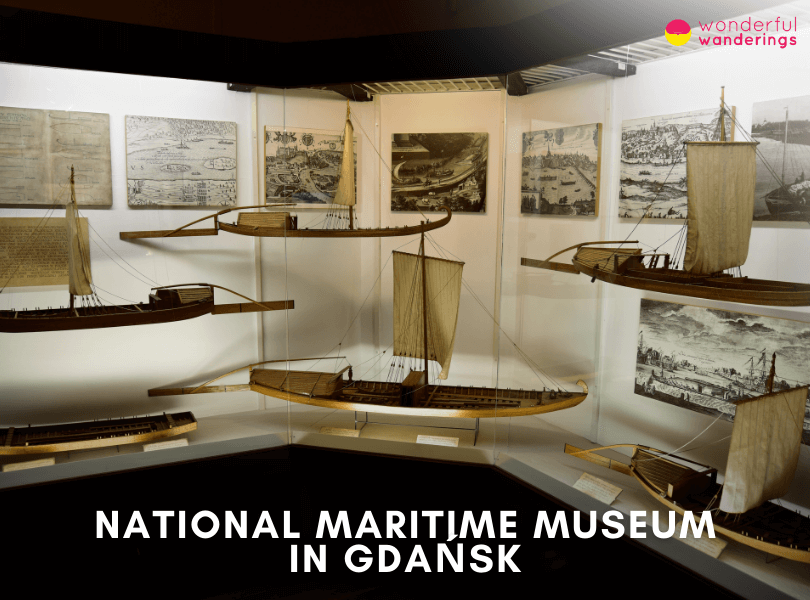
10. Uphagen's House
Uphagen's House (Dom Uphagena) is in central Gdańsk at Długa Street 12 ( within the historic Main Town area. The house was purchased in 1775 by Johann Uphagen, a wealthy merchant, historian, art collector and city councilor. Johan Uphagen had it extensively remodeled in an 18th-century patrician residence style to suit his status. After Uphagen died in 1802, the house stayed in his family for generations. It was converted into a museum in 1991, showing the historic interiors and furnishings of a Gdańsk merchant's home. It functioned as a museum until 1944, when the contents were evacuated and hidden away by German curators. The house itself was destroyed in 1945 during the Soviet capture of Danzig. After the war, the exterior was reconstructed by 1954, but the museum did not reopen until 1998 after extensive restoration.
Visitors to Uphagen's House can tour period rooms that recreate the ambiance of an 18th-century Gdańsk merchant residence. The elaborate interiors reflect the immense wealth flowing through the port city during its heyday in the Hanseatic League. Highlights include the tall Entry Hall with stucco details, the Chinese-themed Tea Room, the extravagant main Drawing Room with mythological wall panels and damask fabrics, the ornate gold-leafed ceiling of the Dining Room and the Music Room with bird motifs. The house also contains some original furnishings and a display of kitchen equipment. Temporary exhibits are housed on the 2nd floor in former bedrooms. There is a small gift shop in the old merchant's office. Uphagen's House appeals primarily to adults interested in local history, historic architecture and decorative arts. Visitors should allow at least an hour to view the main rooms and exhibits. The building's historic design makes accessibility challenging for some.
Visitors can take tram #2 from the station to the Brama Wyżynna stop or buses that stop along Długie Pobrzeże. Limited paid street parking is available nearby. Entry to see the museum exhibits costs 12 PLN ($3, 3€, 1£). Discounts are available for students and seniors. The interior rooms are only accessible by guided tour. The gift shop and exterior of the house can be viewed independently.
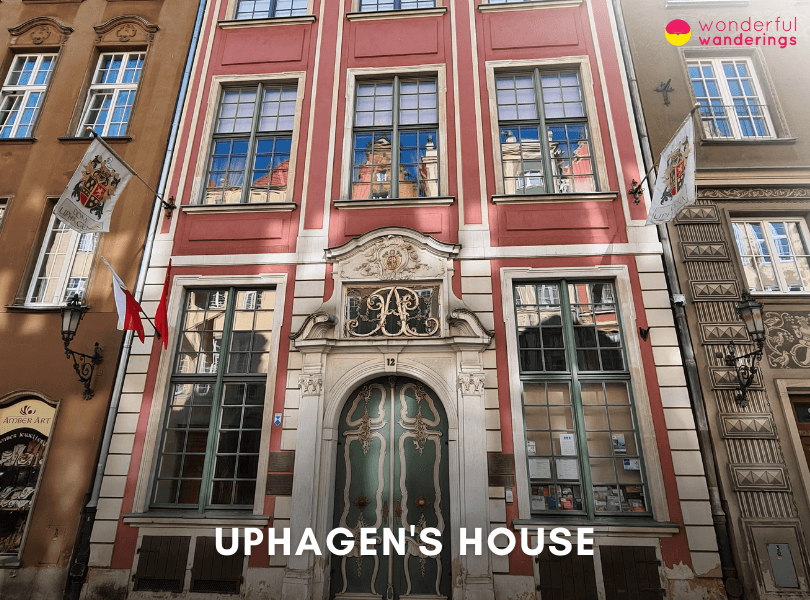
11. Basilica of St. Mary of the Assumption of the Blessed Virgin Mary in Gdańsk
The Basilica of St. Mary of the Assumption of the Blessed Virgin Mary, also known as St. Mary's Church (Polish. Bazylika Mariacka), is located in central Gdańsk, Poland, at Podkramarska 5, 80-834 Gdańsk. St. Mary's has a long and fascinating history dating back to the 14th century when construction began on the Gothic brick church. St. Mary's was expanded and various architectural elements were added in the Renaissance and Mannerist styles. It has endured fires, wars, destruction and meticulous reconstruction to stand today as one of the largest brick churches in the world.
St. Mary's is special because of its immense size and spectacular interior decor, with a volume between 185,000 and 190,000 m3. Its grandeur rivals that of great cathedrals. The 105.5-meter-long, 66-meter-wide interior impresses with its soaring pillars, elaborate 17th-century pipe organ, 15th-century astronomical clock and immense Golden Chapel containing ornate sarcophagi. The church holds about 25,000 people and was elevated to a minor basilica in 1965. Visitors to St. Mary's today can admire the architectural height and scale of the church, view the many artworks inside, including the famous Last Judgement painting by Herman Han and attend organ music concerts when held. It is also possible to take an elevator up the 75-meter tall tower for panoramic views across Gdańsk. St. Mary's appeals to history enthusiasts interested in church origins dating to medieval times. Architecture buffs who can appreciate the brick Gothic and mannerist styles. Art aficionados keen to see The Last Judgement and other work and music lovers who may chance upon one of the occasional concerts
St. Mary's is centrally located in downtown Gdańsk, 0.3 kilometers (0.1 miles) from the Gdańsk Główny train station. It can also be reached by local tram, bus or taxi. Entry to admire the church interior is free. There are small admission fees to access extras like the tower elevator ride (5 PLN) ($1, 1€, 0.86£) or occasional special exhibitions. Guided tours for 120 PLN ($29, 26€, 23£) per group may also be booked.
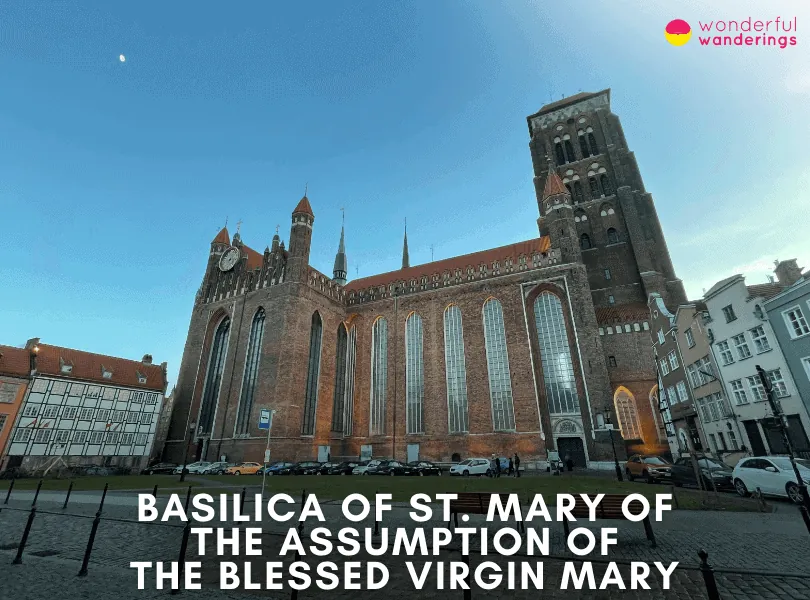
12. Westerplatte
Westerplatte is located in Gdańsk, Poland, at Mjr. Henryka Sucharskiego Street 25 within the former Westerplatte Peninsula. It was the location of the Battle of Westerplatte, the first clash between Polish and German forces in World War II. Westerplatte has a long military history. In the mid-16th century, a fort was built here to defend Gdańsk. In 1925, under the terms of the Treaty of Versailles, Poland was allowed to maintain a small military transit depot on the Westerplatte Peninsula, which was still German territory at that point. On September 1, 1939, Germany attacked the depot, beginning the invasion of Poland. Polish defenders (182) held off over 3,000 German troops for seven days in a symbolic stand.
Westerplatte is preserved as a war memorial and museum. The ruins of the barracks, guardhouses and other military structures stand as haunting reminders of the 1939 battle. The landscape is dotted with memorials like the Monument to the Coast Defenders, a 25-meter tall granite obelisk and a cemetery for the Polish soldiers killed in action. An on-site museum documents the battle. Visitors can walk along the marked sightseeing path to the ruins and memorial sites. The Westerplatte memorial appeals most to adults and older youth interested in World War II and Polish history. Seeing the remains of the bombed-out buildings and military fortifications brings the 1939 battle to life. The museum's photos, documents and exhibits add important context. Those interested in military strategy may appreciate analyzing battlefield tactics.
Westerplatte can be accessed by car, public transit or tour bus, with limited parking available. By public transport, visitors can take tram #2 or #3 from downtown Gdańsk to the Przystanek Muzeum stop and then walk to the museum. The memorial grounds are open year-round. Entry to the Westerplatte Museum cost 10 PLN (2€, $2, 1£) per person. Access to the outdoor memorial park is free. Guided tour options of the battleground are available during the summer. Those staying in Gdańsk's Main Town can also reach Westerplatte by riverboat.
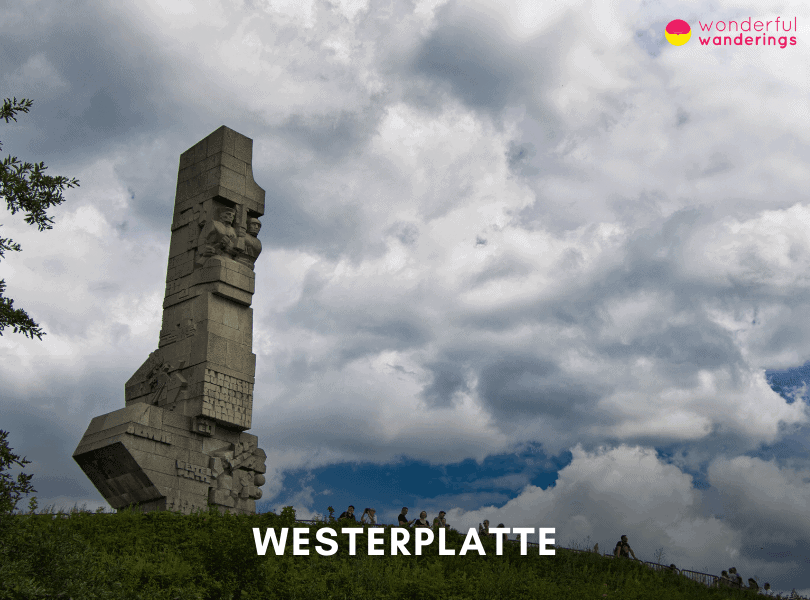
13. Long Market (Długi Targ)
Long Market, known in Polish as Długi Targ, is located in the heart of Gdańsk's Main Town between the Long Lane (Ulica Długa) and Green Gate (Brama Zielona) at Długi Targ 43/44 Długi Targ was initially a merchant road leading to an oval marketplace. After the 1308 massacre of Gdańsk citizens by the Teutonic Knights, it became the city's main thoroughfare. Its official Latin name, “Longa Platea”, was first written in 1331, with the Polish name “Ulica Długa” introduced in 1552. Długi Targ is lined with colorful historic townhouses reconstructed decades after World War II. The buildings feature distinctive architectural styles from Dutch Renaissance to French and Flemish Baroque. Intricate stonework decorates many facades, such as the Golden House's 12 carved biblical scenes.
Długi Targ is home to several iconic landmarks. In the center is the Neptune Fountain, featuring a 1633 statue of the Roman sea god standing atop a richly decorated basin. The fountain pays homage to Gdańsk's long connection to shipping and trade. Behind Neptune's Fountain is the 15th-century Artus Court, which once served as a meeting place for wealthy merchants and now houses a museum. The iconic 1487 Golden Gate sits at the western end, a remnant of the city's medieval fortifications. The Main Town Hall's green and white 16th-century towers are also along Długi Targ. Długi Targ bustles with tourists, shoppers and diners patronizing its many restaurants, cafes and amber shops. Visitors stroll down the atmospheric lane to admire the striking architecture and landmarks. The Long Market is an excellent photo backdrop, especially at dusk when the buildings glow under golden light. The promenade appeals to all visitors interested in architecture, history, photography, shopping and dining. Landmarks like Neptune's Fountain also attract families. Sections of Długi Targ are close to vehicle traffic, making it ideal for pedestrians. Guided walking tours of Gdańsk often pause here to discuss the history.
Długi Targ is located in Main Town, near Gdańsk Główny train station. Visitors can take tram #2 from the station to Brama Wyżynna stop or local buses. Limited paid street parking is available nearby. Entry to walk Długi Targ and admire its landmarks is free. Museums like Artus Court charge admission around 12 PLN ($3, 3€, 1£) per person. There are no entry fees for the shops, cafes and restaurants lining the atmospheric promenade.
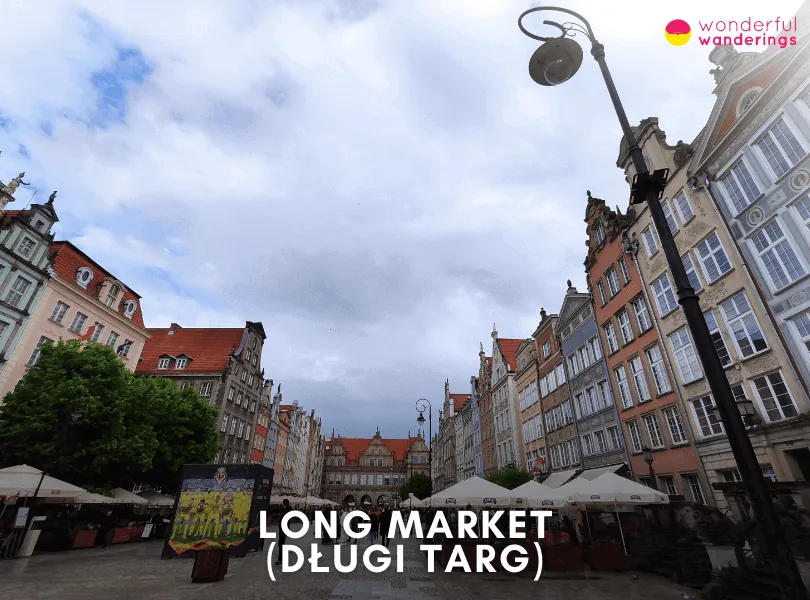
14. Golden Gate (Zlota Brama)
The Golden Gate (Polish. Złota Brama) is at the end of Długa Street in the Old Town area of Gdańsk, Poland. Gdańsk is a port city on the Baltic Sea coast in northern Poland. The Golden Gate has a long history from the early 17th century. It was constructed between 1612 and 1614 by architect Abraham van den Blocke and builder Jan Strakowski to replace an older 13th-century Gothic gate on the same site. Its location connects the historic Long Market (Długi Targ) to Long Lane (Ulica Długa), once the Royal Route into Gdańsk.
Golden Gate features its ornate Renaissance-style architecture and extensive decorative sculpture work. It is a testament to Gdańsk's prosperity as a trading center in the 1600s. The light sandstone facade combines Dutch and Italian influences with four pairs of Doric and Ionic columns across two stories framing an arched passageway. Intricate masonry and abundant ornamentation give it grandeur. Figurative stone sculptures representing civic virtues like peace, Concord and Prudence adorn the attic story. Visitors to the Golden Gate today can admire its historic architecture, stroll through the passageway from Long Lane onto the Long Market main avenue and view the sculpture work up close. Interpretive signs detail the gate's history and symbolism for self-guided learning. The atmospheric side street and the square also have restaurants, cafes and shops to enjoy. The Golden Gate would appeal to history enthusiasts interested in Gdańsk's trading heyday. Architecture buffs who can appreciate the Dutch Mannerist style. Art aficionados keen on symbolic sculpture work and photographers and tourists seeking an iconic city photo spot
The Golden Gate is centrally located in Gdańsk's touristy Old Town area, quite walkable from most accommodations, shops and restaurants nearby. It can be reached through the Gdańsk Główny train station by local tram, bus or taxi. Entry to view the Golden Gate from both sides and pass through the walkway is free. Some restaurants and shops adjoin the small square around it. Guided walking tours of Gdańsk often pass by it as a highlight attraction to explain further.
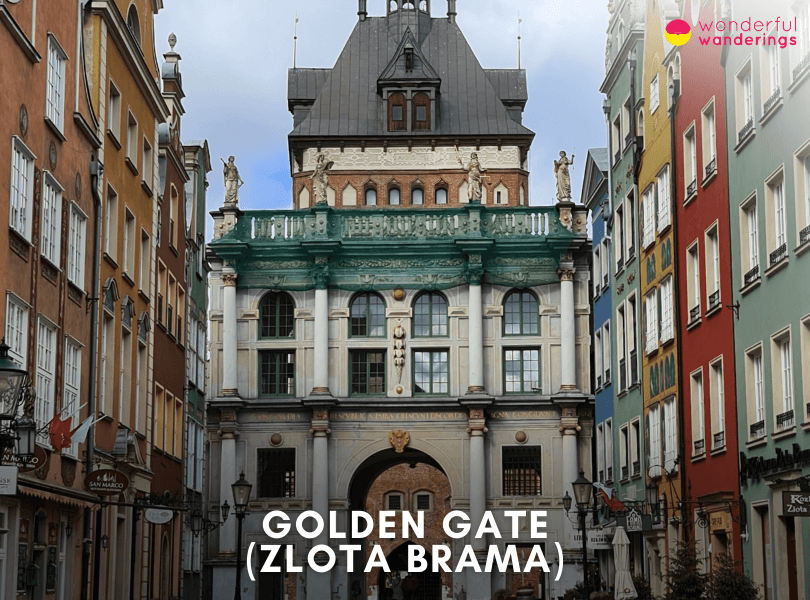
15. Amber Museum (Gdańsk)
The Amber Museum (Polish. Muzeum Bursztynu) is located at Targ Węglowy 26, 80-836 Gdańsk, Poland. Gdańsk is a port city on the Baltic Sea coast in northern Poland. The Amber Museum has a history dating back to 2006 when it opened as a branch of the Gdańsk History Museum, housed in the historic Foregate complex on Długa Street. This complex consists of the Torture House, Neck Prison Tower and Prison Tower, dating back to the 14th century. The Amber Museum was Poland's first museum devoted exclusively to amber.
Amber Museum displays one of the largest amber collections in the world, allowing visitors to explore the unique history and artistry surrounding this fossilized tree resin. Exhibits showcase raw amber specimens, inclusions (plant and animal material trapped inside amber), historical artworks from Gdańsk and contemporary amber art and jewelry. Multimedia presentations explain how amber formed millions of years ago, methods for extracting amber, its uses in medicine and magic and more. The museum also exhibits paintings, graphics, sculptures and installations by artists who use amber as an artistic medium. Visitors to the Amber Museum can admire the diverse amber exhibits, learn about amber through multimedia displays and attend demonstrations of amber working techniques. There is also a gift shop selling jewelry and souvenirs. Special exhibitions and cultural events are held periodically as well. The Amber Museum appeals to geology and natural history enthusiasts interested in amber formation. Art lovers who can appreciate historic and contemporary amber artworks. Jewelry aficionados are keen to see exquisite amber adornments and families and visitors of all ages can engage with the multimedia exhibits.
The Amber Museum is located in Gdańsk's Main Town area, near the Gdańsk Główny train station. Local tram, bus or taxi can also easily reach it. Entry tickets to the Amber Museum cost 12 PLN (3€, $3, 1£)for regular admission. Family packages and special rates for groups and tours are also available. Access to special exhibitions or events may incur additional charges.
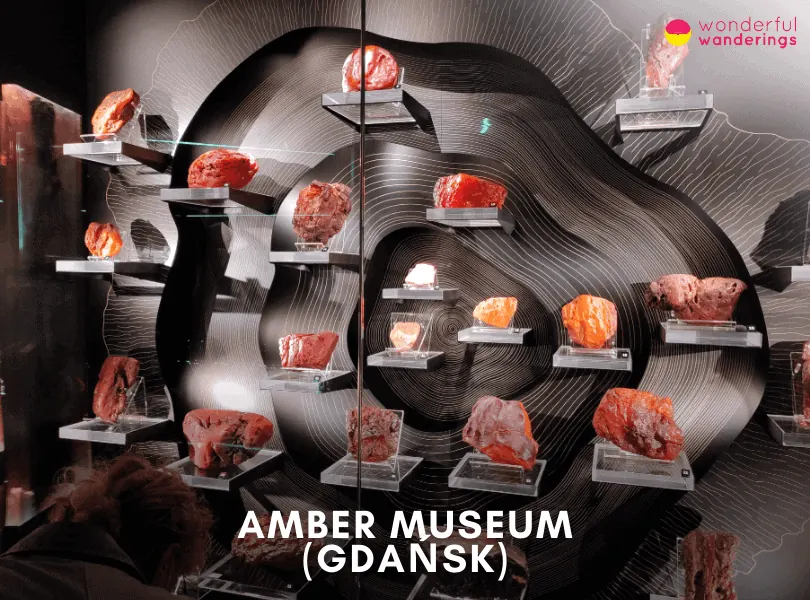
16. Oliwski Park
Oliwski Park, also known as Park Oliwski, is located in the Oliwa district of Gdańsk, Poland, at Opata Jacka Rybińskiego Street. The origins of today's Oliwski Park revolve around the monastery garden established by the Cistercian monks in the 12th century. In the mid-18th century, the last Cistercian abbot, Jacek Rybiński, commissioned the creation of a Baroque-style French garden in front of the Abbot's Palace, featuring geometric flower beds, canals and an avenue of linden trees known as the “Prince's View”. A new abbot brought a gardener to introduce an English-Chinese-style garden with winding paths, streams, bridges and exotic “temple” structures. In the 19th century, the park was opened to the public and expanded with thousands of tree varieties and an alpine rock garden. The park covers over 10 hectares.
The most famous part of Oliwski Park is the French Baroque garden in front of the Abbot's Palace. Visitors can admire the intricate topiary shrubs sculpted into ornamental shapes and symmetrical flower beds decorated with colorful seasonal plants. The garden also contains a large pond and fountains. Visitors can explore winding paths past old trees and water features like lakes and streams in the English-Chinese garden. Other sections include an alpine rock garden, a palm house greenhouse, whispering grottoes with unique acoustics and a Japanese garden with cherry trees. The park provides plenty of benches, lawns and secluded spots for relaxing amidst nature. Oliwski Park offers activities for visitors of all ages. Families enjoy picnicking on the lawns, feeding the ducks and swans and letting kids run around the dedicated playground. The palm house appeals to those interested in botany. Couples and seniors frequent the park to stroll along the scenic paths. The whispering caves are popular with kids.
The park is in Gdańsk's Oliwa district, near the Oliwa SKM commuter train station. Visitors can also take trams #2 or #3 from downtown Gdańsk to the Oliwski Park stop. Limited paid street parking is available around the park. Entry to enjoy Oliwski Park is free. The palm house typically charges a small admission fee of 5 PLN ($1, 1€, 0.86£). Visitors are welcome daily from around 5 am to 9 pm, though parts may close earlier. Guided walking tours of the park are available seasonally.
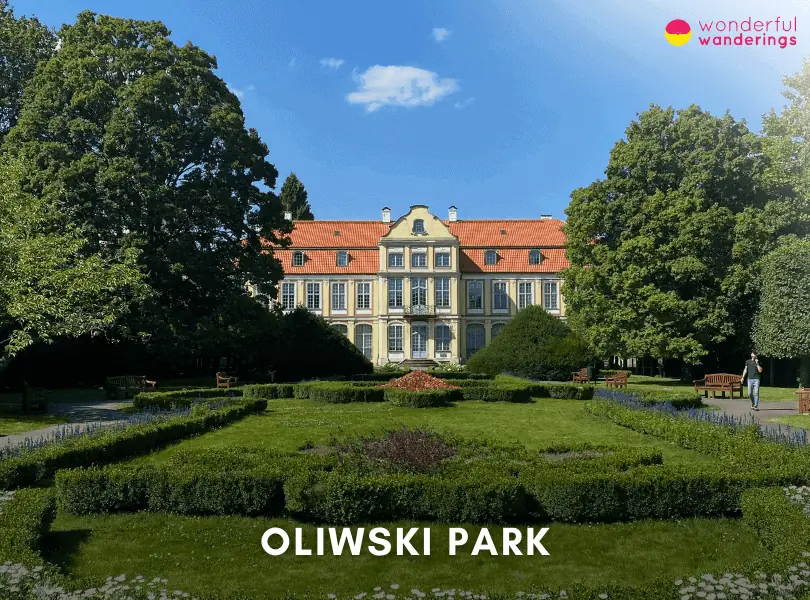
17. Museum of Gdańsk – Main Town Hall
The Museum of Gdańsk – Main Town Hall (Muzeum Gdańska – Ratusz Głównego Miasta) is located in central Gdańsk, Poland, at Długa 46/47, located at the intersection of Długa Street and Długi Targ Street. The Gothic-Renaissance Main Town Hall building dates back to the 14th century. It served as the seat of city authorities in Gdańsk for over 400 years until 1921. The structure was heavily damaged in World War II but carefully reconstructed by the 1950s. it houses the Museum of Gdańsk and some of the city's most ornate historic interiors.
The Museum features exhibits related to Gdańsk's history and culture across two floors and a tower. Highlights include the lavish Great Council Hall with intricate ceiling paintings, the Great Weta Hall's imposing marble fireplace, displays of silverwork and handicrafts showcasing Gdańsk's past trade wealth, period furnishings and temporary exhibitions in the Pile Gallery. The top floor houses an immersive exhibit recreating everyday life in pre-war Gdańsk, giving visitors a glimpse into homes, workshops and businesses as they were in 1939 before the destruction of WWII. Visitors can also access the 83-meter-high tower for impressive views across the historic Old Town and the iconic St. Mary's Church. The tower contains a Carillon bell instrument that plays tunes over the city. The museum appeals primarily to adults interested in local history, architecture, arts and culture. Allow at least 1-2 hours to see the main exhibits. School groups frequent the museum to enrich history lessons. Families enjoy the views from the tower. The building's historic spaces and tower stairs present some accessibility challenges.
The Museum of Gdańsk – Main Town Hall is located in the pedestrian zone of Długa Street, near Gdańsk Główny train station. Visitors can take trams #2 or #3 to the Brama Wyżynna stop nearby. Regular admission is 23 PLN for adults and 16 PLN for concessions. Mondays are free entry. Guided tour options are available.
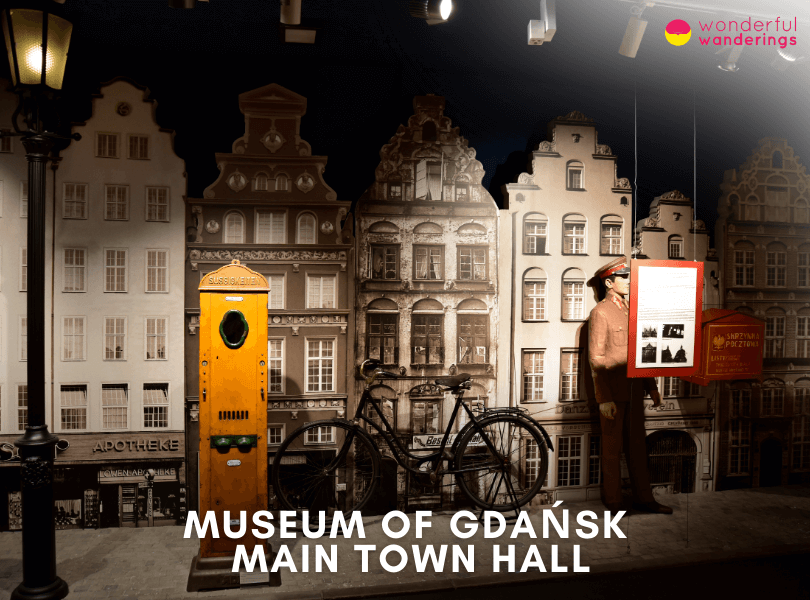
18. Museum of the Second World War
The Museum of the Second World War (Polish. Muzeum II Wojny Światowej) is located at pl. Władysława Bartoszewskiego 1, 80-862 Gdańsk, Poland. Gdańsk is a port city on the Baltic Sea coast in northern Poland. The museum has a history dating back to 2008, when it was established by a regulation of the Minister of Culture and National Heritage. Originally called the Westerplatte Museum in Gdańsk, it was renamed the Museum of the Second World War in Gdańsk in November 2008. The museum's purpose is to collect, preserve and showcase artifacts related to the history of World War II through exhibitions, education, publications and more.
The museum houses one of the world's largest exhibitions about World War II at over 5,000 square meters. Its vast collection and multimedia displays aim to comprehensively cover different aspects of the most devastating war in human history. Exhibits include photographs, propaganda posters, weapons, diaries, maps, film footage and other artifacts from wartime Poland and beyond. Visitors to the museum can explore several floors of captivating exhibits showcasing the course of WWII from beginning to end in immersive displays. There are also temporary exhibitions on special topics. The museum has a cinema showing war-themed films, a reading room, conference rooms, shops and cafés. Guided tours are available for groups. The museum appeals most to history buffs interested in understanding WWII through impactful artifacts. Students and educators who are seeking an informative experience about 20th-century history. Military enthusiasts who can examine weapons and uniforms up close. Travelers wanting to learn about Gdańsk's wartime fate under Nazi occupation.
The Museum of the Second World War is near Gdańsk Główny train station. It can also be reached easily by local tram, bus or taxi. Entry tickets to the main exhibition cost 23 PLN ($5, 5€, 3£) for normal admission and 16 PLN ($4, 4€, 2£) for concessions like students and seniors. Extra rates apply for special exhibitions, cinema, guides, etc. Admission is free on Tuesdays.
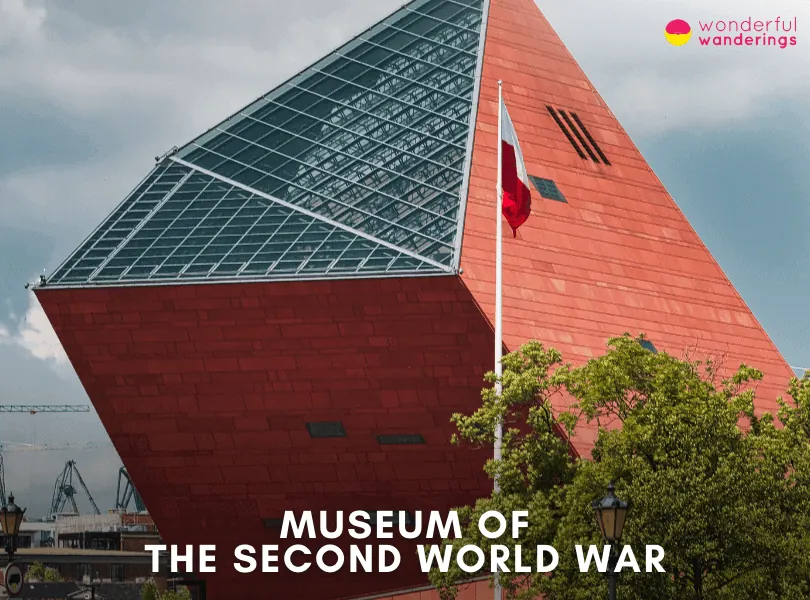
19. Brzeźno Pier
Brzeźno Pier (Molo w Brzeźnie) is located in the Brzeźno district of Gdańsk, Poland at Jantarowa Street 1. The pier was first built in the late 19th century, with an original length of 100 meters extending into the Bay of Gdańsk. It was later expanded after World War II to its current size of 136 meters long and 7.2 meters wide. The pier structure consists of a wooden deck supported on concrete pillars. Brzeźno Pier was a popular seaside attraction and recreational spot for residents. Its scenic views of the bay made it a favorite place for walks, fishing and family gatherings. During WW2, the original pier suffered damage and had to be rebuilt in its current location about a kilometer north of the original site.
Brzeźno Pier continues to be a popular seaside destination and tourist attraction. Visitors come to walk along the wooden deck, take in views across the bay and enjoy the seaside location. A few benches are along the pier for sitting, relaxing and picnicking. The shore ends have volleyball courts and a small playground for kids. Visitors can also access the adjoining beach for swimming during summer. A restaurant and bar is located next to the pier. The pier is busiest during summer months when locals and tourists alike come to enjoy the seaside spot. Its scenic bay views and wooden decking make it a great place for walks, fishing or simply relaxing by the Baltic Sea. The pier appeals most to adults seeking scenic views but also draws families with kids who enjoy the beach and playground.
Brzeźno Pier is near the city center in Gdańsk's northern Brzeźno district. Visitors can take tram line #2 from downtown Gdańsk to the Jantarowa stop to the pier. Limited parking is available near the pier. Entry and access to Brzeźno Pier is free. Visitors can walk onto the pier structure at any time. The adjoining restaurant charges separately for food and drinks. Walking the scenic pier to admire the bay views and sea air is the main activity for visitors.
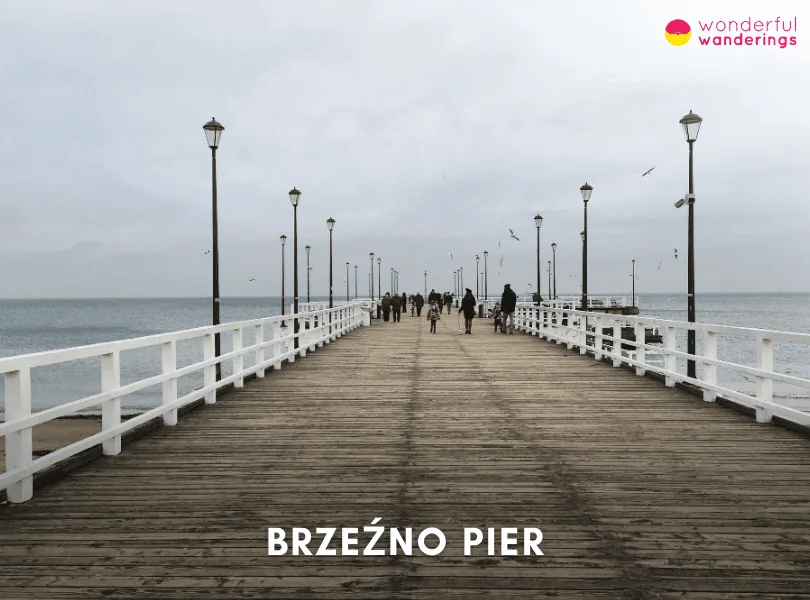
20. Bread Bridge – “Bridge of Love”
The Bread Bridge, known locally as Most Miłości (Bridge of Love) or Most Chlebowy (Bread Bridge), is located in Gdańsk, Poland, over the Radunia Canal at the intersection of Korzenna Street and Na Piaskach Street. It is called the Bread Bridge because bread sellers had stalls here in medieval times; it dates back to at least the 14th century. The brick bridge structure was built in the 19th century, though it has undergone reconstruction and renovation.
The bridge has taken on a new identity as a “love lock” bridge where couples affix padlocks marked with their names or initials to symbolize their everlasting love, similar to other “love lock” bridges in European cities. Locals often refer to it as the Bridge of Love.
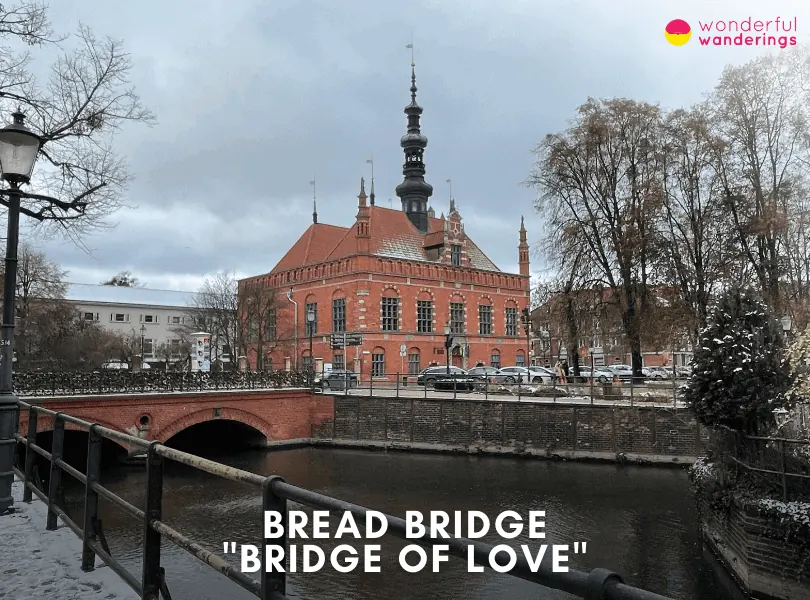
Visitors to the Bread Bridge can walk onto the small arched bridge to admire the padlocks left by lovers, young and old. The bridge provides beautiful views of the historic Old Miller's House on one side and makes a charming photo backdrop with its brick arches reflected in the Radunia Canal below. Couples looking to leave their love lock can purchase one from nearby souvenir shops or bring their own to clip onto the bridge's railings using the provided scissors. It is said that once the lock is secured, the couple should throw the key into the flowing waters below to seal their love forever. Guides warn not to throw keys into the canal from the bridge due to passing tour boats. The Bread Bridge appeals most to romantic couples looking to participate in the love lock tradition. Its central location in Gdańsk's atmospheric Main Town also draws tourists interested in photography, architecture and the city's history. The bridge is outdoors and fully accessible.
The Bread Bridge is near the Gdańsk Główny train station in the heart of Main Town. Visitors can take tram #2 from the train station to the Brama Wyżynna stop and limited paid street parking is available nearby. There is no admission fee to walk onto the Bread Bridge, view the love locks or take photos. Adding your lock typically costs around 15 to 30 PLN ($4, 4€, 2£) to ($8, 7€, 4£) though some bring their locks. Guided walking tours of Gdańsk often stop here to talk about the bridge's romantic evolution.
What are the best museums to visit in Gdańsk?
Listed below are the best museums to visit in Gdańsk.
- The National Museum in Gdańsk. The National Museum in Gdańsk houses an expansive collection spanning centuries of Polish and European artistic heritage across multiple buildings. Visitors can admire medieval altarpieces, Flemish and Dutch Old Master paintings, Art Nouveau works and more in this cultural gem's galleries. Guided tours provide deeper insight into the over 300,000 artifacts.
- The Museum of the Second World War. The Museum of the Second World War utilizes a sleek modern building and cutting-edge multimedia technology to vividly showcase the largest exhibition on WWII in the world. Visitors journey through immersive displays recounting the conflict's devastating events through artifacts, documents, recordings and visuals from the European and Pacific theatres.
- The European Solidarity Centre. The European Solidarity Centre recounts the dramatic story of the Solidarność movement, which began in Gdańsk's shipyard and sparked national protests, ultimately leading to the fall of communism. The interactive museum set in the actual historic shipyard site utilizes photos, videos, commissioned artworks and salvaged materials to showcase the movement's underground operations and the regime's brutal crackdowns, culminating in victory.
- The National Maritime Museum. The National Maritime Museum comprises multiple locations exhibiting model ships, nautical equipment, ethnographic objects and archaeological materials that bring Poland's thousand-year relationship with the sea to life. Of particular note is the museum's shipbuilding section with interactive displays demonstrating techniques perfected in Gdańsk's shipyards and the harbor warehouse granaries housing conserved artifacts from ancient wrecks.
- The Amber Museum. The Amber Museum celebrates the unique material that put Gdańsk on the map as an international trading hub – fossilized tree resin known as Baltic amber, nicknamed ‘Baltic Gold'. Visitors can learn about amber's formation, extraction methods, associated myths and legends, artistic uses and their role in local history and culture.
What are the best things to do in Gdańsk with kids?
Listed below are the best things to do in Gdańsk with kids.
- Explore Main Town Gdańsk. Visitors with their families can wander the cobblestone streets of Gdańsk Old Town, allowing kids to admire the colorful historic houses along Długi Targ's main avenue. Let them hunt for the cute little lion statues hidden in nooks across town, making sightseeing an engaging adventure. Visitors can also stop for some traditional Polish gingerbread cookies.
- Visit the Amber Museum. This museum allows kids to enter the unique world of Baltic amber, the “Gold of the North,” through interactive displays and hands-on activities. Children can touch real amber samples, marvel at amber's ability to preserve ancient plants and insects and learn how amber is mined and turned into beautiful jewelry.
- Ride the Ferris Wheel. The giant Ferris wheel soars over the Motława River waterfront, offering stunning panoramic views of Old Town's historic architecture across the river. The 15-minute ride is smooth and suitable for kids ages three and up for a thrilling bird's-eye perspective.
- See New Zoo Gdańsk. Get up close to over 2500 animals like playful polar bear cubs, lemurs and more at one of Poland's best zoos. Kids will love playgrounds, a petting farm with ponies and a miniature train ride around the spacious 123-hectare park.
- Tour the ORP Błyskawica Ship. This historic destroyer allows kids to imagine life as a sailor. Kids can climb steep steps between decks and explore the engine room, captain's bridge, sleeping quarters and more while learning about its amazing WWII survival story.
What are the best activities for a business traveler in Gdańsk?
Listed below are the best activities for a business traveler in Gdańsk.
- Attend a business networking event. Gdańsk has a growing startup and technology scene. There are regular business networking events, meetups and conferences happening that allow you to connect with other professionals. For example, events by Startup Grind Gdańsk or the Gdańsk Entrepreneurship Foundation are good opportunities. These events help expand your professional contacts.
- Have a business meeting at a trendy cafe. Business travelers can try one of Gdańsk's cool cafes for a casual business meeting, like Cafe Ferber or Cafe Sąsiedzi. These cafes have free WiFi and great coffee in creative spaces, perfect for informal discussions. The relaxing atmosphere facilitates good conversations.
- Tour the European Solidarity Centre. Understand Gdańsk's inspiring history by visiting this museum in the former shipyard where the Solidarity movement began. The interactive exhibits showcase the fight for freedom in Poland. Visiting inspires lessons in leadership, civic engagement and enacting change.
- Check out the business district. The Young City (Młode Miasto) neighborhood has many new office buildings, corporate headquarters and hotels perfect for business travelers. Multinational companies like Intel, IBM and State Street have major offices here. Walking the modern business district provides insight into the city's economic growth.
- Use the water tram to meet clients. Impress visiting clients using Gdańsk's unique water trams to tour the harbor and shipyards. The boats give unique vantage points to view the port's operations while discussing business. Rides start at Złote Tarasy mall.
Where is Gdańsk?
Gdańsk is a city located on the Baltic Sea coast in northern Poland. It lies at the mouth of the Motława River, connected to the Leniwka branch of the Vistula River delta. Gdańsk is in the Pomeranian Voivodeship, the province's capital and largest city. It is part of the Tricity metropolitan area and the nearby cities of Gdynia and Sopot. Gdańsk's geographic coordinates are 54°22′00′′N 18°38′00′′E.
What is the history of Gdańsk?
Gdańsk has a long and complex history spanning over a thousand years. It likely began as a Slavic fishing village in the 10th century. It was part of the Duchy of Pomerelia, ruled by the Samborides dynasty. Gdańsk joined the Hanseatic League in 1361, increasing trade and prosperity. The Teutonic Knights captured Gdańsk and ruled the city until 1454, when it returned to Polish rule under King Casimir IV. It was part of the Polish-Lithuanian Commonwealth and had much autonomy from 1569 to 1793. Gdańsk was annexed in 1793 by Prussia and later Germany up until 1919. It became the Free City of Danzig under the League of Nations. Nazi Germany attacked the city in 1939 to start WWII. Gdańsk was reincorporated into Poland after 1945. Gdańsk was the birthplace of the anti-communist Solidarność movement. Gdańsk has focused on rebuilding, attracting tourists and revitalizing its shipbuilding and maritime industries since the fall of communism.
What language is spoken in Gdańsk?
The official and predominant language spoken in Gdańsk is Polish. As a major port city and center of trade and immigration over centuries, the city has also had historical minorities of Germans, Dutch, Scots, French, Swedes and Kashubians influencing the local dialect of Polish. After WWII, most of the German minority were expelled. Polish is the common language used by the government, businesses, education and daily life. Due to tourism, history and commercial ties, many locals also speak English, German and Russian as second languages.
What time zone is Gdańsk in?
Gdańsk is in the Central European Time zone, UTC+1. It observes Central European Summer Time (UTC+2) when daylight savings time is in effect. Poland and the rest of the European Union shift clocks forward 1 hour to CEST on the last Sunday of March and revert to 1 hour on the last Sunday of October. Gdańsk uses CET in the winter months and CEST in the summer months. The time in Gdańsk is the same as most of Poland, Germany, France and other Central European countries.
How many people live in Gdańsk?
The population of Gdańsk is 457,298 people as of 2023. There are 221,523 men and 235,775 women living in Gdańsk. Regarding age breakdown, 67,527 children under 14 comprise 15% of the population. The number of teenagers between 15-19 is 23,348 or 5%. In the working age group of 20-59 years old, 295,027 people or 64% of the Gdańsk population. For the elderly over 60, there are 71,398 people, which is 16% of the total.
What are the most interesting facts about Gdańsk?
Listed below are the most interesting facts about Gdańsk.
- Currency. The official currency of Poland and Gdańsk is the Polish złoty (PLN). Banknotes come in 10, 20, 50, 100, and 200 złoty denominations. Coins come in 1, 2, 5, 10, 20, and 50 groszy.
- Time Zone. Gdańsk is in the Central European Time Zone, UTC+1. It observes daylight saving time, shifting clocks forward 1 hour to UTC+2 in the summer. Gdańsk is 1 hour ahead of GMT/UTC in Winter. It is 2 hours ahead of GMT/UTC in summer.
- Language. The official and predominant language spoken in Gdańsk is Polish. Facts about Poland are that many locals also speak English, German, Russian, or Kashubian (regional dialect). English is widely understood in restaurants/cafes.
- Power Plugs. Poland uses the Type E power plug, which has two round prongs. The standard voltage is 230V, and the standard frequency is 50Hz. Visitors from countries like the USA will need an adapter and possibly a voltage converter to charge devices.
How many days are needed to see Gdańsk?
It is recommended to stay for three days to see what Gdańsk offers. Krakow's Old Town offers historic architecture and Polish cuisine on day one. Day two contrasts Auschwitz's sobering history with Wieliczka Salt Mine's underground sculptures. Zakopane's Tatra Mountains provide Gubalówka Hill's views, scenic hikes, highlander crafts shopping and charming wood architecture relaxation on day three. Splitting time between cultural Krakow, powerful Auschwitz history and mountainous Zakopane nature creates a diverse Poland introduction in just three days. Focusing on one or two cities allows for a manageable highlight taste rather than an overly rushed experience. Krakow introduces Polish history and culture, while Wieliczka adds memorable underground contrast before the Tatra Mountains' active conclusion. Auschwitz provides an impactful history lesson before enjoying Zakopane's lighter mountain resort attractions. This varied itinerary showcases the best of Poland in an engaging three-day timeline.
Is Gdańsk worth visiting?
Yes, Gdańsk is worth visiting. Gdańsk has a fascinating history and beautiful architecture, making it an appealing destination. Some top attractions include the iconic Main Town with the Long Market and Neptune's Fountain, the enormous Gothic St. Mary's Church and the historic shipyard where the Solidarity movement was born. The Old Town has lovely buildings showcasing Flemish Dutch and Hanseatic German influences. Beyond the architecture, Gdańsk has great museums, lively entertainment areas, good shopping and delicious cuisine with Baltic and Polish influences. The amber jewelry and handicrafts are especially notable. With convenient transport links, reasonable prices and a seaside location, Gdańsk offers an enjoyable experience for travelers interested in culture, history, architecture and maritime ambiance.
Is Gdańsk expensive to visit?
No, Gdańsk is considered an affordable destination for travelers. Accommodation costs are relatively low compared to other European cities. Good hotels and apartments in the city center can be found for $50 (46€, 39£) to $70 (64€, 55£) per night on average. Hostels and budget options bring prices even lower. Public transportation and taxis are quite cheap. A taxi ride within the center costs between $2 (2€, 1£) and $5 (5€, 3£). Public transit tickets start at $1 (1€, 0.86£). Food and dining out are reasonably priced. A meal at an inexpensive restaurant costs between $8 (7€, 5£) to $11 (10€, 8£) per person. Even mid-range places have entrees between $5 (5€, 3£) and $11 (10€, 8£). Groceries from markets and shops are also affordable. Many attractions are inexpensive as well. Museums and churches have tickets from $1 (1€, 0.86£) to $5 (5€, 3£) on average. Walking tours cost between $11 (10€, 8£) and $17 (15€, 13£). It can be accessed on foot, so visitors don't need to spend much money around the compact Old Town area.
Is Gdańsk safe to visit?
Yes, Gdańsk is very safe to visit. Gdańsk is considered very safe due to low violent crime and theft rates compared to European cities of similar size. Tourist-targeted violent crime is extremely rare. There is a visible police presence deterring criminals in busy areas like the Old Town. Historic cobblestone streets are well-lit at night for safe walking. Nightlife attracts more families than party-goers, creating a relaxed ambiance after dark. Gdańsk remains safe, with locals comfortable at night. Basic precautions like avoiding deserted areas and watching for pickpockets are still advised. Gdańsk's community atmosphere makes it a low-risk, welcoming Polish destination for travelers.
Is Gdańsk easy to visit with kids?
Yes, Gdańsk is easy to visit with kids. Many main sites in Gdańsk, like the Artus Court, the Crane and the Amber Museum, have interactive exhibits and displays to engage kids. There is also a puppet theater and a zoo. The old town has colorful architecture, street performers and cafes to stop at along cobblestone streets, which kids tend to enjoy. Accommodations in Gdańsk, such as hotels and apartments, provide more space and amenities for families. There are playgrounds, parks and beaches for letting kids play and explore. The Oliwa Park has hiking trails through gardens. Kids can discover Gdańsk's maritime history by taking boat rides on the Motława River or out to Westerplatte. Gdańsk has plenty of kid-friendly attractions and activities and offers an accessible vacation for families.
What is Gdańsk famous for?
Gdańsk is most famous for its historic role as a major port city and its connections to amber trading and shipbuilding. Secondly, Gdańsk is famous for being the birthplace of the Solidarity movement in 1980 under leader Lech Wałęsa, as the shipyards saw strikes that inspired protests against communist rule internationally. Shipbuilding remains a key industry, centered around the renowned Gdańsk Shipyard. Thirdly, Gdańsk is known for its beautifully restored historic old town along the Motława River. Lastly, Gdańsk is known as the “Amber Capital”, featuring an Amber Museum and thriving amber crafts due to the “Baltic Gold” gemstone being abundant locally. Gdańsk attracts visitors to experience its blend of culture, architecture and complex history.
Who are the most important people born in Gdańsk?
Listed below are the most important people born in Gdańsk.
- Günter Grass. Günter Grass was a famous German novelist, poet, playwright, illustrator, graphic artist, sculptor and recipient of the 1999 Nobel Prize in Literature. He was born in the Free City of Danzig (now Gdansk, Poland) on October 16, 1927. The Grass is best known for his first novel, “The Tin Drum”, published in 1959, about the Nazi era in Danzig. He lived most of his life in Germany and was an outspoken voice on political issues. Grass died on April 13, 2015 in Lübeck, Germany.
- Daniel Gabriel Fahrenheit. Daniel Gabriel Fahrenheit was a Dutch physicist, engineer and glass blower best known for inventing the mercury thermometer and Fahrenheit temperature scale. He was born in Danzig (now Gdansk, Poland) on May 24, 1686. Fahrenheit invented the first reliable thermometer using mercury instead of alcohol in 1714. The Fahrenheit temperature scale was devised so the freezing point of water was 32 degrees and human body temperature was 96 degrees. He spent most of his life working in Amsterdam and died there on September 16, 1736.
- Arthur Schopenhauer. Arthur Schopenhauer was an influential German philosopher best known for his 1818 work “The World as Will and Representation”. He was born in Danzig (now Gdansk, Poland) on February 22, 1788. Schopenhauer's philosophy asserted that the will is the ultimate reality and that life involves endless striving and dissatisfaction. His ideas influenced later thinkers like Nietzsche and Wittgenstein. Schopenhauer lived in many places before settling in Frankfurt, where he died on September 21, 1860.
- Johannes Hevelius. Johannes Hevelius was an astronomer and brewer who made important observations of comets and described lunar topography. He was born in Danzig (now Gdansk, Poland) on January 28, 1611. Hevelius built observatories and designed advanced astronomical instruments to study the moon, sun and stars. His detailed lunar maps from the 1640s were the best until telescopic photography. He spent his life in Danzig, where he died on his 76th birthday on January 28, 1687.
- Daniel Chodowiecki. Daniel Chodowiecki was a popular Polish-German painter and printmaker born in Danzig (now Gdansk, Poland) on October 16, 1726. He is best known for capturing scenes of bourgeois life in the late 18th century, especially with his sympathetic depictions of Jews and women. Chodowiecki did thousands of etchings illustrating books and magazines. He spent most of his prolific career in Berlin, where he died on February 7, 1801.
What to eat in Gdańsk?
Listed below are what you can eat in Gdańsk.
- Pierogi. Filled dumplings like meat, potato and cheese pierogi are extremely popular across Poland, but Gdańsk has developed its own unique regional varieties using local ingredients. Gdańsk pierogi may feature fillings of Baltic seafood like herring, salmon or cod blended with onions and herbs for a taste of the Pomeranian coast. The pierogi are still boiled and then crisped up through pan-frying or baking as is tradition. It is one of the best dish to taste in Poland .
- Bigos. Bigos is a beloved Polish hunter's stew and Gdańsk's proximity to Kashubian forests and farmland provides easy access to ingredients like pork, mushrooms and sauerkraut. Restaurants across Gdańsk simmer their bigos for hours, allowing the flavors of meat, cabbage and spices to mingle into the hearty, comforting dish the city is known for.
- Goldwasser. Gdańsk's famous Goldwasser liqueur has been produced in the city using secret herbal formulas since 1598 and is still made today with flakes of 22-karat gold for visual brilliance. The Goldwasser distillery in Gdańsk continues centuries-old traditions by offering tours and tastings of the signature sweet and spicy spirit.
- Fresh seafood. Gdańsk's seaside location on the Baltic makes it a prime destination for fresh seafood like salmon and herring caught right off the coast. Restaurants across Gdańsk take full advantage by serving simply prepared fish to highlight the fresh flavors or incorporating the bounty into rich seafood stews.
- Sledzie po kaszubsku. Sledzie po kaszubsku features pickled herring, a specialty of the Kashubian region surrounding Gdańsk, topped with hard-boiled eggs, potatoes, onions and oil for a light appetizer. The dish is a celebration of local seafood and cultural traditions.
- Gdańsk gingerbread. Gingerbread baking with honey and spices has been a generations-old craft tradition in Gdańsk, resulting in elaborately decorated gingerbread sold across the city.
What are the best places to eat in Gdańsk?
Listed below are the best places to eat in Gdańsk.
- Słony Spichlerz. Słony Spichlerz is a restaurant market located in a former granary building, with stalls serving various international cuisines that customers can mix and match alongside a popular shared communal dining space that draws locals and visitors. The recently opened market features high-quality dishes showcasing diversity, from Mediterranean and Asian to Polish and vegetarian.
- Brovarnia Gdańsk. Brovarnia Gdańsk comprises a brewery producing fresh beer and a restaurant set in the historic Hotel Gdańsk building, where visitors can enjoy delicious Polish fares such as pierogi dumplings paired with the house-made brews in a cozy vintage interior decorated with regional art and photography.
- Tawerna Mestwin. Tawerna Mestwin provides a charming, cottage-style setting decorated with regional Kashubian folk crafts and dolls, serving homestyle dishes like pancakes, soups and fried herring that immerse guests in the authentic local cuisine and culture in a shadowy, almost haunting dining room.
- Pierogarnia Stary Mly. Pierogarnia Stary Mly focuses on Polish dumplings, with customers able to watch pierogi being freshly prepared with sweet and savory fillings right at the front of this small set of restaurants before enjoying the huge portions of doughy delicacies that draw constant crowds. Pierogarnia Stary Mly is also one of the best restaurants to eat in Gdańsk.
- Ostro. Ostro is a set of restaurants offering exceptional Neapolitan-style pizza baked in wood-fired ovens with great ambiance, considered among the top pizza destinations in Gdańsk, run by a team focused on quality ingredients and preparation to craft perfect pizza.
What are the best areas to stay in Gdańsk?
Listed below are the best places to stay in Gdańsk.
- Old Town. The Old Town neighborhood attracts tourists to top attractions like the iconic St. Mary's Church, Neptune's Fountain and the Gdańsk Crane. Old Town gives visitors an authentic perception of this Baltic port city with its cobblestone streets, medieval architecture and excellent access to restaurants and shops. Old Town is also one of the best places to stay for visitors traveling alone and with families.
- Wrzeszcz. Wrzeszcz is perceived by tourists as Gdańsk's trendy, youthful neighborhood, filled with energy and active nightlife. Its proximity to Gdańsk's modern shopping centers and malls and easy public transit connections to Old Town attractions make Wrzeszcz popular with visitors.
- Oliwa. Tourists perceive Oliwa as an upscale, green suburban neighborhood perfect for escaping the city crowds. Oliwa features leafy parks, a renowned cathedral and quick train links that allow easy access to Gdańsk's top sites. Oliwa offers a friendly neighborhood for local and foreign tourists.
- Jelitkowo. Jelitkowo gives tourists a beautiful perception of Gdańsk's coastal charm while remaining connected to city sights. Jelitkowo highlights its sandy beaches, pretty fishermen's houses and a more relaxed seaside atmosphere. This neighborhood offers a safe place to stay for solo travelers.
What are the best accommodations to stay in Gdańsk?
Listed below are the best accommodations to stay in Gdańsk.
- Puro Gdańsk Stare Miasto. Puro Gdańsk boutique hotel features a perfect location to explore Gdańsk's Old Town sites like St Mary's Church, situated just steps away across the Motława River. Its 86 rooms feature an urban-chic style with polished concrete walls, floor-to-ceiling windows and luxury amenities like rainfall showers. Visitors can enjoy views of the river and Old Town while dining at the on-site steak restaurant or sipping cocktails on the 8th-floor bar's outdoor terrace. Business travelers can use the 24/7 gym and modern meeting rooms at this highly-rated property that caters to solo guests seeking stylish accommodations in the heart of historic Gdańsk. Puro Gdańsk Stare Miasto is considered one of the best hotels to stay in Gdańsk.
- Hotel Villa Eva. Hotel Villa Eva in Gdańsk's Wrzeszcz district charms guests with its historic early 20th-century architecture fused with modern interior design. Its 33 comfortable rooms with classic furnishings and modern bathrooms provide a quiet retreat, with delightful garden views from the restaurant terrace available to all guests. Situated close to popular attractions like Sopot and the Ergo Arena, Villa Eva allows easy transit access around Gdańsk while offering free parking on-site for those with cars. Leisure and business travelers enjoy the hotel's friendly service and relaxed ambiance, whether visiting Gdańsk for work or a holiday.
- Novotel Gdańsk Marina. Novotel Gdańsk Marina provides contemporary accommodations along a sandy beach in Jelitkowo. All 206 rooms feature balcony views of the Baltic coastline, just steps from the hotel doors via a picturesque seaside promenade stretching for miles. Leisure travelers can use amenities like the indoor swimming pool, while business guests utilize the seven high-tech meeting rooms during their stays. Families appreciate the children's play area and video game consoles when visiting this stylish hotel that blends coastal serenity with easy transit access to Gdańsk's attractions.
- Sofitel Grand Sopot. Sofitel Grand pampers guests with elegant design and indulgent amenities from Gdańsk. Guests relax on the private beach, get pampered at the spa or sample creative Polish cuisine at the renowned Malinowy Młyn restaurant, all while enjoying panoramic sea views. The 182 rooms blend classic and contemporary styles with upscale details like Hermès toiletries, marble bathrooms and butler service in premium suites catering to VIP travelers. High-end leisure and business visitors appreciate the sophistication of this relaxing resort hotel neighboring lively Gdańsk.
- Focus Hotel Premium Gdańsk. Focus Hotel Premium offers sleek, modern accommodations in Gdańsk's trendy Wrzeszcz district. Its loft-style rooms feature exposed brickwork and contemporary art paired with amenities like rainfall showers, air conditioning and Simmons mattresses. Located adjacent to Wrzeszcz's train station, Focus Hotel Premium allows easy transit access for exploring Gdańsk while providing an on-site restaurant and 24/7 gym. Solo guests mingle in the lobby bar and appreciate the friendly yet quiet atmosphere, perfect for relaxing after busy days of sightseeing or work around the city.
How to get from Gdańsk to Warsaw Chopin Airport WAW?
There are a few ways to get to Warsaw Chopin Airport from Gdańsk. These are by plane, train, bus and car. Firstly, LOT Polish Airlines operates direct flights from Gdańsk Lech Wałęsa Airport (GDN) to Warsaw Chopin Airport (WAW) several times daily, with a flight time of 1 hour. Secondly, Gdańsk Główny offers direct train services to Warsaw Centralna station. The journey takes 3-4 hours. Thirdly, PolskiBus and FlixBus offer daily intercity bus routes between Gdańsk and Warsaw Chopin Airport. The bus journey takes 4 to 5 hours. Lastly, driving from Gdańsk to Warsaw Chopin Airport takes 4 hours, covering around 330 kilometers (205 miles) and taking Highway A1. The quickest option is to fly or take the direct train between Gdańsk and Warsaw. Buses run regularly between the two cities for more budget options. Driving allows flexibility but incurs fuel costs over the 4+ hour journey between the cities.
How to get from Gdańsk to Warsaw?
There are a few ways to get to Warsaw from Gdańsk. These are by plane, train, bus and car.
Firstly, LOT Polish Airlines operates direct flights from Gdańsk Lech Wałęsa Airport (GDN) to Warsaw Chopin Airport (WAW) several times daily. Visitors can take a bus, train or taxi from the airport to Warsaw city center. Secondly, Gdańsk Główny offers direct train services to Warsaw Centralna station. Warsaw Centralna station is located in the city center. Thirdly, PolskiBus and FlixBus offer daily intercity bus routes between Gdańsk and Warsaw. The bus journey takes 4 to hours. The Warsaw bus station is next to Warsaw Centralna train station in the city center. Lastly, driving from Gdańsk to Warsaw city center takes 4 hours, covering 330 kilometers (205 miles) taking Highway A1. The quickest and most convenient options are to take the direct train or a flight to Warsaw and then public transportation or taxi to the city center. Buses also connect the two cities fairly fast and cheaply.
Where to go shopping in Gdańsk?
There are several great places to go shopping in Gdańsk. These are Forum Gdańsk, Galeria Bałtycka, Madison, Galeria Metropolia and Galeria Klif. Firstly, Forum Gdańsk is the largest and newest shopping mall near the city center, featuring over 220 shops, restaurants and a movie theater. Bright and spacious with a modern design, Forum Gdańsk contains major international brands alongside local shops with something for everyone's tastes and budget. Secondly, Galeria Bałtycka is a mid-sized, popular shopping center in the Wrzeszcz district with around 200 stores and eateries. Shoppers can browse apparel, electronics, home goods and more at accessible prices or stop for a meal at one of the cafes and restaurants on-site. Thirdly, Madison is a shopping mall near the Gdańsk train station boasting around 100 fashion and retail outlets. The ornate interior with ample marble and statues creates a refined shopping ambiance in the city's heart. Fourthly, Galeria Metropolia contains many shops and boutiques, from global brands to local designers, alongside dining options mainly geared toward families. Located away from the tourist areas, it caters well to local shoppers in Gdańsk. Lastly, Galeria Klif features around 140 stores ranging from luxury fashion houses to specialty shops that attract shoppers looking for exclusive products. Galeria Klif contrasts with Gdańsk's more affordable malls.
What festivals or events are taking place in Gdańsk?
Listed below are the festivals or events that are taking place in Gdańsk.
- St. Dominic's Fair. The St. Dominic's Fair is an annual open-air cultural and trade festival held in Gdańsk for three weeks from late July to mid-August. It features market stalls selling crafts, food, goods, street performances, concerts, competitions and other entertainment. It occurs primarily in the Main Town and attracts 5-8 million visitors annually.
- Gdańsk Shakespeare Festival. The Gdańsk Shakespeare Festival is an annual theater and arts festival held in July-August across venues in Gdańsk and the surrounding region. It showcases Shakespeare productions and adaptations by theater companies from Poland and around the world. The festival also includes workshops, panel discussions and film screenings related to Shakespeare's works.
- Globaltica World Music Festival. Globaltica Festival takes place in Gdańsk for three days each summer, celebrating world music and culture. It features performances by musicians from Poland and other countries and a market with international food, crafts and goods. The festival aims to bring together diverse cultures and ethnic traditions through music. This music fest is one of the much-awaited festivals in Poland and Gdańsk .
- Baltic Sail Gdańsk. Baltic Sail Gdańsk is a 4-day maritime culture festival focused on sailing ships, boats and maritime traditions in early June. Tall ships and historic vessels sail into Gdańsk's port, with a parade and competitions in the waters off Gdańsk. The shoreside festivities feature concerts, fairs, reenactments, food stalls and family activities.
PIN FOR LATER
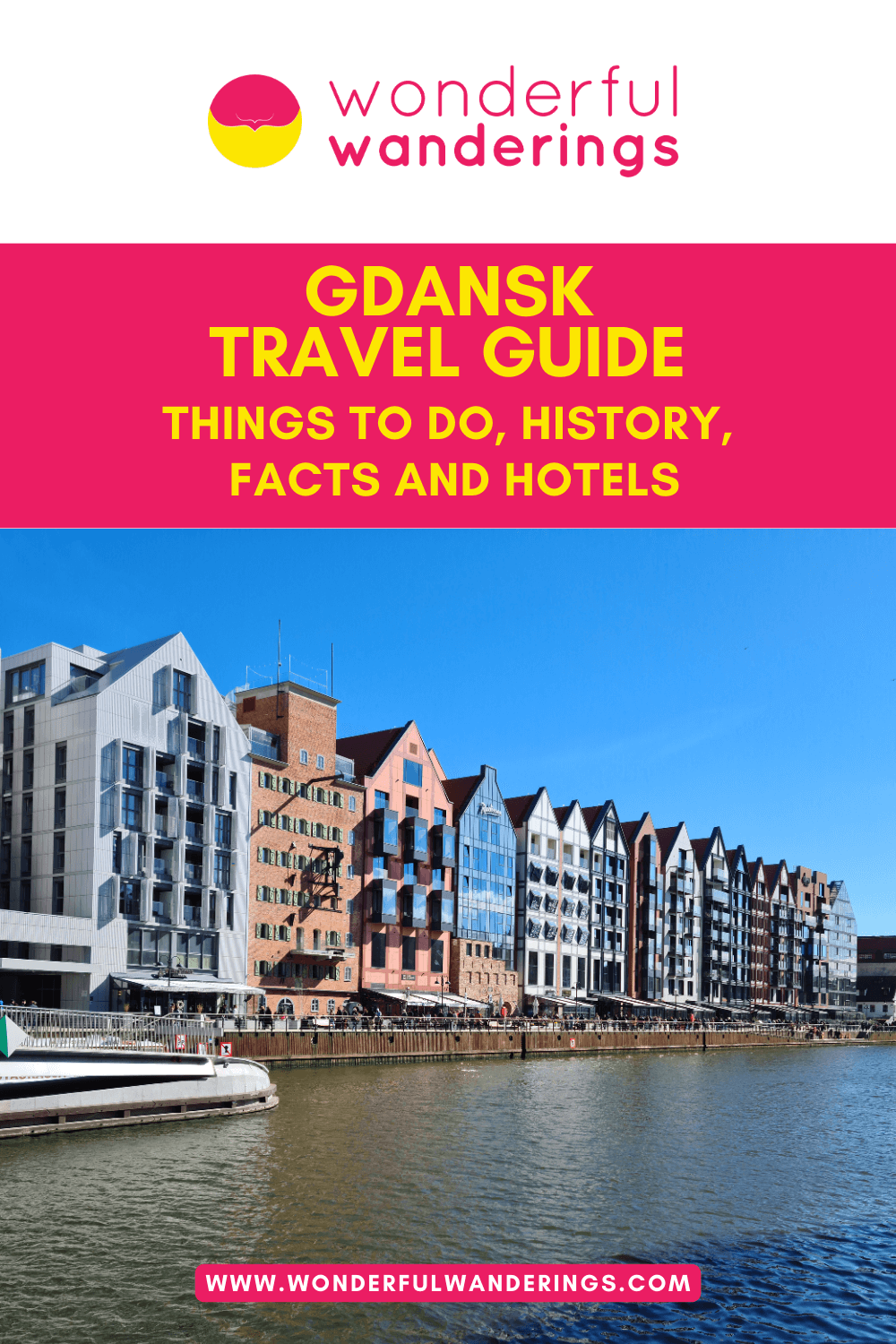
Find below our best travel guides about Poland.

24 Interesting Facts about Poland

18 Best Beaches to Visit in Poland

Renting a Car in Poland: 34 Important Tips (2024)

18 Best Castles to Visit in Poland

Prices in Poland: Is Poland Expensive?

25 Traditional Polish food and Where to Eat Them in Warsaw

36 Most Famous Polish people: Artists, Chefs and Scientists!

Dates of Holidays in Poland 2024 [Annually updated]

22 Top Festivals to Attend in Poland for 2024

Driving in Poland: Road Safety, Driving Etiquette and How to Rent a Car

Transportation Guide in Poland: Which One Is Best for You?

17 Fabulous Things to do in Bydgoszcz: Museums, History and Travel Guide

19 Impressive Things to do in Krakow: Museums, History and Travel Guide

19 Top Things to do in Warsaw: Museums, History and Travel Guide

17 Best Things to do in Gdynia: Museums, History and Travel Guide

17 Best Destinations in Poland to visit all year round!

Auschwitz tour review: an Auschwitz tour from Krakow

Poland Vacation Guide – Everything to plan your trip
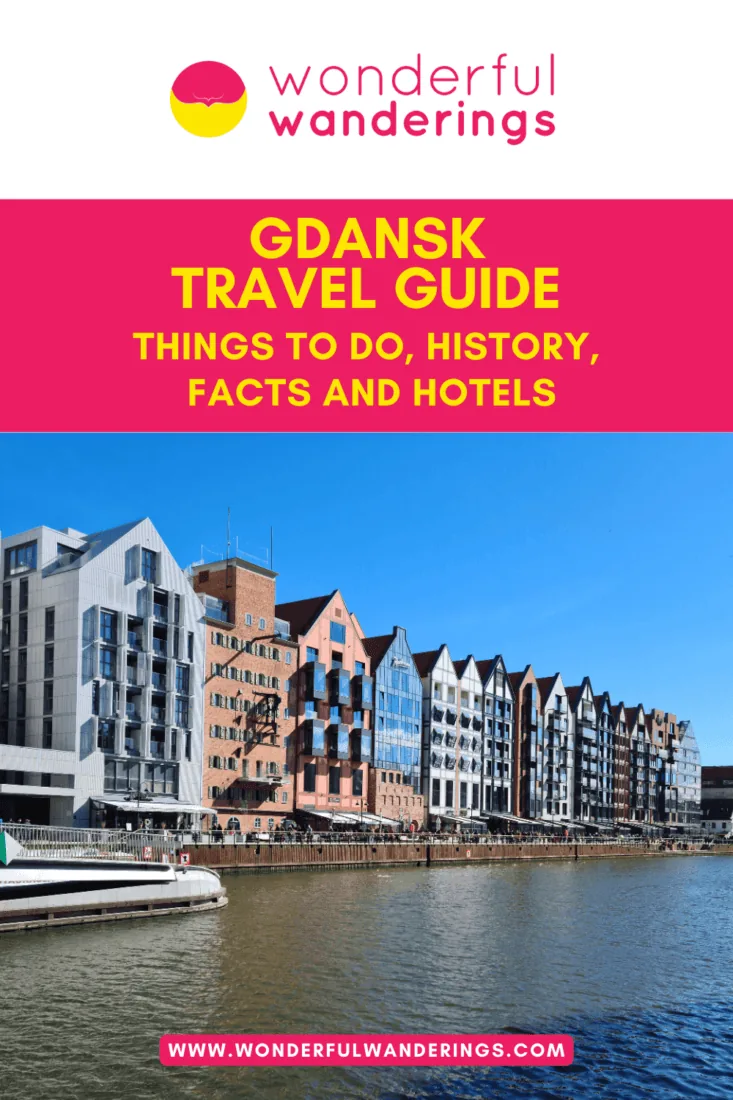
The editorial team at Wonderful Wanderings brings together travel experts with backgrounds in travel writing, web development and digital marketing. The team, through their collaborative effort, provides readers with relevant travel experiences and up-to-date digital content. The vast expertise within the team ensures an informative blend of travel stories and useful online travel guides and trip experiences, built on a foundation of both industry recognition and hands-on global adventures. Learn more about Wonderful Wanderings
Your email address will not be published. Required fields are marked *
Join 58,000+ other Wonderful Wanderers!
As an Amazon Associate I earn from qualifying purchases.
- South Africa
- El Salvador
- Bosnia and Herzegovina
- North Macedonia
- Czech Republic
- Transnistria
- Liechtenstein
- North Cyprus
- New Zealand
- Map with posts
- Alternative Guides
- Architecture Guides
- Cafe Guides
- Itineraries
- Neighborhood Guides
- Travel Guides
- Travel Tips
- Photo Galleries
- Photo Locations
- Solo female travel
- Train Travels
- Work with me
- Privacy Policy
19 Amazing Things to Do in Gdansk, Poland
Since I was a little kid I’ve been visiting Gdansk, Poland fairly frequently, either to visit family’s friend and spent holidays there, to meet my friends or for work reasons. And every time I was falling for the place more and more.
Gdansk is one of my favorite places to visit in Poland and I dare to say it’s also one of the most beautiful and fascinating Polish destinations.

And so when the year 2020 kind of forced me to spend my holidays in Poland I’ve decided to visit Gdansk properly and play a tourist there again. After all, I haven’t done that in years and in that time the city has changed a lot and there are even more great Gdansk attractions there.
I spent a week in Gdansk and I loved it! It was so good to rediscover all the best things to do in Gdansk again and fall for the city all over again.
And today I’m more than happy to share with you all the city has to offer so you can plan your own trip to Gdansk too. Trust me, you definitely want to visit the place, it’s simply amazing! Just look below at what to in Gdansk, the list of all the Gdansk must-see is fairly long and everyone will find something interesting for themselves there.
Planning a trip to Gdansk?
Here are the highly-rated hotels, tours, and services recommended for your trip:
Accomodation:
- Gotyk House (9.3/10)
- PURO Gdańsk Stare Miasto (9.0/10)
- Craft Beer Central Hotel (9.1/10)
Tours and activities:
- Gdansk Private Walking Tour: Legends and Facts
- Malbork Castle Regular Tour
- Solidarity Tour
Internet: Stay connected with Airalo eSim card – click here to get yours!
Airport Transfer: Use Welcome Pickups for a smooth ride from the airport to your accommodation in Gdansk. Click here to book the airport transfer.
Insurance: Get insured for your trip to Poland with SafetyWing
Car rental: Compare prices and find the best deals on rental cars in Poland on Discover Cars .
Table of Contents
Why visit Gdansk
Gdansk is one of the most beautiful cities not only in Poland but in Europe ( here you can see my collection of Gdansk pictures that simply prove it ). But the place is not only insanely pretty, it is also very interesting in terms of attractions and history.
Gdansk dates back to the end of the 10th century and due to its location at the Baltic Sea coast it always played an important role in the region but the most important time for Gdansk happened in the 20th century when the city was a scene of some of the most important events in the world. This is where World War 2 started in 1939, this is also where the Solidarity movement was established – it eventually led to the collapse of communism in Eastern Europe.
Gdansk is also a perfect base to explore the surrounding region that offers a lot of diverse attractions.

How to get to Gdansk
Getting to Gdansk is very easy. The local airport serves numerous destinations all over Europe so finding cheap flights to Gdansk shouldn’t be an issue.
If you are coming from another place in Poland it shouldn’t be a problem either as there are direct trains to Gdansk from all the major cities in Poland (i.e. Warsaw , the capital, is only less than 3 hours away).
How to get around Gdansk
Many of the places to visit in Gdansk are located in the central part of the city and you can easily get there on foot.
If you plan to visit attractions a bit further (like the seaside, Oliwa or Westerplatte) you can use public transport – it’s fairly good in Gdansk, you can use buses, trams or trains to get around.

How many days for visiting Gdansk
You can see the major Gdansk attractions (without really visiting the main museums) in one day. But to be honest that’s not enough to fully enjoy the city.
I think you need 3 days for Gdansk itself (that includes visiting European Solidarity Center and World War 2 Museum which both, I believe, are a must) and then a few more days to go for day trips.
So yes, it’s fine to spend a weekend in Gdansk but if you come here for a week you also won’t be bored.
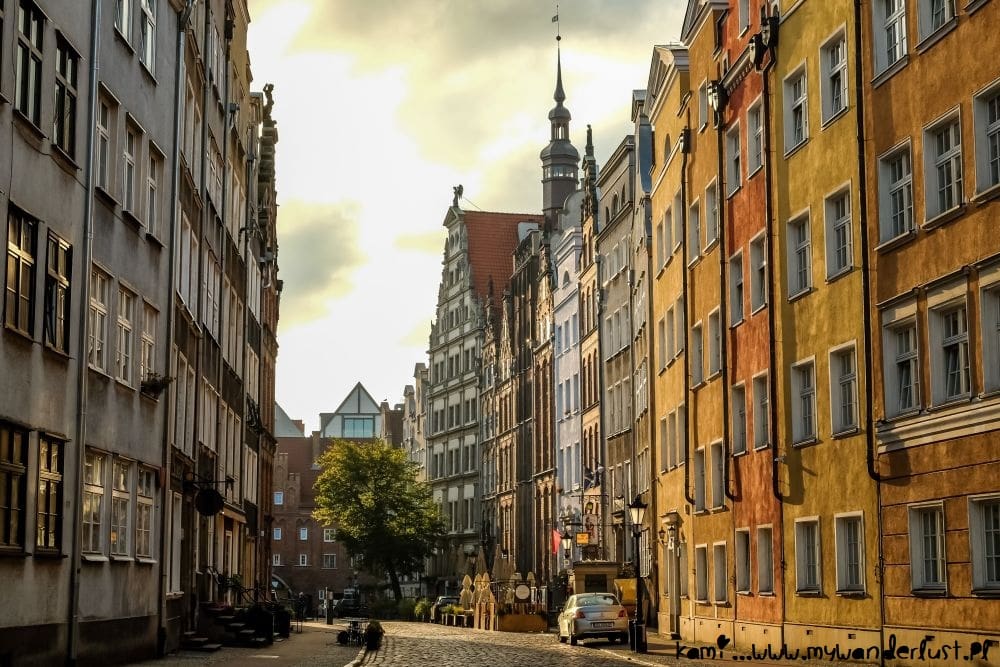
- Are you planning a trip to Poland? Be sure to join my Facebook group about traveling in Central Europe and be part of the amazing community of like-minded travelers. Click here for the access!
- Don’t want to miss new articles? Sign up to the monthly newsletter to receive all the updates to your mailbox!
Things to do in Gdansk
And now, let me finally tell you about the best things to do in Gdansk. They are listed in no particular order but overall make a perfect overview of what you can expect from Gdansk.
Wander around the Old Town
The Old Town is the oldest part of Gdansk, it gained the rights already in 1236. Today this is the prettiest area of the city and that’s where you will find the majority of Gdansk attractions.
But before you start the proper Gdansk sightseeing be sure to just wander around the Old Town and enjoy the place. This area is simply the prettiest with rows of beautiful architecture that always reminds me a bit about Amsterdam. Be sure to look at all the details as you might find some real gems and interesting photo angles there. Such an easy, curious, and relaxing walk around will let you appreciate this part of Gdansk even more.
You will find the prettiest streets between Świętojańska, Ogarna and Targ Węglowy streets and Motława river on the other side.
The most popular one, however, is Długi Targ, where you can see some of the major landmarks in Gdańsk – the Town Hall, the Neptune’s Fountain, or Artus Court. You can enter this beautiful pedestrian street by one of two gates: Golden or Green and see Długi Targ in its full glory, you can also get here from one of the backstreets.
You can also discover the Old Town with the tour. This way you can also learn more about Gdansk and its history. Here are the recommended tours:
- Gdańsk: City Sights and History Guided Walking Tour
- Gdansk Old Town 2-Hour Walking Tour
- Gdańsk: Everyday Bike Tour
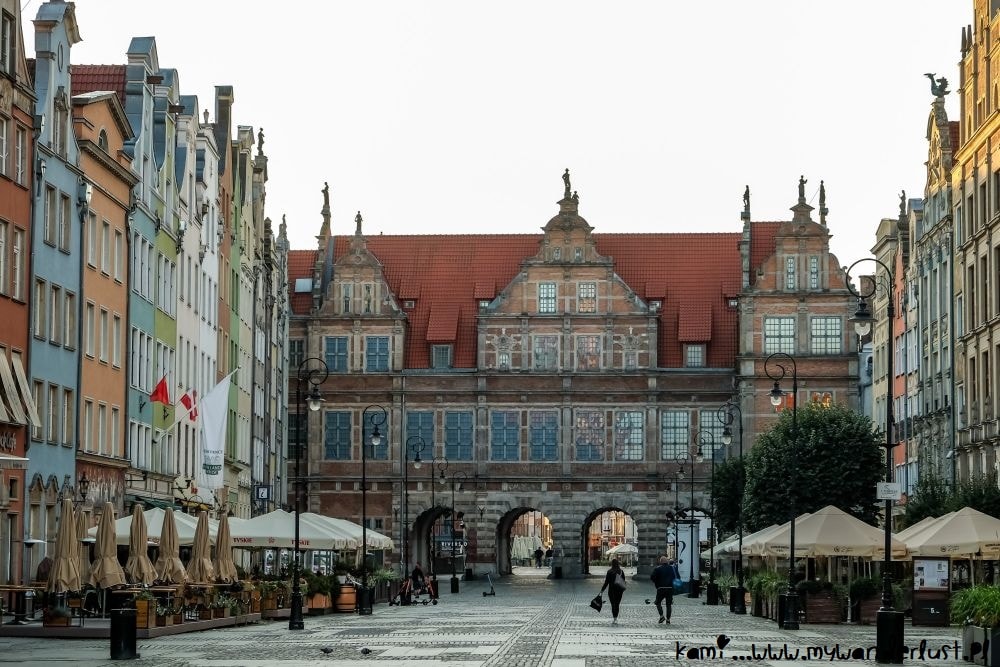
Find the most picturesque street in Gdansk
Of all the charming streets and lanes you can find in Gdansk Old Town there is one that really stands out – Mariacka street. It’s a bit hidden, with St. Mary’s Cathedral on one end and Mariacka Gate on another – this secludedness makes it even more unique and special.
The best way to arrive at Mariacka street is through the gate from the Motława riverside – you will suddenly be taken to another world where it seems like the time has stopped (although this small lane can get busy and packed with tourists).
That’s where you will find some of the most beautiful houses in Gdansk too and the continuous rows of stairs leading to them make the place even prettier. This is one of the best (if not the best) photo locations you can find in Gdansk.
During the day the street fills with stalls where you can buy souvenirs, especially the amber Gdansk is known for. If you would like to sit down, relax and enjoy this lovely place there is a really good cafe – Drukarnia, located near the gate at Mariacka 36.
I recommend visiting this street early in the morning when there is no one around and you can truly feel the atmosphere and admire the beauty of this place, and then return here in the daytime for some amber shopping.

Wander along the Motława riverside
At the edge of the Old Town, you will find the Motława river – its surrounding is certainly one of the prettiest areas of Gdańsk. You will see numerous interesting buildings and objects there, including the Crane – one of the symbols of the city.
This 15th-century structure is the best testimony of the great trading tradition of the city. Today it hosts the Polish Maritime Museum so you can visit it inside too and see the exhibition of the past port life.
But other buildings you will see along the way aren’t bad either – there are beautiful historical houses, gates and more. The whole area is very pleasant to wander around and every few steps you will see even a more beautiful view in front of you.
You can also cross the river to either Ołowianka island or Wyspa Spichrzów as both are nicely renovated and offer some fine spots too.
Since the Motława riverside is a rather popular place you will also find numerous restaurants and bars there if you want to sit down and enjoy the place.
It is also possible to go on a boat cruise here and see Gdansk Old Town and beyond from a different perspective – click here for details .

Visit the Town Hall
The Gdansk Town Hall (not to confuse with the Old Town Hall) is located on Długi Targ and you will spot it right away as this is one of the most beautiful buildings on the street. It dates back to the 15th century but was badly destroyed and rebuilt after WW2.
You should definitely visit the Town Hall inside – there is a nice exhibition of the Museum of Gdansk but what’s more important are the stunning interiors in some of the rooms. The most impressive is the Red Room with incredible ceiling decorations from the early 17th century.
While you are in the Town Hall be sure to go up to the tower as well – this is where you will find the most beautiful panorama of the Old Town, with rows of beautiful old houses. For some reason, this is not such a popular viewpoint but it was my personal favorite and I can definitely recommend going all the way up!
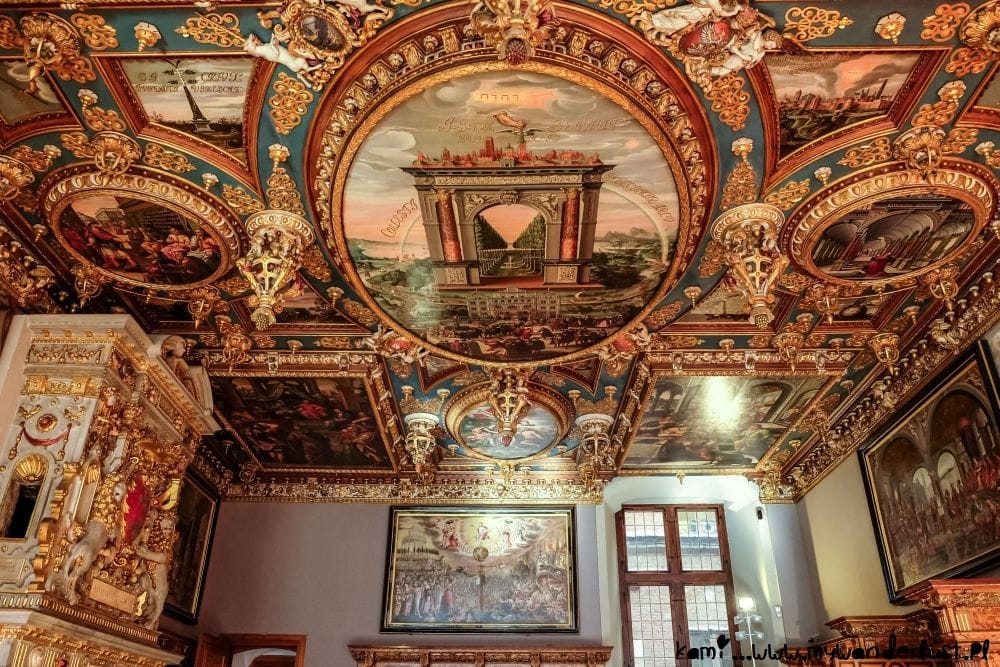
See St. Mary’s Church
St. Mary’s Church, an impressive brick Gothic building from the 13th century, dominates the central part of Gdansk and you can see its enormous structure from numerous places in the city. While inside the church isn’t as spectacular it is still worth visiting it and see the remnants of the glorious past.
If you enter the church through the side entrance on Piwna street you will see on the left side a modest grave of Paweł Adamowicz – the mayor of Gdansk that was assassinated during the charity event in January 2019.
Another reason to visit St. Mary’s Church is to go to the viewpoint on the tower. While it wasn’t my favorite vantage point of Gdansk it was still interesting to see the inside of the church.
You need to walk up exactly 409 stairs to get there and the viewing terrace is a bit small and gives you the perspective only in one direction. But still, it’s nice to see it, although I think the Town Hall tower has a much better view.

See the Love Bridge
While I’m not a fan of so-called “love bridges” with love locks, the one in Gdansk is actually really interesting. Well, maybe not the bridge itself but what you can find around it.
The bridge – Bread Bridge – was located in this place already in the 14th century and over the years it served only its main purpose until its romantic setting was noticed. Today this is a favorite place for lovers who share their eternal love by hanging locks – the symbol of their affection.
While you are here you can admire from the bridge the picturesque view of the House of Sailors’ Guild (today it hosts the restaurant) and the Great Mill in the background.
On the other side of the Bread Bridge, there is the Old Town Hall – the beautiful Renaissance building from the 16th century, one of the very few that survived WW2 in Gdansk. This is also where the world-famous astronomer Johannes Hevelius served as the Old Town Council Lord in the 17th century. You can actually find his monument, a really nice one, on the small square in front of the town hall.
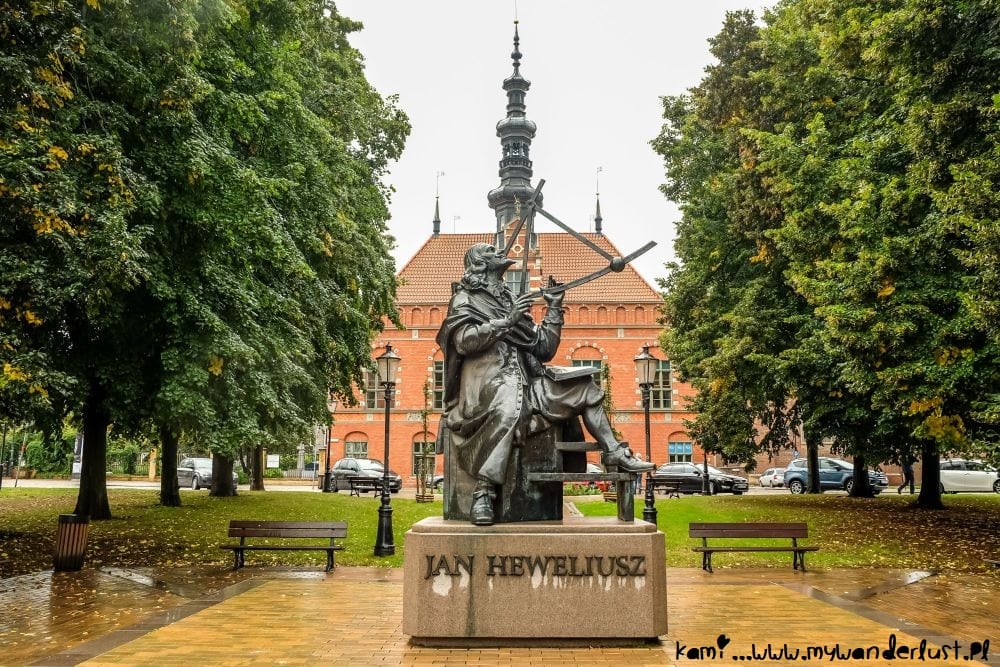
Ride Amber Sky
Amber Sky, located on Ołowianka island, is one of the biggest attractions of Gdansk. This 50-meter tall ferries wheel offers some amazing views of Gdansk and beyond. The ride takes around 15 minutes and surely is an unforgettable experience.
What makes it different from other viewpoints you can go to are long opening hours, even until midnight on the weekends – this way you can see the panorama not only during the day but also in the evening when everything is nicely lit up.

See a marvelous amber altar
Even if you are not a religious person you will surely appreciate this masterpiece. The altar can be found in St. Bridget’s Church and surely is one of the most impressive sacral works of art you will ever see.
With the dimensions of 13 meters high and 120 m2 of amber cladding surfaces it is larger than the famous lost Amber Room. The altar was unveiled in 2017 after 17 years of making but it was worth waiting as it is simply beautiful and full of symbols (like 28 rubies in the crowns of the Virgin Mary and baby Jesus symbolize 28 workers who died in 1970 clashes).
The church itself is an important place for Gdansk’s history as it is the main temple of the Solidarity movement.
You can visit St. Bridget’s Church with the highly-rated tour on Gdansk highlights – click here for details .

Get another perspective of Gdańsk from Gradowa Hill
Another great vantage point in Gdansk is Gradowa Hill, located behind the main train station. It’s not often visited by tourists which is a shame as the view from there is really great, to the Old Town with its spires on one side and the industrial shipyard zone on the other.
The hill is around 50 meters high and you can get there by walking the steps up (they are not very easy to find so download the offline map and follow it). Besides the wonderful panorama of the city, you can also find a 19th-century bastion and a millennial cross on the hill.

Visit European Solidarity Center
As you might know, Gdansk played a very important role in 20th-century history and one of the key events was the Solidarity movement that eventually led to the collapse of communism in Poland and other Eastern European countries. Everything happened in the Gdansk shipyard and today on its premises you can find the modern European Solidarity Center – the institution focusing on the legacy of the movement.
Inside the beautifully designed building, you can visit an extremely informative and interesting exhibition about Solidarity, the events that took place in Gdansk, and the impact it all had on the world’s history. I believe this is a must-visit place in Gdansk that not only will help you understand the recent history of Poland but the whole region.
You will visit the exhibition with the audio guide (it is really good!) and you should count some 2-3 hours to see everything properly. It’s also better to buy the ticket online in advance as the lines can get long. Or you can visit the place with the highly rated Communism Tour (with the ticket to ESC included) – click here for details .
Once you are done with the exhibition, be sure to go to the rooftop to see a nice panorama of the shipyard and the city. Don’t also miss the Gate No 2 of the Gdańsk Shipyard, the iconic place that played a major role during the strikes that still today is decorated with the remnants from that time.
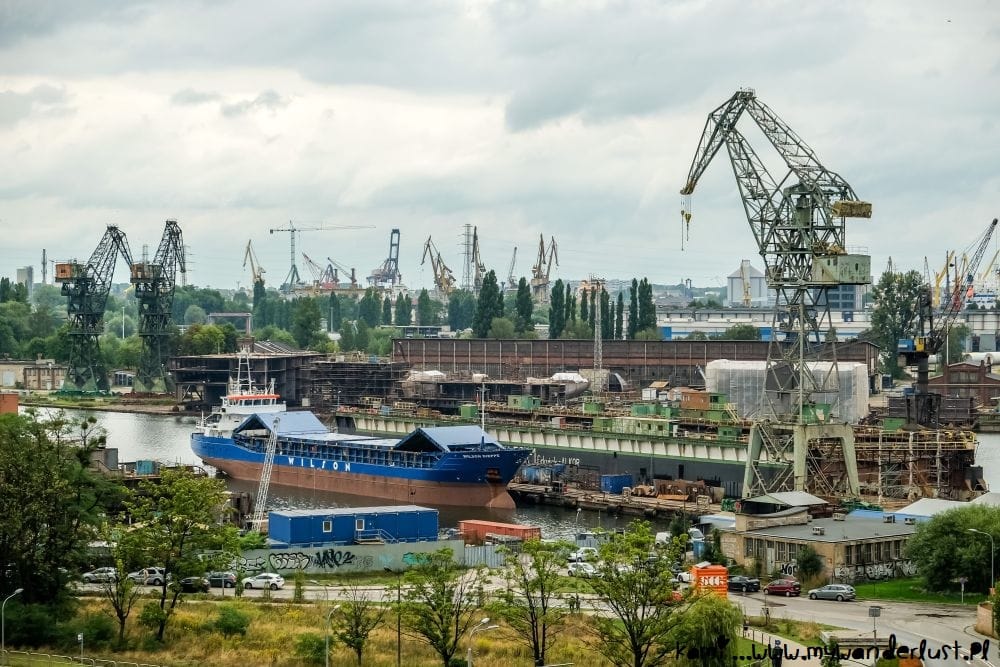
See the alternative side of Gdansk at the shipyard
The shipyard in Gdansk isn’t anymore as large as it used to be and today many of the industrial spaces are turned into cool, hip hotspots where you can best see the alternative side of Gdansk, so different from the picturesque Old Town.
The two coolest spots are 100cznia and Ulica Elektryków. You can try some good street food there, listen to live music, chill on the sunbeds and simply enjoy this amazing and unique area in the heart of the city.
There are also frequent events taking place there so if you are lucky you will stumble across one of them. When I visited there was a vegetarian food festival which was pretty great and delicious.
Besides these two spots, you can also wander a bit around the former shipyard premises and admire the amazing industrial spaces (I can guarantee fans of those will be super delighted, I know I was!).
Or you can go for a cruise on the shipyard to see a place from a totally unique perspective (it’s one of the most highly-rated attractions in Gdansk) – find out the details and book the spot here.
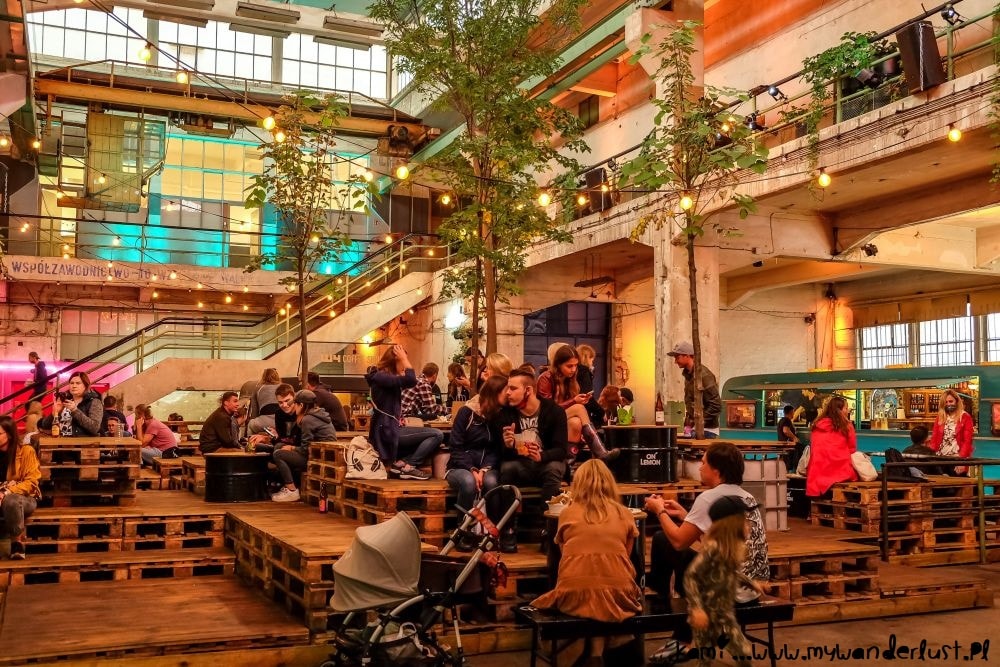
Enjoy amazing stret art in Zaspa
While you can see some fine street art in numerous places in Gdansk, there is one neighborhood you simply don’t want to miss – Zaspa, the center of Gdansk street art . It’s located a bit away from the center but you can easily get there by local SKM train.
This residential neighborhood full of blocks of flats is literally covered in amazing murals. The first one, showing two well-known Poles Lech Wałęsa and the Pope John Paul 2nd, appeared on one of the walls in 1997 as part of commemorations of the 1000th birthday of Gdansk.
Now there are over 50 murals, the annual street art festival and the so-called Monumental Paintings Collection. Apparently, Zaspa is the world’s biggest collection of murals located in such a small area!
You can find the map with all the works here , be sure to save it before your trip to Zaspa as it will help you greatly! I spent a solid few hours in the neighborhood and still don’t think I’ve managed to see all the amazing works there!

Visit the Polish Post Office Museum
While everyone knows about Westerplatte – the place where World War Two has started, I believe that another heroic place and event from the same day don’t get as much attention as it should.
The Polish Post Office in Gdansk was attacked by Nazis at the same time when Westerplatte was attacked. The siege lasted for 17 hours and heroic defenders were eventually executed.
Today you can visit the museum dedicated to this event that sustains the memory of the brave people. It is located in the same building where the siege took place.
In front of the Post Office builing you can also see the memorial commemorating the defenders.
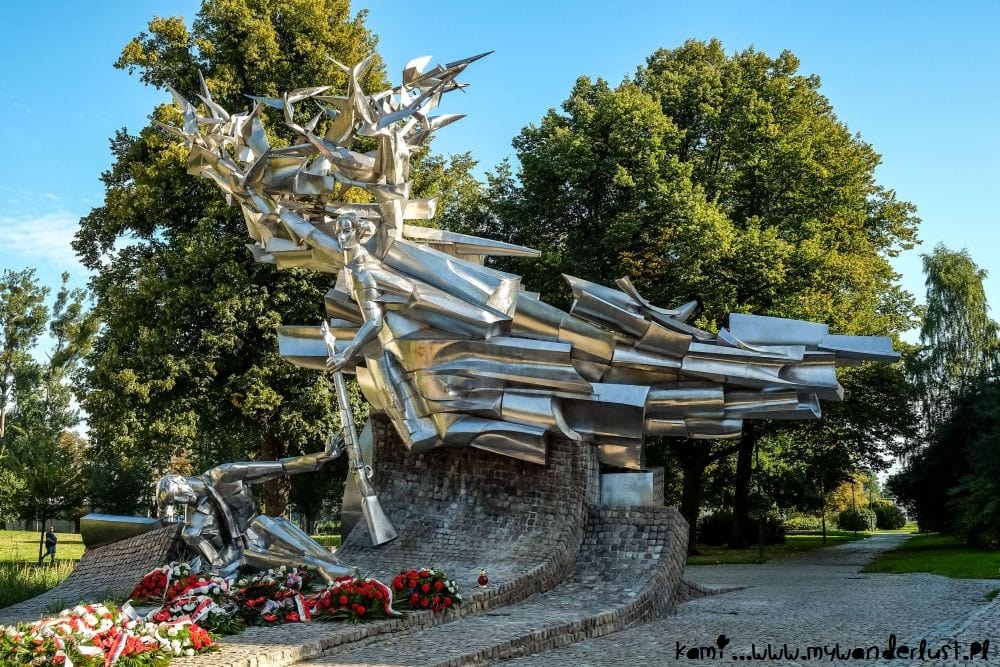
Visit the World War Two museum
Another place that is an absolute must to visit is the World War Two museum. Even if under the current rule the exhibition was changed a bit to avoid some uncomfortable truth for Poland, this is such an interesting place and you need at least 2-3 hours to see it. This is a fairly new addition to the city’s scenery, opened only in 2017.
The museum can impress already from the outside with its modern building. Inside you can see a large exhibition divided into three parts – Road to War, The Horror of War, and The Long Shadow of War. The museum focuses not only on the Polish events during the war but covers what happened all over the world.
It is not your typical museum with just boring info, you will find there plenty of personal items and stories as well as some really great visual addition (like the tank in the ruined city). Even if you are not interested in history it is still worth visiting this museum, to learn more and understand Gdansk better.
You can visit World War Two museum as well as Post Office Museum on the tour dedicated to WW2 in Gdansk – click here for details.

Go to Westerplatte
Westerplatte, the small peninsula between the Dead Vistula and the Baltic Sea, is where World War Two started, exactly at 04:45 am on September 1st, 1939. The tragic fights lasted for 7 days and left the military zone in ruin.
Today this is actually a very nice and green area for a walk at the seaside, perfect not only for history buffs. You still can find numerous remnants of the fights on Westerplatte, i.e. ruins of barracks that you can visit or graves of the soldiers who lost their lives during the battle. There is also an impressive monument on the mound and a big sign “Nigdy więcej wojny” (“No more war”).
You can easily reach Westerplatte by public transport, buses number 106, 138, 606 run there from the Main Train Station.
A bit before Westerplatte you can also stop at picturesque Wisłoujście Fortress from the early 14th century.
You can also visit Westerplatte, among a few other places, with the WW2 tour – click here for details.
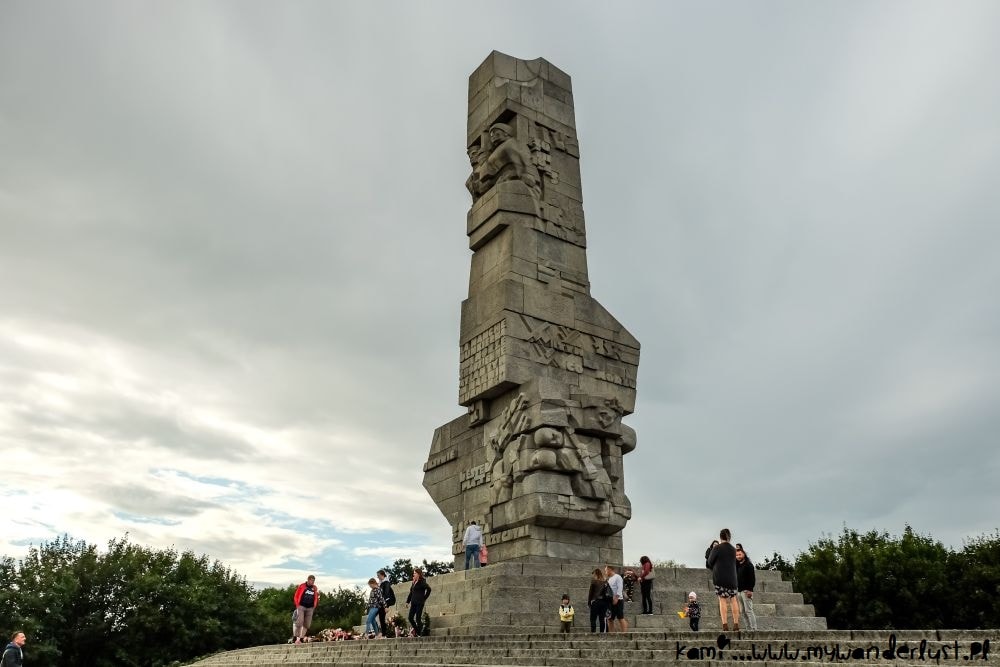
Relax in the beautiful Oliwa Park
Even if this park is located a bit away from the center of Gdansk, in Oliwa district, it is definitely worth a trip and can be easily reached by public transport.
This beautiful green space date back to the 15th century and developed next to the nearby monastery. Today it is a great oasis to escape the hustle and bustle of the city and the charming alleys are perfect for a slow walk around (some of them even reminded me of the “Game of Thrones” a bit). There are ponds, a botanical garden, or parts of the park designed in different styles (French, English, Japanese etc).
The neighborhood itself is interesting too, with some pretty old houses and cobbled streets.

Listen to the organ concert in Oliwa Cathedral
While you are in Oliwa park be sure to stop in the 14th-century Oliwa Cathedral. Better yet, visit the temple to listen to the organ concert there.
The original great Oliwa organ dates back to the second half of the 18th century (it took 25 years to design and construct them) and consisted of 83 registers and 5100 pipes. Over the years they were changed and renovated a bit and today are even more spectacular with 96 registers!
There are daily 20-minutes concerts (with the exceptions of holidays and some random days) where you can listen to the mesmerizing sound of the organs – words can’t describe how beautiful it is. During my last visit, I accidentally stumbled upon the concert around noon so my guess is that’s when the concert takes place.
There are also longer and fancier recitals a few times per year, check the cathedral’s website for details.

Relax at the beach
Since Gdansk is located at the Baltic Sea coast you can quickly hop on the tram or bus and reach the seaside after a short journey. There are a few options to choose from: Brzeźno, Jelitkowo, Stogi or, a bit further, Wyspa Sobieszewska.
Each of them offers some perfect opportunities to simply chill out at the beach and swim in the not-so-warm water. The beaches here are sandy and really pleasant so once you are tired of all the sightseeing be sure to see this more relaxed face of Gdansk.

Go for day trips from Gdansk
One of the great things about Gdansk is that the city can be a wonderful base for some amazing day trips in the region. And you can easily reach most of the places by public transport.
A short train ride away you can find Sopot – the fancy seaside town with the longest wooden pier in Europe (over 500 meters long) and Gdynia known for its modernist architecture. You can also reach both cities by walking along the beach although this would take a while.
Then you can explore the seaside a bit more and go to Hel Peninsula (my favorite place on the Polish Baltic Sea coast) with wide and sandy beaches and some ruins from World War 2 randomly strewn around the forests.
One of the most popular day trips from Gdansk is Malbork Castle , located only 40 minutes away by train. This UNESCO-listed medieval masterpiece is actually the largest castle in the world and you definitely don’t want to miss it.
A bit further you can visit Elblag and take a boat ride on Elblag Canal – the unique engineering work from the mid-19th century (part of the cruise is on the grass!). Or you can go to the Kaszuby region south of Gdansk and enjoy the pristine nature of the beautiful area.
There are really many options so when planning your trip to Gdansk safe a few days in your itinerary to explore the surroundings too!
Here are some of the recommended day trips from Gdansk:
- Stutthof Concentration Camp Regular Tour
- Private Wolf’s Lair Tour
- Highlights of Gdańsk, Gdynia and Sopot 1-day Private Tour
- Kashubian Switzerland Private Tour
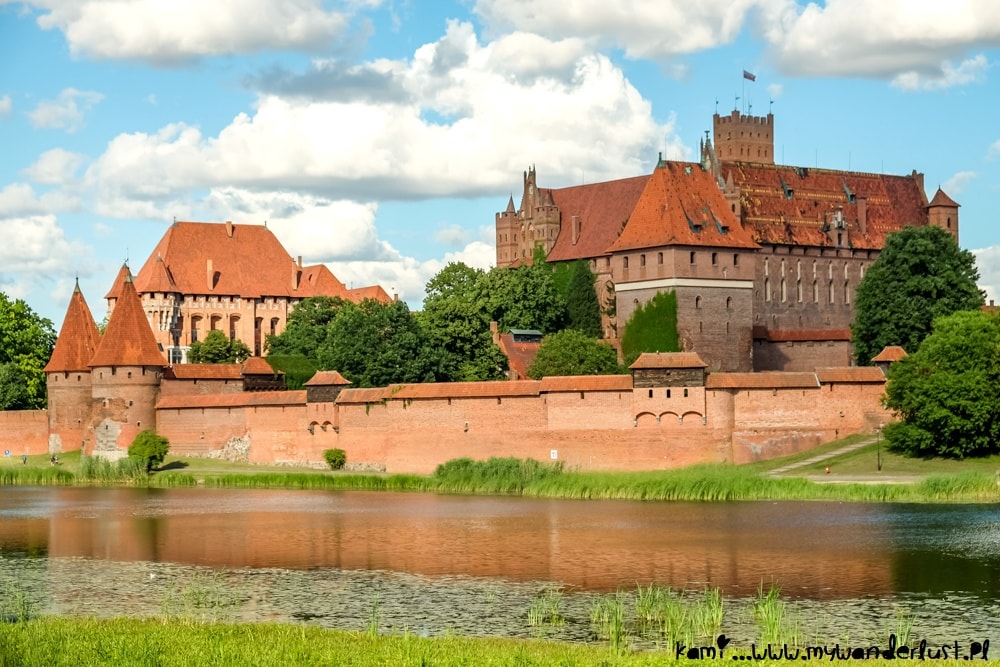
Final thoughts on visiting Gdansk
As you can see Gdansk really is full of attractions and offers plenty of interesting and cool things to do. It can be a wonderful city break destination or a must stop during your trip to Poland – either way, I’m sure you will enjoy Gdansk, it’s impossible not to like such a great place.
I often find myself thinking of visiting Gdansk, even if just for a day, to wander around and enjoy the vibrant atmosphere of the place. And I’m sure you will share my affection for this place too!

Further reading
I published many articles about Poland that you might find useful when planning your trip there. Here are some of them:
- 37 Amazing Things to Do in Krakow, Poland
- 20 Great Places to Visit As Day Trips from Warsaw, Poland
- Visiting Auschwitz – How to Plan the Auschwitz Tour
- 17 Amazing Things to Do in Lublin, Poland
- The Complete Guide to Visiting Slownski National Park, Poland
- Visit Grudziadz – One of the Hidden Gems of Poland
- Visit Sandomierz, Poland – One of the Prettiest Towns in the Country
- Visiting Malbork Castle, Poland – the Largest Castle in the World
- 25 Amazing Things to do in Wroclaw, Poland
- and many more!
If you are looking for articles about a specific destination – check out the map with all the articles I’ve published (and their locations). You can also join my Facebook group about traveling in Central Europe and ask your questions there.
Travel Resources
Below you can find the brands I trust and use when planning trips:
- You can find the best accommodation options at Booking . They have many discounts and excellent customer service. Click here to look for the place to stay in Gdansk
- I recommend joining organized tours to get to know the place better and to visit more places during your trip. You can find a great selection of tours at Viator or Get Your Guide .
- To always stay connected I use Airalo eSim cards – click here to get yours!
- For transportation and booking tickets online , I usually use 12Go or Omio
- Looking for the airport pickup ? Check Welcome Pickups!
- Never travel without travel insurance , you never know what might happen and better safe than sorry. You can check the insurance policy for Poland here.
- If you plan to rent a car during your trip to Poland check Discover Cars to compare prices and find the best deals
- Make sure to have the offline map always installed on your phone, they can save you so many troubles. I always use the free app Maps.Me .
For the end I left a few announcements that might interest you:
- Sign up to my newsletter or follow me on Bloglovin to get updates about the new posts
- Join my Facebook group about Eastern Europe, the Balkans and former USSR and connect with fellow travellers and enthusiasts of these regions – just click here!
- I’ve included a few handy links of services and products I personally like and use so you can plan your own trip to Poland too. They are often affiliate links. This means I will get a small commission if you book/purchase anything through my links, at no extra costs for you. Thank you!
LIKED IT? PIN THIS POST FOR LATER!

If you enjoyed that post why don't you share it with your friends? That would mean so much to me! Also be sure to join 30.000+ fellow travelers and follow me on Facebook , Twitter , or Instagram for travel updates and even more pictures! If you don't want to miss new posts sign up to my newsletter or follow on Bloglovin !

Julie Packard
Super helpful and informative post. We are spending 8 days in Gdańsk in May, and I know we will do lots of the activities you mention! Thank you.
Thank you! I’m sure you will enjoy Gdansk, it’s such a wonderful place!
I visited Gdansk this summer and just booked a new trip in November. Happy that I found this post, I’ve written down all tips, thank you. <3
I hope you will enjoy Gdansk again! This is such a wonderful city, I love it!
Paul Clothier
Excellent! Thanks Kami! Very useful.
Thank you, I’m glad you found it useful!
Declan McGrath
Hi Kami, how are you? My wife & I are just back from a fantastic 5 night trip to Gdansk. Your guide made it so much easier to have an itinerary worked out for the trip. Thanks for all of the tips & research. Your site is always our first port-of-call for our trips to Central Europe.
Thank you so much for your kind words, that means a lot to me! All the best!
Leave a Reply Cancel Reply
Sign me up for the newsletter!
Let’s become friends!
Join me on Facebook for even more travel updates!
Kami and the rest of the world
Używasz przestarzałej przeglądarki. Prosimy zaktualizuj ją aby zwiększyć przyjemność z przeglądania strony i bezpieczeństwo.
- Tourist Card
Quick Contact
- Uczniowska 22, 80-530 Gdańsk
- +48 58 305 70 80
- +48 516 060 459
- [email protected]
GDAŃSK Authentically.
Top attractions.
Be inspired by a list of unique and charming places, which you just must see during your visit
Historical places
Gdansk is city with unique history. It’s influence still perceptible today.
Amazing nature
Active in gdansk, gdansk with a bicycle, active by the water, tastes of gdansk, check out what you gain with a tourist card, free entries.
Check out with Gdansk’s attractions can you see free of cost with a Tourist Card
Discounts for activities
Discover the city from water perspective renting a kayak or a SUP. With a Tourist Card you get 20% discount
Discounts at restaurants
Use to Card to get discounts at chosen restaurants.
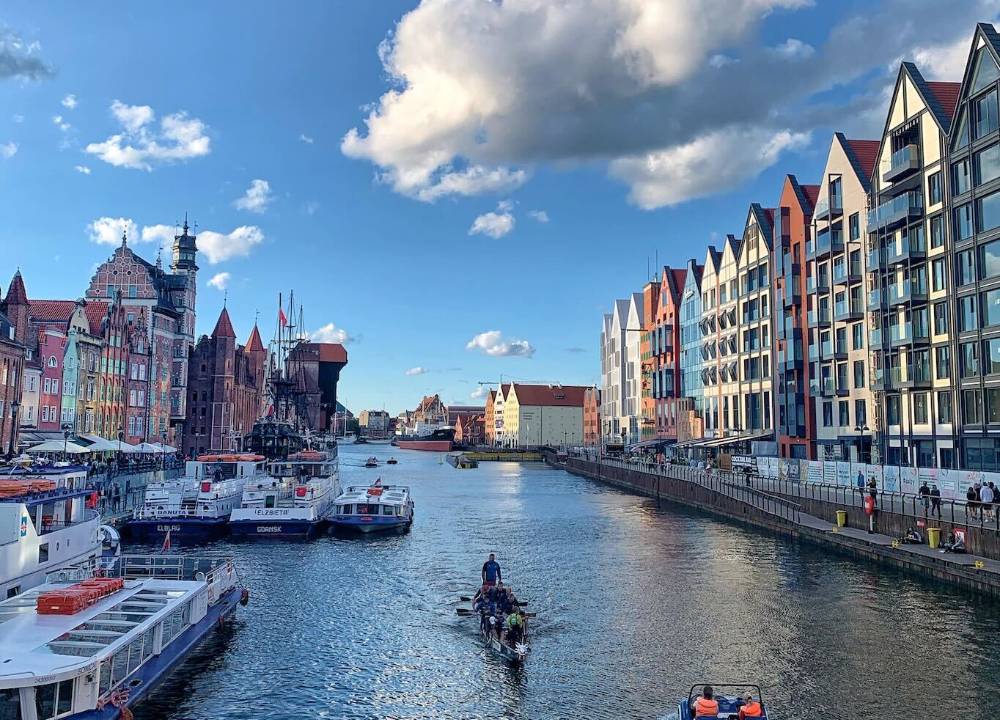
Business tourism
- 29 Awesome Tourist Places to Visit and Things to Do in Nuremberg, Germany
- 23 Famous Tourist Attractions to See and Fun Things to Do in Lyon, France
- Top 29 Tourist Places to Visit and Things to Do in Málaga, Spain
- 16 Cool Tourist Attractions to Visit and Things to Do in Saaremaa, Estonia
- Beautiful Beaches to Visit, Things to See and Fun Activities to Do in Port Elizabeth (Gqeberha)

20 Unforgettable Tourist Places to Visit and Things to Do in Gdańsk, Poland
Gdansk is a city in Poland situated on the Baltic coast in the northern part of the country. It is the capital of the Pomeranian Voivodeship. Some of the best things to do in Gdansk, Poland include exploring coastline, beaches, war museum, war sites, river promenade, historical buildings, fine architecture, boat cruises, amber shopping and beaches.
The city has had a very complex history of several rulers from native Polish, German, Prussian have ruled the city in ancient times. You will see influences of various rules in the architecture of the best places to visit in Gdansk . The city is dominated by mannerist, baroque, Gothic and rococo styles of architecture. Some of the most architecturally fascinating Gdansk attractions include Church of St. Mary, Golden Gate, Green Gate, Golden House, Old Mill, Oliwa Cathedral, Main Town Hall and Neptune Fountain.
Even the houses, shops and streets in older parts of the city are quite picturesque. You can enjoy strolling the old city streets for Gdansk sightseeing and also enjoy local street food, dining and shopping. You should definitely try out some local dishes like Pierogi, Rosol, Placki Ziemniaczane, Mizeria, and Golabki.
One of the most popular souvenir people take home from Gdansk travel is Amber gemstone. You can get it in raw gemstone, cut gemstone, Amber jewellery, items made of Amber and items studded with Amber. The city history of Gdansk is intertwined with Amber mining, trade and crafting. The Amber museum is one of the most popular Gdansk tourist attractions in the city with a fascinating variety of all things Amber.
The city’s history is also deeply intertwined with coast and port. There are numerous things to see in Gdansk along the coastline of the sea and the river. You can explore the pier, old trade port, old crane, trade centers, markets and most importantly beaches. Some of the most fun activities in Gdansk beaches include water sports and boat cruises. There is even a pirate ship which will take you on an interesting tour of the city.
Another major part of Gdansk’s history is the invasion of Poland in the Second World War. There are many Gdansk tourist attractions which shed light on different aspects of the war and its impact on the people and the culture.
This Blog Post contains affiliate links. If you purchase anything from that link then I may earn small part of commission and for that you do not need to pay any extra amount.
Table of Contents
Top 20 Tourist Places to Visit in Gdansk, Poland
1. basilica of st. mary (bazylika mariacka).
This marvelous Gothic Basilica is among the three largest brick-built churches in the world. It was built in the 14th century and is still one of the most dominant structures you will come across during Gdansk sightseeing. You will need about an hour to explore this church.
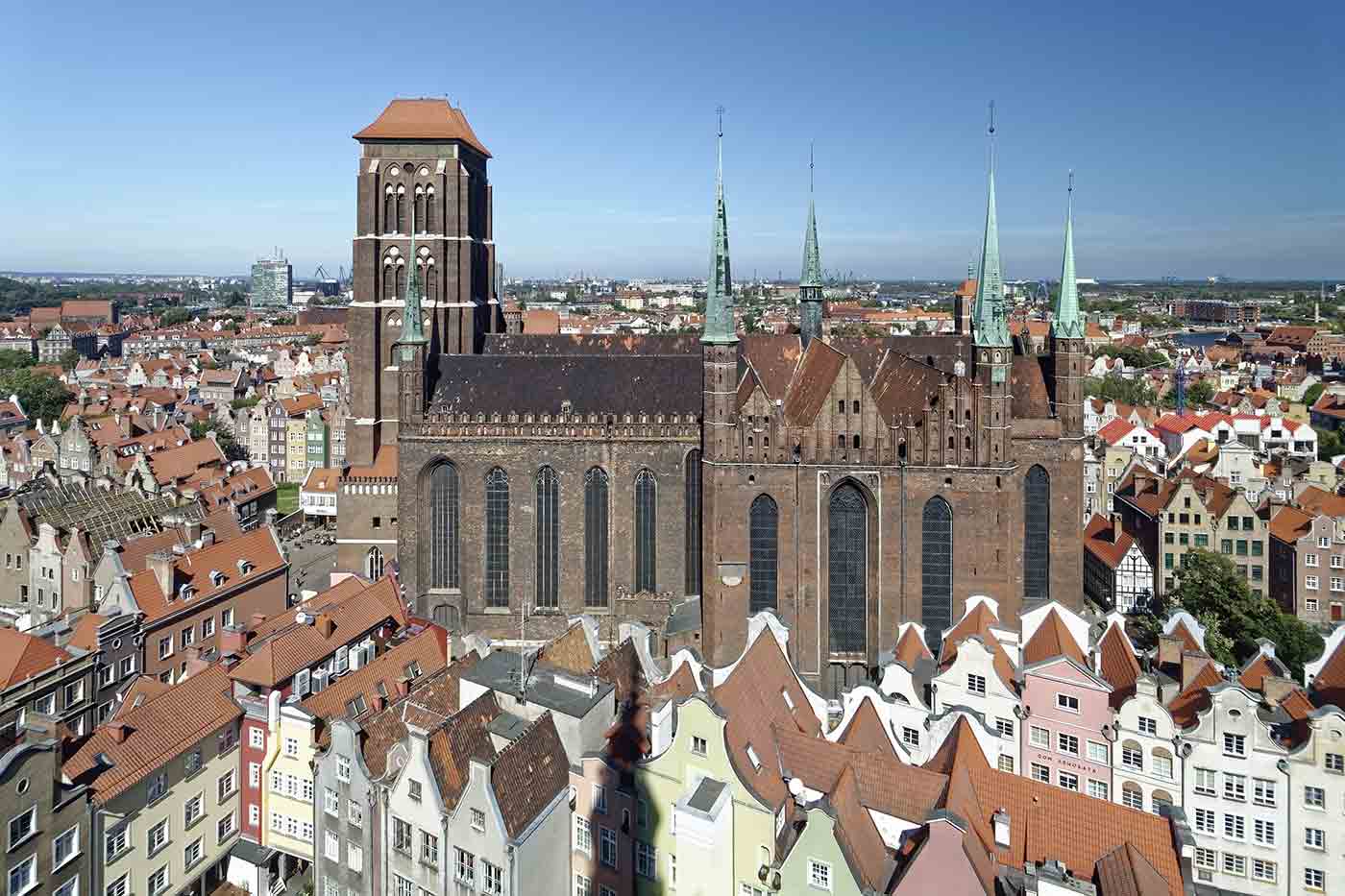
2. St. Mary Street
Also known as Ulica Mariacka, this street stretches from St. Mary Church to St. Mary’s gate, which is also among top Gdansk attractions. The cobbled street with merchant houses on either side is a wonderful sight. It is also quite popular for Amber jewelry shops. You will need 20 to 30 minutes for this street when you visit Gdansk.
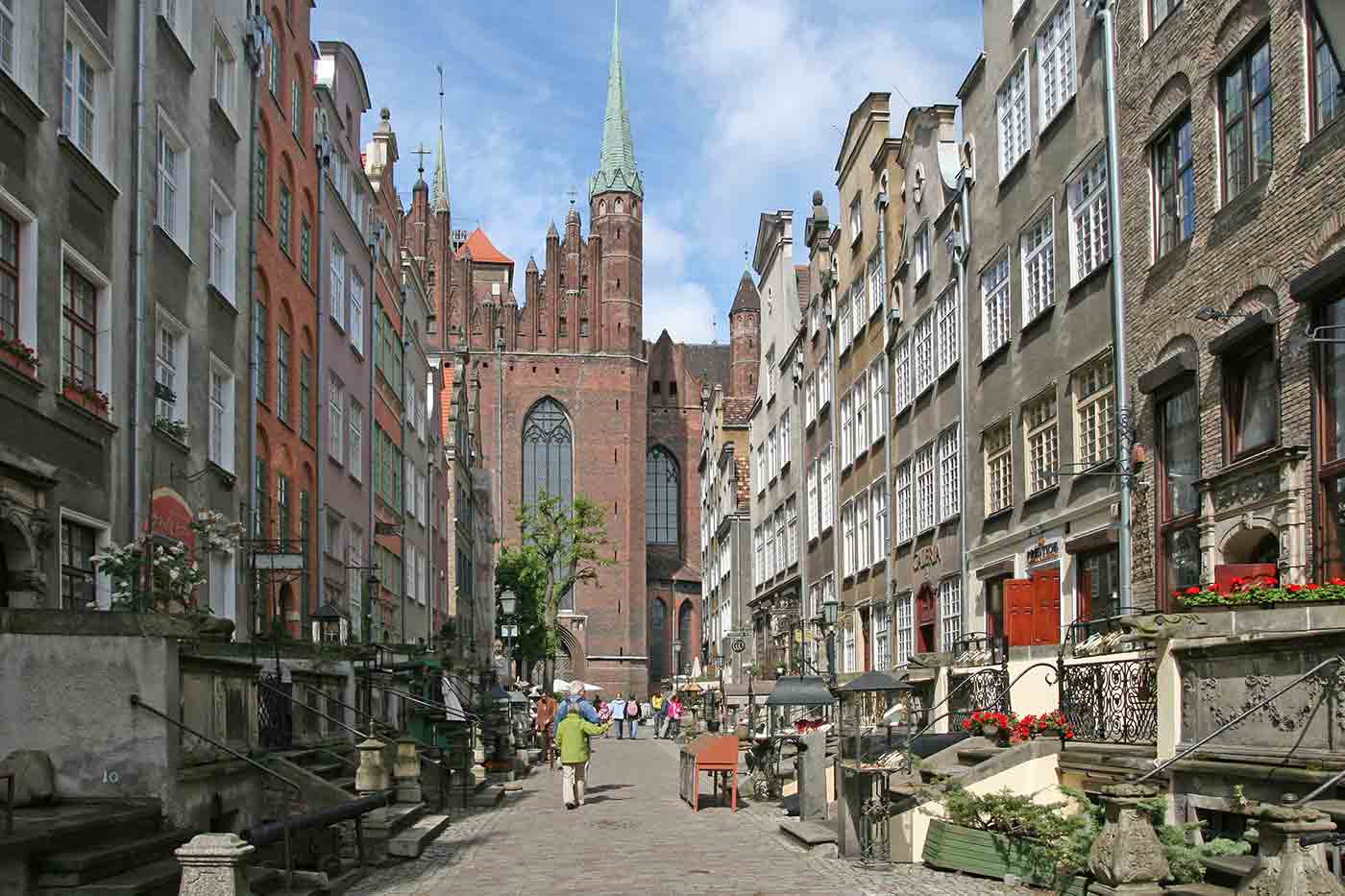
3. Museum of the Second World War (Muzeum II Wojny Światowej)
This museum is built on a quarter which was flattened because of the attack on the city during World War II. The museum shows the devastation caused by the invading forces in Poland. Many of the exhibits have been donated by families of the victims. It is one of the best places to visit in Gdansk to experience impacts of the war. You will need about 2 hours to tour this museum.
I suggest you should book a private guided tour of Second World War History .
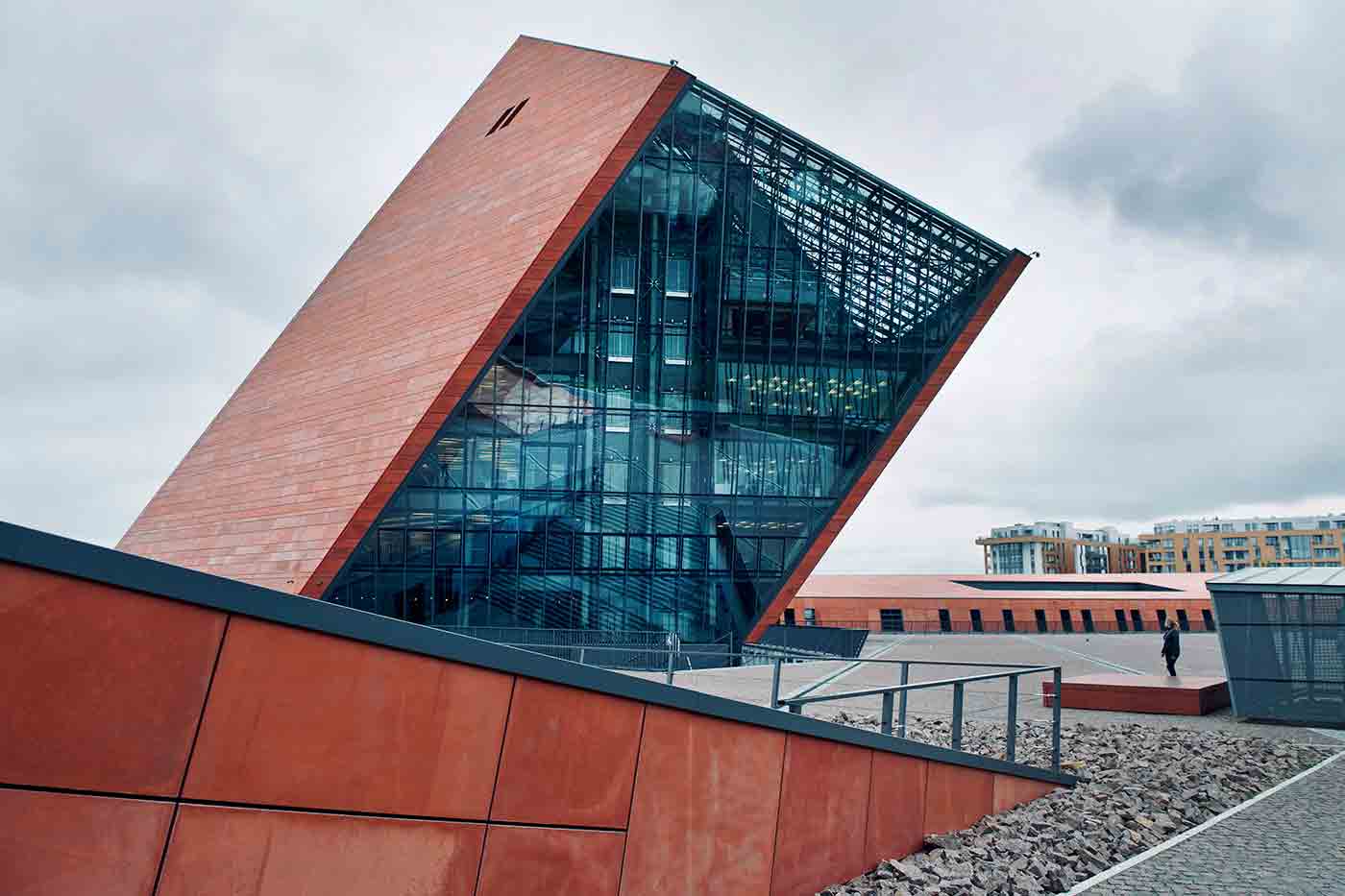
4. Neptune’s Fountain (Fontanna Neptuna)
The monument atop the fountain was designed by Abraham van den Blocke. This fountain is one of the most beautiful things to see in Gdansk. You will need 10 to 15 minutes to admire it.
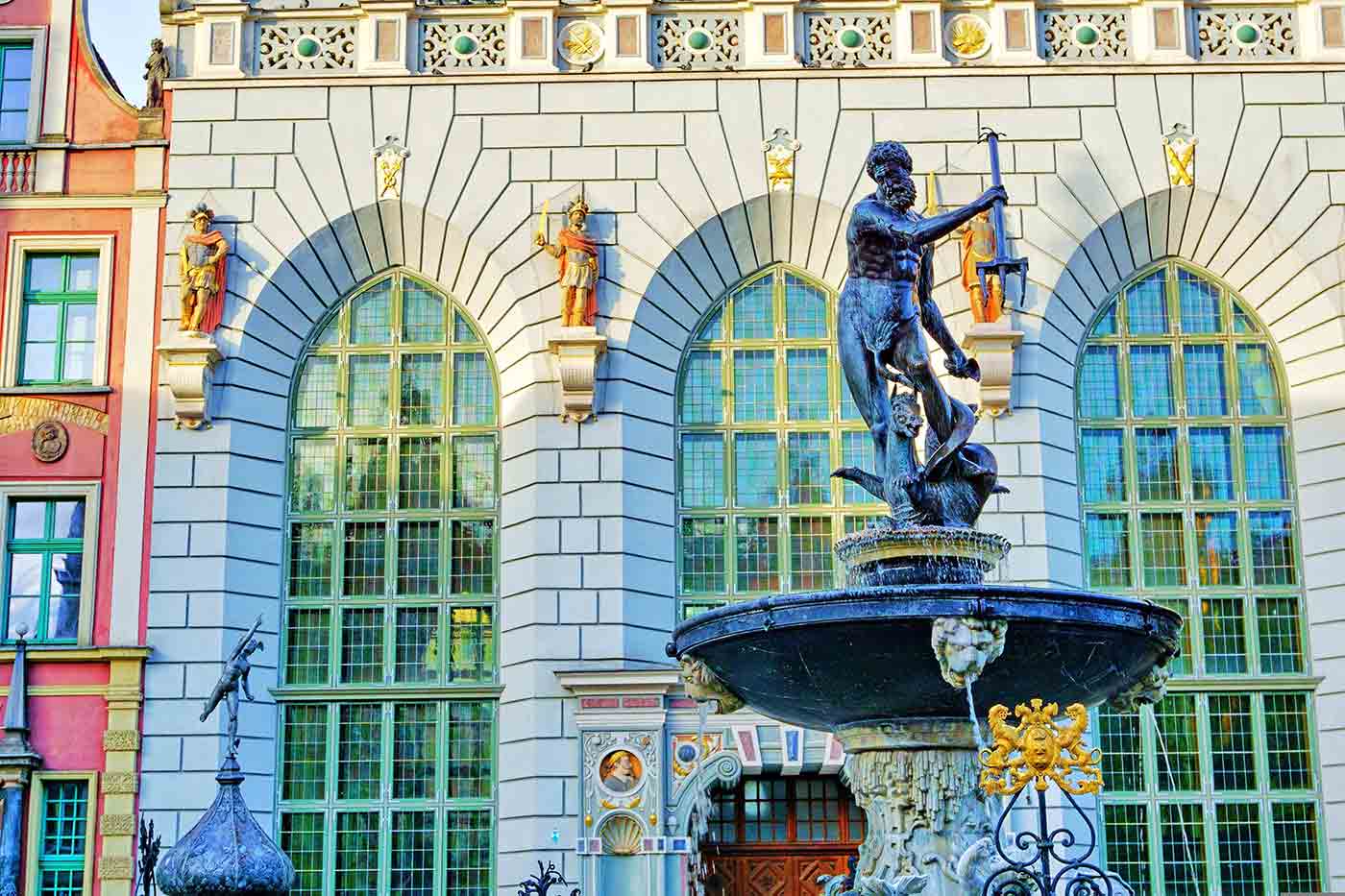
5. National Museum in Gdańsk (Muzeum Narodowe w Gdańsku)
This museum tells the story of the city from its origins at a major port to its revival after the second world war. It is one of the most engaging Gdansk tourist attractions as it helps you better appreciate the city’s people, culture and places. You will need about an hour to tour this museum.
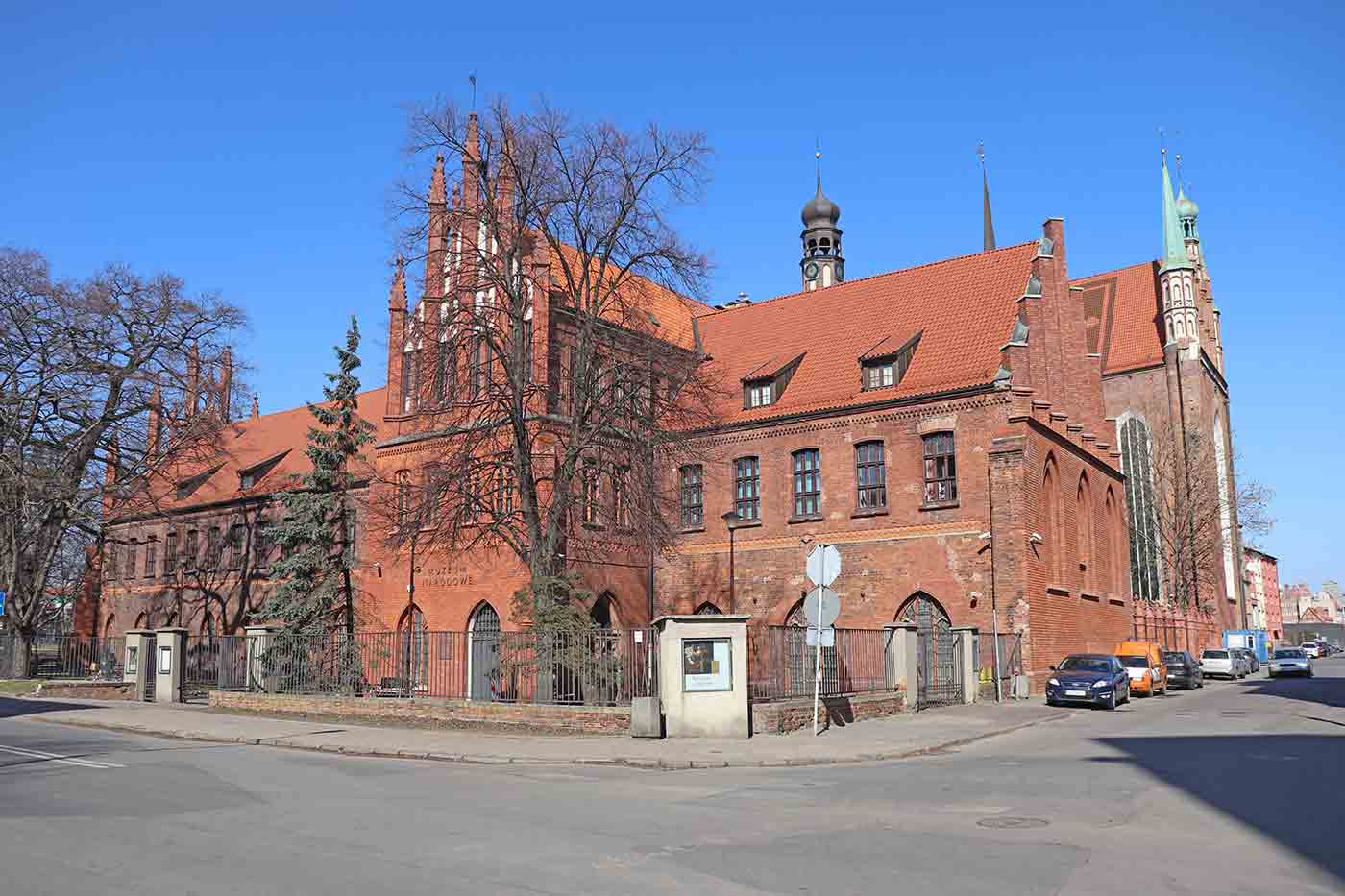
6. Royal Way (Trakt Królewski)
Also known as the Royal Way, this street is considered the heart of the city. The paved street has patrician tenements on either side. You will encounter many Gdansk must see spots while walking this street. It will require about 15 to 20 minutes to stroll.
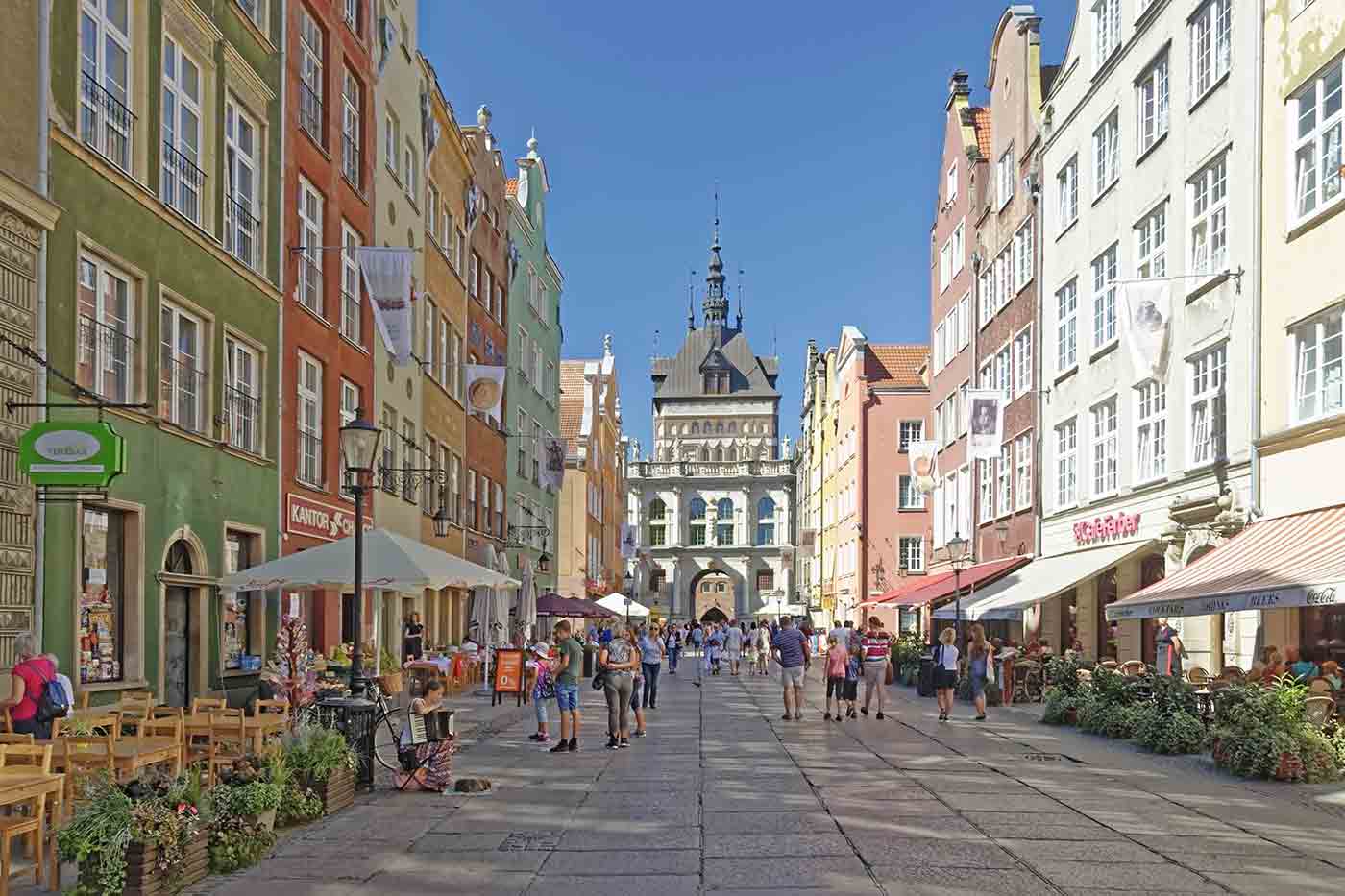
7. Golden House
The building was designed by Abraham van den Blocke in the 17th century. It is renowned for its mannerist architecture and often included among the most beautiful places to see in Gdansk. The intricate carvings and statues which decorate the facade can keep your fancy engaged for quite some time. You would need 20 to 30 minutes to admire this building during Gdansk travel.
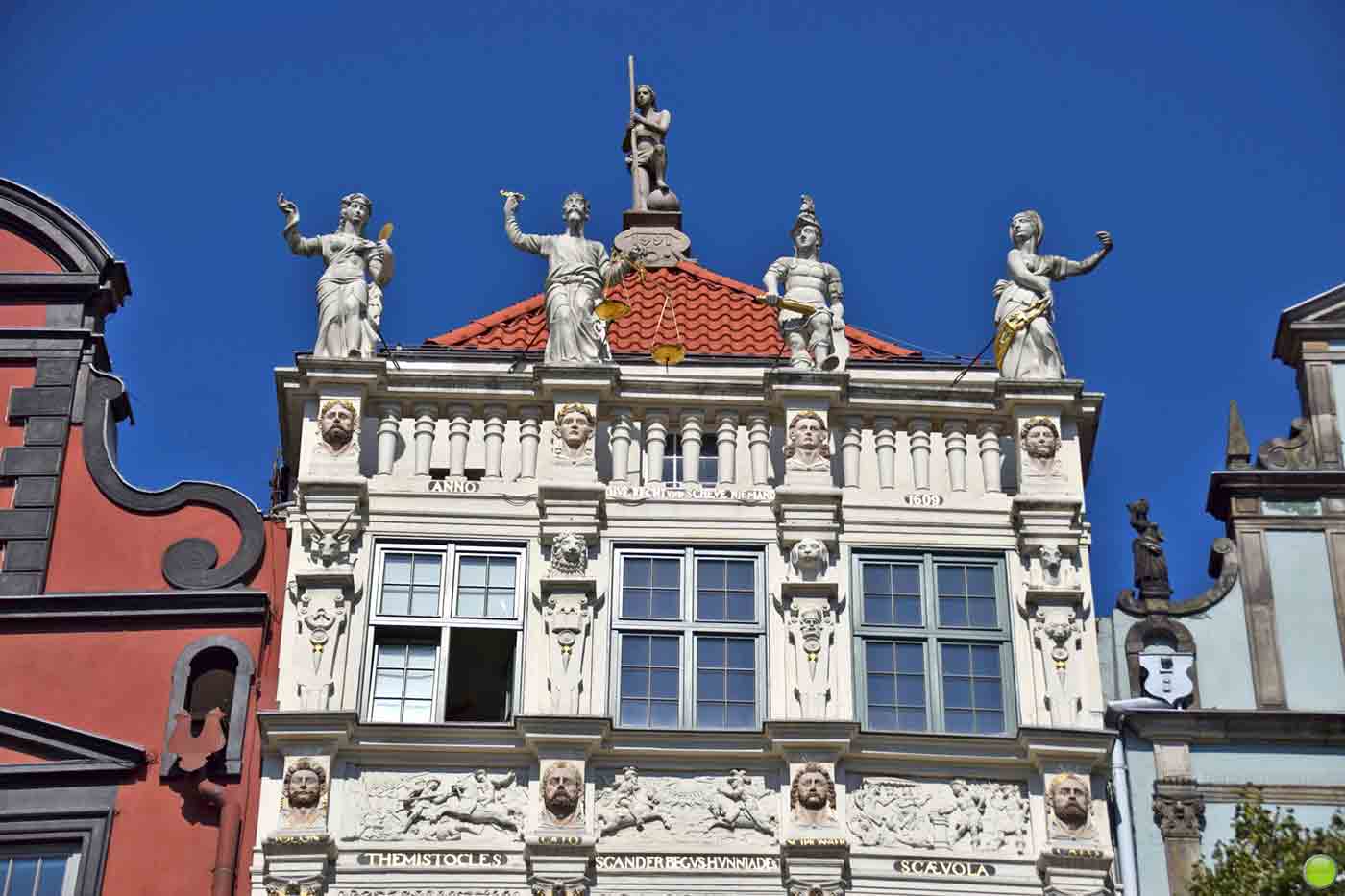
8. Main Town Hall
This building was designed in the 16th century with Dutch mannerist features. The clock tower and its observation deck are also among Gdansk top attractions. It has quite a dominating facade and the interior is equally magnificent featuring coffered ceilings, marble floors, frescoes, sculptures and tapestries. You will need 30 to 45 minutes for this place.
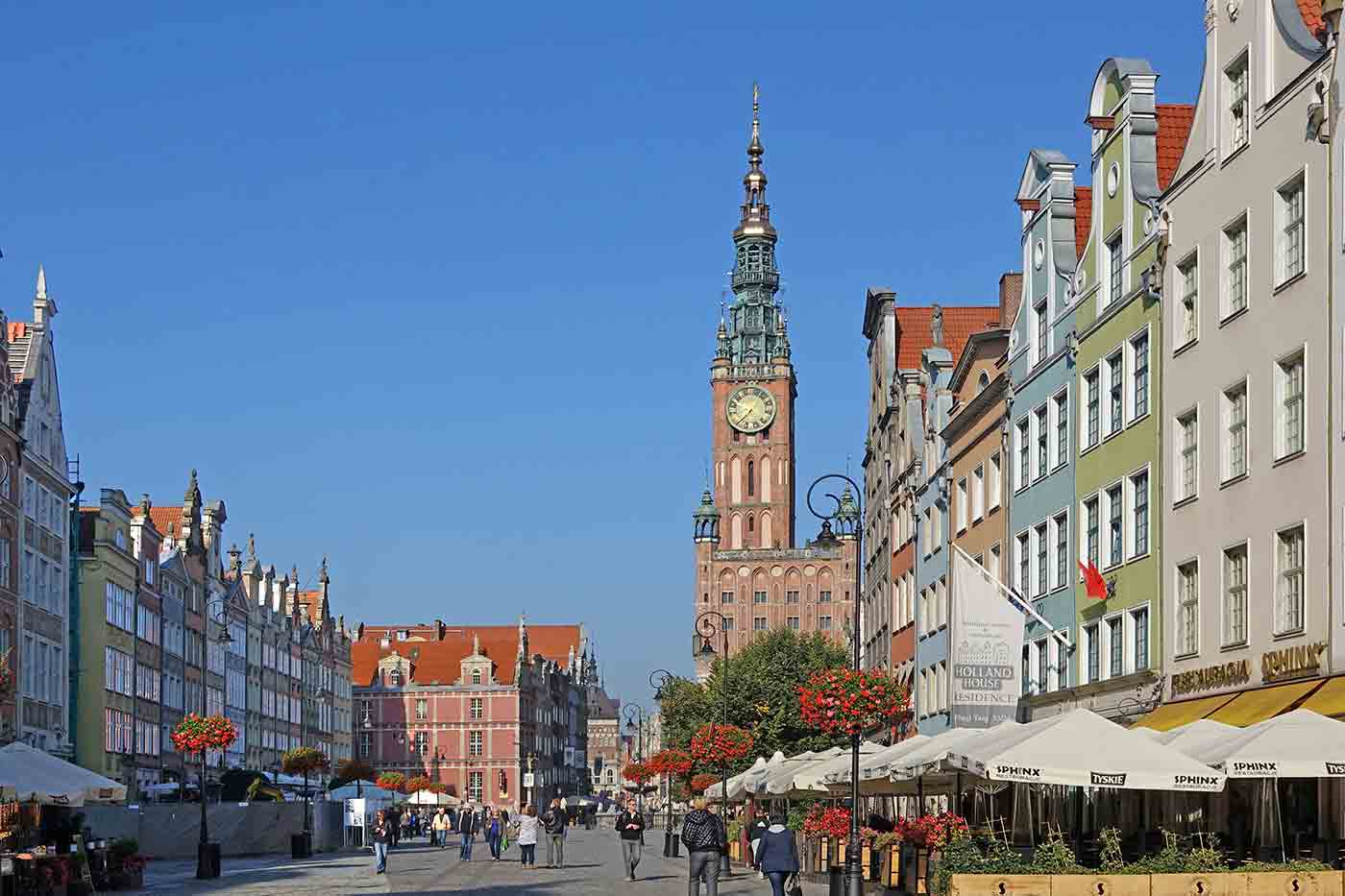
9. Gdansk Crane
This crane was built in the 14th century and has become an icon of the city. The crane also served as a waterside gate to the city till 1800s. The crane’s museum is one of the best things to do in Gdansk, Poland. You will get to see how it was operated during its heyday and how it contributed to city’s history. You will need an hour to explore it.
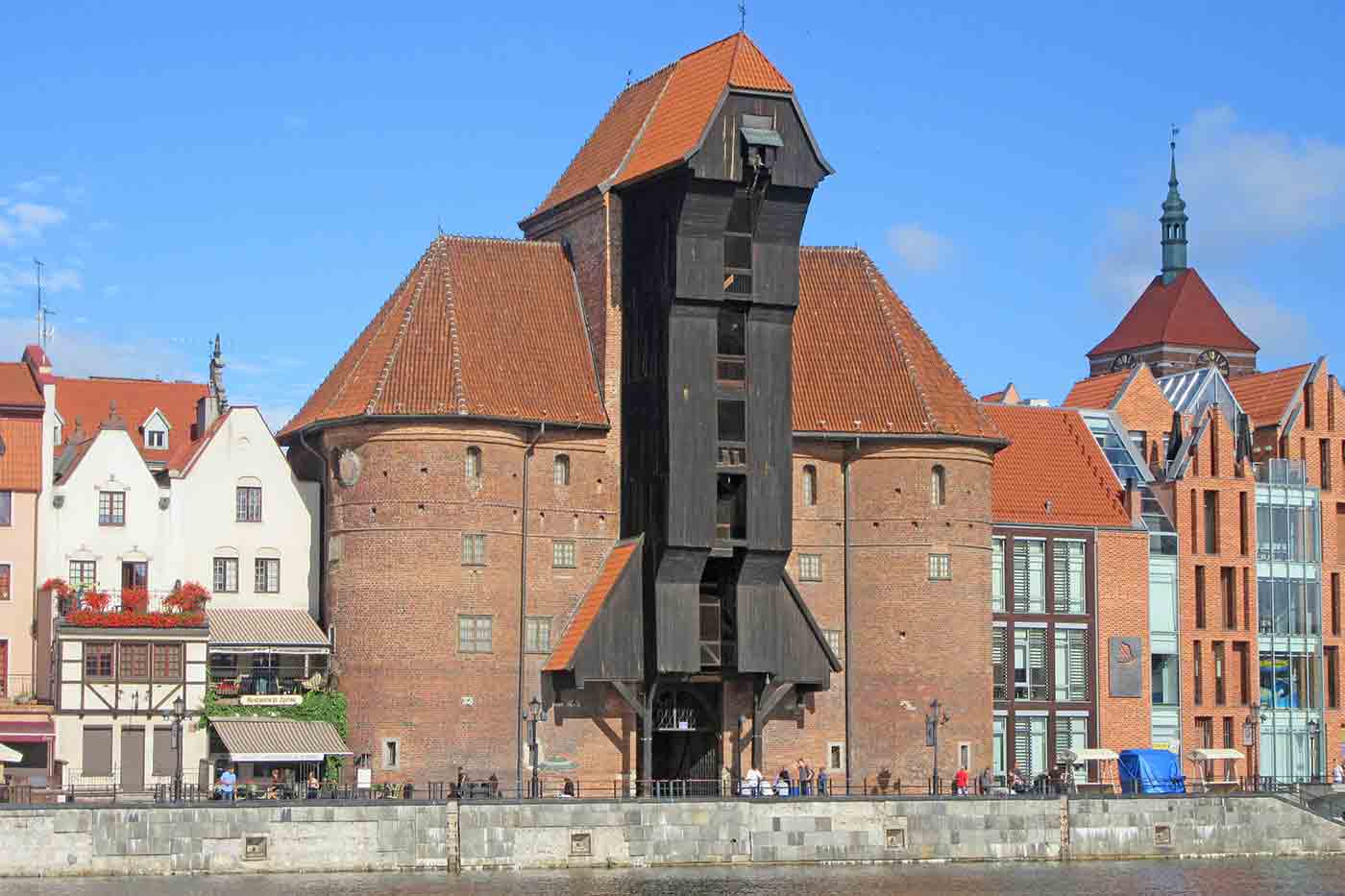
10. Dlugie Pobrzeze
Also known as the Long Embankment, this quay runs along the Dead Vistula River. Until the 19th century, this was the prime location for port trade in the city. You will see old defense gates guarding entry to the streets. It is one of the most historically significant Gdansk attractions. You will about an hour to roam along this street.
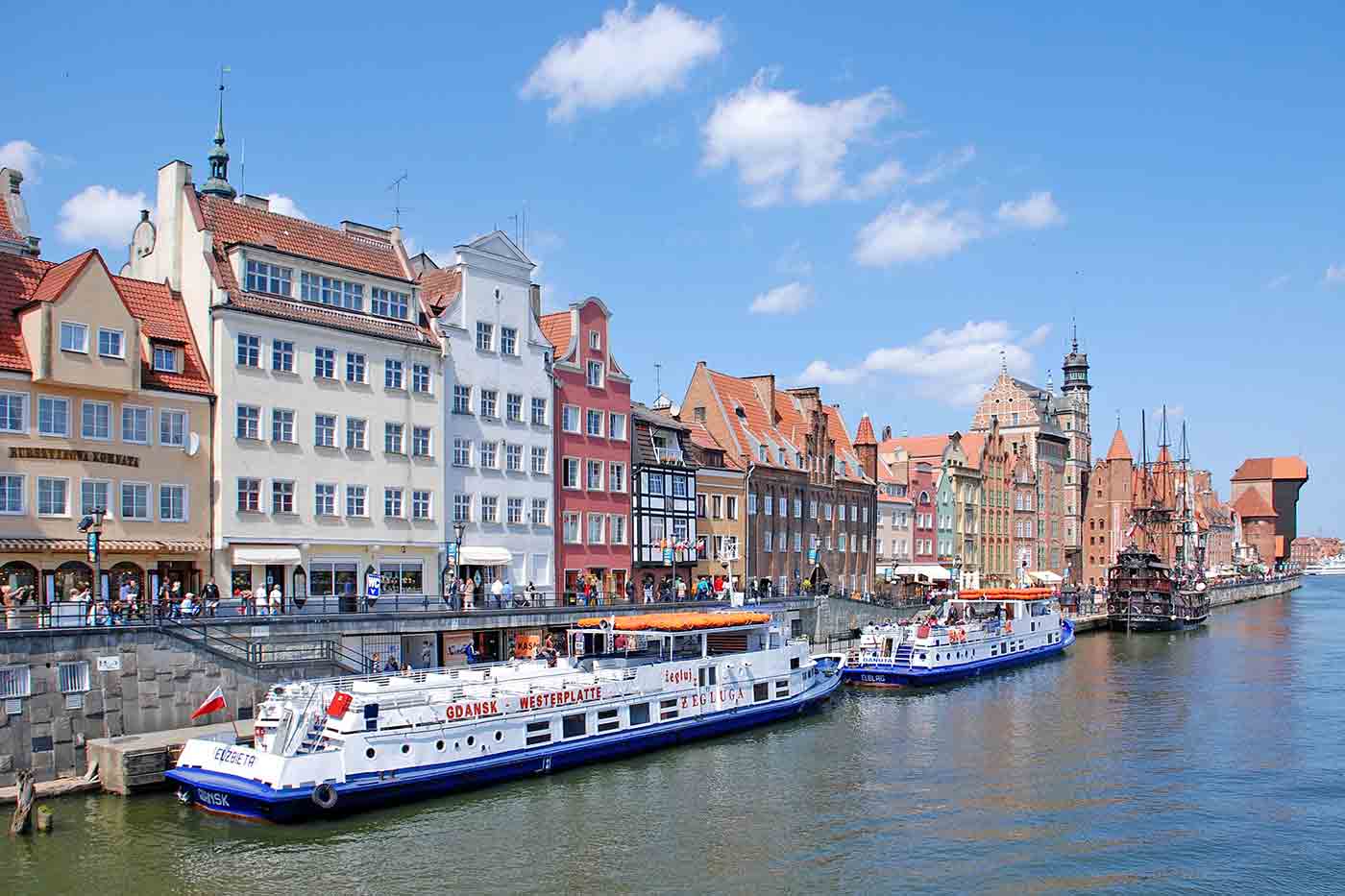
11. Westerplatte (Zachodnia Płyta)
This monument marks the sight of the “Battle of Westerplatte”. It was the first conflict between German and Polish troops and is considered the beginning of World War II. The history of this place had an impact on the entire world. Hence, it is among the most important places to see in Gdansk. You will need 30 to 45 minutes for this war site
I suggest you should book guided tour of Westerplatte in advance.
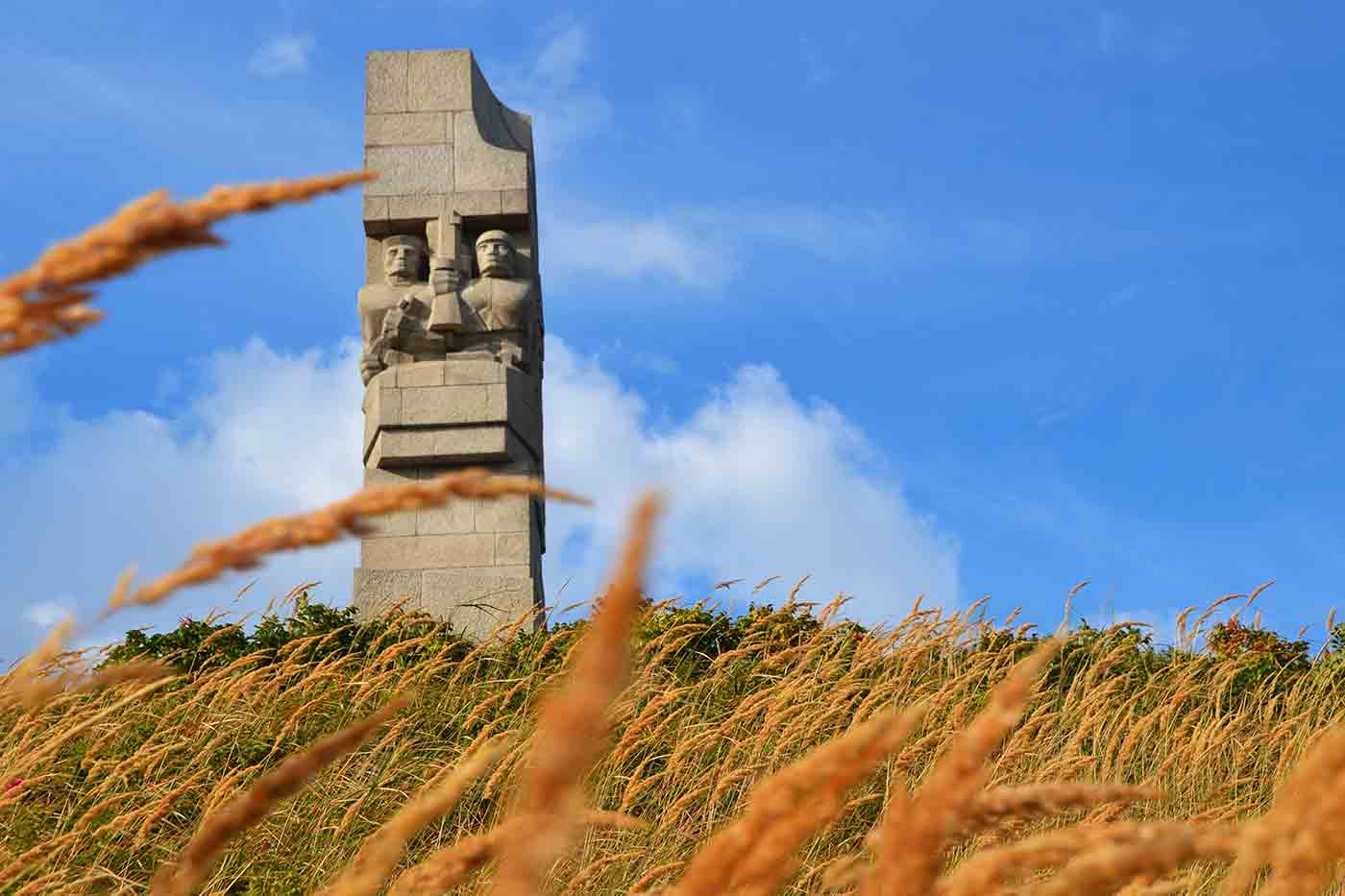
12. Beaches
Being a coastal city, beaches are a major part of the Gdansk’s appeal. You will encounter a variety of them while exploring the coastline. Some of the best Gdansk beaches are Plaza Jelitkowo, Brzezno and Stogi and Orlowo. You also get to enjoy a variety of fun activities to do in Gdansk including water sports, leisure, dining, nature trails, boat rides and so on. You can easily spend a couple of hours enjoying at each beach.
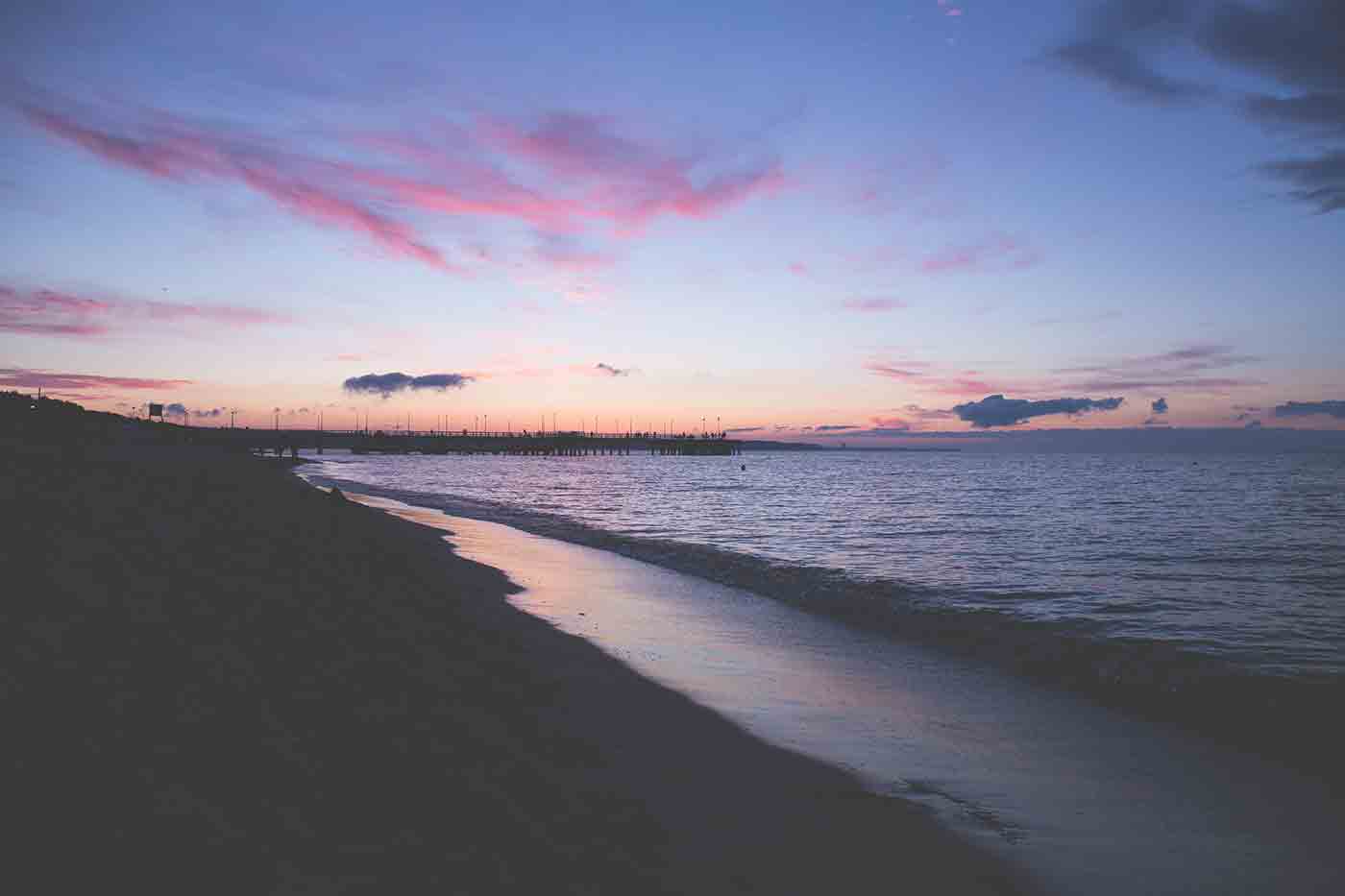
13. Golden Gate (Złota Brama)
This gate was also designed by Abraham van den Blocke and was built during the 1600s. The gate is said to represent cardinal values such as Peace, Freedom, Wealth, Fame, Harmony, Justice, Piety and Prudence. It is one of the most beautiful things to see in Gdansk. You will need about half an hour to admire it.
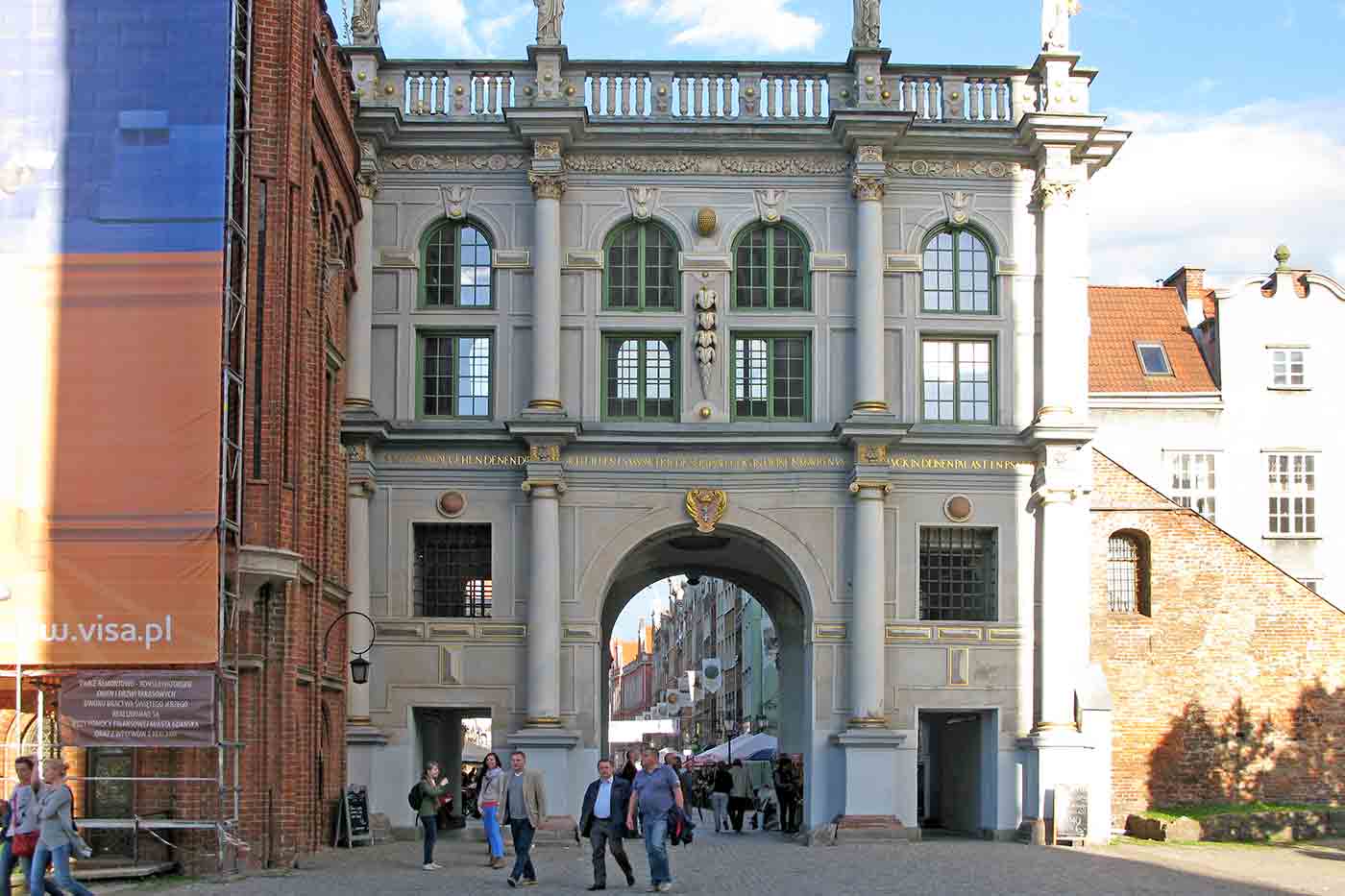
14. Oliwa Cathedral (Katedra Oliwska)
This marvelous cathedral dates back to the 14th century. It is among the best places to visit in Gdansk, Poland for admirers of architecture. The church features a blend of Renaissance, Mannerist and Baroque styles. You will need half an hour to explore this church during Gdansk travel.
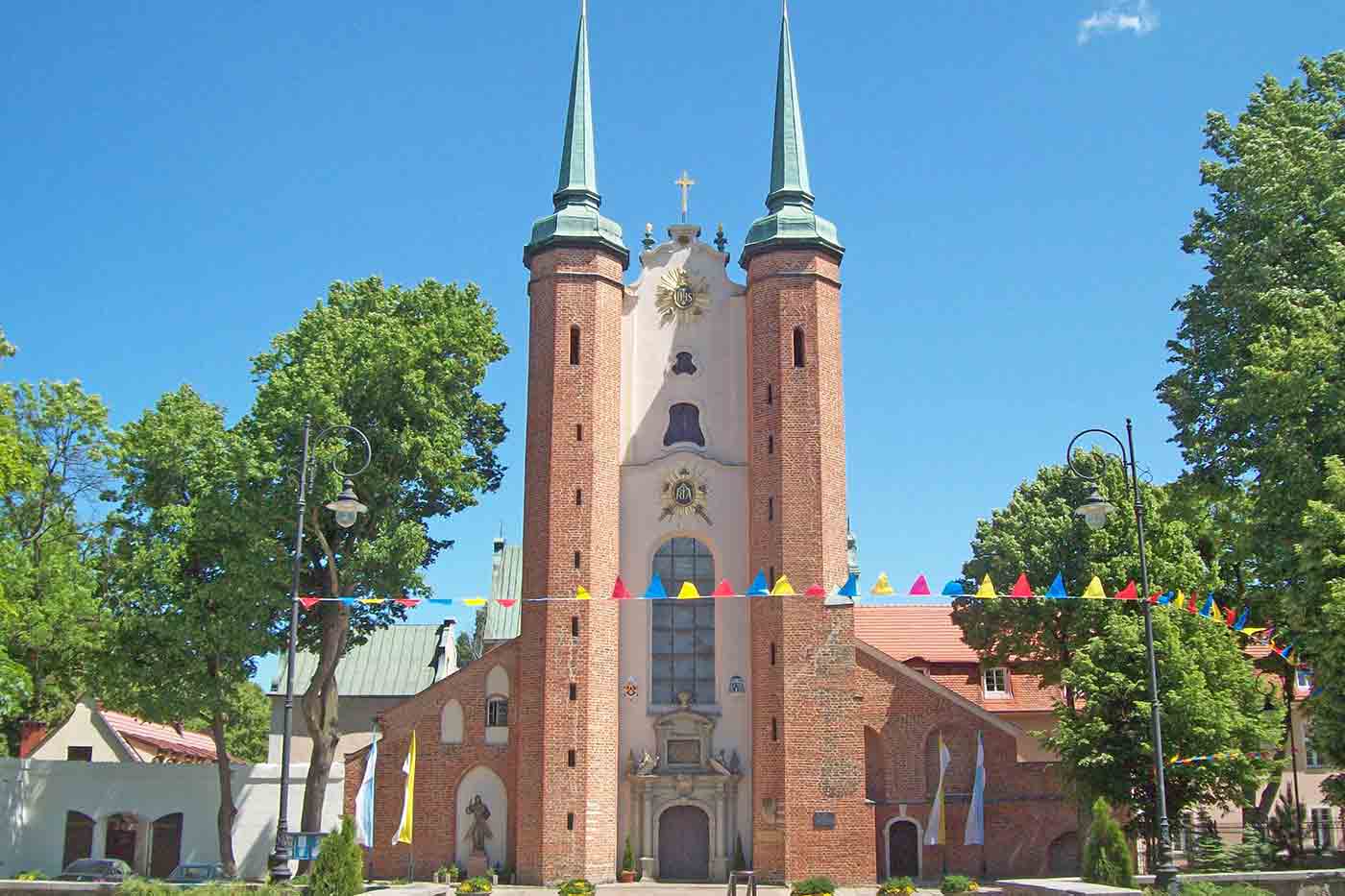
15. European Solidarity Center (Europejskie Centrum Solidarności)
This solidarity movement began as a trade movement and evolved into civil resistance against the iron curtain. The exhibits in this place let you peek behind the iron curtain. It is one of the best Gdansk tourist attractions to learn about history of the communist regime in the region. You will need a little more than an hour to tour this center.
I suggest you should book a communism tour with visit of European Solidarity Center in Gdansk.
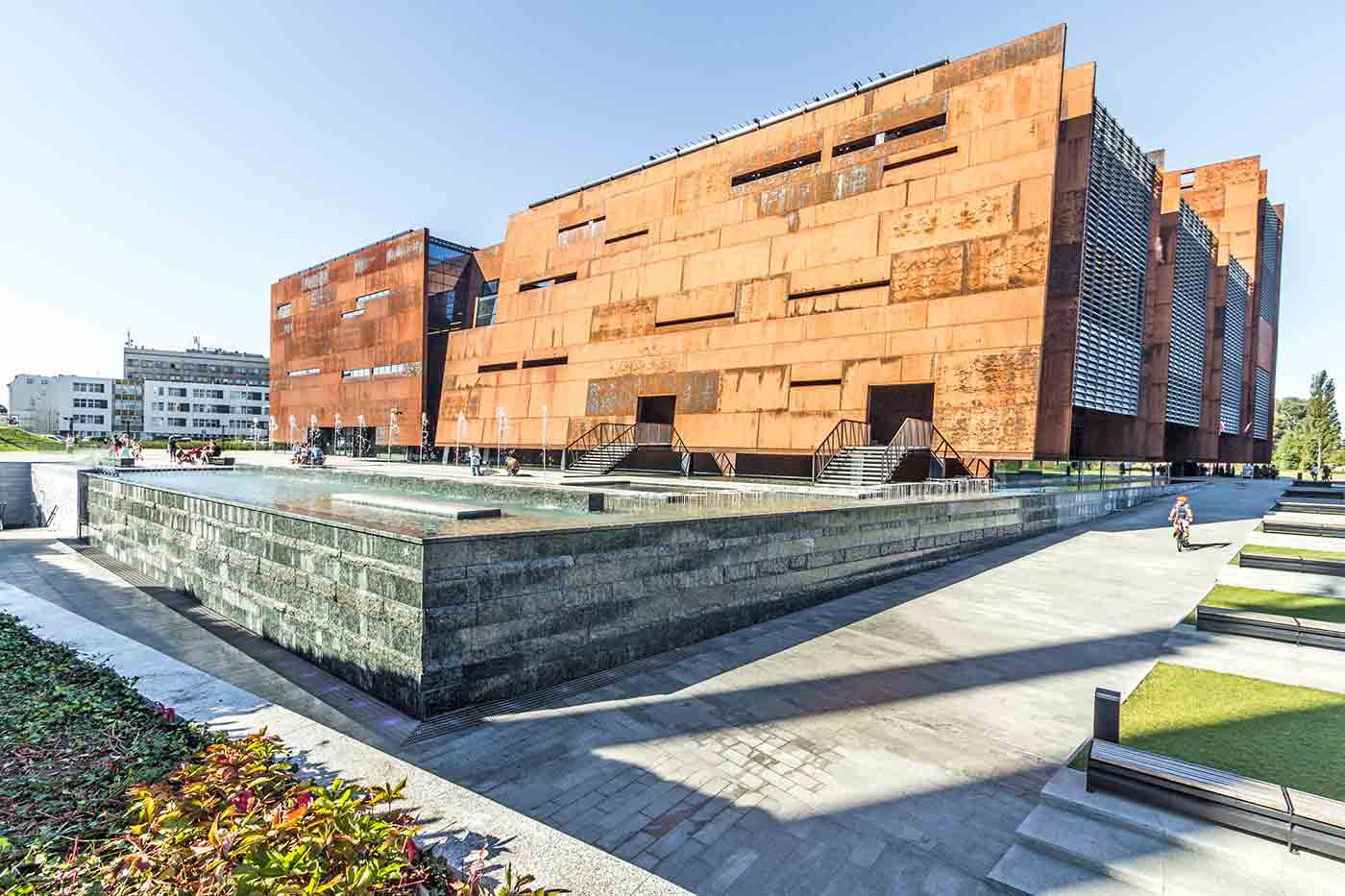
16. Amber Museum
This museum explores the relationship of the city with Amber gemstone. It is an integral part of the city’s history as Amber was abundant in the Baltic region and trade of Amber contributed to Gdansk prosperity. You will all kinds of things made from or decorated with Amber in this museum. It will take you 30 to 45 minutes to explore this museum.
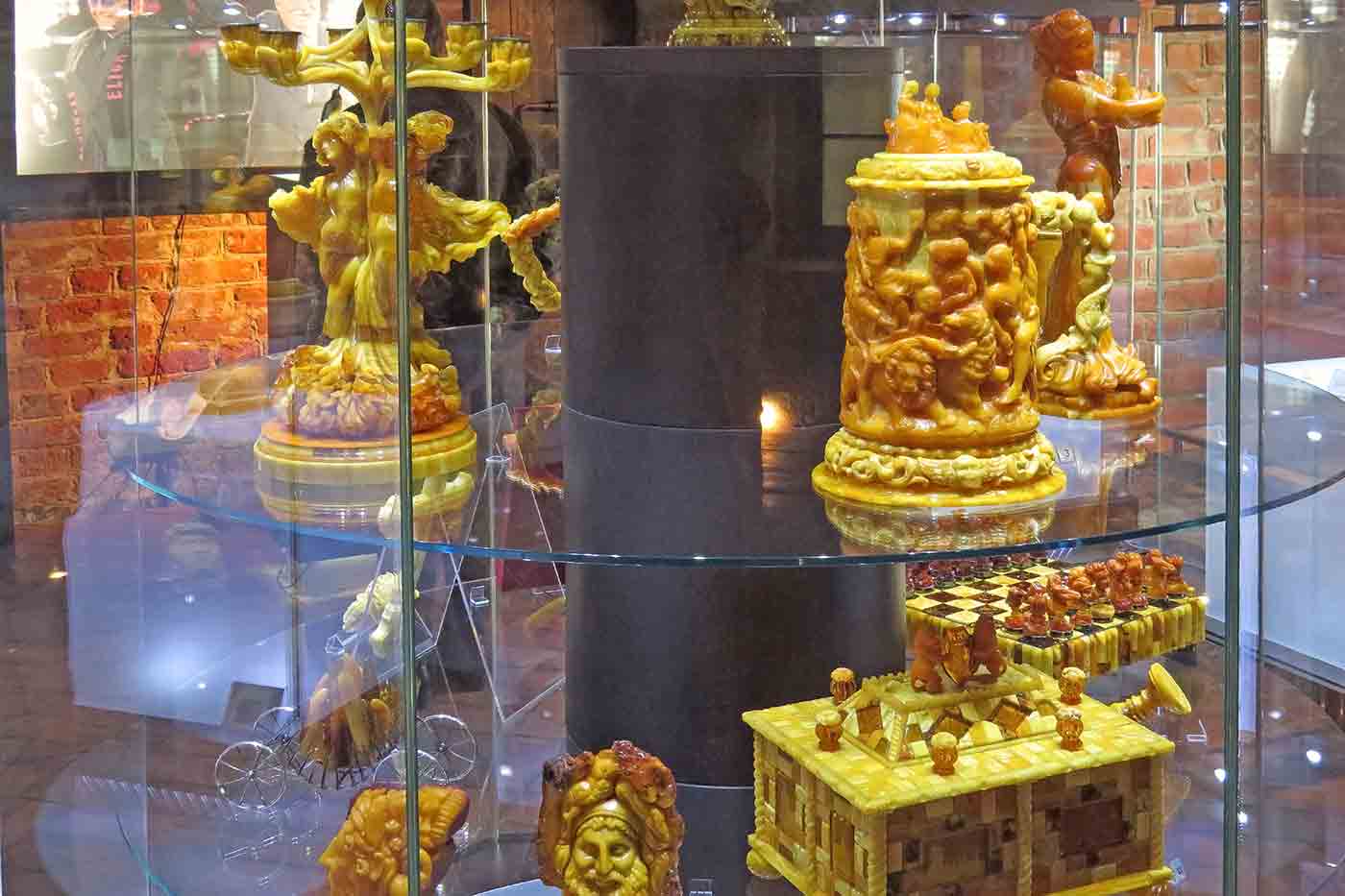
17. Boat Cruise
The boat rides and cruise tours are a great to enjoy sights of the city, sunset/sunrise views and explore the coast. You can enjoy tour of the river and the city or embark towards the open ocean. There are great choices of boats available as well from sailing boats to yachts and even a pirate ship. The experience tops the list of cool things to do in Gdansk. You will need about 2 hours for this experience.
I suggest you should book a Shipyard and Old Town Sunset Evening Cruise . Also you can go for Motlawa River Yacht Cruise .
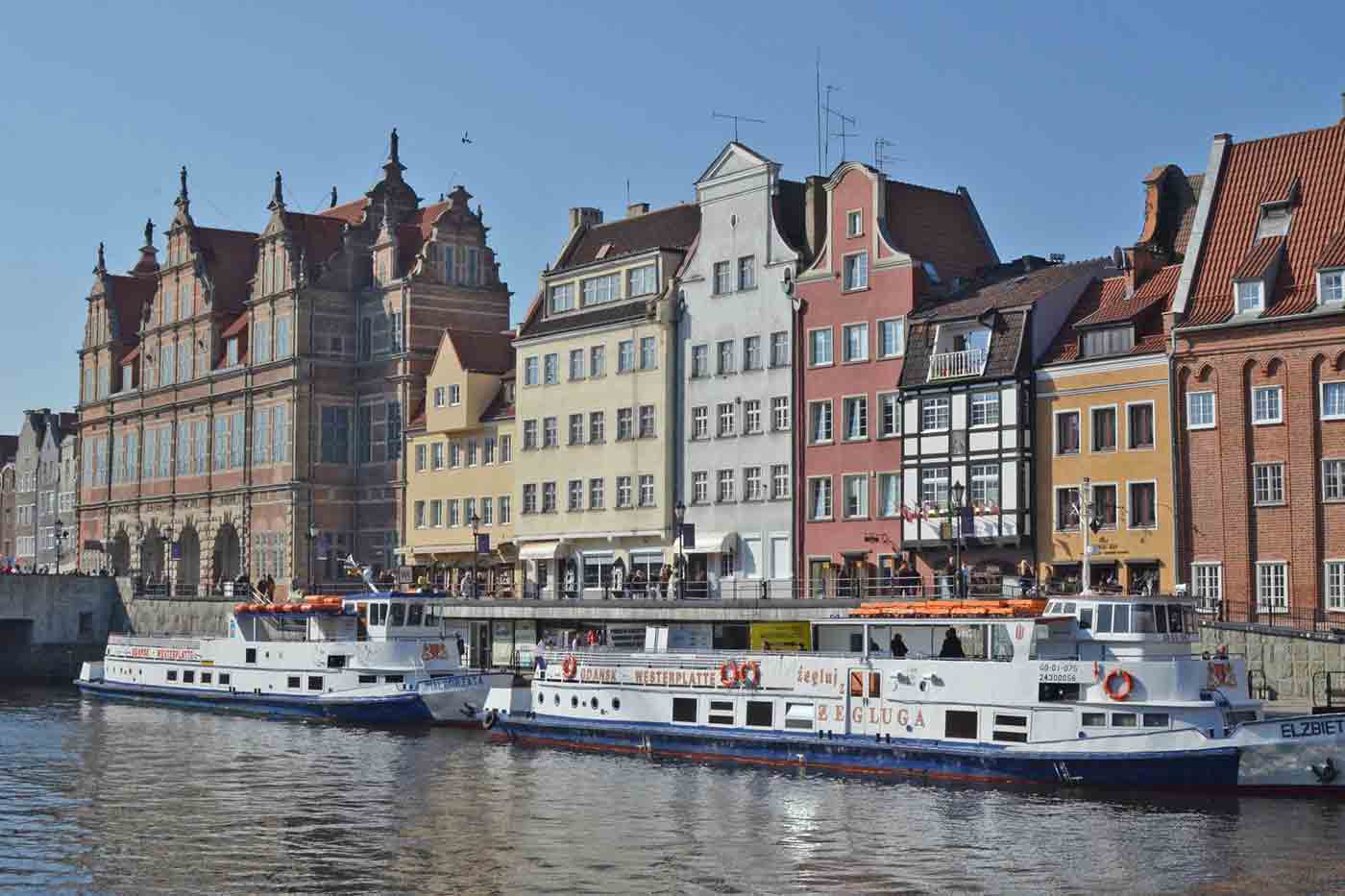
18. Abbot’s Palace (Pałac Opatów w Oliwie)
This palace was built in the 15th century and exhibits rococo style of architecture. The beautiful palace houses several modern art works and several as both a gallery and a museum. You will need about 30 minutes to explore this palace.
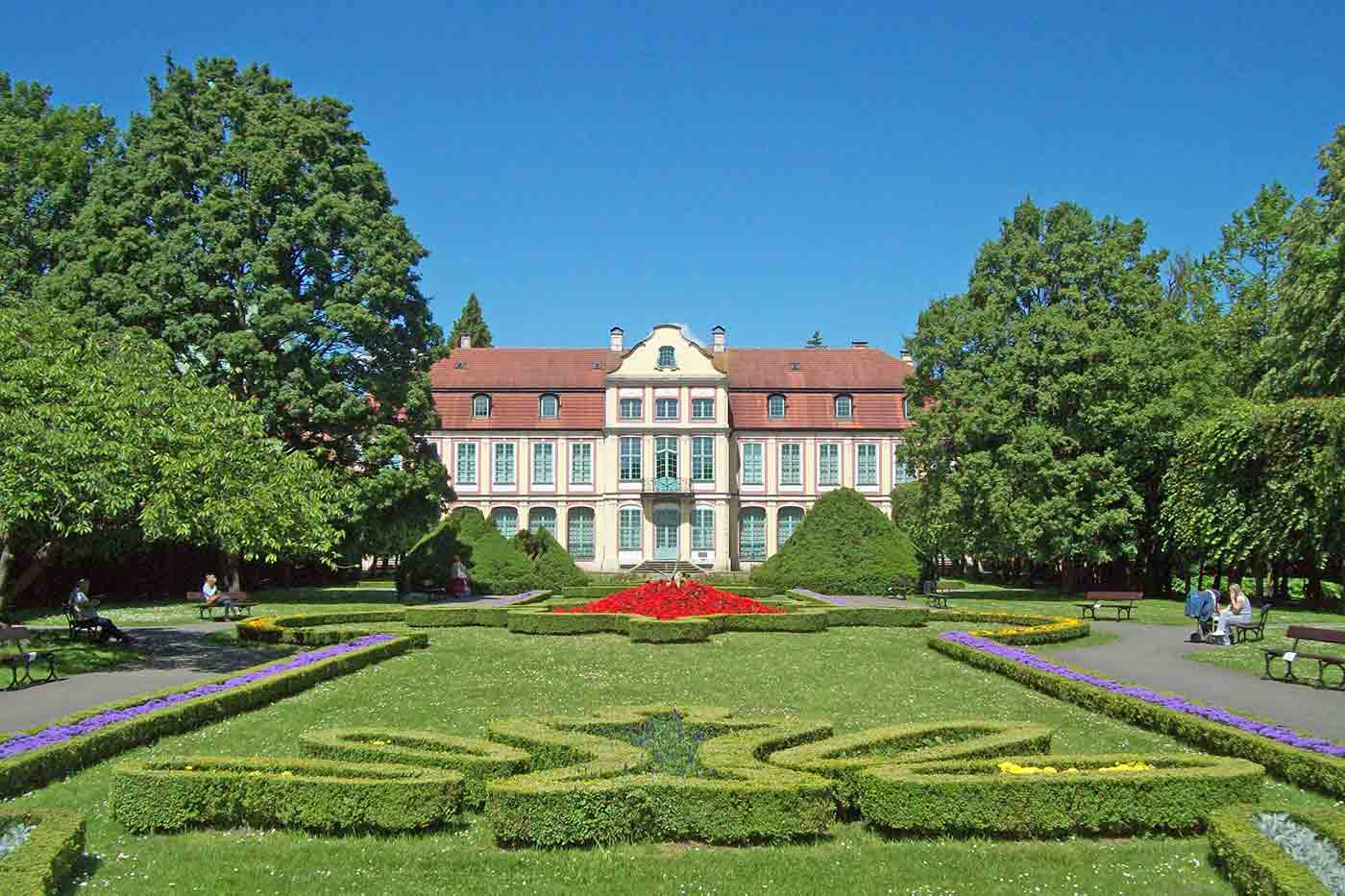
19. The Great Mill (Wielki Młyn)
Known as Wielki Mlyn in Polish, this old mill is now a museum giving you peek into the industrial life of the bygone era. It is also a quaint building built over a canal. It looks cute from every angle. It is definately among Gdansk must see places just to capture its quaint design in a picture. You will need 30 to 45 minutes for this place.
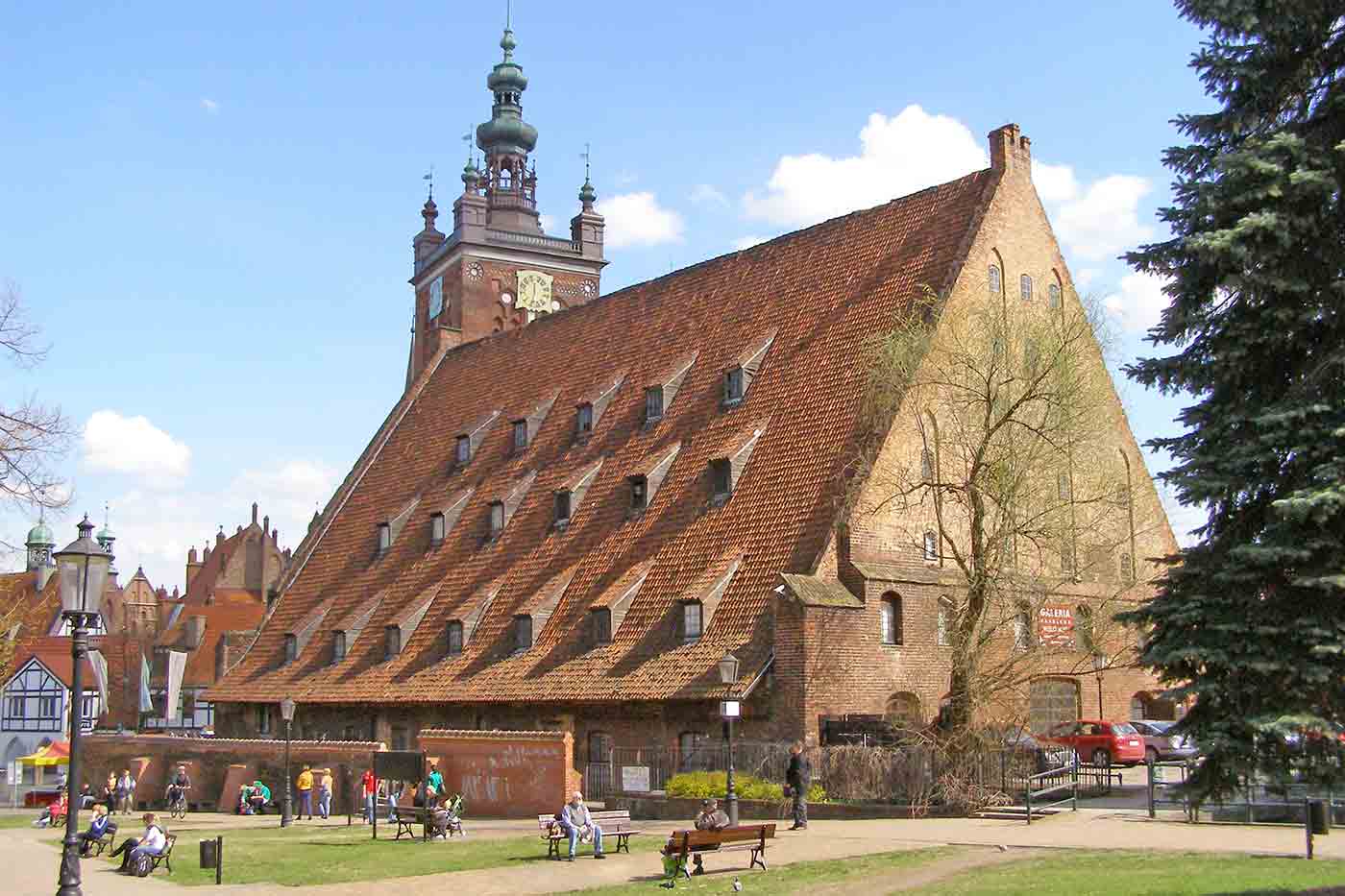
20. Sopot Pier (Molo w Sopocie)
Sopot Pier has a great beach on either side and a beautiful wooden walkway leading towards the ocean. It is one of the best Gdansk beaches and also the best tourist spot to see the sun rise from beyond the ocean. You can spend a couple of hours or more at this pier.
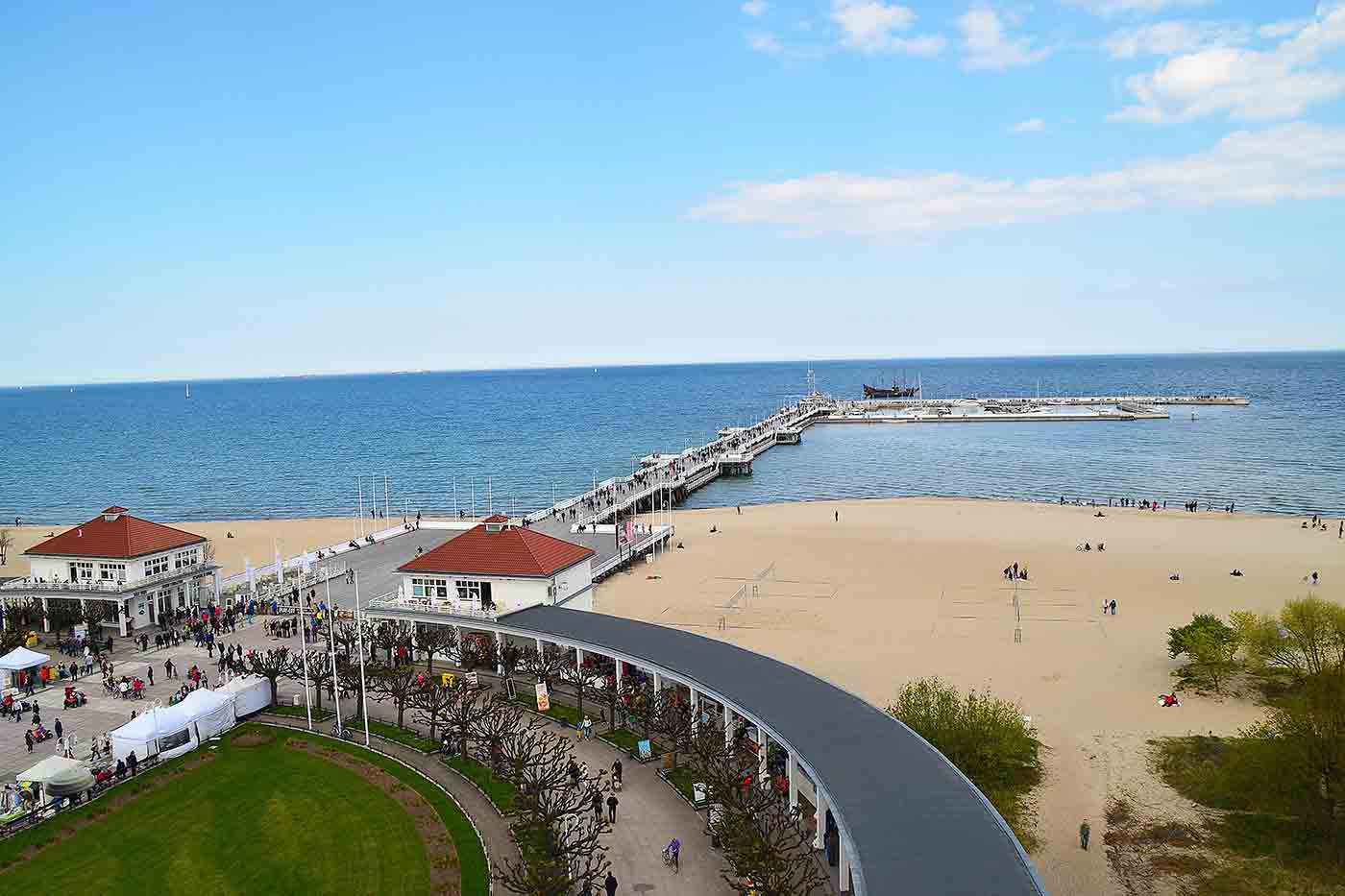
If you are looking for more activities to do in Gdansk, check out the sections below. We have prepared an exhaustive list of all things you can do and all the places you could visit while exploring Gdansk.
Things to do in gdansk, monuments, museums & historical places to visit in gdansk.
- Basilica of St. Mary
- Museum of the Second World War
- Neptune’s Fountain
- European Solidarity Center
- Museum of Gdansk
- Amber Museum
- National Museum
- National Maritime Museum
- Artus Court
- Golden Gate
- Oliwska Cathedral
- Uphagen’s House
- The Great Armoury
- Grue Medievale de Gdansk
- Soldek Ship Museum
- Laznia Center for Contemporary Art
- Wisloujscie Fortress
- Gdansk Archeological Museum
- The Great Mill
- St. Catherine Church
- Westerplatte Museum
- Sopot Museum
- Museum of the Polish Post
- Monument to the Fallen Shipyard Workers of 1970
- North Harbour Lighthouse
- Wielki Mlyn Museum
- Wartownia Military Museum
- Nomus Nowe Museum
- Church of St. John
- Polish Baltic Frederic Chopin Philharmonic Hall
- Tower Clock Museum
- Blue Lamb Archeological Museum
- Westerplatte Monument
- Gdansk Gallery of Photography
- Department of Modern Art
- St. Mikolaja Basilica
- Spichlerz Opacki Ethnography Museum
- Statue of John III Sobieski
- Old Toy Gallery
- Monumental Water Forge of Oliwa
- Piwnica Romanska Archeological Museum
- St. Mary’s Gate
- Oliwa Forest
Nature & Wildlife Tourist Spots in Gdansk
- Tri City Landscape Park
- Mewia Lacha Peninsula
- Ptasi Raj Bird Reserve
- Dolina Radosci Forest
- Stara Orunia Reserve
Entertainment & Leisure Tourist Spots in Gdansk
- Oliwski Park
- Amber Sky Observation Wheel
- Loopy’s World Amusement Park
- Orunski Park
- President Ronald Reagan Park
- Port Brzezno Rope Park
- Jumpcity Amusement Park
Shopping in Gdansk
- Mariacka Street
- Galeria Baltycka
- Sopot Centrum
- Long Market
- Madison Shopping Mall
- Forum Gdansk
Beaches in Gdansk
- Brzezno Beach
- Mewia Lacha Beach
- Plaza Stogi
- Sopot Beach
- Jelitkowo Plaza
- Gdynia Beach
- Sobieszewo Beach
- Orlowo Beach
Offbeat Places, Tours, & Adventure Activities to Do in Gdansk
- River Cruise
- Bird Watching
- Pirate Ship Cruise
Sightseeing in Gdansk
- Dluga Street
- Motlawa River Habour
- Gdansk Shipyard
- Brzezno Pier
- Wyspa Spichrzow
- Olivia Star Skyscraper
- Gora Gradowa
- Golden House
- Wzgorze Pacholek Viewing Platform
- Piwna Street
- Dlugie Probrzeze
- Deo Plaza Biuro
- Statek Pirat Ship
- Black Pearl Pirate Ship
- Weichseldurchstich Canal
- Raduni Canal
- Main Town Hall
- Green Bridge
Food, Dining, Restaurants, & Street Food in Gdansk
- Pub Red Light
- Pierogarnia Mandu
- Familia Bistro
- Mono Kitchen
- Gdanski Bowke
- Feed my Soul Bistro
- Cafe Absinthe
- Nova Pierogova
Where to Stay in Gdansk?
Here we have listed Top Rated Luxurious, Mid-Range and Budget Hotels in Gdansk. You can check below listed hotels for your perfect stay in Gdansk.
Luxurious Hotels
- PURO Gdansk Stare Miasto
- Hilton Gdansk
- Radisson Blu Hotel Gdansk
- Radisson Hotel & Suites
- Podewils Hotel
- Hanza Hotel
- Q Hotel Grand Cru Gdansk
- Mercure Gdansk Posejdon
- Qubus Hotel Gdansk
- Gotyk House
- Novotel Gdansk Marina
- Golden Tulip Gdansk Residence
Mid-Range Hotels
- Hampton by Hilton Gdansk Old Town
- Hotel Almond Business & Spa
- Craft Beer Central Hotel
- Stay Inn Hotel
- IBB Hotel Dlugi Targ
- Holiday Inn Gdansk – City Centre, an IHG Hotel
- Hotel Sadova
- Hampton by Hilton Gdansk Oliwa
- Hotel Admiral
- Novotel Gdansk Centrum
- Hotel Scandic Gdansk
Budget Hotels
- Mercure Gdansk Stare Miasto
- Hotel Number One By Grano
- Apart Neptun
- Celestin Residence
- Ibis Gdansk Stare Miasto
- Smart Hotel
- La Guitarra Hostel Gdansk
- Moon Hostel
- Hotel Focus Gdansk
- 5 Point Hostel
- Arkon Park Gdans
Custom Tours Package in Gdansk
How to reach gdansk.
The easiest option for Gdansk travel is with Lech Walesa Airport. You can get direct flights from Heraklion, Tirana , Dusseldorf , Stockholm , Helsinki , Amsterdam , Krakow , Warsaw , Burgas, Rhodes, Frankfurt , Munich , Copenhagen , Oslo , Birmingham , Dublin , Bristol , Edinburgh , London , Malta, Manchester , Newcastle , Pisa , Venice , Vienna , Zurich , Barcelona , Liverpool , Reykjavik and many more.
The train from the airport moves towards the city’s central railway station and you see many of the Gdansk tourist attractions along the way. You will find ticket machines to get tickets for the train ride. You can also get tickets from Cash Desks or from the Train Crew at the station.
You can also get buses and cabs to get to places to visit in Gdansk from the airport.
You can get direct trains to visit Gdansk from several cities in Poland as well as in Europe including Warsaw, Berlin , Krakow, Prague , Vienna, Amsterdam, Budapest , Frankfurt, Bratislava and many more.
The bus network to reach Gdansk is even more widespread locally as well as internationally. But, if the distance is significant trains and flights are much better options.
If you are planning to travel by road, you should head for routes A1, E75, S6 or S7.
You can get boat rides and ferries for Gdansk travel from Nynashamn and Karlskrona in Sweden.
Mustafa Natalwala
Mustafa is a content writer and digital marketing expert at WideWorldTrips.com His mainly interests are into travelling, photography, film-making
You May Also Like
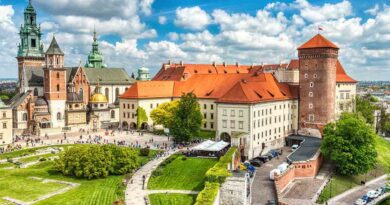
Best Things to Do and Places to See for Tourist in Kraków
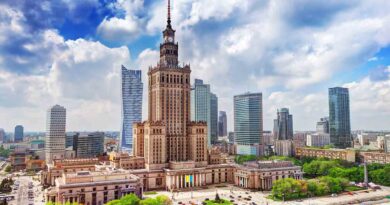
Cool Places to Visit and The Best Things to Do in Warsaw
Leave a reply cancel reply.
Your email address will not be published. Required fields are marked *
Save my name, email, and website in this browser for the next time I comment.
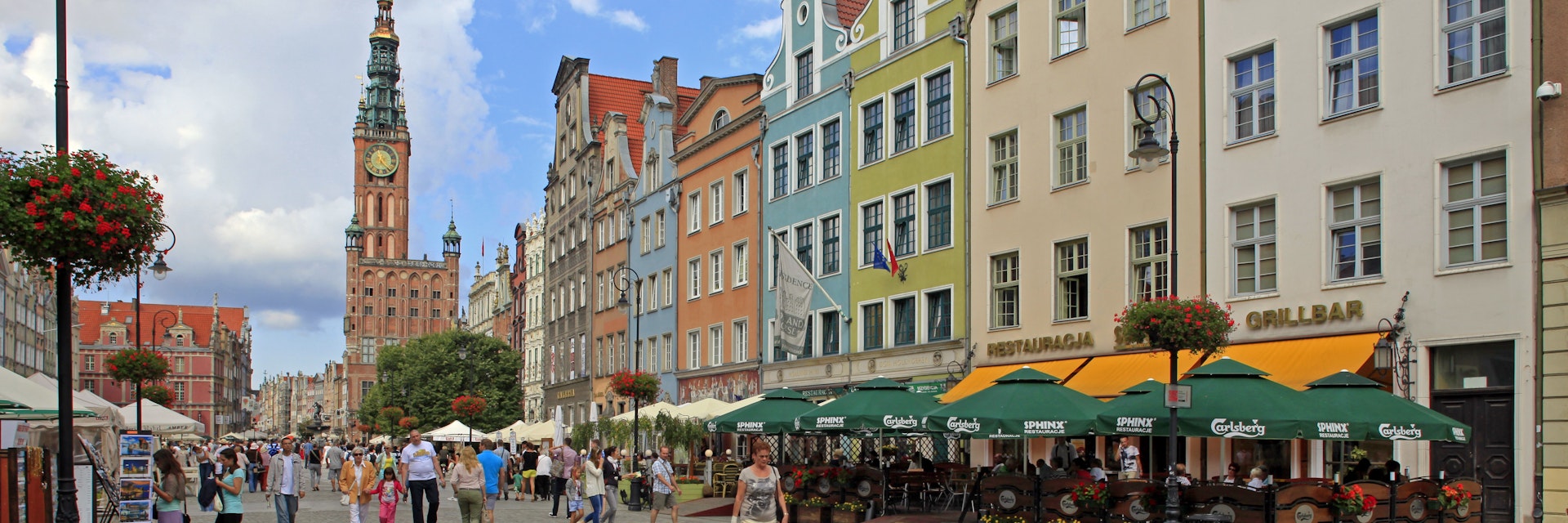
Getty Images
Like a ministate all to itself, Gdańsk has a unique feel that sets it apart from other cities in Poland. Centuries of maritime ebb and flow as a major Baltic port; streets of distinctively un-Polish architecture influenced by a united nations of wealthy merchants who shaped the city’s past; the toing and froing of Danzig/Gdańsk between Teutonic Prussia and Slavic Poland; and the destruction wrought by WWII have all bequeathed a special atmosphere that makes Gdańsk an increasingly popular destination.
Attractions
Must-see attractions.
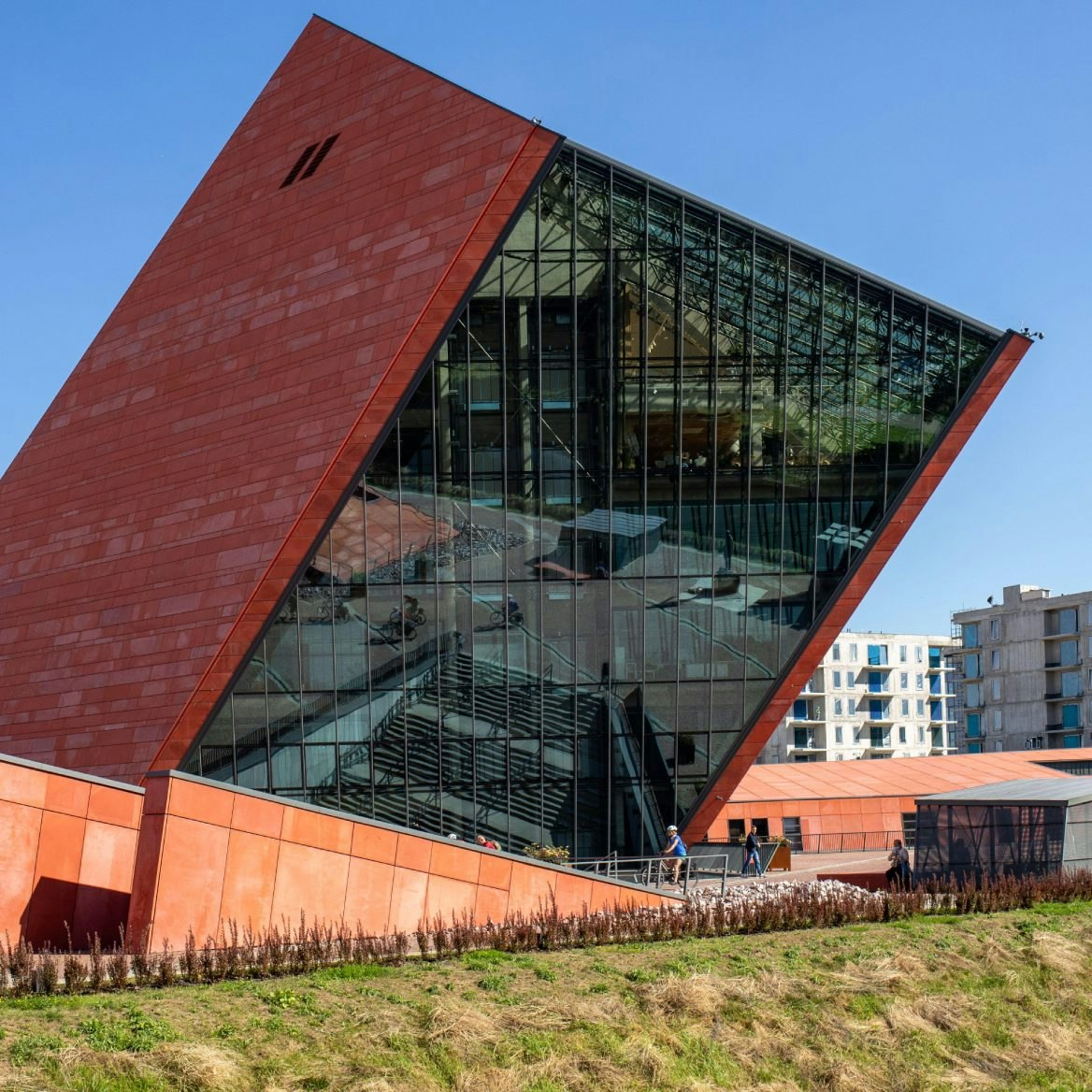
Museum of WWII
Opened in 2016, this striking piece of modern architecture is a bold addition to the northern end of Gdańsk's waterfront. It has rapidly become one of…
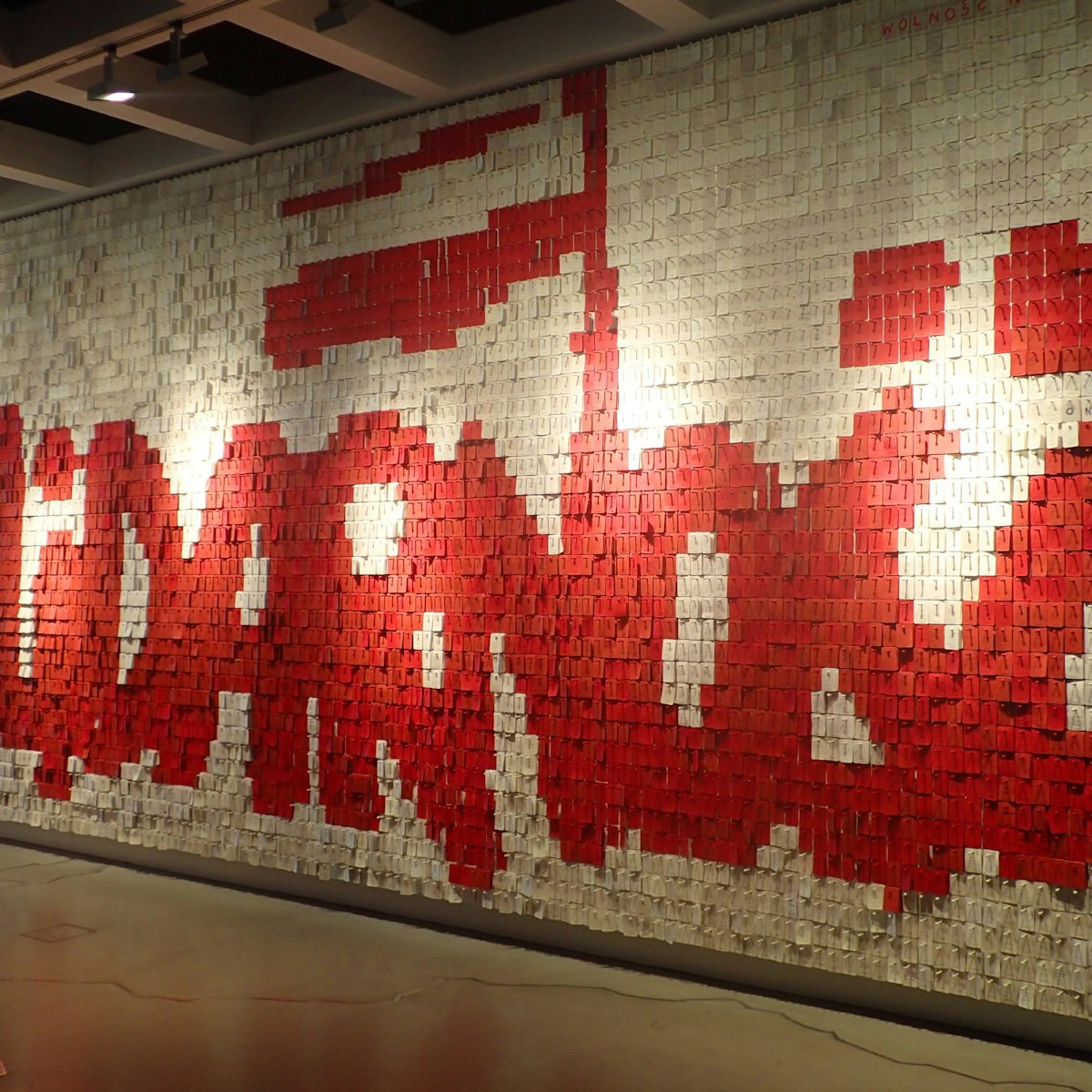
European Solidarity Centre
Opened in 2014, and housed in a truly awful example of 21st-century architecture (its rusty steel plates were designed to evoke ships under construction),…
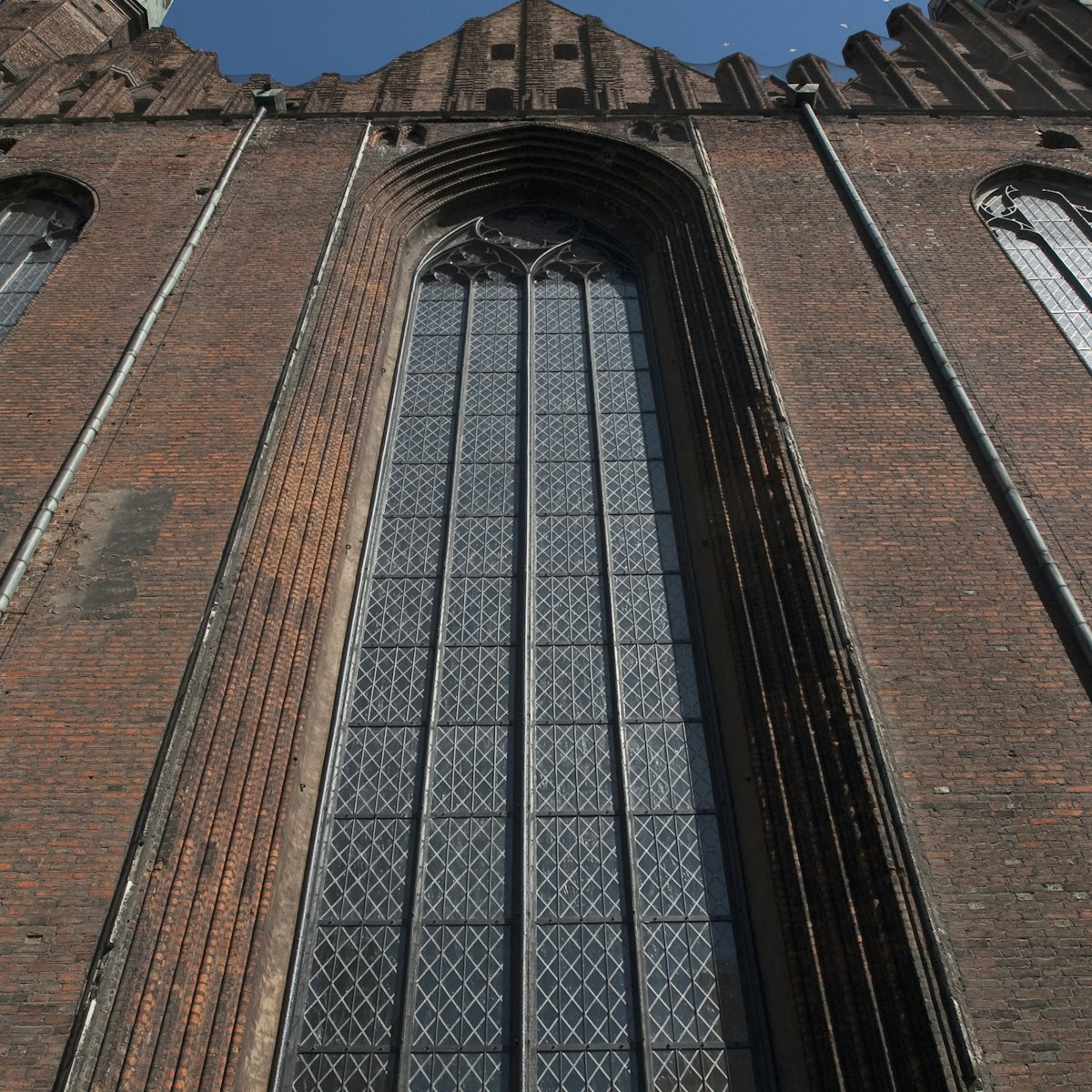
St Mary's Church
Dominating the heart of the Old Town, St Mary’s is often cited as the largest brick church in the world, its massive 78m-high tower dominating the Gdańsk…
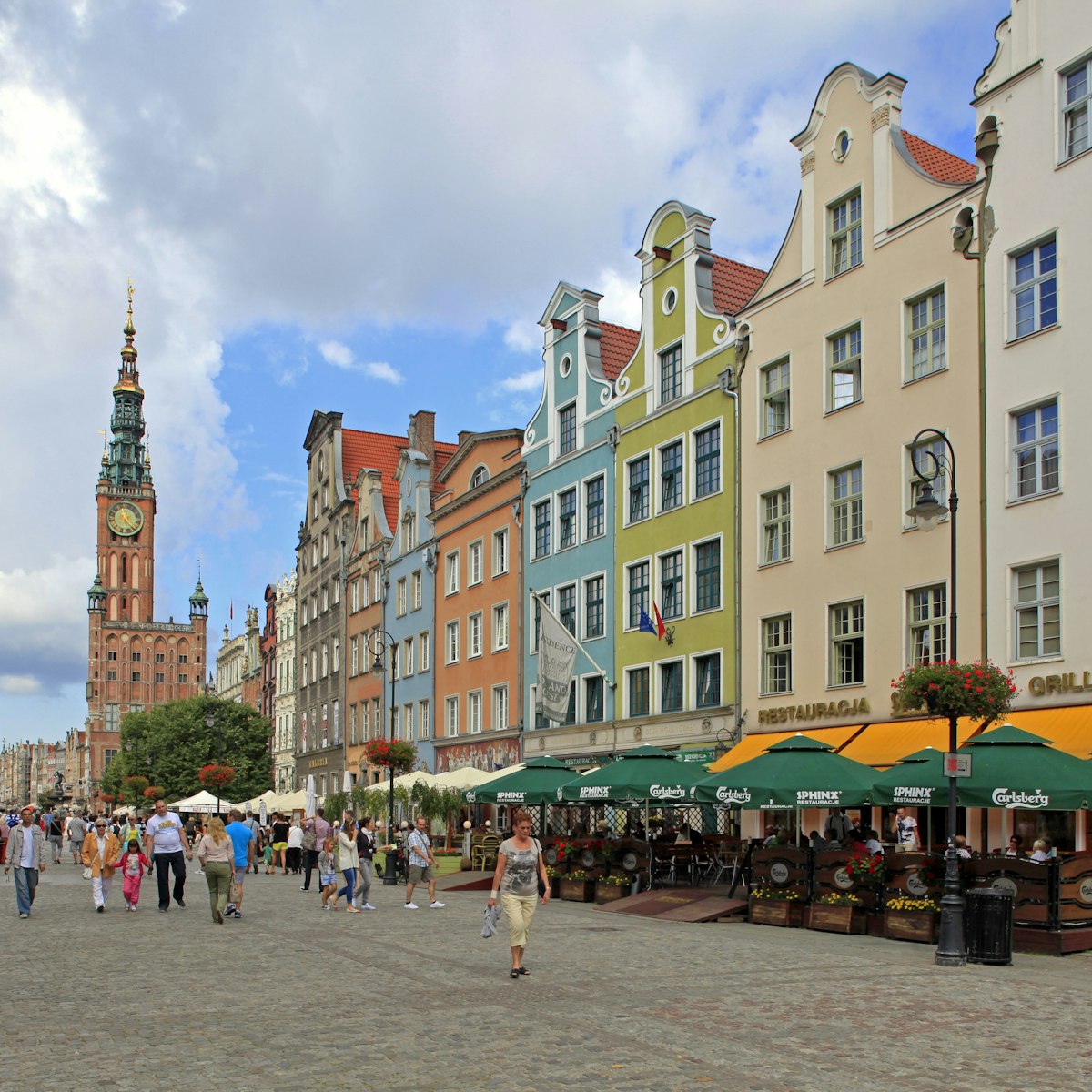
Długi Targ was once the main city market and is now the major focus for visitors. Things have gotten a bit touristy here over the last decade (dubious…
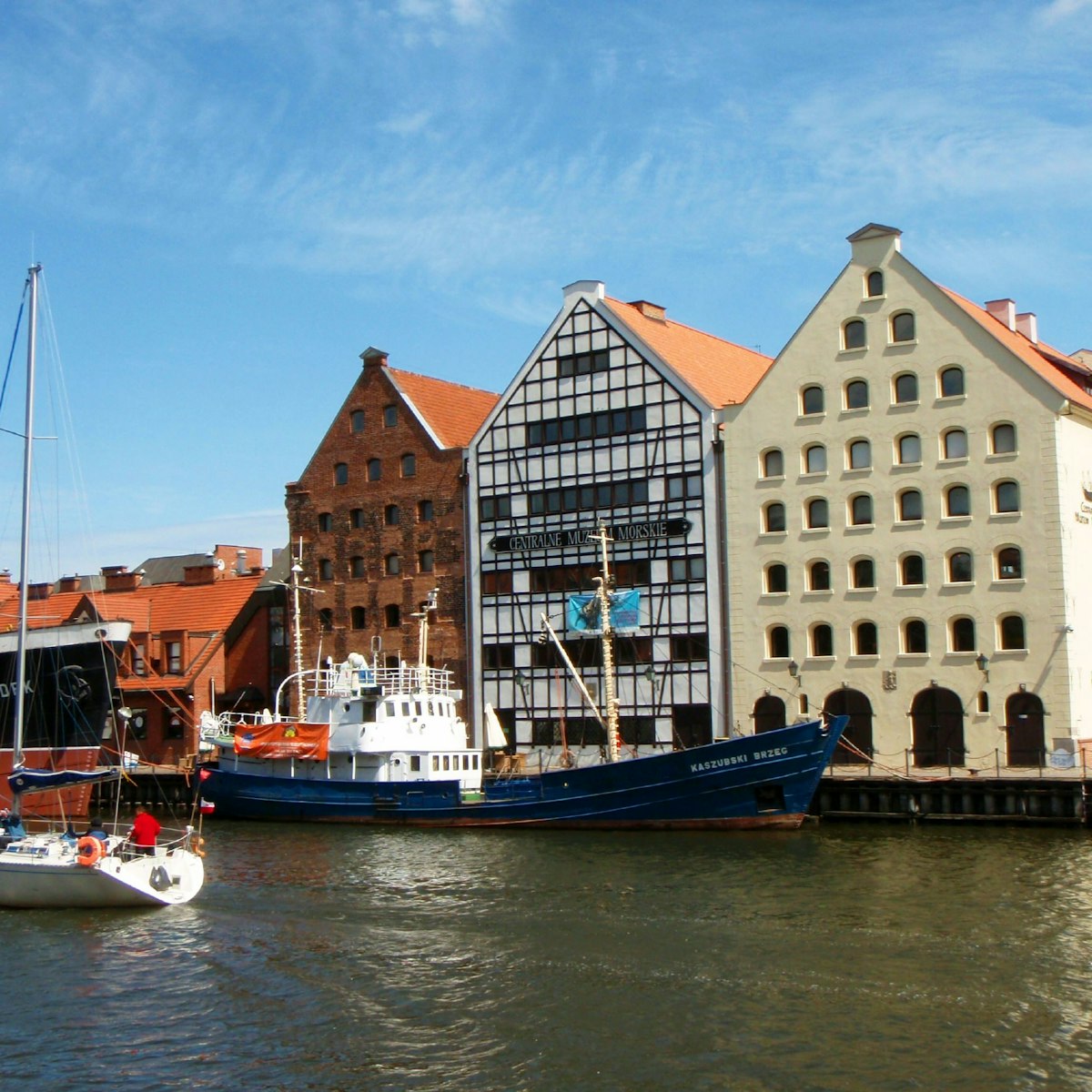
National Maritime Museum
This is a sprawling exhibition covering Gdańsk's role as a Baltic seaport through the centuries. The headquarters, the multimillion-euro Maritime Cultural…
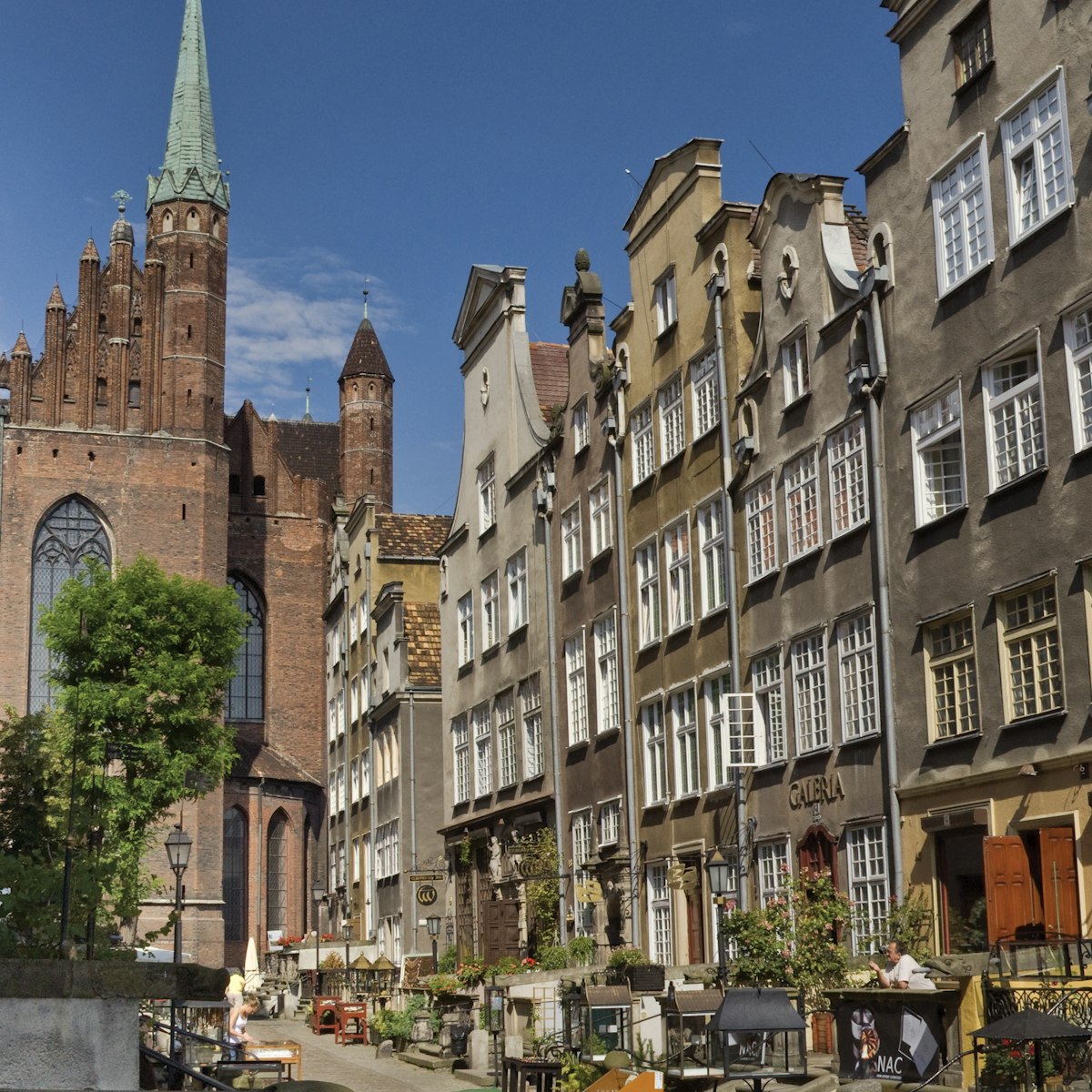
Ulica Mariacka
The most atmospheric of all Gdańsk's streets and one of Poland’s most photogenic lanes is this length of cobbles between the waterfront St Mary’s Gate and…

Artus Court Museum
Rising in all its embellished grandeur behind the Neptune Fountain, the Artus Court is perhaps the single best-known house in Gdańsk. The court has been…

St Bridget's Church
Founded over 700 years ago, St Bridget’s was reduced to medieval brick dust in 1945, and until 1970 only the outer walls were left standing. Very little…
Latest stories from Gdańsk
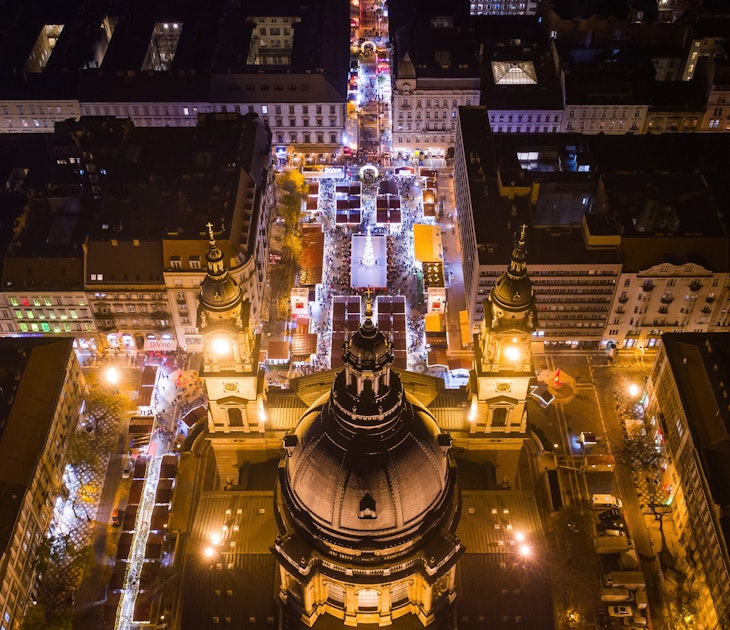
Festivals & Events
Dec 11, 2019 • 2 min read
With so many cities around Europe hosting amazing Christmas markets, visitors are spoiled for choice every December. While they all have different things…
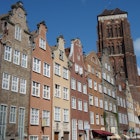
Sep 8, 2017 • 5 min read
in partnership with getyourguide
Book popular activities in Gdańsk
Purchase our award-winning guidebooks.
Get to the heart of Gdańsk with one of our in-depth, award-winning guidebooks, covering maps, itineraries, and expert guidance.

Touropia Travel
Discover the World
17 Fun Things to Do in Gdansk, Poland
By Spencer Leasca · Last updated on May 3, 2024
When it comes to European getaways, Gdansk in Poland might not be the first place you think of. But when you take a moment to understand its appeal, you’ll soon realize it is a fascinating city to visit.
Defined by an enchanting waterfront that lines the frigid waters of the Baltic Sea, it is fair to say Gdansk is a city of delightful contrasts. It boasts a rich, medieval history, reflected in its cobblestone streets and picturesque Gothic and Renaissance architecture, and a strong maritime heritage.
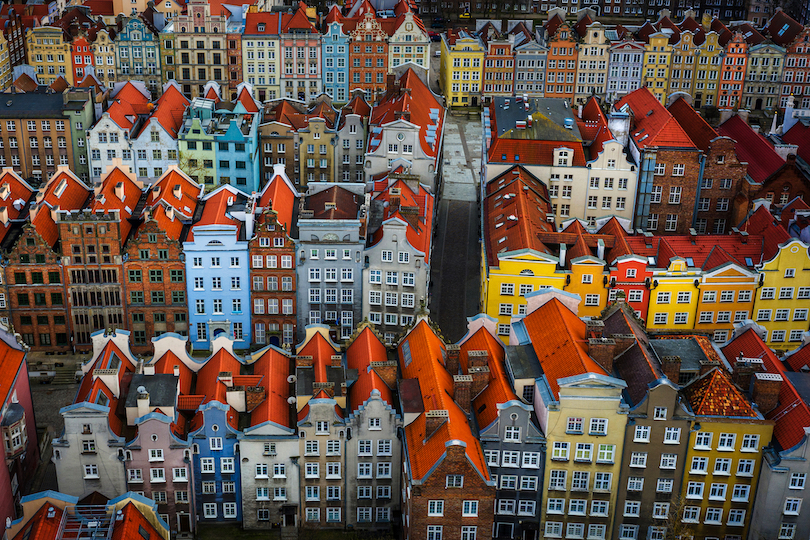
It is also best known for its pivotal role in shaping European history, marked by the Gdansk Shipyard, where the Solidarity movement originated and led to the fall of communism.
But complementing this history, Gdansk impresses with a modern flair that manifests itself in vibrant cultural attractions, a burgeoning food scene and a decent nightlife. For some people, the city might not be somewhere you are familiar with when you first get there. But you’ll soon discover there are plenty of things to do in Gdansk by the time you leave.
17. Green Gate
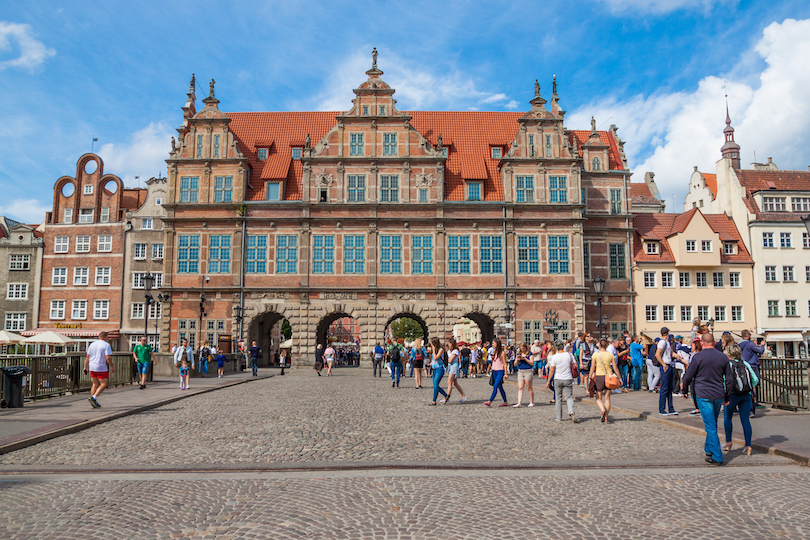
Nestled between the River Motława and Long Market is one of Gdansk’s most notable attractions – The Green Gate.
The structure was designed by Hans Kramer, while Dutch architect, Reiner van Amsterdam, oversaw the development. It was based on the city hall in Antwerp, Belgium and was designed to be the formal residence of Poland’s monarchy.
It is a fine example of Flemish architecture, which after its royal duties served as the former home of the Nature Society.
However, today it houses Gdank’s National Museum and regularly hosts exhibitions, meetings, conferences and shows. Once inside, you will also find the office of the famous Lech Wałęsa, which he used when he was President of Poland.
16. Neptune Fountain
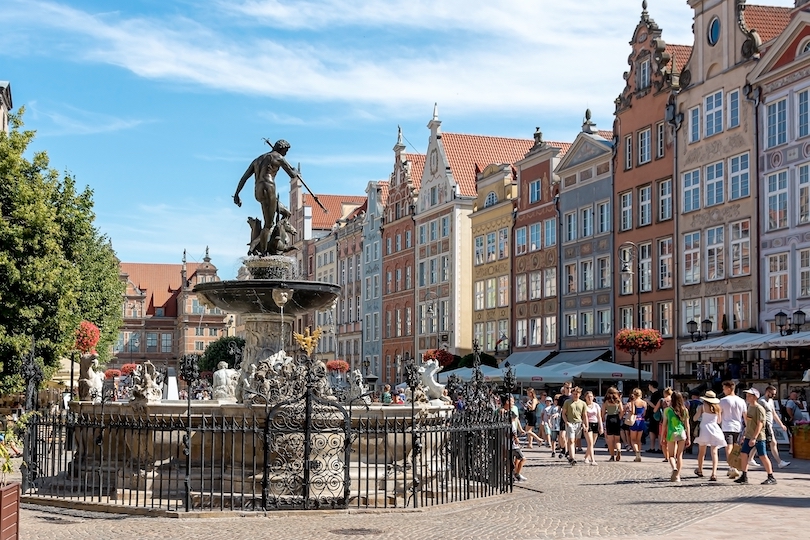
Whilst at the Long Market, take the opportunity to check out Neptune’s Fountain. This historic, mannerist-rococo masterpiece is one of the city’s main landmarks and is situated at the front entrance of the Artus Court.
The fountain was erected in 1617 and, as its name suggests, was dedicated to the Roman god of the sea. It consists of a bronze statue of Neptune, standing on a sea chariot and surrounded by allegorical figures that represent the four winds.
This masterpiece was created by the renowned Dutch sculptor Peter Husen and is intended to reflect the city’s wealth and maritime influence during the Renaissance. The impressive sculpture is highly detailed, so you should take your time to appreciate it when you go there.
15. Oliwa Zoo
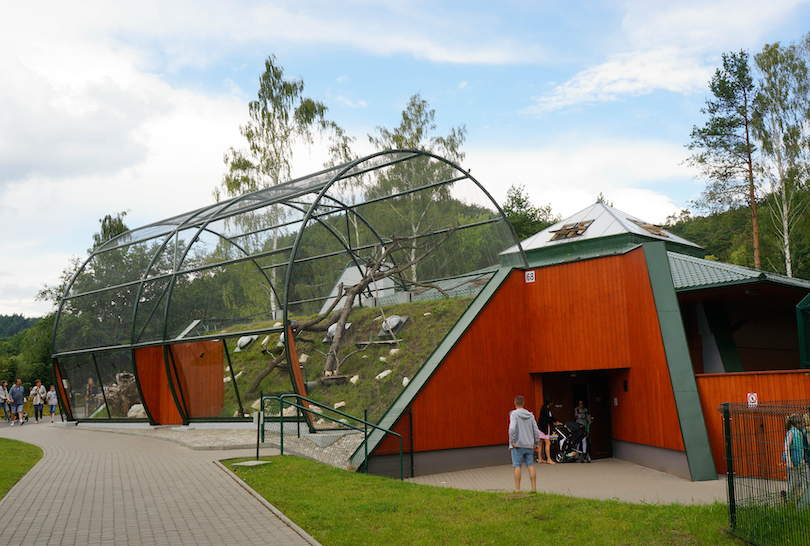
If you love animals, you should make a point of visiting Oliwa Zoo. Established in 1954, it is the largest zoo in Poland and is dedicated to caring for and preserving various animal species.
The zoo is located within the beautiful Oliwa Park, offering a natural and lush environment for over 1,100 animals from different parts of the world. These include rare species like Javan lutungs, anoas, Bali mynas, bongos and mandrills.
All up within the family-friendly zoo, there are over 190 species of animals. They are housed within various themed exhibits, such as the African Savanna, Amazon Rainforest and Arctic Zone, which you should set aside at least half a day to explore.
14. Museum of Amber
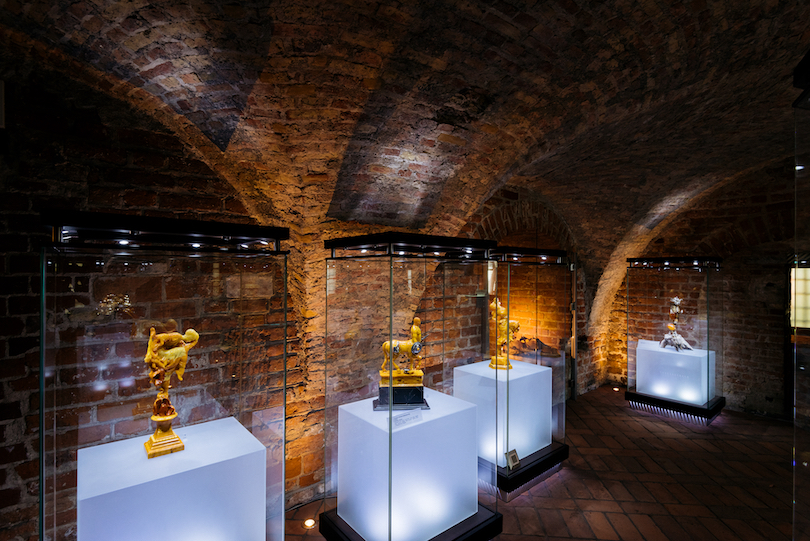
The Museum of Amber is remarkable – the first in Poland dedicated to Amber. The cozy museum is part of the Gdańsk Museum and is housed in a former prison.
Since opening in 2006, it has been showcasing the world’s largest collection of Amber. Exhibits include nuggets that are at least 40 million years old, an amber chamber, an amber forest and contemporary artist designs.
What makes the museum so interesting is that it explores the geological origins of this fossilized tree resin and its significance in folklore, trade and art. Visitors can discover how amber is formed and extracted, what its properties consist of and how it has been worked over time.
13. St. Nicholas Church
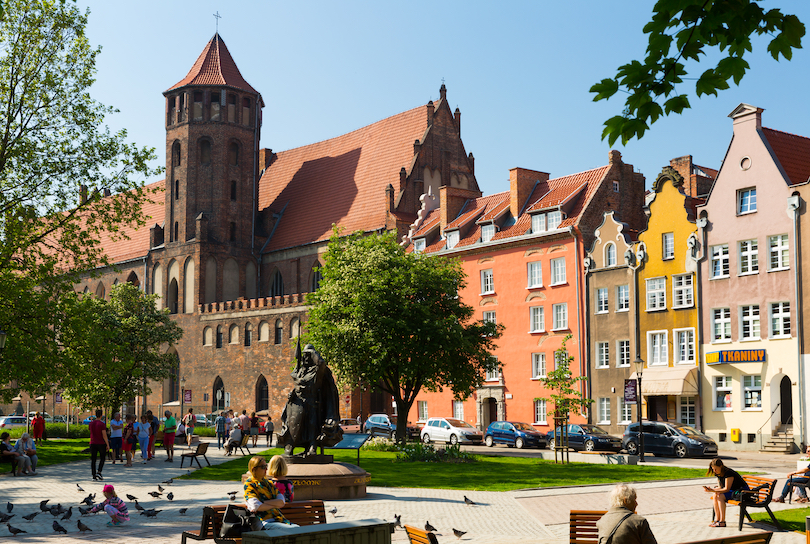
St. Nicholas Church is one of the oldest Christian places of worship in Gdańsk. It was erected by the Dominican order when it arrived in Kraków in 1227, although it has gone through several reconstructions since then.
Its current form reflects an impressive blend of Gothic and Baroque architectural styles. Remarkably, it managed to survive World War II without so much of a scratch.
Inside, the church features vaulted ceilings, ornate altars and stunning stained glass windows. The church also accommodates a stately clock tower that provides panoramic views of Gdansk. If you have a head for heights, be sure to make your way up there. It offers a breathtaking perspective of the cityscape and the shimmering waters of the nearby Motlawa River.
12. Jelitkowo Beach
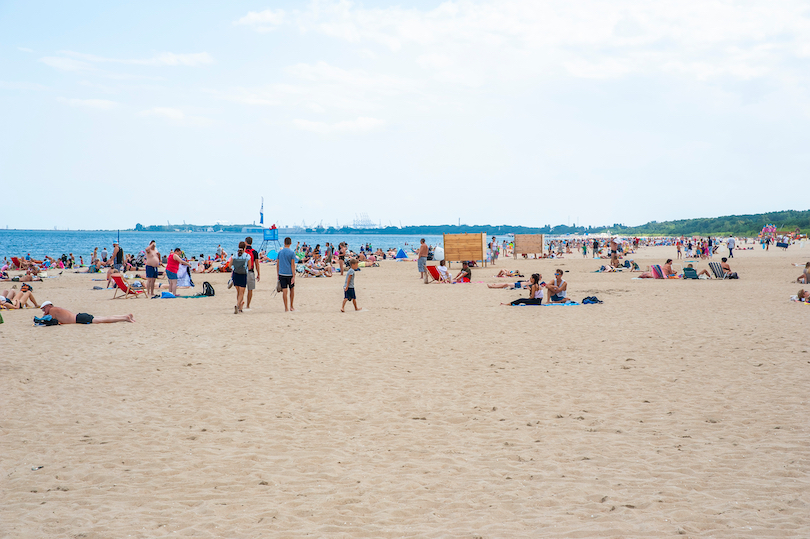
If you happen to visit Gdansk in the summer make sure you bring your swimming costume with you as you’ll want to visit Jelitkowo Beach.
This traditional seaside resort overlooks Gdansk Bay on the southern shoreline of the Baltic Sea. Once a fishing hamlet, back in the 1800s, it is now a popular place with locals and tourists that features golden sand and safe (albeit cold) waters for swimming.
During the summer, the beach buzzes with activity. People sunbathe, swim, windsurf and play volleyball in the lifeguard patrolled waters. Those not on the beach sit in restaurants and bars that line the water.
By contrast, during the winter, the beach is almost empty, but it has an ethereal quality, especially when it snows, that turns it into a fairytale-like landscape.
11. Oliwa Cathedral
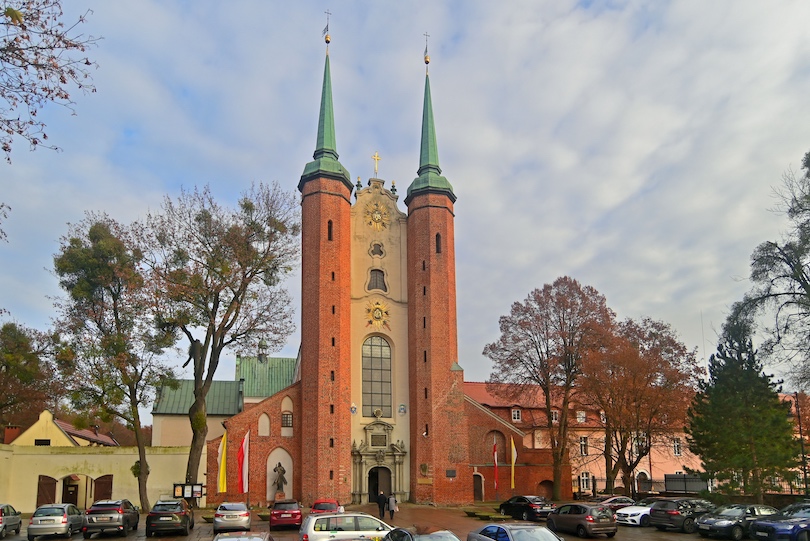
Another must-see religious structure of note in Gdansk is the Oliwa Cathedral, which is actually a Polish Historical Monument. Completed around the latter part of the 16th century, the Oliwa Cathedral is a magnificent example of Baroque architecture.
The cathedral resides in the western area of Oliwa Park and was built by Cistercians, who dedicated it to the Holy Trinity. It was constructed along a classical three-aisle design that is shaped in the style of a Latin cross and notably features a vaulted basilica.
Inside, a magnificent organ dominates the main entrance. One the largest in Europe, it features fanfaring angels, moving cherubs and almost 7900 pipes which create a goosebump-inducing range of sounds and pitches when played.
10. Westerplatte
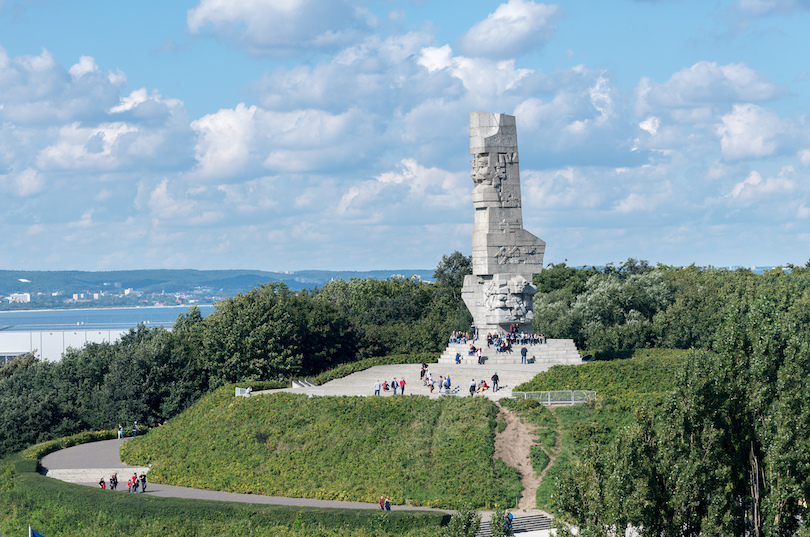
At the entrance of Gdansk harbor, Westerplatte is a historical peninsula best known for being where the first battle between Polish and German forces occurred in September 1939. This marked the outbreak of World War II and brought the area to the world’s consciousness due to this event.
Between 1926 and 1939, the Polish Military Transit Depot was based here, at the mouth of the Dead Vistula. Unfortunately, many of their men fell during battles to protect this strategic point from Nazi occupation.
The Westerplatte Monument was built to honor the bravery exhibited by the Polish defenders during that attack. Today, tourists can explore the remnants of military structures, such as the guardhouse and barracks, which provide a harrowing sense of the site’s wartime past.
9. Oliwski Park
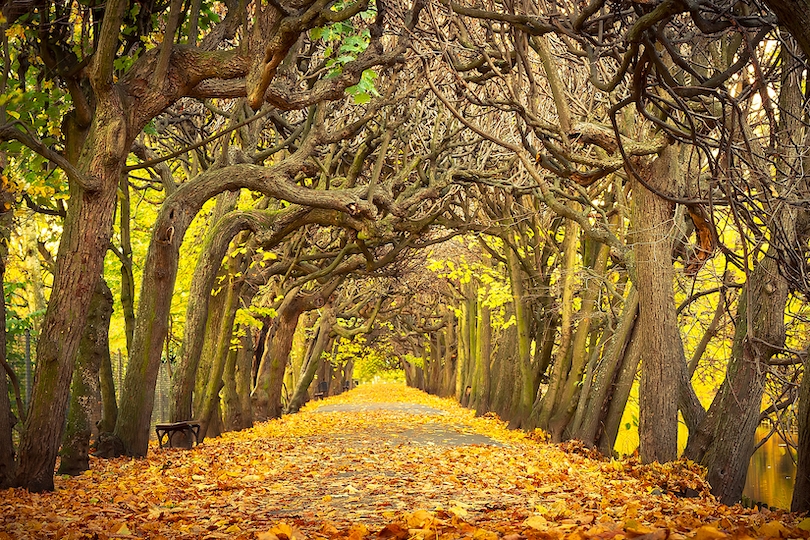
One of the most serene places to visit in Gdansk is the beautiful Oliwski Park. Originally founded as a monastery garden in the 15th century by the Cistercians, the park retains that sense of tranquility and reverence today.
Its present shape was created in the 18th century and most notably features a Baroque French-style garden that resides at the front of the Abbots’ Palace. This garden comprises vividly colored flower beds and shrubbery that are sculpted into geometric figures. It also contains trimmed rows of Linden trees as its centerpiece.
The rest of the park consists of paths, a gazebo, an English-Chinese garden with several water features, a stunning Japanese garden and sculpted azaleas. At present the city park is open from 5 am to 11 pm so you can enjoy it all day.
8. Mariacka Street
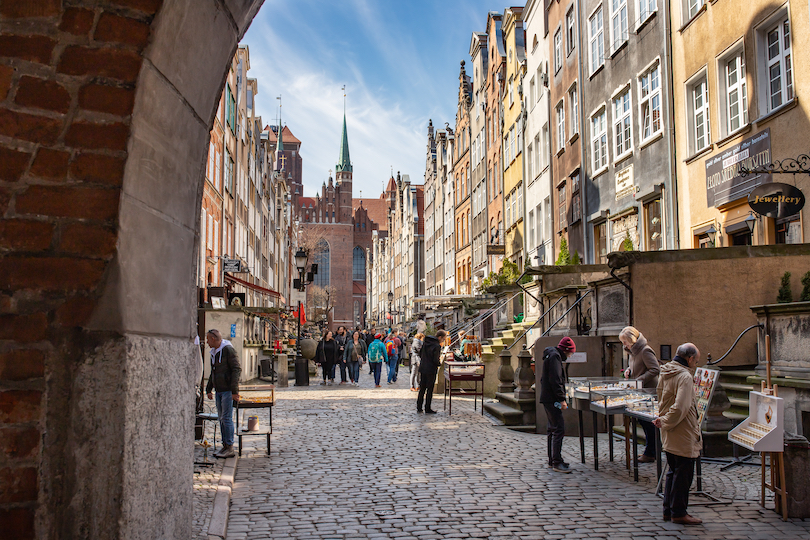
It is fair to say that Mariacka Street is one of the most beautiful streets in Gdańsk. Comprising quaint cobblestones, it runs from the Motława River to St. Mary’s Basilica, accommodating a couple of rows of terraced tenement houses that provide the area with a timeless feel.
Standing adjacent to these houses are charming cafes and intriguing galleries, which are well worth perusing. However, the main highlight of coming here has to be the view from the Mariacka Gate, all the way down Mariacka Street, to the magnificent St. Mary’s Church, which will make the hairs on the back of your neck stand up. Try to come early in the morning, just after sunrise, or late at night to really appreciate its glory.
7. Main Town Hall
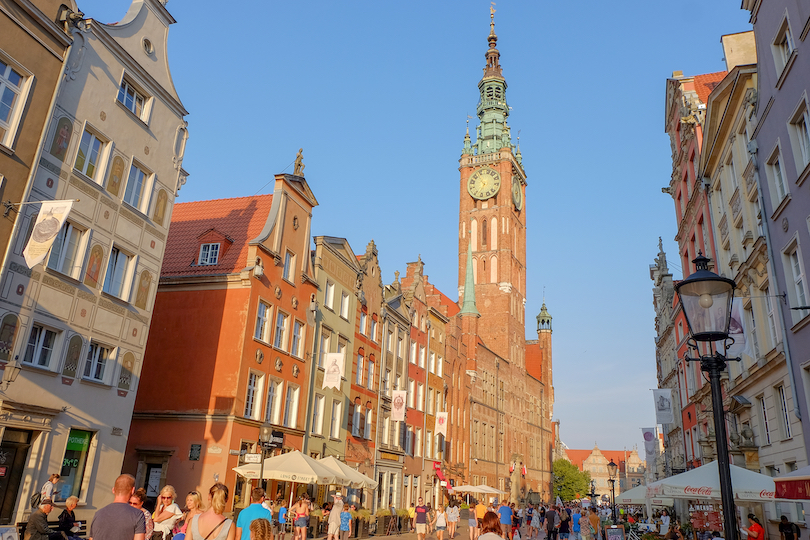
Arguably, the most impressive architectural structure in Gdansk is the Main Town Hall. This historic Ratusz is situated at the intersection of Długi Targ and Ulica Długa, within the district of Śródmieście, which forms a section of the Royal Route.
Without question, it is one of the city’s best Gothic-Renaissance buildings. Built in the 14th century, it served for many years as the seat of the city’s government. It also houses Gdansk’s prominent history museum.
During a guided tour, you can view the building’s opulent chambers, which include the Grand Council Hall and the Red Hall. Each of these rooms features period furnishings and artwork that have been beautifully restored.
You should also make your way up to the Town Hall’s tower as it offers tremendous views of the surrounding city.
6. Golden Gate
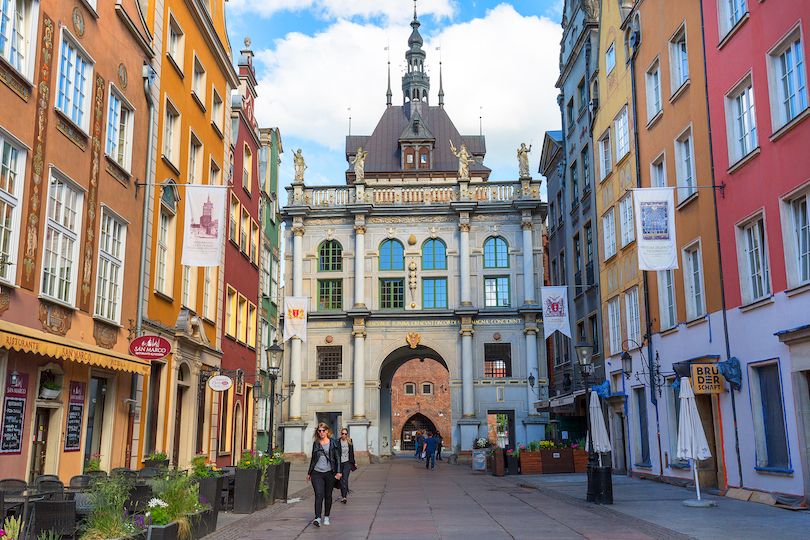
Set within the Royal Route, the Golden Gate is a historic Renaissance city monument that symbolizes the city’s resilience and grandeur. Constructed between 1612 and 1614 as part of the fortifications surrounding the Old Town, it replaced the Brama Długouliczna, a previous gothic gate dating back to the 13th century.
The gate served as a ceremonial entry point to the city and is renowned for its distinctive golden ornamentation. It was designed in a Dutch Mannerist style by an architect called Abraham van den Blocke and built under the supervision of Jan Strakowski. It features intricate sculptures and allegorical figures, which create a captivating facade. You’ll find it adjacent to the Brotherhood of St George building, which is another late-gothic structure.
5. Waterfront & Crane
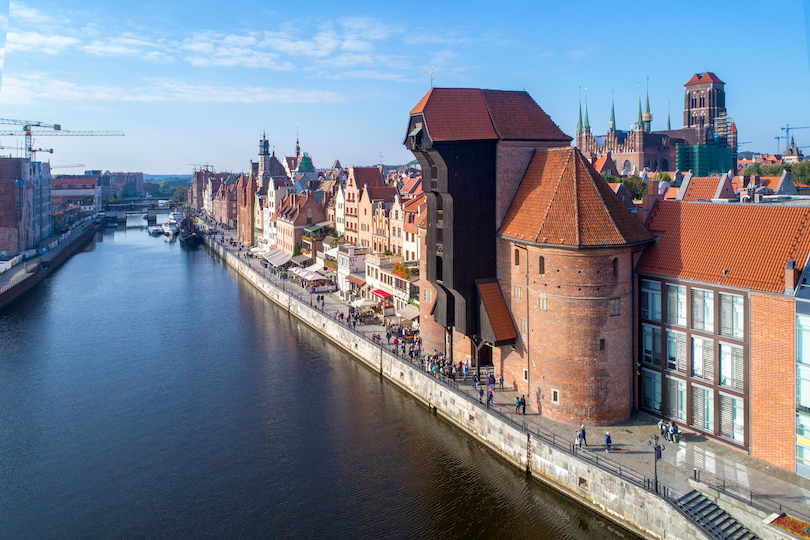
Located along the Motława River, the waterfront is a picturesque area known for its beautiful architecture and vibrant atmosphere. It is lined with colorful, restored buildings that reflect the city’s rich maritime history and its role in the Hanseatic League during the Middle Ages.
Soaring above the busy waterfront is the Gdańsk Crane (Zuraw), an enduring symbol of the city. Dating back to at least 1367, when it was first mentioned in print, it represents a fading link to the city’s great trading age.
Over the years, the crane has had its fair share of adversity. Its original structure burnt down in 1442, while 80% of its rebuild was destroyed in the Battle for Gdansk in 1945. However, it was painstakingly put back together over several decades after the war, rendering it the only fully restored structure of its kind anywhere on the planet.
The crane is a stunning sight from the outside, but as it forms part of the National Maritime Museum, inside, it features fascinating exhibitions on maritime trade and history.
4. St. Mary’s Church
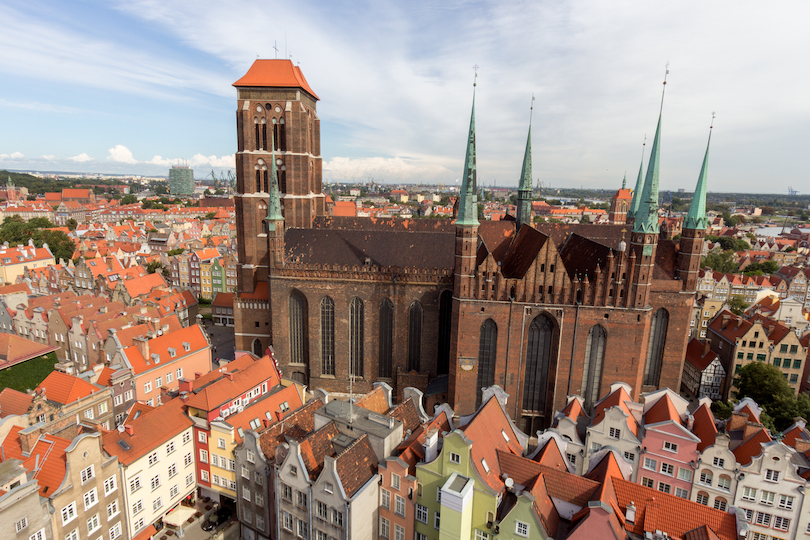
Officially known as the Basilica of the Assumption of the Blessed Virgin Mary, St. Mary’s Church is an important place of worship.
Located in central Gdansk, this magnificent brick gothic catholic church is notable for being one of the three largest brick churches in the world. It also witnessed the signing in 1648 of the Peace of Westphalia.
Towering over the city’s skyline, the church was funded by the affluent Hanseatic League and was conceived to reflect Gdansk’s prosperity. Overall, the church boasts remarkable features, including its towering spire, which showcases superb views of the surrounding cityscape.
Meanwhile, its interior comprises intricate stained glass windows, ornate altars and a fabulous astronomical clock that is very Insta-worthy.
3. European Solidarity Centre
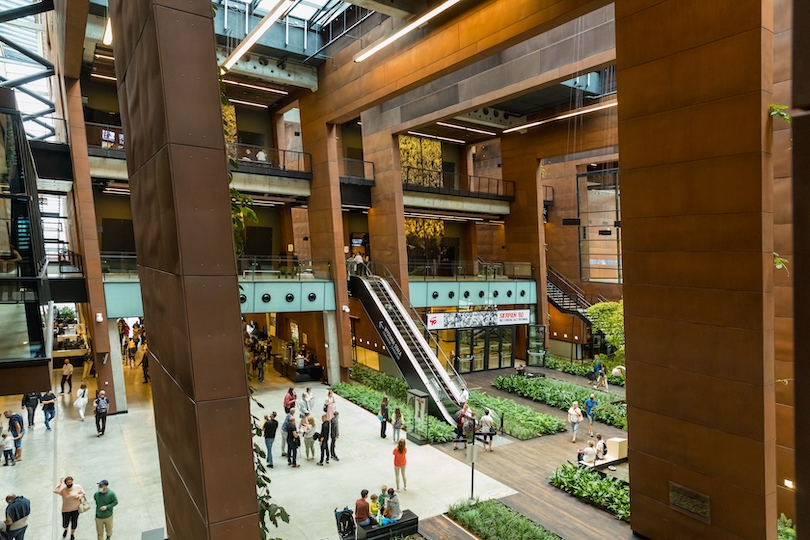
People of a certain vintage will remember the role the Solidarity movement played in overthrowing communism in Eastern Europe .
Paying tribute to this triumph, the European Solidarity Centre was established in 2014 at the historic Gdansk Shipyard, where the movement was born in the 1980s.
Visitors to the European Solidarity Centre can explore interactive exhibitions, multimedia displays, and artifacts that chronicle the history of the movement. Notably, the iconic Gate No. 2, where Lech Walesa led the shipyard strikes, remains a powerful symbol of this transformative period.
Acting as a cultural, historical and educational hub, the museum showcases the struggle for workers’ rights. It features fascinating exhibits of personal stories and documents that convey the resilience of the human spirit.
2. Museum of the Second World War
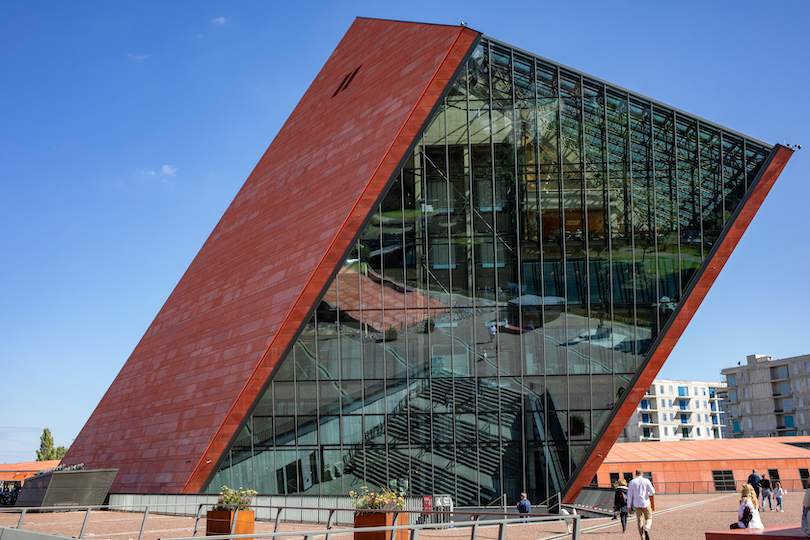
Opened in 2017, the Museum of the Second World War is a comprehensive institution dedicated to exploring the global impact of World War II. It aims to provide a nuanced perspective on the conflict by emphasizing its social, political and cultural dimensions.
Whilst there, you will be able to observe multimedia exhibits, artifacts, and personal testimonies that offer a profound understanding of the war’s complexities. The museum explores not only the military aspects but also the civilian experience, resistance movements and the post-war reconstruction period.
Exhibits include a vast collection of photographs, documents, and immersive displays that depict the war’s profound impact on individuals and societies. Ultimately, it is a poignant educational resource that promotes dialogue on the significance of this pivotal period in history.
1. Długi Targ
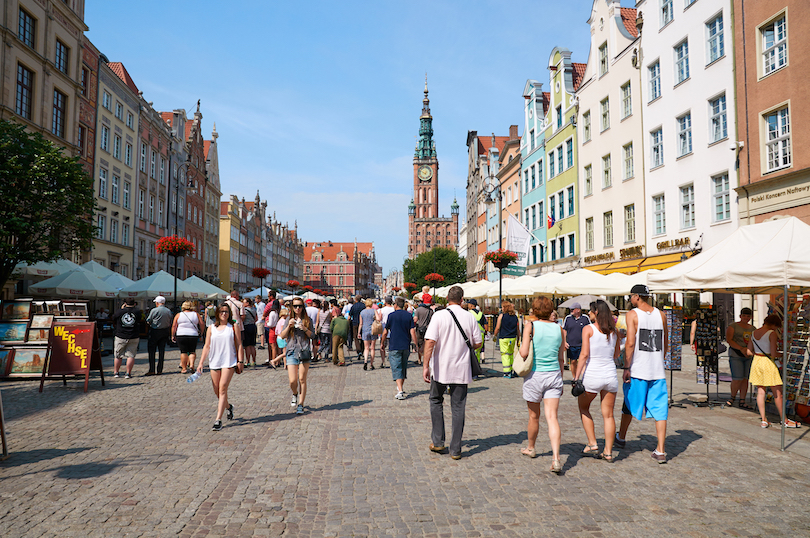
For most visitors to Gdansk, the Długi Targ, or Long Market, is top of their list of places to visit.
Situated between the Green Gate and the end of Ulica Długa, this iconic market square forms part of the city’s historic old town. It dates back to the 13th century and is renowned for being a center of civic and commercial activity. It was also once a place where the executions of heretics, criminals and witches took place.
Lined with picturesque, pastel-hued buildings that are adorned with ornate facades, The Neptune Fountain, the iconic Artus Court, and the Green Gate are key landmarks along Long Market. So, you will no doubt spend a lot of time here. There are also plenty of cafes, restaurants, and shops to browse, as well as lots of places to sit and soak up its atmosphere.
Best Time to Visit Gdansk
While July and August are by far the busiest and most expensive months, there are plenty of fun events to attend. Some of the biggest include the Mystic Festival for metalheads and St. Dominic’s Fair; a rather more traditional affair! As the summertime is the rainiest period, make sure to bring a coat with you.
May, June and September still see a fair few visitors as temperatures range from 15 to 19°C (59 to 66°F), the perfect weather for sightseeing. Prices are also cheaper and there are fewer crowds. While October has some nice autumnal foliage to admire, Gdansk is already turning a bit dull and dark.
Outside of these months, tourist numbers drop drastically as the weather worsens and days grow shorter. Unless you come for its charming Christmas market in December, you’re best off waiting until spring comes to visit.
Where to Stay in Gdansk
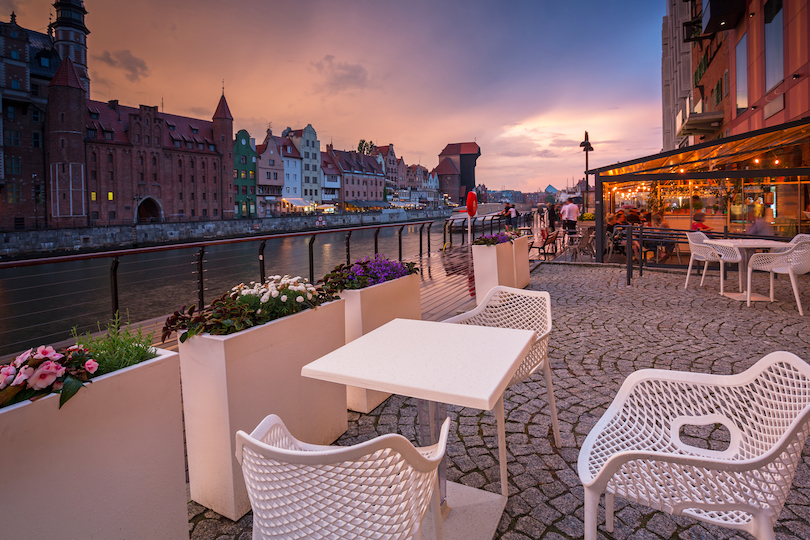
For most people who visit Gdansk, the Old Town is the best place to stay. It houses many of Gdansk’s main attractions, a good selection of restaurants, cafes and bars and a nice range of hotels.
One of the most popular establishments in the Old Town is the Hotel Hanza , which is located by the picturesque Motlawa River and not too far from the Gdansk Crane. It has its own restaurant with a terrace, a spa with three separate treatment rooms and a bar with a fireplace.
If you would prefer to stay somewhere different, you might want to procure accommodation on Kartuska Street. This road is the main thoroughfare in Gdansk and provides convenient access to districts like Siedlce, Jasień, Ujeścisko-Łostowice and Kokoszki.
In Sedlce, you’ll find the So Stay Hotel , which is a modern business hotel. To complement its comfortable, well-appointed rooms, it also has a restaurant and a 24-hour lobby bar.
How to get there
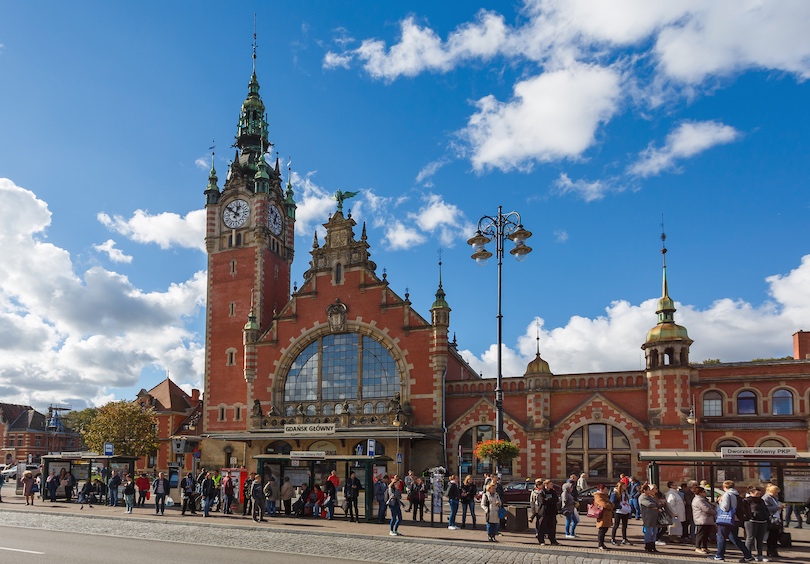
Gdansk is a city you can easily reach via air, rail or sea from most countries in Europe.
For those wanting to fly there, Lech Wałęsa Airport is the primary gateway, with several connections a day arriving from countries like England, Sweden, France and Germany. Once you arrive at the airport, you’ll find plenty of taxis, buses and car rental options to take you into the city center.
Alternatively, if you prefer to travel by train, Gdansk Glowny, the central train station, is serviced by plenty of domestic and international trains. Additionally, if you are already in Poland, you can drive along its network of highways and expressways, with major routes like the A1 motorway linking many towns and cities.
Due to its location on the Baltic Sea, Gdansk can also be accessed by ferry from Sweden and Finland, which is a very scenic way to travel.
Map of Things to do in Gdansk
Share this post:
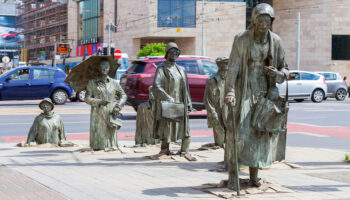
17 Best Things to do in Wroclaw, Poland
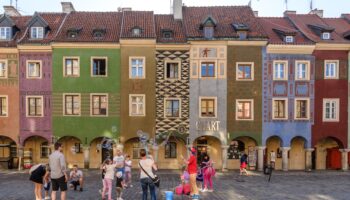
17 Best Things to Do in Poznan, Poland
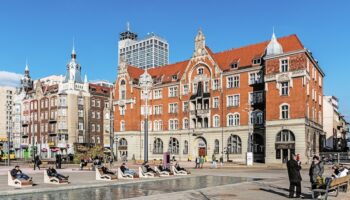
17 Best Things to do in Katowice, Poland

Europe’s Last Wilderness: The Ancient Forest of Bialowieza That Time Forgot
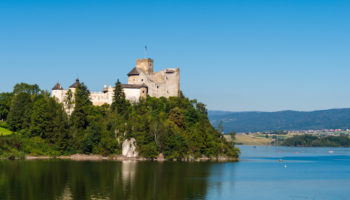
16 Most Beautiful Castles in Poland
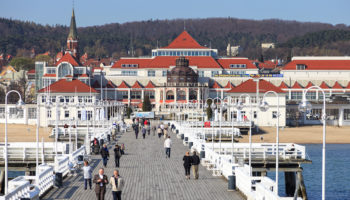
15 Best Cities to Visit in Poland
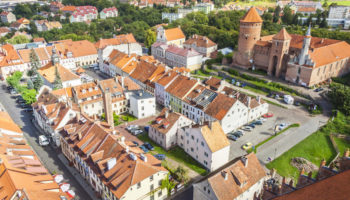
14 Stunning Small Towns in Poland
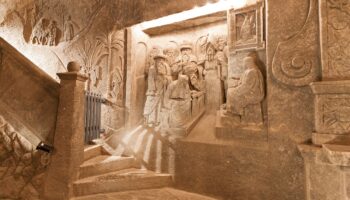
The Hidden World Beneath a Small Polish Town: Wieliczka Salt Mine
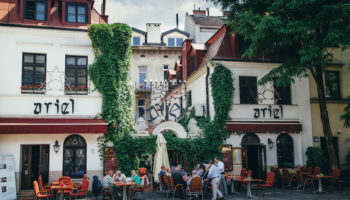
Where to Stay in Krakow: Best Neighborhoods & Hotels
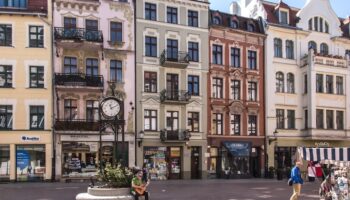
14 Best Things to Do in Torun, Poland
Reader interactions, leave a reply cancel reply.
Your email address will not be published. Required fields are marked *
This site uses Akismet to reduce spam. Learn how your comment data is processed .
- The Top 10 Things To...
The Top Things to See and Do in Gdansk, Poland

Situated on the coast of the Baltic Sea, Gdansk is Poland ’s principal seaport and one of its biggest tourist destinations. It boasts several important historical attractions, such as the Royal Way, famous promenade street of Polish kings, along with historic cathedrals, medieval ports and oodles of cool cafes.
St. dominic’s fair.
Hosting Saint Dominic’s Fair is definitely one of the longest of the city’s traditions. It was first established in 1260 by Pope Alexander IV and is still running today. The fair takes place for three weeks from the last Saturday of July. The main attraction is a huge market with local and foreign sellers presenting antiques, handmade goods and more. The market is accompanied by a series of cultural events such as street theatre, concerts, parades, sports events and competitions. Every year it attracts around 5 million people and about 1,000 artisans, merchants and artists.

The Royal Way

1. The European Solidarity Centre
Building, Museum
The European Solidarity Centre is a very new museum, situated in the Gdansk shipyard. However, it has already become one of the best tourist attractions in the city. It is spectacular in both its design and the exhibitions it contains. The Centre celebrates trades unions and their achievements, giving a lot of credit to the Solidarity movement in a series of thought-provoking exhibitions. The building is made of steel and its design is meant to resemble that of a ship, which makes it a worthwhile visit for all architecture lovers.
plac Solidarności, Gdansk, Poland

Gdansk Shipyard Railway | ©Adam Kuśmierz/Flickr
Mariacka Street
Ulica Mariacka is one of the most beautiful streets in Gdansk’s old town. It contains stunning architectural pieces as well as many souvenir stalls and stores. It is a must for any visitor to have a cup of coffee in one of the lovely little cafes scattered along the street and have a look in the many amber jewellery shops it’s known for. It’s a very romantic street, great for having a walk in the evening when all lit up, or a glass of wine in a spot like Literacka , surrounded by charmingly decorated, colorful old houses.

2. Dlugi Targ
Dlugi Targ (Long Market) used to be the street where the main city market was held, but now it has become a major tourist attraction. Among other objects of interest, it features Neptune’s Fountain, which, according to legend, once started spouting Goldwasser, the trademark Gdansk liqueur. The bronze statue of Neptune was made by Flemish artist Peter Husen at the beginning of the 17th century and is the oldest secular monuments in the country. The Golden House, a beautiful 17th-century building with a richly ornamented facade displaying 12 elaborately carved historical scenes can also be seen on Dlugi.
Długi Targ, Gdańsk

Gdansk Long Market | ©Robert Young/Flickr
The Shakespeare Festival
Gdansk Shakespeare Festival is an annual festival held by the Gdansk Shakespeare Theatre in the last week of July or the first week of August. It is an international event combining theatrical performances with artistic events, workshops and meetings with theatre directors. The event takes place in a Shakespearean theatre built on the historical site of a 17th-century playhouse where English travelling actors used to perform. It’s a must for all theatre lovers and widely recognised on the international theatre scene.

3. St. Mary's Church
Building, Church
St. Mary’s Church is a Roman Catholic church built during the 14th and 15th centuries, known for being the largest brick church in the world. The massive Gothic building takes center stage in the city and is an interesting architectural object both in its exterior and interior. One of the interior highlights is a huge wooden 15th-century astrological clock. It is strongly advised to climb the 400 steps to the top of the church’s tower, from where a beautiful view of Gdansk is revealed.
Podkramarska 5, Gdańsk, Poland , +48 58 301 39 82
4. The Abbots' Palace
Museum, Park
The Abbots’ Palace, located in the beautiful Oliwa Park, is a rococo artwork in itself. It is worth a visit not only for the beautiful surroundings of the park with its winding paths, relaxing ponds, huge hedges and an abundance of greenery, but also for what is contained inside. It is constituted of two parts, the ‘Old Palace’, built in the 15th century, and the ‘New Palace’, added in the first half of the 17th. It now contains the Department of Modern Art of the National Museum of Gdansk , along with a ‘Promotional Gallery’ dedicated to the exhibition of works by young artists.
Toruńska 1, Gdańsk, Poland , +48 58 301 68 04

Bonsai Trees, Oliwa Park | ©Nikoletta Fotti/Flickr
Sounds of the North Festival
This music festival , held in Gdansk every two years in July, is a good opportunity for every folk music enthusiast to get to know the traditional music of Poland and other countries of the Baltic region. There are ten countries represented in the festival each year: Lithuania, Latvia, Denmark, Ireland, Estonia, Greenland, Russia, Norway, Sweden and, of course, Poland. The festival invites performers to blend traditional folk music with contemporary sounds, in order to incorporate the genre into modern life and contemporary audiences.
Since you are here, we would like to share our vision for the future of travel - and the direction Culture Trip is moving in.
Culture Trip launched in 2011 with a simple yet passionate mission: to inspire people to go beyond their boundaries and experience what makes a place, its people and its culture special and meaningful — and this is still in our DNA today. We are proud that, for more than a decade, millions like you have trusted our award-winning recommendations by people who deeply understand what makes certain places and communities so special.
Increasingly we believe the world needs more meaningful, real-life connections between curious travellers keen to explore the world in a more responsible way. That is why we have intensively curated a collection of premium small-group trips as an invitation to meet and connect with new, like-minded people for once-in-a-lifetime experiences in three categories: Culture Trips, Rail Trips and Private Trips. Our Trips are suitable for both solo travelers, couples and friends who want to explore the world together.
Culture Trips are deeply immersive 5 to 16 days itineraries, that combine authentic local experiences, exciting activities and 4-5* accommodation to look forward to at the end of each day. Our Rail Trips are our most planet-friendly itineraries that invite you to take the scenic route, relax whilst getting under the skin of a destination. Our Private Trips are fully tailored itineraries, curated by our Travel Experts specifically for you, your friends or your family.
We know that many of you worry about the environmental impact of travel and are looking for ways of expanding horizons in ways that do minimal harm - and may even bring benefits. We are committed to go as far as possible in curating our trips with care for the planet. That is why all of our trips are flightless in destination, fully carbon offset - and we have ambitious plans to be net zero in the very near future.

Places to Stay
The best hotels in zakopane, poland.

Food & Drink
The best polish desserts you need to try.

Bars & Cafes
The best craft beer bars in gdańsk.

The Best Things to Do in Poland if You Love Vodka

Guides & Tips
10 facts you didn't know about warsaw's palace of culture and science.

The 10 Most Difficult Polish Towns to Pronounce

7 Secret Bars in Warsaw's Old Town

Restaurants
The best burgers in gdańsk.


The Best Bars in Zabrze, Poland

See & Do
The best things to see and do in zakrzewo.

The Best Polish Restaurants in Gdańsk

The Best 24-Hour Bars in Warsaw
Culture trip spring sale, save up to $1,100 on our unique small-group trips limited spots..

- Post ID: 394457
- Sponsored? No
- View Payload

Travel Guide to Gdańsk, Poland

Ra's Travel Guide to Gdańsk
Experience Gdansk's rich history, sip gold-flake vodka, and explore top attractions in this Polish gem; a travel guide to Gdansk.
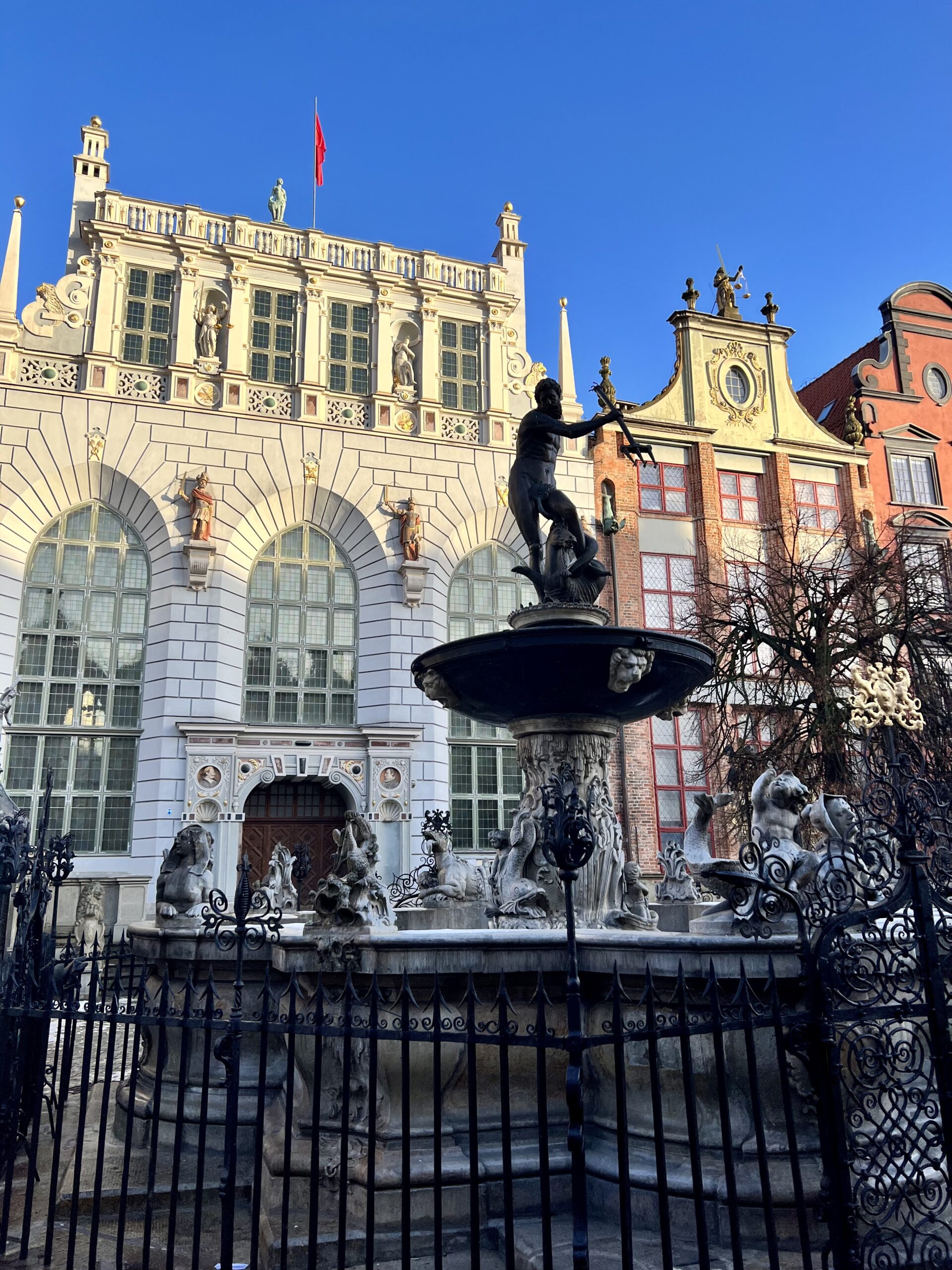
Gdansk, a city meticulously restored to its pre-WWII glory, offers a captivating journey through history. Nestled in northern Poland, it beckons travelers with its famous gold-flake vodka and its role as a stop on the Amber Road. Whether you seek history or modern delights, Gdansk has something for all ages and interests. Use this travel guide to Gdansk to help plan or navigate your trip!
Getting to Gdańsk, Poland: Transportation Options and Travel Tips
Traveling to and from Gdansk is a breeze with affordable train options (around $10 USD) connecting you to the city, conveniently located just a 10-minute walk from the Old Town. The FLXBUS is an economical alternative for traveling within Poland. Gdansk Lech Wałęsa Airport serves international and domestic flights, making it an ideal starting point for your Polish journey. For exploring beyond the city, consider renting a car, especially if visiting other parts of Poland, as mentioned in other parts of this travel guide to Gdansk.
To plan your route and transportation methods, use Rome2rio, a handy tool providing route combinations from anywhere.
Where to Stay in Gdańsk, Poland?
Numerous accommodations are scattered throughout Gdansk, with the Old Town being a prime location. Availability and prices vary by season. Book well in advance if you prefer staying in the Old Town.
During my visit, I secured a private apartment in the Old Town for just $20 USD per night. It was a fantastic find within walking distance of everything. Keep in mind that the Old Town can get lively on weekends, so pack earplugs if you're a light sleeper.
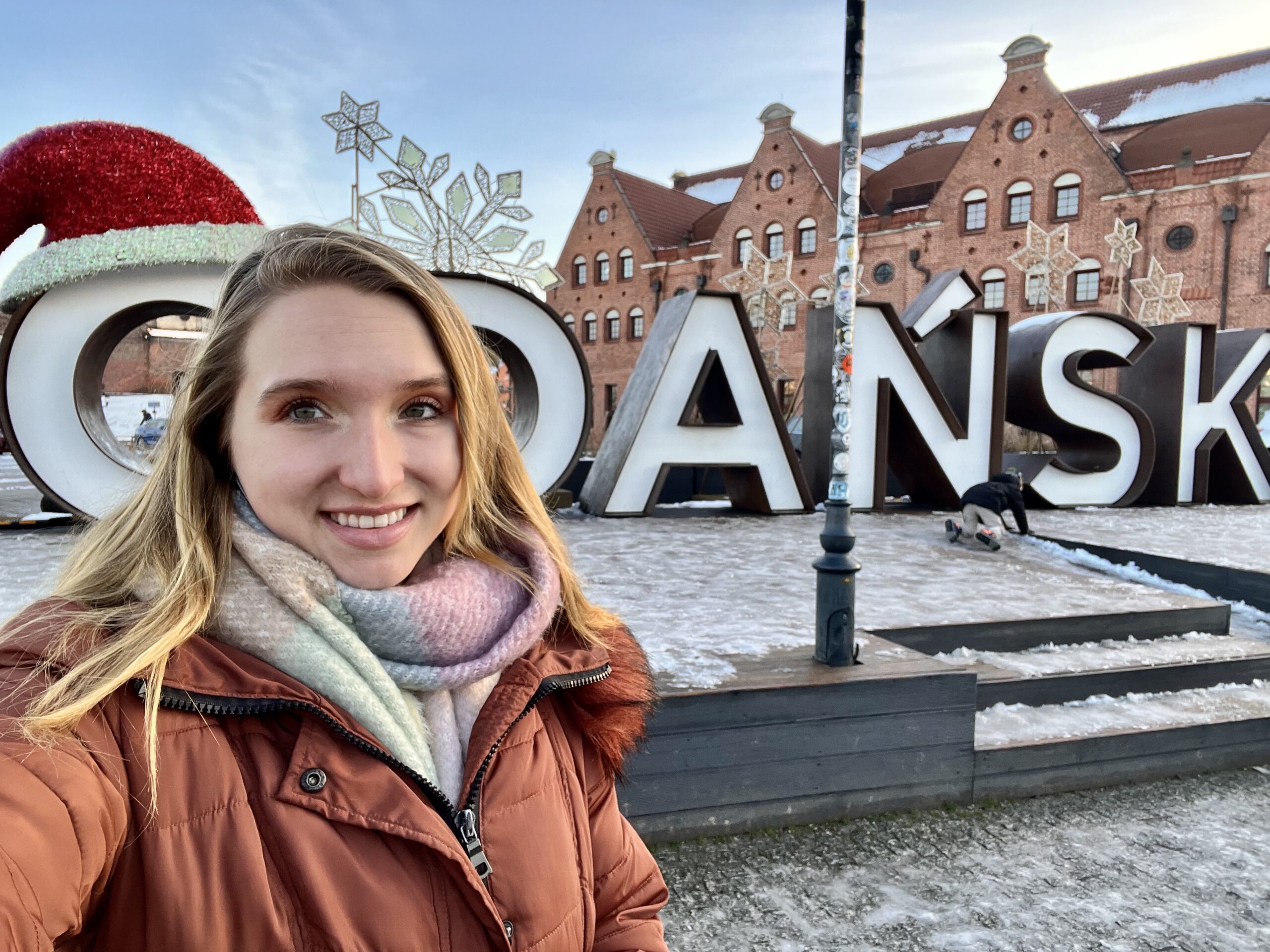
Guides to Poland
Getting around gdańsk, poland.
Cars can be rented from agencies at the city’s international airport or from other major cities in Poland. The traffic is rather minimal in Gdansk except for during commuter hours. The public transport in Poland is very clean and widespread, but renting a car is great if you plan on traveling around Poland and out into the more rural areas. It is important to note that 0.2% is the maximum blood/alcohol limit, so not even one drink if you’re driving.
Bus/Tram/Trolleybus
Local public transport is efficient and takes you around Gdansk and to nearby Gdynia. Tickets are available at stations and kiosks.
In Gdansk, you have the option of using both traditional taxi companies and Uber. The primary taxi companies operating in Gdansk include Neptun, Hallo, and Elite Airport Taxi. These taxis generally follow metered pricing, but it's advisable to request a fare estimate before entering the taxi and ensure that the meter is activated to avoid any surprises. This way, you can enjoy a reliable and transparent taxi service during your stay in Gdansk.
Bike/Electric Scooters
Explore Gdansk's bike-friendly streets with Lime or Bolt rentals, conveniently accessed through mobile apps. Make sure to have the apps downloaded and set up before you arrive.
Sightseeing on foot is not only budget-friendly but also offers unexpected discoveries. Wear comfortable shoes for a memorable city exploration.
What to Do in Gdańsk, Poland?
Historical walking tour.
Start your visit in Gdansk with a walking tour to help you plan your sightseeing and orient with the city. While there are many tour groups and agencies offering tours, my favorite are the free walking tours which are tip based. The guides are very well trained and do the walking tours as a passion project. Don’t forget to bring cash to tip your guide!
Stroll through this colorful and architecturally stunning part of the city. Despite its destruction during WWII, today it boasts cobblestone streets and iconic attractions like the Gdansk sign, Golden Gate, and Neptune Fountain.
Main Town Hall
Located near Neptune Fountain, the town hall houses the Gdansk History Museum (free on Tuesdays) and offers panoramic views from its tower.
St. Mary's Church
Home to one of the world's oldest celestial clocks, the church's tower offers a unique aerial view of the city after climbing 408 steps.
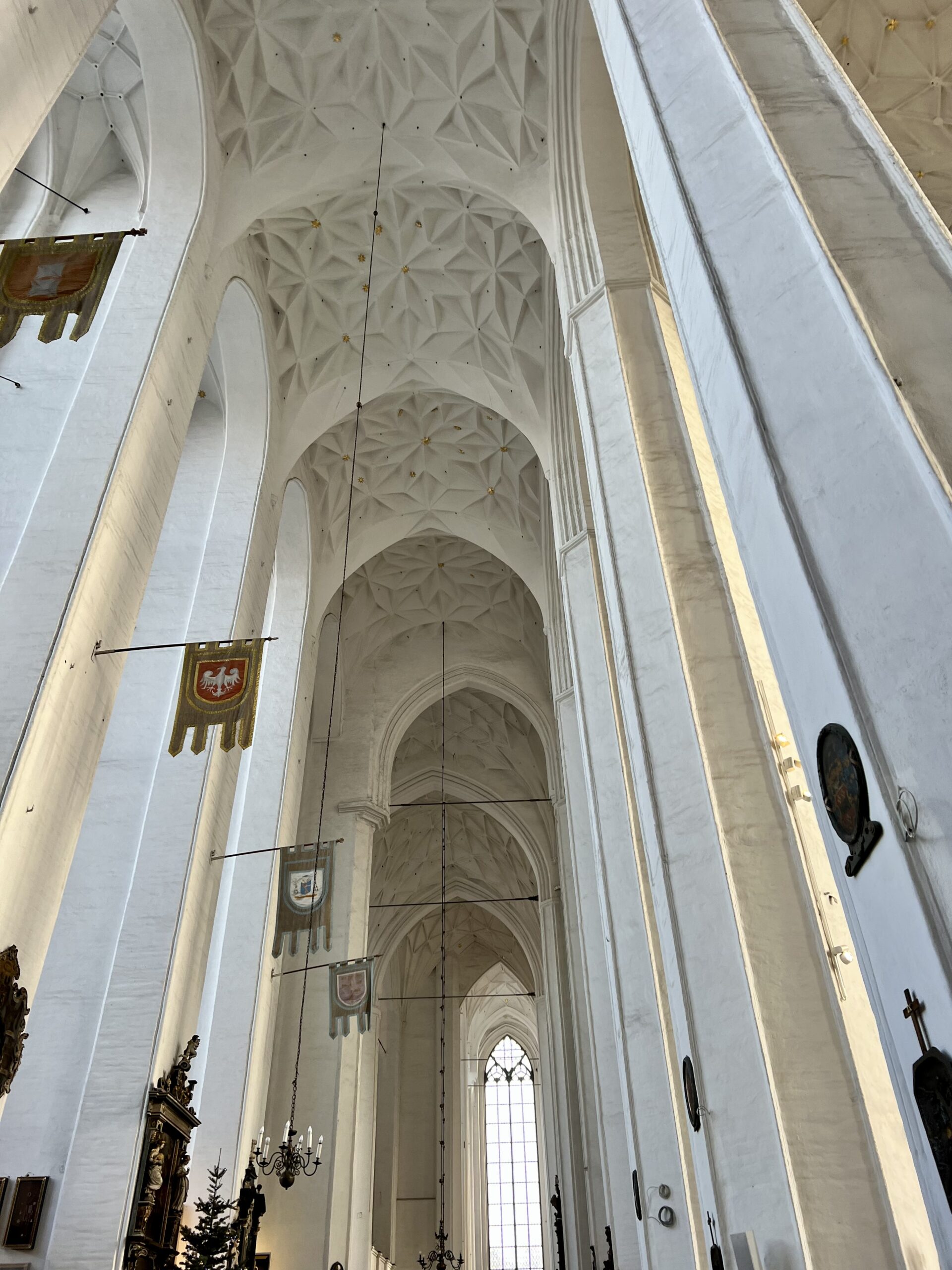
Mariacka Street
If you have a penchant for purchasing amber, you've come to the right place in Gdansk. Along Mariacka Street, you'll find amber vendors lining both sides of the street, offering unique jewelry pieces you won't come across elsewhere. Besides shopping for amber, this charming street also features several delightful cafes and spots where you can indulge in a glass of wine while taking in the stunning architectural beauty of the area. It's a perfect combination of shopping, relaxation, and admiring the city's architecture all in one place.
St. Bridget's Church
Marvel at the beautiful amber altar, a masterpiece 17 years in the making, showcasing 13 meters of amber (and still growing).
Museum of the Second World War
The museum opened its doors in 2017 and provides a comprehensive exploration of WWII's impact on Poland and the events that precipitated the war. It offers an extensive and in-depth experience, so plan to dedicate at least three hours to fully immerse yourself in its exhibits and historical insights. For added convenience, consider purchasing your tickets online in advance to skip the lines and make the most of your visit to this remarkable museum.
Amber Museum
Discover the Baltic region's amber heritage and Poland's role in the Amber Road. The museum showcases various types of amber and artifacts.
Explore this neighborhood adorned with over 50 murals and the Monumental Paintings Collection. Use this map to locate all the artwork: Zaspa Map .
Polish Post Office Museum
During the Nazi invasion of Gdansk, the Polish Post Office became a target and was attacked while Westerplatte was under assault. This harrowing siege endured for a grueling 17 hours before the defenders met a tragic fate and were executed. Adjacent to the museum dedicated to this historic event, you'll find a solemn memorial wall paying tribute to those who lost their lives during this significant chapter in history. It stands as a poignant reminder of the sacrifices made during that time.
European Solidarity Center
Commemorate the Solidarity movement's pivotal role in Poland's transition from communism. Tour the center or use an audio guide to delve into this important part of Polish history.
Gdansk, Poland, a city lovingly restored from its wartime devastation, invites travelers to embark on a captivating journey through history, culture, and unforgettable experiences. From the charm of the Old Town's cobblestone streets to the poignant reminders of WWII's impact, Gdansk offers a rich tapestry of attractions and activities. Use this travel guide to Gdansk to plan your trip!
The majority of locals speak English, but it is helpful and appreciated to know some basic phrases in Polish.
My Playlist for Gdańsk, Poland
"Jestem" by Kamil Bednarek
"Sto lat" (One Hundred Years)
"Lubię, kiedy patrzysz jak tańczę" by Taco Hemingway
"Kocham Cię jak Irlandię" by Edyta Górniak
"Dwa serduszka" by Wojciech Gąssowski
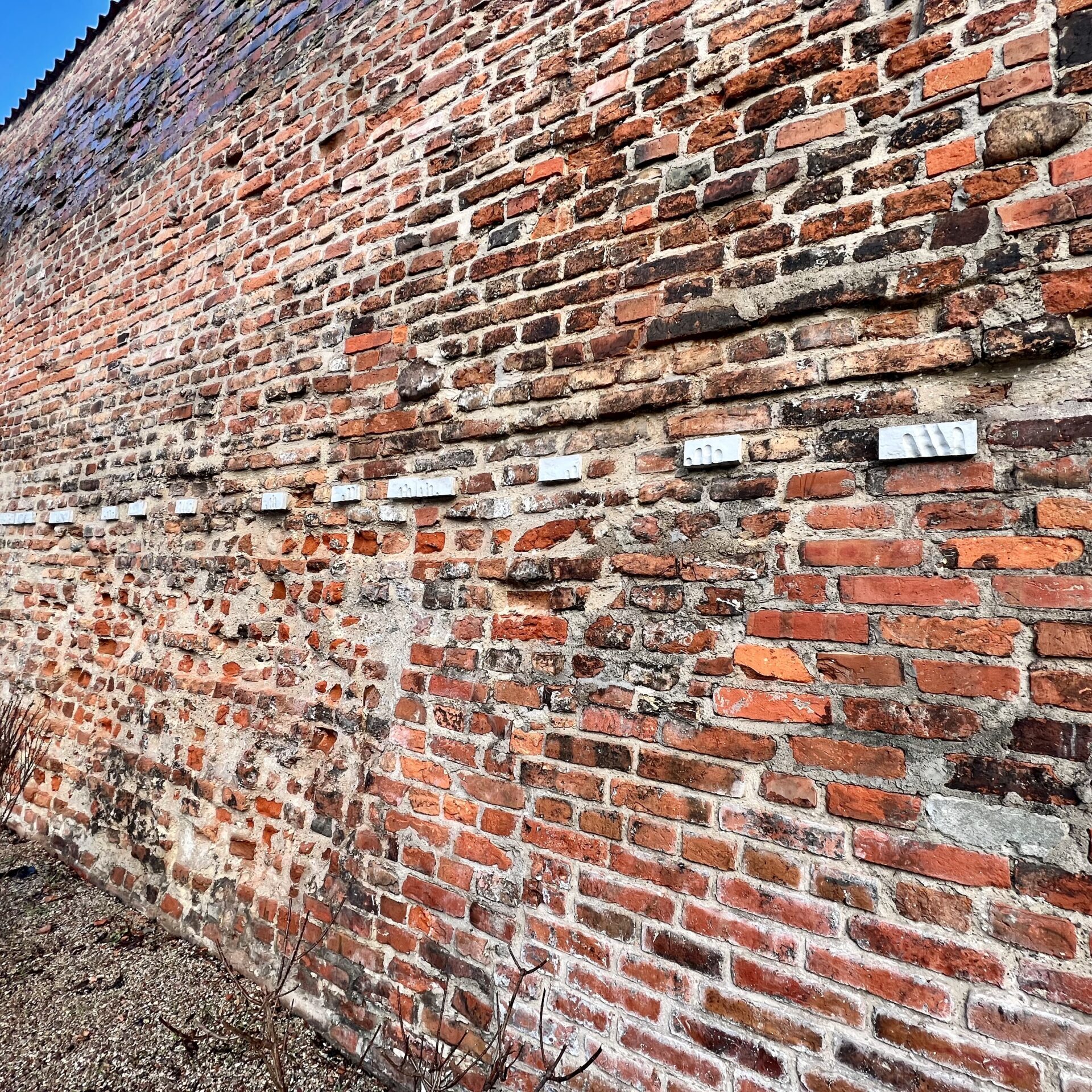
Recommended Reads

Authentic Egyptian Souvenirs: Top 10 to Buy in Egypt
A trip to Egypt is a once-in-a-lifetime experience, so you’re most likely leaving room in the suitcase…

Best Places to Visit in Egypt: Top 5
Egypt is a bucket list adventure filled with historical treasures and insight into ancient civilizations. From crystal…
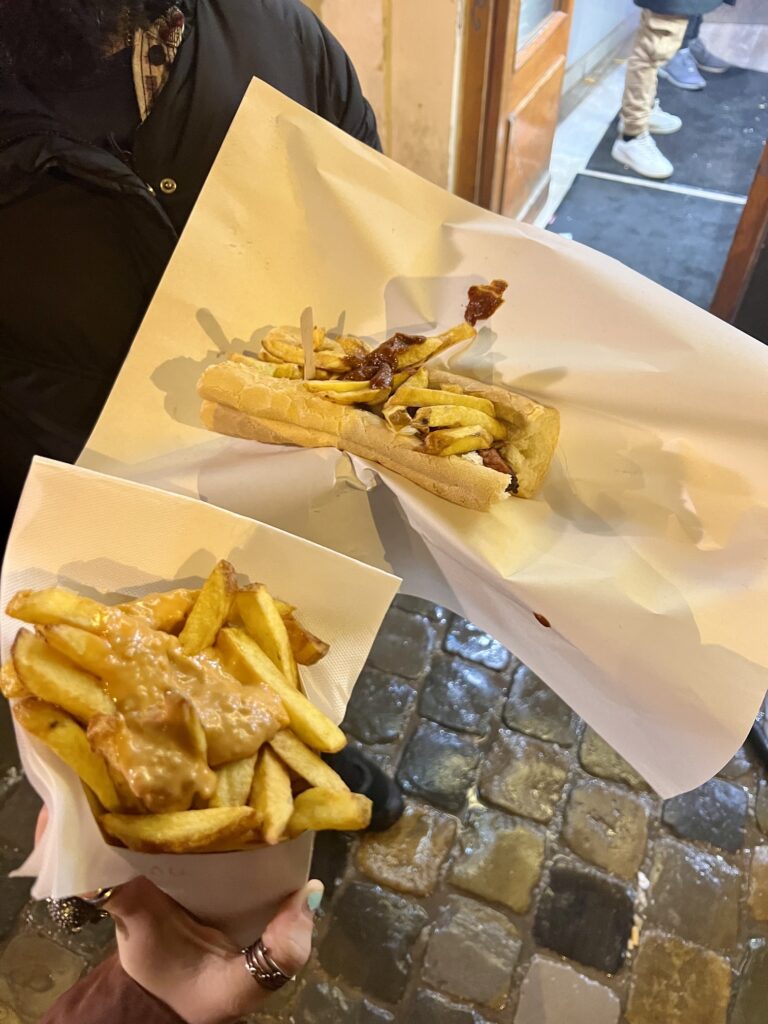
Best Places for Fries in Brussels- Top 10
Hungry and in Brussels? Look no further! Here are the top 10 best places for fries in…
Jetsetting Fools
Travel Far. Discover More. Spend Less.
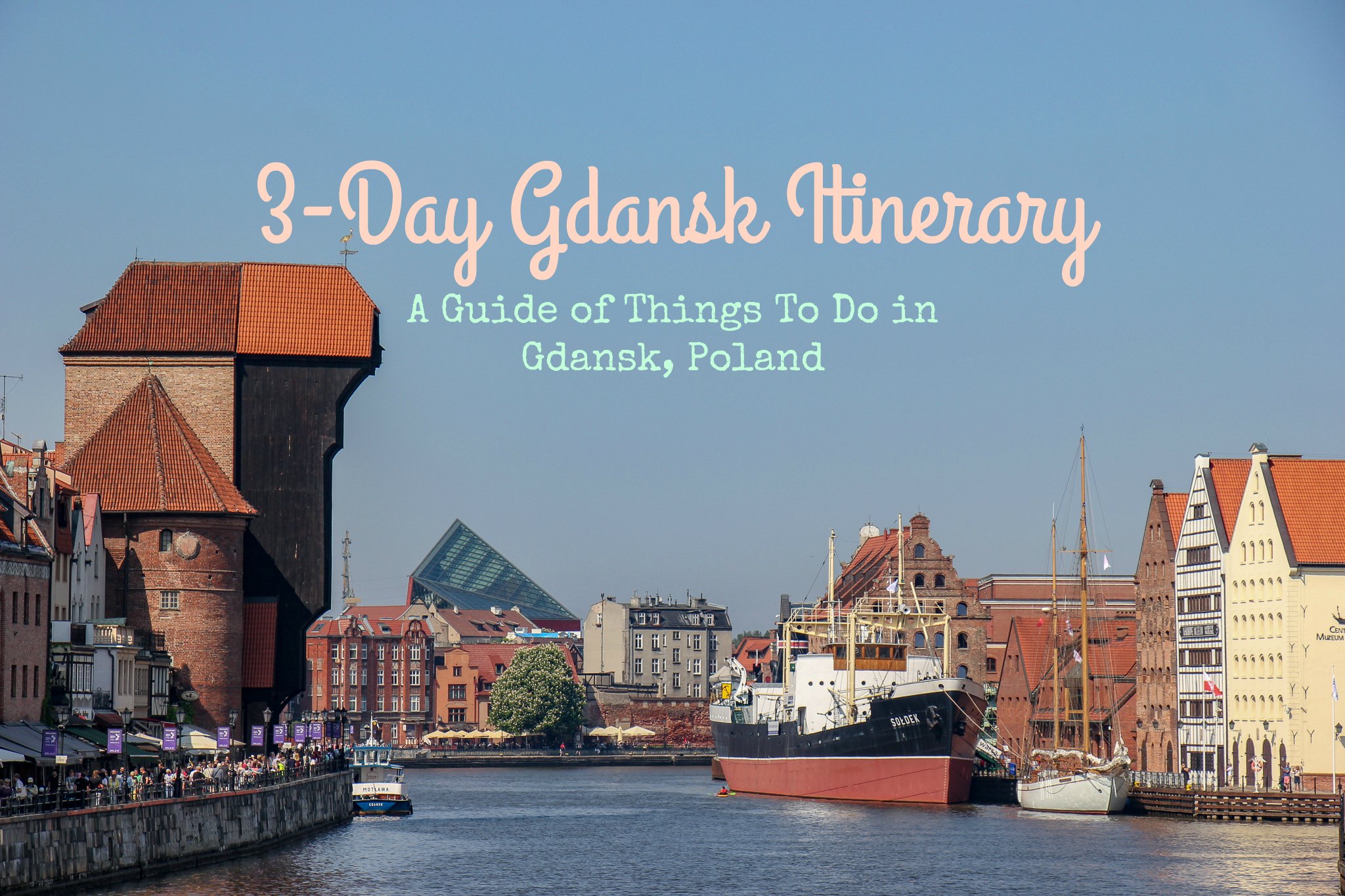
Things To Do in Gdansk, Poland: A Perfect 3-Day Gdansk Itinerary
Welcome to JetSetting Fools, here you will find our best travel tips for destinations worldwide. Some of the links on this site are Affiliate Links and if you use them to make a purchase, we may earn a commission. For more information, read our Disclosure Policy .
When we started planning our trip to Gdansk, Poland, we were surprised by the number of attractions and sights in the city. Stunning architecture, fascinating history, day trip destinations and savory cuisine all made their way onto our Gdansk To-Do list. In order to fit all of the top things to do in Gdansk into our trip timeline, we designed a perfect Gdansk Itinerary – and are happy to share it with fellow travelers!
Why Travel To Gdansk, Poland?
Many people ask us, “ Why visit Gdansk, Poland? ” Well, after visiting Warsaw and Krakow, we were in on the secret: Poland is incredible . Our time in Gdansk, Poland solidified the fact – the country is completely underrated as a travel destination!
Just like Warsaw and Krakow , what to see in Gdansk, Poland revolves around the city’s storied past, amazing architecture and fabulous museums. Unlike the two other Polish cities we have visited, there are unique Gdansk things to do; namely, visit the coastline on the Baltic Sea featuring miles of sandy beaches.
In our time exploring the city, we filled our days with the best things to do in Gdansk and created a 3-day Gdansk Itinerary to help other travelers experience the highlights as well.
About Our 3-Day Gdansk Itinerary

Our Gdansk 3 Day Itinerary includes the top things to see in Gdansk and the greater region. For each sight, we include a brief description and a link to more information.
At the end of the article, there are Gdansk tips for your trip, like how to get there, where to stay and options for the best Gdansk day trips. We also offer advice on how many days in Gdansk and what to pack for Gdansk trips.
Day-by-Day Itinerary Of Things To Do in Gdansk

Our list of the best things to do in Gdansk is organized in a day-by-day 3-day itinerary. This Gdansk travel blog post includes everything you need to plan your Gdansk vacation!
Save, Pin or Bookmark our Gdansk Itinerary so that you can plan your trip to Poland!
DAY 1 – Must-See Gdansk: Old Town and WWII Museum

On the first day of your 3 days in Gdansk, start by seeing Gdansk highlights in the Old Town then delve into the history of World War II at a state-of-the-art museum. End the first day of your Gdansk trip with a scenic view and a classic Polish meal.
Gdansk Walking Tour: The Royal Route

Kick off your trip with one of the Gdansk top things to do: Walk the Royal Route. Not only will it help get you acquainted with the city, but many of the tourist attractions in Gdansk are located along the route.
The Royal Route through the heart of Gdansk Old Town was once the path taken by kings. Today, the Royal Way is still the route for ceremonies and parades. We’ve outlined a Gdansk city tour that extends from Upland Gate to Green Gate – and we note the Gdansk tourist attractions that are found on along the way.
High Gate (Brama Wyzynna)

Start your walk at Upland High Gate, which was built in the 16th century as part of Gdansk’s fortifications. The Upland Gate now houses the Gdansk Tourist Information Office.
Prison Tower and Torture Chamber (Wieza Wiezienna)
Built in the 14th century, the Prison Tower and Torture Chamber were part of the original Gdansk city walls. When new walls were constructed in the 16th century, the building became the prison, court and torture chamber. Today, it houses the much more pleasant Amber Museum.
Golden Gate (Zlota Brama)
The 17th century Golden Gate leads directly onto Gdansk’s most popular street: Ulica Dluga. The gate features 8 figures representing Peace, Freedom, Wealth, Fame, Agreement, Justice, Piety and Prudency.
Long Street (Dluga)

The picturesque Long Street is the main thoroughfare through Gdansk Old Town. The pedestrian-only street, which had to be almost completely rebuilt after World War II, features colorful and ornately decorated facades.
Tall, slender buildings are found throughout the city, but the ones on Long Street are the most beautiful. Numerous cafes, bars, restaurants and ice cream shops line Long Street; strolling up and down Long Street with an ice cream cone in hand is one of the top Gdansk activities in the summertime.
Gdansk Town Hall (Rathaus)

On Long Street, at the opposite end from Golden Gate is the unmissable Gdansk Main Town Hall and its rising spire. The building dates to the 14th century and today houses the Gdansk History Museum. Visitors can climb to the top of the Town Hall Bell Tower for stunning views of the Old Town.
Long Market (Dlugi Targ)

Where Long Street ends, Long Market begins. The wider street dates to the 13th century and once was home to Gdansk’s most affluent citizens. Today, Long Market Gdansk is largely occupied by gossiping locals, gawking tourist and aspiring musicians.
Neptune Fountain (Fontanna Neptuna)

The historic Neptune Fountain dates to the early 17th century and stands proudly in front of the Artus Court. It’s an absolute must-see in Gdansk!
Artus Court (Dwor Artusa)

At Dlugi Targ 44 is the Artus Court (named after the legendary King Arthur). The building, which dates to the 14th century, was a place of meeting, socializing and entertainment for the noble and wealthy. Now, as part of the Gdansk History Museum, visitors can take a peek inside.
The Golden House
Just a few doors down from Artus Court is The Golden House at Dlugi Targ #41. Decorated with five statues – representing prudence, justice, strength, temperance and fortune (the one on the top of the building), the Golden House dates to the early 1600s and has been the residence of several mayors of Gdansk.
Green Gate (Brama Zielona)
The end of the Royal Route, the Green Gate marks the passage from Long Market to the Motlawa River. The gate was built in the 16th century as a royal residence, but no royalty ever lived there. Today, the National Museum resides in the Green Gate – activist and Polish President Lech Walesa used to have an office in the building, as well.
More Old Town Gdansk Sights
The Royal Route is the perfect place to begin sightseeing Gdansk, but there are other places to see in Gdansk Old Town. Continue your discovery using this list of places to visit in Gdansk, Poland.
St. Mary’s Basilica

Officially the Basilica of the Assumption of the Blessed Virgin Mary, the church is one of the top things to see in Gdansk, Poland.
Construction of the Catholic church began in the year 1343 and, today, it ranks as one of the largest brick churches in the world (it can accommodate 25,000 people!). The 15th century Gdansk Astronomical Clock stands inside the church. Rising as the tallest bell tower in Gdansk, the view from the top is truly remarkable!
Basilica of St. Nicholas

With a history that dates to the 12th century, the Basilica of St. Nicholas is one of the oldest churches in Gdansk. It is also one of the only churches not to sustain damage during WWII. Inside, beautiful baroque altars decorate the cavernous church.
The Crane (Zuraw)

As a symbol of the city, The Crane is one of the top Gdansk things to see. A port crane has existed on the same site as The Crane since as early as 1367. At a time, it ranked as the largest crane in the world. Suffering major damage during WWII, The Crane was reconstructed and became part of the Maritime Museum. Getting a look at The Crane is a must do in Gdansk.
Motlawa River Promenade (Dlugie Pobrzeze)

The promenade that follows the river at the edge of the Old Town, called Dlugie Pobrzeze, is one of the top Gdansk places to visit. Lined with restaurants and shops, the walkway provides views over the river and harbor. Several Gdansk boat tour operators dock along the promenade.
Mariacka Street
The pleasant Mariacka Street runs from St. Mary’s Basilica to St. Mary’s Gate, which leads to the river. The charming lane is lined with houses that have raised entrances and carved stonework. Many amber shops are located on Mariacka Street. If you are searching for where to go in Gdansk to buy amber products, this is your street!
Piwna Street

Running parallel to Long Street is Piwna Street. Once home to a local brewery, there are several bars and cafes located on the street that is home to some of the best Gdansk nightlife (more on Gdansk bars later in the article).
Gdansk Monuments

Throughout the Old Town there are several monuments and statues that decorate and commemorate events in Gdansk. While we wouldn’t recommend going out of your way to locate all the specific monuments, keep your eye out for these interesting monuments while exploring Gdansk.
- Four Quarters Fountain: The city of Gdansk was once divided into four quarters – Wide (Szeroki), High (Wysoki), Fish (Rybacki) and Ship (Kogi) – and the Four Quarters Fountain is located at the point where those districts came together (at the corner of Gwietego Ducha and Grobla I streets). Each quarter is represented by an impressive lion statue.
- Fahrenheit Monument: Daniel Fahrenheit, creator of the Fahrenheit temperature scale, was born in Gdansk in 1686. To honor him, a glass-encased thermometer sits on Dlugi Targ (opposite the Neptune Fountain).
Best Ice Cream Gdansk

Ice cream shops (called Lody) are found on every street in Gdansk – but not all ice creams are equal. We think there are two places that serve the best ice cream in Gdansk.
Paulo Gelateria uses recipes from the 2015 Polish Champion of Ice Cream to make unique flavored ice cream (try the creamy and delicious avocado ice cream). Another must try – and a place we actually prefer for both the ice cream and the cones – is Slony Karmel, where they make ice cream from natural ingredients.
Lunch: Milk Bar Gdansk (Bar Mleczny)

After spending the morning discovering the best things to see in Gdansk Old Town, get your first taste of true Polish cuisine by eating lunch at a classic Milk Bar.
Known to be inexpensive, the generous portions of ‘home cooked’ Polish dishes are served to the masses at cafeteria-style Milk Bars. Popular during the communist era, most Milk Bars have a daily menu (usually written on a chalkboard, no translations) and little decor. The two best Milk Bars in Gdansk are Bar Turystyczny and Bar Mleczny Neptun.
Bar Turystyczny is located in the northwest section of the Old Town and has an authentic feel to it. We waited in a line that stretched out the door for platters of schawoby (fried pork chop) and placek po cygansku (an omelet filled with tender beef and covered in sauce).
Located in the heart of the Old Town in the middle of Long Street, Bar Mleczny Neptun attracts a few more tourists and charges a bit more for their meals, but the establishment still retains the classic Milk Bar appeal. In fact, we think it is one of the best restaurants in Gdansk Old Town because there is outdoor seating right on Long Street, which is fantastic for people watching.
Granary Island
After lunch, continue your exploration of Gdansk must-see places and head to Granary Island. Located on the opposite side of the Motlawa River east of Green Gate, Granary Island was once the commercial center of Gdansk. An entire complex of granaries were built on the island to store goods brought in from afar by ships.
By the 17th century, Gdansk had more than 300 granaries – and boasted the largest harbor on the Baltic Sea. However, only three buildings survived WWII and the island was left in shambles for decades, only recently getting a facelift and now attracting tourists and locals alike.
Olowianka Island and Soldek

Next up on our list of Gdansk attractions is Olowianka Island. Located just north of Granary Island, Olowianka Island is home to the Central Maritime Museum, the Royal Granary and the Philharmonic building.
Docked in front of the National Maritime Museum is the gargantuan Soldek, the first steamship built in the Lenin Shipyards after the war. Converted into a museum, visitors a welcome to explore the ship’s interior.
Pro Tip: Let a Gdansk Tourist Guide Lead the Way
Above we outlined what to do in Gdansk for sightseeing in the city center. However, visitors can get a personal introduction on a tour with a local Gdansk tour guide.
Private Walking Tour
Tour the Royal Route on a private tour with a knowledgeable guide – Book it here!
Sightsee Gdansk on two wheels on a popular city biking tour – Find out more!
Tour Gdansk at your own pace – but with an Audio Guide Tour that delivers more Gdansk facts and information – Get it here!
Free Walking Tour Gdansk
Visitors can join a Free Gdansk Walking Tour – just keep in mind that these are tip-based tours in Gdansk.
Museum of the Second World War

Visiting the Museum of the Second World War is one of the top Gdansk, Poland things to do. The state-of-the-art museum details the events of World War II, which began on September 1, 1939 when Germany invaded Poland at Westerplatte (less than 6 miles from Gdansk Old Town).
Both interactive displays and personal items are featured in the museum that tells the story of the horrific war. The exhibits are educational and gripping.
We highly recommend renting an audio guide during your visit to the museum – as the information presented can be slightly overwhelming. We spent four hours at the museum (and could have stayed longer) and think it is one of the best things to do in Gdansk.
Information on opening hours and tickets can be found on the Museum of the Second World War official website .
Polish Post Office and Memorial
Continue learning about the impact of the war on Gdansk with a trip to the Post Office. Although some people may think this is one of the unusual things to do in Gdansk, WWII buffs will appreciate its place in history.
At the same time Westerplatte was being attacked, German troops were also targeting the Polish Post Office near the Gdansk Old Town. The workers held off the Nazis for 17 hours before surrendering. In front of the post office there is a large memorial – and behind the post office is a moving display of the postal workers who were captured and shot to death on site.
Gradowa Hill

After a full day of history, climb up to Gradowa Hill to have some time to reflect…and to take in the great views over Gdansk.
West of the Old Town, across the railroad tracks, Gradowa Hill is part of an old fort complex. Buildings half-covered in earth display exhibits that are part of the Hewelianum Center Museum and at the north end of the park is the 50-foot-tall Millennium Cross.
Following one of the trails to the top of Gradowa provides panoramic views of Gdansk and the shipyards – and is a fabulous place to watch the sun set on the Old Town.
Dinner: Pierogarnia Mandu Centrum

For dinner on your first of 3 days in Gdansk, eat at one of the best pierogi restaurants in Gdasnk, Pierogarnia Mandu . We liked the pierogis so much, we ate here twice! The large variety of pasta dumplings (which are created by hand) can be served boiled or baked. We tried – and loved – both.
Pro Tip : Try the craft beer (bottled) made special for Mandu by Brewery Bytow.
Polish Craft Beer in Gdansk

With your belly full of delicious pierogis, it is time to sample some locally produced craft beer – it’s one of the best things to do in Gdansk at night.
Among the many reasons we have fallen head-over-heels for Poland is their superb production of craft beer. Gdansk has a hefty number of multitaps – aka craft beer bars – that boast excellent Polish craft beer on draft.
Bar Guide Gdansk

Use our Gdansk pub guide to help navigate your way to the best craft beer – and the best bars in Gdansk!
Café Lamus, Lawendowa 8 and Pulapka: These three bars, located at the east end of the Market Hall, are what we called “Craft Beer Corner.” With sidewalk seating in front of each bar, it was clear this is a top-spot for craft beer lovers to enjoy a pint in the late afternoon or well into the evening. The atmosphere is similar in each of the small bars, but we found the staff to be especially friendly and helpful with recommendations at Café Lamus .
Labeerynt Multitap Bar Gdansk Old Town: The subterranean Labeerynt Mulitap sits inconspicuously beneath Polskie Kino Pub on Szeroka Street in the Gdansk Old Town. While the dimly lit space would be inviting in too hot or too cold weather, we enjoyed our beers outdoors at one of the patio tables.
Local Gdansk Breweries : There are a few local breweries in Gdansk, like Brovarnia and Browar PG4 , which brew beer on-site, but (from what we could tell) stick to the traditional beers of the region – light, dark and wheat – rather than the IPAs and other hop-forward beers we found at the multitaps.
Old Town Gdansk Map: Day 1 of Things To Do in Gdansk
Use this link to our Gdansk Old Town Map to find locations of our recommend sights!
DAY 2 – Day Trip to Sopot from Gdansk

On Day 2 of your 3-day Gdansk itinerary, travel north to the resort town of Sopot on a day trip from Gdansk for some seaside fun!
Visit Sopot, Poland
The quaint seaside town of Sopot is one of Poland’s top tourist destinations. Sopot, along with Gdansk and Gdynia, are part of the Tri-City Region. With only a few ‘sights’ the real reason to visit Sopot is for the sandy beaches and laid-back atmosphere. That said, in addition to the beach, we are highlighting what to see in Sopot, Poland in one day.
Getting to Sopot
How to get to Sopot from Gdansk is easy! Visitors can take a Gdansk to Sopot Train from the Gdansk Main Train Station or use the Gdansk-Sopot Ferry.
Gdansk-Sopot Train
Hop on an SKM train bound for Sopot and arrive in the city in 20 minutes flat. Trains run frequently, but check the Gdansk-Sopot train timetable at the station. Tickets for the train from Gdansk to Sopot (one-way) cost about 5.50zl ($1.25 USD).
Boat Trip Gdansk-Sopot
Alternatively, take the Gdasnk-Sopot boat. Find the Gdansk to Sopot ferry schedule here . They only run a few of boats a day and tickets cost 70zl.
What To Do in Sopot, Poland

Once you arrive in Sopot, set off on to explore the city, then relax on the beach. Our list of Sopot attractions are listed in order of a 1-Day Sopot Itinerary to help you best plan your time.
Monciak Street

There is no Sopot Old Town, but the main pedestrian street in Sopot is Ulica Bohaterow Monte Cassino – although the locals refer to it by its former name, Monciak. Strolling the length of Monciak is a must on your Sopot to-do list. Lined with restaurants, cafes and pubs, the street leads directly to Sopot’s famous pier.
Crooked House (Krzywy Domek)

Built in 2004, the Crooked House on Monciak can’t be missed. The design was inspired by a fairytale and the building is part of a shopping center – and is an interesting Sopot sightseeing attraction.
Sopot Pier (Molo)
Hands down, one of the best things to do in Sopot, Poland is walk on the pier. The Sopot Pier, which dates to 1827, ranks as the longest wooden pier in Europe – and extends a quarter of a mile into the Bay of Gdansk on the Baltic Sea. At the end of the pier there is a restaurant and marina, as well as the departure points for entertaining bay cruises. During the peak summer season, a ticket is required to enter the pier.
Lunch: Fishing Harbor

Located three-quarters of a mile south of the pier on the Karlikowo Shore is the Sopot Fishing Harbor. Fishermen sail out each day in traditional Kashubian boats and return mid-day, ‘beaching’ their boats right in the sand…hopefully with a fresh catch!
Hungry visitors can order platters of fresh or smoked fish for lunch at Bar Przystań. Alternatively, walk north from the Sopot Pier to Bulaj , a popular Slow Food restaurant right on the beach.
Sopot Beaches

Topping the list of Things To Do Sopot is visiting the beaches. To the north and south of Sopot pier are miles of wide, sandy beaches. Kick off your shoes and walk with the sand between your toes, take a dip or catch some rays. The sandy beach in Sopot is a place to relax and enjoy!
Dinner: Burgers or Pizza
When it is time for dinner, take a break from traditional Polish cuisine and join the local youth for a burger or pizza.
SurfBurger is a small Polish chain serving real beef burgers made of natural and fresh ingredients – and they are seriously good!
For pizza, try Prosto (Pizza i Piwo) , where they crank out delicious pizza pies in an easy-going atmosphere.
However, for an inexpensive ‘pizza’ (or after bar snack), get a zapiekanki (a half baguette with ham, mushrooms, cheese and ketchup). Our favorite zapiekanki stand is at the corner of Monciak and Jana Jerzego Haffnera.
Top Tip : Not in the mood for burgers or pizza? There are plenty of restaurants in Sopot on Monciak. Read reviews on the top-rated restaurants on TripAdvisor .
Polish Craft Beer in Sopot
Having a cold drink at the end of the day is naturally one of the top Sopot things to do. For us, that meant seeking out Polish craft beer.
There are a few places along Monciak that offer craft beer, but beer aficionados will want to make the effort to find Konsulat Dobrego Piwa , a craft beer bar just outside the Sopot town center. The small, cozy bar features eight taps of craft beer and a fun beer garden.
Sopot Map: Day 2 – Gdansk Day Trip to Sopot Activities
Use this link to our Sopot, Poland Map to locate our recommended activities for Day 2.
Day 3 – Westerplatte and/or Oliwa and Solidarity Museum

On Day 3 of your 3 Days in Gdansk, shop, take a short day trip and then spend the afternoon at the Solidarity Museum.
Gdansk Market Hall

Start your shopping at the Market Hall – one of the top Gdansk things to see and do. Built in the late 1800s, there are three levels inside the Market Hall in Gdansk – along with unearthed discovery of a Romanesque church.
The Green Market (fresh produce) stalls overflow onto the plaza to the south of the Market Hall (where you will also find an underground archeological museum).
The market is a great place to sample local food – and to purchase items for an afternoon picnic lunch. The kabanos (Polish smoked sausages) and fresh fruit are popular picks!
Pro Tip : Paczki, Polish donuts, are a must-eat when in Gdansk! Eat a sugary breakfast of Gdansk donuts from Stara Paczkarnia. Located on the north side of the market, the fresh donuts at the corner kiosk and cost less than $1 USD. We recommend the chocolate cream-filled paczki (czekolada).
Half-Day Trips from Gdansk: Westerplatte or Oliwa
The rest of your morning will be spent on what to see around Gdansk on a quick trip. Choose between one of these trips from Gdansk: Westerplatte or Oliwa.
Why Visit Westerplatte from Gdansk?

If you are visiting Gdansk to learn more about the history of WWII, then Westerplatte is where you should spend your morning. The Westerplatte peninsula is known the world over as the site where World War II officially began on September 1, 1939.
When the Polish military fort on Westerplatte came under attack by Nazis, a battle ensued that lasted seven days. Although they surrendered, the 7-day resistance of the Polish soldiers, who were severely outnumbered and under-armed, gave hope and inspiration to the people of Poland.
Today, the Polish Coast Guard occupies part of the peninsula, but visitors can learn more about the events that transpired on Westerplatte in a small museum (Guardhouse Number 1), as well as on informational plaques located along the well-marked route.
Getting to Westerplatte
Without a car, there are three options to get from Gdansk to Westerplatte: boat, bus, bike.
- Gdansk Boat Trip to Westerplatte: Cruise from Gdansk on a ferry or tourist boat to Westerplatte. Check timetables at the docks, as they vary by season. Note: The Gdansk to Westerplatte boat was our first choice of transport, but a lost-in-translation of the ferry boat schedule had us using the bus instead. If you intend on taking the Gdansk-Westerplatte boat, we recommend confirming the schedule in advance.
- Bus from Gdansk to Westerplatte: Bus 106 transports passengers from Gdansk to Westerplatte in about 30 minutes.
- Bike from Gdansk to Westerplatte: There are a few bike rental shops in Gdansk. Rent a bike and pedal your way to Westerplatte following this route.
- Private Tour to Westerplatte: Visitors who want door-to-door transport and the expertise of a local guide should book a tour from Gdansk to Westerplatte. Find out what’s included.
Sights at Westerplatte
If you make the day trip from Gdansk to Westerplatte, there are a handful of must-see sights you won’t want to miss.
Monument to the Defenders of Westerplatte: The 82-foot-tall granite Monument to the Defenders of Westerplatte stands on a 72-foot hill, making it visible from afar and nearly impossible to miss.
Nowy Port Lighthouse: Dating to the late 1800s, the lighthouse (which was modeled after a lighthouse on Lake Erie in Cleveland, Ohio ) was fitted with a Time Ball to aid in sailors’ navigation. However, what puts the lighthouse in the history books is the fact that at 4:45am on September 1, 1939, Nazi Germans (who had overtaken the lighthouse the previous night) fired the first shots at Westerplatte from the Nowy Port Lighthouse, thus beginning World War II.
Why Visit Oliwa?

Oliwa, a suburb that lies between Gdansk and Sopot, has its own fascinating history of a monastery, battles and peace treaties. Although rich in historic facts, the reason we visited Oliwa was simply to enjoy a hike in nature.
Getting to Oliwa

How to get to Oliwa from Gdansk is just as easy as getting to Sopot. Simply hop on a train from the Gdansk Main Station. The short train ride will get you to Oliwa in about 10 minutes.
Sights at Oliwa
There are not an abundance of Oliwa attractions – but just enough to fill a few hours of sightseeing and relaxing in nature.

Oliwa Park features tree-canopied walkways, pristinely manicured hedges, streaming water, hidden gardens and colorful flowerbeds. A few museums and the Oliwa Cathedral are also part of the Oliwa Park complex.
Oliwa Cathedral

Consecrated in 1594, the Oliwa Cathedral is striking both inside and out. Upon entering, visitors can see the entire length of the church and the decorative high altar, which is made to look like heaven with angels hovering above it.
However, it is for the organ which sits over the entrance, that many people visit Oliwa Cathedral. Built in the 1700s (over a period of 30 years), the organ has more than 7,800 pipes. Short 20-minute concerts are played several times daily.
Pacholek Hill

Rising to the west of Oliwa Park is Pacholek Hill. The forested area has several walking/biking trails, a few of which lead to a hill-top viewing platform that provides 360-degree views over Oliwa and to the sea.
Lunch: Picnic
Whether you decided to go to Westerplatte or Oliwa, find a spot with a view to enjoy the picnic you assembled at the Market Hall in the morning. Alternatively: there is a fast-food kiosk at Westerplatte and a restaurant in Oliwa Park.
After your leisurely lunch, make your way back to Gdansk to spend the afternoon at the Solidarity Museum.
Westerplatte or Oliwa…or Both?
We recommend the leisurely traveler choose between visiting Westerplatte or Oliwa. However, ambitious visitors could squeeze both into one day.
To do so, take the first 106 bus to Westerplatte (or the first ferry, both should depart about 09:30am, but check). Spend an hour at Westerplatte and be on the 11:20am bus to the Gdansk Main Station (Gdańsk Główny). From there, catch the next train to Oliwa and spend 2-3 hours in Oliwa.
This trip plan should allow for enough time when you return to Gdansk to visit the Solidarity Museum in the afternoon (hours vary by season, but in the summer, the museum stays open until 7pm on weekdays and 8pm on weekends).
Solidarity Museum at the European Solidarity Centre

The Solidarity Museum is one of the Gdansk top attractions – and, in our opinion, a Gdansk must see sight. The permanent exhibition at the European Solidarity Center details what led to the formation of Solidarity and its impact on Poland.
Solidarity – or Solidarnosc – is a Polish trade union that formed in August 1980 in opposition to the working conditions at the Lenin Shipyards. The name, Solidarity became a social movement and many people attribute the movement to be the beginning of the fall of communism in 1989.
Sitting in front of the museum is the Monument to the Fallen Shipyard Workers of 1970. The three soaring steel crosses stand in memory of the workers who lost their lives in the riots.
Dinner: Pyra Bar

Load up on more Polish carbs with a final meal at Pyra Bar, a restaurant featuring incredible potato dishes. With every dish dedicated to the tuberous, starchy vegetable (in the form of casserole, potato pancake or baked potato), it might sound bland – but we can assure you, it’s not! Glorious, caloric amounts of cheese and meat are combined with potato in perfect platters of comfort food!
Piwna Street Bars
After three days of sightseeing in Gdansk, end your time at the popular Old Town bars on Piwna Street, which is a hot spot for Gdansk nightlife. You could even create your own pub tour in Gdansk, using our recommendations below.
- Jozef K – a unique, retro-themed bar with a nice variety of beer.
- Pub Red Light – quirky and cozy bar with unique cocktails and craft beer.
- Flisak 76 – a cellar bar serving up hand-crafted cocktails.
- Wiśniewsk – if you’ve been to Piana Vyshnia in Lviv , Budapest or Brasov …this cherry liquor is likely familiar to you already!
Gdansk Tourist Map: Day 3 Gdansk Sightseeing
Use this link to our Gdansk City Map to find the sights recommended for Day 3.
Gdansk: What To Do – More Tips for your Trip
Above we outlined what to visit in Gdansk in 3 days. However, if you are still looking for ideas of things to do in Gdansk, we have a few more tips!
Gdansk Cruise
One of the top things to do in Gdansk is to set sail on a Gdansk river cruise for an afternoon of fun. There are a few boats to choose from, but one of the top fun things to do in Gdansk is to spend an afternoon on the Pirate Ship Cruise.
More Day Trips from Gdansk
Want to know what to do around Gdansk? We’ve already listed our favorite day trips from Gdansk, but there are more things to do near Gdansk.
Visit Gdynia, Poland
Gdynia is the northern outpost of the Tri-City Region. Originating as a modest fishing village, Gdynia is now a modern seaport town. Search for things to do in Gdynia on TripAdvisor . Another one of the fun things to do in Tricity Poland is to join a tour of the Region and see the highlights of Gdasnk, Sopot and Gdynia in one day!
Malbork Castle
Just a train ride from Gdansk is the town of Malbork and the famous Malbork Castle. Built in the 13th century by Teutonic Knights, the Medieval castle is the largest brick castle in the world. Private tours to Malbork Castle can also be arranged.

Gdansk: How Many Days
Determining how many days to spend in Gdansk will depend on your interests, budget and overall trip plans. Personally, we found the city to be fascinating and beautiful – and easily filled our Gdansk vacation with sightseeing, feasting and exploring. We think 3 days in Gdansk is just enough time to get a feel for the city.
Above, we detailed what to do in Gdansk, Poland in three days. But what if you have more or less time? No worries! We have outlines for where to go in Gdansk Poland in 1 day, what to do on a weekend in Gdansk and how to visit Gdansk, Poland in 5 days.
What to See in Gdansk in One Day
Trying to see Gdasnk in one day is tough! In fact, some travelers may wonder, “Is Gdansk worth visiting for just one day?” – and we absolutely think it is!
While 3 days in Gdansk is best, if one day in Gdansk is all you have, then we recommend making the most of it! To create an ideal 1-Day Gdansk Itinerary, we think it is best to simply follow Day 1 of our Gdansk, Poland things to do.
2 Days in Gdansk: Things To See and Do
While two days in Gdansk is still not enough time to see all of the highlights, it allows plenty of time to explore Gdansk. To plan a Gdansk weekend trip, we recommend following Day 1 of our Things to do Gdansk outline, then combining the best of Gdansk attractions from Days 2 and 3 into a single day.
For example, we would take a half day trip to Sopot, Westerplatte or Oliwa (depending on interests) and then spend the afternoon of Day 2 at the Solidarity Museum.
4 Days in Gdansk: What To Do
We’ve already outlined an ideal trip for three days in Gdansk. So, on the last day, we recommend taking a day trip to Malbork. However, visitors could also opt to split their time between Gdansk and Sopot. Rearrange your 4 day Gdansk Itinerary so that you visit Gdansk in 2 days and then spend 2 full days in Sopot.
5-Day Gdansk Itinerary
With 5 days in Gdansk, you can partake in many of the top activities in Gdansk. Create a Gdansk 5-Day Itinerary by including all of the best places to visit in Gdansk!
We recommend using our 3-Day Itinerary for Gdansk as written, then on Day 4 take a day trip to Malbork and on Day 5 go to either Westerplatte or Oliwa (which ever you skipped on Day 3) and end your visit with an afternoon Pirate Ship cruise.
Alternatively, you could spend two days in Sopot with an overnight stay…and three days in Gdansk.
One-Week Poland Itinerary: Visit Gdansk, Krakow and Warsaw
Create an epic itinerary for one week in Poland by visiting Gdansk, Krakow and Warsaw! In addition to our detailed Gdansk travel guide that outlines the places to visit in Gdansk, we have complete Poland itineraries for 3 Days in Krakow and 3 Days in Warsaw.
Gdansk on a Budget
In general terms, Gdansk is an affordable city to visit. Many museums offer free days to visit (check online prior to your trip). Additionally, the Gdansk Tourist Card covers entry into many sights.
Gdansk Tourist Card
The Gdansk Tourist Office offers three money-saving cards for attractions in Gdansk: Family, Sightseeing and Active. The cards offer entry into some of the best things to do in Gdansk, Poland! Go to the Gdansk Tourist Card website for more information.
Self Guided Gdansk Walking Tour
When you visit Gdansk city center, use our outline of what to see in Gdansk as a self-guided walking tour – we think it is one of the best free things to do in Gdansk. We highlight all of the top attractions for you in Day 1 of our Gdansk, Poland: What To Do Itinerary!
Budget Gdansk Restaurants
The cost of eating out in Gdansk can be incredibly inexpensive – and we’ve included affordable dining recommendations in our day-by-day Gdansk guide.
Best Restaurants in Gdansk, Poland

Eating traditional Polish fare should definitely be on your Gdansk to do list – and we have highlighted some of the best places to get a taste of the local cuisine.
Visitors who want a local guide to lead the way to the best tastes should join a Gdansk Food Tour. Participants get to taste local dishes at multiple restaurants. Reserve your space!
That said, in addition to milk bars and pierogi feasts, there are Gdansk fine dining establishments; see Gdansk restaurant reviews on TripAdvsior for top-rated places to eat.
Getting To Gdansk, Poland
Gdansk can be reached by plane, train, bus, ferry or car. How to get to Gdansk will depend on where you are coming from and your budget.
For our Gdansk visit, we flew into the Gdansk Airport from Basel via Frankfurt and departed to Helsinki , and then on to Singapore (we are JetSetting Fools, after all!).
The official name of the Gdansk Airport (GDN) is the Gdansk Lech Walesa Airport and it is located 7.5 miles from Gdansk.
Start your search for Gdansk flights and the best deals on airline tickets on Skyscanner .
Gdansk Airport to City
There are a few ways to get from Gdansk Airport to Gdansk: Taxi, uber , private transfer , train or bus. We used the Gdansk airport train, which was quite convenient. The bus from Gdansk airport to Old Town is the cheapest way to travel to Gdansk from the airport.
For information on using public transportation (including best routes and timetables), visit the Gdansk Tourist Office in the Gdansk Airport.
Gdansk Travel to nearby Destinations
Gdansk Poland is well-connected to other nearby destinations. That said, how to get between the cities will depend on your budget and the overall time and route for your trip.
Gdansk to Warsaw
There are inexpensive direct flights between Warsaw and Gdansk, which we think is the best way to get between the two cities. However, there are also trains from Gdansk to Warsaw and as well as buses.
Gdansk to Krakow
The best way to travel from Krakow to Gdansk (and vice versa) is via plane. There is a Krakow-Gdansk train, but – on average – the train from Gdansk to Krakow takes about 6 hours (which can really cut into your Gdansk vacation). Due to the long travel time, we would not recommend the Gdansk to Krakow bus.
Gdansk-Stockholm Ferry
Visitors wishing to travel from Gdansk to Stockholm will want to check overnight ferry schedules for Gdansk-Nynashamn (and then organize travel to Stockholm from Nynashamn).
Where To Stay in Gdansk, Poland
The best area to stay in Gdansk is in or near the Old Town – especially if you are planning a short trip to Gdansk.
Gdansk Holiday Apartments
During our visit to Gdansk, we stayed slightly outside of Old Town Gdansk, Poland in a great Airbnb Apartment . For us, it was the best place to stay in Gdansk because it had more space than a hotel room and a full kitchen where we could prepare simple meals.
Gdansk Hotels
In addition to holiday apartments, there are also many hotels in Gdansk or close to the city center. We have rounded up a list of some of the best places to stay in Gdansk Old Town (based on customer reviews).
PURO Gdansk Stare Miasto
Located in the heart of the city, PURO is the best hotel in Gdansk for a stylish stay. The hip hotel gets rave reviews for the chic design and comfortable rooms. Check rates and rooms for your stay!
Marina Club Hotel
A modern Gdansk hotel in the middle of the Old Town, Marina Club features clean, comfortable rooms (many with stellar city views) and rooms with kitchenettes, too. Check rates for your stay!
Stay Inn Hotel Gdansk
Stay Inn has an excellent location in the center of Gdansk Old Town. The hotel gets great reviews for the excellent staff and hot breakfast. Reserve your room!
Hotel Gdansk Boutique
An elegant, modern hotel in a historic building in the Old Town, Hotel Gdansk Boutique gets rave reviews for the exceptional breakfast and luxurious features. Check availability!
Start your search for the perfect hotel for your city sightseeing Gdansk trip on Booking.com !
Where to Stay in Sopot
We highly recommend staying in Sopot if it fits into your Gdansk itinerary. We spent 2 nights in Sopot at the charming Villa Sedan Hotel , which was ideally located near the main pedestrian street and pier. The affordable room was clean and comfortable and the staff was super!
That said, the poshest place in town is the beachfront Sofitel Grand Hotel . Check Booking.com for availability at the Sofitel and other hotels in Sopot.
Visit Gdansk, Poland: What To Pack
Our final packing hacks and travel tips for your Gdansk city guide!
Walking Shoes
Gdansk is a walkable city…but only if you have the right shoes! Don’t forget to pack a pair of lightweight and comfortable walking shoes for your trip – and keep in mind that we cover some ground in our Gdansk itinerary.
I always pack comfortable shoes – these are my current favorites ! Kris prefers wearing these trail shoes by Merrell for all types of walks. Read more of our tips for the Best Traveling Shoes .
Travel Camera
We think Gdansk is an incredibly photogenic destination – and if you are anything like us, you will be snapping tons of photos during your trip. Rather than relying on your mobile phone to capture the sights, upgrade to an actual travel camera for higher quality photos. We travel with a Canon Rebel and use an everyday 18-135mm lens .
Weather Appropriate Wear
Gdansk weather is quite variable – with four distinct seasons. Be sure to bring sunscreen and sunglasses in the summertime – a wide-brimmed hat is a good idea, too. Because summers are also the rainiest season, pack a travel umbrella and lightweight raincoat , too.
Day Pack for Travel
Whether you travel with a backpack or suitcase , with long days of sightseeing in Gdansk, you will want a travel day pack as well. It’s an ideal way to carry your camera and other essential travel items in!
Poland Travel Insurance
If you haven’t already obtained travel insurance for your trip to Poland, consider traveling protected with World Nomads .
Organizing your Gdansk Itinerary 3 Days
We have shared our top tips for the top things to do in Gdansk, Poland, the best places to eat and even advice on how long to spend in Gdansk. Now it’s time to start planning the particulars of your trip!
As you begin to make your plans for a European Vacation , use a Travel Planner to stay organized. Our Printable Travel Planner is perfect for organizing your trip and keeping track of the best places in Gdansk to see!

Start planning your trip to Poland ! Search for the lowest airfares , the best accommodations and fun things to do …then start packing ! Want more travel planning tips? Head over to our Travel Planning page for more information and tips on traveling – and for country-specific information, take a look at our Travel Guides page !
We want to know: What do you think of our list of things to do in Gdansk, Poland? What would you add to our Gdansk itinerary? Give us your best tips and advice in the comments below!

Pin it! See all of our travel pins on our JetSetting Fools Pinterest Board .

Share This Story!
- Click to share on Pinterest (Opens in new window)
- Click to share on Facebook (Opens in new window)
- Click to share on Twitter (Opens in new window)
- Click to share on LinkedIn (Opens in new window)
38 Fun & Unusual Things to Do in Gdansk, Poland

- 2 Pinterest
Known as one of Poland’s most important port cities, doused in a blend of old-world architecture and modern features, Gdansk has numerous activities and attractions that will entice even the most well-traveled adventurer into falling in love with this historic city.
Start your adventures walking into the historic center of the city like the Polish monarchs through The Golden Gate, and make your way to the stunning Fountain of Neptune, considered a symbol of the city!
Take a walk in Oliwski Park, and enjoy numerous gardens within the 18th-century park, from Chinese gardens to English gardens and more.
You can’t go to Gdansk and skip a historical tour of the most important sites related to World War ll, from the site of Westerplatte, where the first attacks on Poland occurred, to the Museum of the Polish Post Office, plus more.
Foodies! You’ll find that the city will satisfy your tastebuds, from pierogies and local vodka, plus other regional dishes you can’t leave without trying!
And that’s just scratching the surface! Let’s get into all the incredible things to do in Gdansk !
1 – Walk through The Golden Gate

Undoubtedly one of the city’s main attractions and symbols is The Golden Gate, a beautiful Renaissance-style city gate in the heart of the city’s historic center!
Originally constructed between 1612-1614 and replacing an old Gothic gate, the Golden Gate steals a few ooh’s and ahhs from visitors, with its golden details, arched appearance, descriptive carvings, and 8 statues symbolizing peace, freedom, wealth, fame, holiness, justice, and concord on display.
The 8 statues were chosen to represent what the city and citizens have always desired to embody amongst the world, despite corruption and war throughout the years, therefore making this site a significant place not only for visitors but for the locals, too.
The Golden Gate can be found specifically on the west end of the popular Long Street, populated with endless cafes, restaurants, and shops!
2 – Take a tour of the Royal Way

Known as the stretch between the Golden Gate and the Green Gate and Green Bridge, is the Royal Way, a walkway named after the visits from the Polish King to Gdansk from Warsaw in the 18th century, and covers the same trajectory through the city.
It’s said that the King would enter the city through the Green Gate, where he would receive a royal welcome with entertainment, and then begin walking the Royal Way, also known as the Long Market.
When you book a walking tour in Gdansk, you’ll get to walk the Long Market yourself and see the beautiful architecture of the street buildings, most of which were reconstructed after World War ll, while listening to the facts and historical legends that circulate the city’s antique streets!
- walking tours in Gdansk
3 – Admire the details on Neptune’s Fountain

Another one of Gdansk’s most prominent monuments is the beautiful Neptune’s Fountain, located in the historic center of Gdansk, precisely on Long Market.
Built in the 17th century, Neptune’s Fountain is made of bronze and is one of the few landmarks that remains original and survived World War ll, primarily due to the townspeople taking the fountain apart right before the war began, and keeping it hidden away until it was put back together in 1954.
Although it was recently restored in 2011, the fountain is still a beautiful piece of the city’s historical treasures, and a common place to see locals and visitors mingle together any day of the week.
The bronze statue represents respect and humbleness and is decorated with carvings from cherubs to fish and more, so get a close look!
4 – Take a close look at the interiors of the Artus Court

Step inside a unique space that used to host numerous meetings and gathering primarily by affluent members of government, leaders, the monarchy, and other important figures, dating back to the mid-14th century.
Enjoy a visit inside, and explore the space, reminiscent of a time capsule with so many antiquities, and unique items to look out for! From the impressive 10.64-meter tall Renaissance-tiled stove, an impressive amount of tile art and imagery of the coat of arms, to the self-portraits, and even the oldest table in Poland!
Today, the space is still the host of numerous meetings and special gatherings by state officials, though when meetings are not being held, visitors are welcome inside.
The Artus Court is part of the Museum of Gdansk and is located across from Neptune’s Fountain.
5 – Get amazing views of the city from the Main Town Hall

Though it was destroyed during World War ll, the Main Town Hall still stands beautifully after it was carefully reconstructed post-war, and now adorns the magnificent historical center of Gdansk.
Walk through the building, and find your way through its multiple rooms from the Great Council Hall to the Great Weta Hall, and take a look at the beautiful features of each room, ranging from grand fireplaces to detailed ceiling paintings, historic furniture, and more!
Climb the grand staircase, and visit the museum detailing different pieces of daily life pre-World War ll, with artifacts and exhibits. Lastly when you visit (May-September) check out the top of the Town Hall for unbeatable views of the city, including main sites like the St. Mary’s Basilica!
Tickets start at 16 Polish Zloty.
6 – See the astrological clock in action at St. Mary’s Church

Step inside the St. Mary’s Church located in the city’s historic center, and interestingly known as one of the largest churches in the world made of brick, that can hold up to 25,000 people!
Though the church was badly damaged during the war, the church’s interior including its items was safe-kept as best as possible, including the crucifix.
On the exterior, whenever the clock strikes noon, the astronomical clock showcases a set of apostle figures walking across the top of the church from one opening to the other, and every hour, you can see figurines of Adam and Eve tolling the hour!
The astronomical clock can tell time, as well as the phases of the moon, the moon’s position, the zodiac sign and so much more, so don’t miss it!
- city tours in Gdansk
7 – Get conscientious about the war at the Museum of the Second World War

See the cruel reality of World War ll at the Museum of the Second World War , 8 minutes away from The Golden Gate.
Because this war was triggered by the first shots in Gdansk, the museum and its 2,000 exhibits showcase perfectly the different ways in which the locals and the city drastically changed throughout this troubling time.
Read through the exhibits, and pay close attention to the family names throughout, as they each donated portions of the exhibits and their contents for a better understanding and a human connection to the atrocities of war.
If this topic is one you want to explore further, consider joining the Second World War tours in Gdansk , visiting the important sites in the city connected to the war.
8 – Explore Motława River on a boat tour

Enjoy a lovely boat ride through the Motława River, which connects the city to Warsaw, 3 hours away, brimming with sailboats, canoes, and more!
Gain a new point of view of the city as you board a scenic boat cruise or a stand-up paddle board activity, where you and your SUP instructor leisurely paddle through the city’s lake while learning about the city’s main landmarks from the water!
Check out nearby Granary Island, see the Green Gate, and check out the Gdansk Crane, amongst a few other sights. Your experience includes all your gear, and you even get to choose your time of departure! Stand-up paddleboarding starts at $ 44 USD.
Hop on a boat tour, and calmly sit and enjoy the views of the city, with your camera or phone ready to go!
- boat tours in Gdansk
9 – Experience Gdansk’s maritime history at the National Maritime Museum

Get tickets for the National Maritime Museum , offering a complete look at the history of the city’s maritime past, with a few interactive experiences to enjoy!
Gdansk is known as an important port city in Poland, with its closeness to the Motława River and the Baltic Sea, there are tons to see and learn about this fascinating part of the city’s history, through its 4 separate museums.
Sitting on the edges of the Motława River across each other, you can choose to purchase a ticket to see all 4 museums, including your ticket to sail to The Crane and board the Sołdek Steamship!
Check out the fascinating exhibit and experiences like the “People, Ships, Ports” or the Maritime Museum Ferry, which showcases different parts of the museum’s exhibits on the river.
10 – Have a coffee along the Long Embankment and see the Gdańsk Crane

Visit the site of the Gdank’s old port at Long Embankment, historically the site where the boats and ships would disembark different materials and items before the port was changed to Vistula River.
Historically speaking, the Long Embankment was known as a sketchy area to hang around in, however today, the site has transformed into a quaint riverside area, where cafes and restaurant terraces take over the once busy disembarkment area.
On the Long Embankment, you can also spot another iconic Gdansk site, like the Gdansk Crane, which was once a large and important piece of machinery that served to load cargo, and even as a water gate. Powered by humans, you can see inside The Crane how this was possible, including peeking at the large wooden wheels!
11 – See Gdansk on a bike tour

Only have a few days in Gdansk? Enjoy a peaceful and informative tour around the city’s main sites on a bike tour through Gdansk! From the historic center of the city, learning about the Golden Gate, The Crane, Neptune’s Fountain, and more, you’ll have a blast seeing it all!
On the typically 3-hour experience, work out your legs along with locals in this extremely bike-friendly city, and learn about the local history, from the river to the canals, exploring popular tourist sites, but also passing through different neighborhoods, nature-filled areas, parks, and areas of the city that not many tourists make it to!
Visit the Gdansk Shipyard, and learn about the heavy work performed by laborers, and their efforts towards a unified and free country, plus more.
Bike tours start at $33 USD.
- bike tours in Gdansk
12 – Learn about the Solidarity movement at the European Solidarity Centre

Come by and visit the whopping 5-story high European Solidarity Centre, a space dedicated to the union of ideas, people, and nations within the European Union started by the solidarity and civil resistance movement founded on the Lenin Shipyard in 1980.
Located on that same spot a few decades later, the European Solidarity Centre opened in 2007 and has offered visitors and locals an ample amount of examples to show what the solidarity movement was about, through its museum and 6 different exhibits.
Aside from the fascinating exhibits, check out the other amenities inside, from a stunning rooftop terrace with optimal views of the city and river, cafe, restaurant, a lush garden, library, reading rooms, and tons more to see!
Have kids? Drop them off at the supervised Play Department at the centre!
13 – Savor local Polish beers at a beer tasting

Although beer has been an up-and-coming beverage over traditional Polish vodka in the 90s, today the beer scene is thriving and inviting to those who want to experiment with what the young Poles like to drink when out with friends!
On a beer tour, you’ll get to stop by 3 different breweries and sample around 6 locally-crafted beers, as well as a delicious set of appetizers that will enhance the experience.
As you move from brewery to brewery, you’ll also get to hear stories and a little Polish beer history 101 from your guide, including drinking rituals, and the brewers who have changed up the local drinking traditions in the last few years.
Beer tastings and tours start at $60 USD and typically last around 2-3 hours. Beer tours are on foot.
- beer tasting in Gdansk
14 – Learn about the horrific living conditions at Stutthof Concentration Camp

Set 22 miles east of Gdansk is the Stutthof Concentration Camp, one of the estimated 44,000 camps that dotted Europe during World War ll.
Approximately 100,000 people were taken to Stutthof Concentration Camp, consisting of mainly Jewish Polish people, and many of them (60,000) perished in the horrific conditions of the camp.
Opened today for educational tours, you can schedule a visit to the concentration camp and see for yourself the tight barracks, and the gas chambers, while learning about the conditions in which people of all ages had to live in, and a few striking stories.
Learn about those taken to the camp, on a tour that comes with roundtrip transportation, a knowledgeable guide, museum entry, and free time to explore nearby Westerplatte.
- Stutthof Concentration Camp tours
15 – See the Old Town from the tops of AmberSky

In for a scenic ride and views from the sky? Check out AmberSky, a fun Ferris wheel located on nearby Ołowianka Island, with enclosed cabins that fit up to 8 people at a time!
On this fun ride, enjoy going around 5 times per 15-minute session, reaching up to 50 meters and filling your views of the beauty of Old Town nearby! A huge bonus of this ride is the hours of operation, which can sometimes go well into midnight on weekends!
Upgrade your experience, and hop inside a VIP cabin with glass floors, and optional prosecco for the ultimate experience!
Tickets start at 28 zloty for adults and 18 zloty for people under 1.40 meters.
16 – Visit the world’s largest collection of Amber at the Amber Museum

Set inside an old prison is the dazzling Amber Museum, an incredible museum housing various pieces of amber, including amber-made art!
Considered one of the best amber producers in the world, and one of the largest collections of amber in the world, visit to see some of these beautiful pieces of amber, and how they are formed to create beautiful items, from jewelry to house items, and other accessories.
On your tour through the museum, you’ll learn about how amber is produced in Gdansk, the history of this stone in Poland, how it’s extracted, and what it’s been used for historically, plus other fascinating information. See interesting pieces of amber from all over the world, displayed throughout the 2 floors of the space!
Tickets can be purchased at the door.
17 – See the sites on a segway tour

Plan a fun segway tour around Gdansk’s most iconic sites and landmarks, gliding through the cobblestone streets, and taking plenty of breaks in between to enjoy the sites before you!
From riding along the riverbanks to stopping by the Golden Gate, Neptune’s Fountain, Artus Court, and other famous places, the 90-minute segway will be the perfect addition to your Gdanks itinerary.
Your expert tour guide will point out interesting places and fascinating facts as you roll through town, with other like-minded travelers! Make sure to bring your camera and charged phones to take some epic photos!
Segway tours in Gdansk start at $37 USD.
- segway tours in Gdansk
18 – See the large organ inside the Oliwska Cathedral

Also known as the Oliwa Cathedral, the Oliwska Cathedral is a stunning religious space located 10 kilometers northwest of the historic old town of Gdansk.
Suffering multiple destructions over time, including fire and destruction caused by Swedish soldiers, the Oliwska Cathedral was renovated thanks to its faithful followers, rebuilding it each time.
Today, the church still stuns visitors starting with the giant organ (one of the biggest in Europe) with 7,896 pipes, which you can hear for yourself either during their recital times or mass. Check out the 17th-century paintings of Gdansk native artists on the altars, including the 2 main altars.
19 – Breath in the fresh flower smells at Oliwski Park

Make an effort to visit the gorgeous Oliwski Park, considered to be one of the most beautiful parks in Gdansk, located 15 minutes away from the historic city center!
From impeccable French gardens to a Japanese garden, and an English-Chinese garden, on your walks through the parks (whose trails have remained the same since the 18th century), you’ll not only disconnect from life’s stressors for a bit but also find peace.
Enjoy a delicious picnic on the expansive green spaces, relax with the sound of the ponds and fountains, or sit inside the gazebos!
Before leaving make sure to visit the “whispering caves” also known as Dionysus Ears, a cool natural feature where you and your friend can stand in “caves” opposite of each other and communicate in whispers!
20 – Visit WWll’s ground zero at Westerplatte

Visit the site where World War ll officially began at Westerplatte. It’s said that historically this was the place where the Germans first attacked on September 1st, 1939, and after the war, the site became a symbol of Polish resistance against the German attacks.
When you visit the Westerplatte peninsula, make your way to Ground Zero, and take a look at the only one of the Polish guardhouses that survived, and is now a small museum, for more information on this site.
Next, visit the tall memorial called “Coastal Defenders” which measures 25 meters tall, and is made of 200+ granite blocks.
Located only 15 minutes away from Gdansk, visiting Westerplatte is one of the most interesting things to do in Gdansk that shouldn’t be missed!
21 – Step inside the largest castle in the world Malbork Castle

Recognized by UNESCO as the world’s largest castle with 52 acres, the Malbork Castle is made up of 3 separate castles with a wealth of culture, fascinating objects, and beauty to absorb on your visit!
Only 50 minutes away from Gdansk, the Malbork Castle was built in the early 1400s by the Teutonic Knights of Germany, and was at one point used as a headquarter for the Crusaders! It’s been said that up to 3,000 could fit inside.
Make sure to book a Malbork Castle tour from Gdansk, and walk the grounds of this stunning castle, including taking a look at the exhibits inside shedding light on the castle’s past with relics, and other interesting items of the times, while gawking at the expansive interiors, and lavish gardens outside!
- Malbork Castle tours
See also: 100 Best Castles in Europe to Visit Once in a Lifetime
22 – Satisfy your tastebuds on a food tour

Get your appetite ready for an unforgettable culinary tour through Gdansk’s best culinary scene, from taste testing the best pierogies in the city to trying kaszanka for the first time, and indulging in the city’s specialty seafood dishes, a food tour is a must-do while in Gdansk!
On a food tour through Gdanks, you’ll be taken to the most authentic and best restaurants in the city to try the best of Polish cuisine while learning about the local table manners, the local eating traditions, and more!
Get to know the city through its food on this 2.5-5 hour long experience, where you’ll walk from restaurant to restaurant, eating at the city’s top 3 restaurants. With your meal, you’ll also enjoy local drinks including Polish beer and other types of alcoholic drinks!
- food tours in Gdansk
23 – Check out the exotic animals at the Zoo Gdansk

Make it a day in nature when you visit the Zoo Gdansk , one of the largest zoo gardens in Poland, brimming with tons of animals from exotic birds like the bearded barbet to the African python, the African savanna elephant, Amur tigers, Bactrian camels, and many more!
Located 19 minutes away from the historic center of Gdansk in the area of Oliwa, the zoo caters to people of all ages, especially children with attractions like the Retro train ride, a quaint horseback ride, and even a fun ropes course!
There are also plenty of restaurants to enjoy and as well as plenty of walking paths to enjoy the zoo animals, reigning from all over the world!
Tickets for the zoo start at 40 zloty for a normal adult ticket.
24 – Scoot through the Old Town on a scooter tour

Hop on an exciting 90-minute long scooter tour through the historic center of Gdansk, and see all the sites and landmarks while stopping by to grab a photo, or two.
Worried you’ve never ridden on a scooter before? Have no fear! The tour includes a brief safety training and a few practice rounds to ensure that you’ve got the hang of riding the scooter safely throughout the city.
While on your tour, you’ll get to discover hidden corners and gems within the city that you may not have seen before, as well as have the opportunity to ask questions about the best places to eat, local recommendations, and other travel tips to use while your stay in Gdansk from your local tour guide!
Scooter tours start at $27 USD.
- scooter tours in Gdansk
25 – See a historical reenactment at Wisloujscie Fortress

Found close to Westerplatte is the beautiful and circular Wisloujscie Fortress, one of the oldest structures on the Polish coast, known historically as a watchtower to protect incoming ships through the River Vistula.
Serving various roles through the different times, including a storehouse for the Kriegsmarine a field hospital, a prison, and even a sailing club, today the fortress welcomes visitors to view the interiors of the fortress, amazing views of the river nearby, old cannons, and other military relics, and more!
Depending on when you visit, you may even get to witness the exciting reenactment of a typical scene played over through the history of important figures meeting.
Make sure to add this historical sight to your Gdansk bucket list when it re-opens in 2024, only 17 minutes away from Gdansk!
26 – Listen to the carillons at St. Catherine’s Church

Walk into the oldest church in Gdansk, St. Catherine’s Church, which dates back to the 1220s! This church was the town’s only church at the time, and the resting place of one of the important church administrators, Hevelius, who is buried behind the main altar.
Undergoing multiple changes and destructions throughout time, including war and fires, after World War ll, the church suffered another fire in 2006. This time, however, without much damage to the inside of the church, including a 16th-century crucifixion. Whenever you can, stop by for a Carillon concert, and listen to the musical arrangement of 20+ bells!
27 – Get on a hop on hop off bus tour

See the rest of the sites from the comfort of a hop-on hop-off bus tour, as you get driven around the best parts of the city while listening to an audio guide sharing all the must-know information to deepen your knowledge of the city and more!
Choose from 2 bus routes, each with 15 stops, and freely create your city itinerary as you get on at any hop-on-hop-off authorized bus stop, and then get off at the marked stops to explore the area on your own!
From visiting historic sites like the Gdansk shipyards to the Oliwa Cathedral and even a few entertainment hot spots to get more ideas on the best things to do in Gdansk, seriously consider checking out a hop-on-hop-off bus tour, which also provides unlimited transportation through the city!
- bus tours in Gdansk
28 – Put your thinking cap on at a scavenger game

Put your thinking and problem-solving to the test on an exciting scavenger hunt game through the city! Uncover different areas of the city as you get busy solving a list of clues, riddles, and questions, taking you throughout the city’s main sites, and experiencing Gdansk in a fun, and interactive way!
When you book a fun scavenger hunt game to spice up your Gdansk itinerary, you’ll receive a tablet to use for the game pre-loaded with all the riddles that you have to solve, a notebook and pencil, and a map to confidently take on the challenges, and get everything on your list found.
You can participate in this game with friends, family, or even yourself, as it’s completely self-guided. Stop and take photos, and explore the city your way!
- scavenger games in Gdansk
29 – Step through the ornate High Gate

Considered the entrance to the city of Gdansk in 1588, the High Gate is an extremely beautiful and detailed city entrance that welcomed the Polish kings, through the western side of the city.
The name of the royal gate comes from the fact that the bridge was on a location higher than the water, and historically speaking, there was a moat that went around the gate.
When you visit, take a close look at the carvings on the bridge, many of which include influences from Prussia in its intricate flower carvings and added gold accents and details. Make sure to bring your camera and take a few pictures!
30 – Enjoy ice cream on the Brzeźno Pier

Located 20 minutes from Gdansk is the lively Brzeźno Pier, a pier on the northern beach of Gdansk, and a favored place by many to enjoy a walk, and stop by a few cafes nearby.
Originally built in 1900, the pier suffered severe damage, especially during World War ll, which made the then 100-meter long pier improve to its now 136 meters length, serving as the perfect place to enjoy a hot summer day!
Sit back, and enjoy views of the Gulf of Gdansk, or catch up with what’s happening at the beach and the surroundings, from cultural events to the lovely fountain, and lush greenery all around.
Pro tip: even though it’s officially the Brzeźno Pier, some locals may refer to it as Zapa Pier, due to its proximity to the Zaspa district.
31 – Switch up the scenery at Jelitkowo Beach on the Baltic Sea

Get away from the city and enjoy Jelitkowo Beach for the perfect beach day, only 19 minutes away from Gdansk, and easily reachable via public transport using the tram.
Bring your beach towels and lay them out on the soft golden sands, as you let the peacefulness of the beach refresh your mind for a while. Go for a swim, or for those who want something extra to do, check out the bike paths nearby! Don’t think for a second that the water is frigid just because it’s Poland, as the water is a neutral 17 Celsius (64 Fahrenheit).
After the fun, grab lunch at one of the many restaurants nearby with open terraces and views of the water, as you sink your teeth on Polish classics and delicious seafood.
32 – Learn how the post office workers fought off Nazis at the Museum of the Polish Post Office

Get the details of one of the most heroic acts in Polish history at the Museum of the Polish Post Office, one of the most important sites connected to the start of World War ll in Poland.
Right before the war began, the city had 2 post offices – one of which was treated as somewhat of an extension of the Polish government. As the tensions started to rise, the post office workers were handed weapons in case of an attack, which eventually happened on October 5th. The Nazis attacked the city including the post office, and the workers put up a strong 17-hour fight until they surrendered and were killed.
Today, you can visit the site, which is still a running post office, and be sure to check out the stainless steel monument created to honor their bravery.
33 – Perfect your aim at a gun shooting experience

Want to try something new? Hit up the Extreme Gun Shooting Experience in Gdansk, one of the few extreme sports opportunities in the city where in a safe environment, you’ll be able to learn how to hold and shoot guns, and more.
Available in both English and Polish, you’ll get to see a few examples of guns used during the communist era, and a few more like the Glock and Glauberyt PM98.
Upon arrival and check-in, you’ll be guided to meet your professional instructor to teach you important information about gun handling, a few other safety tips, and even a few fascinating facts about gun usage historically in Gdansk, and modern society’s views of gun use.
This experience also includes round-trip transportation to and from this place and your hotel!
- gun shooting experiences in Gdansk
34 – Get panoramic views from the Góra Gradowa

Enjoy a steep but fun hike to the Góra Gradowa, a huge cross monument that sits on the hills of Gradowa, only 14 minutes away from Gdansk city center.
Located in the direction behind the city’s main bus station, you’ll find the Brama Północna (North Gate) which was built by the Prussians and led to their fort on the hill, during their occupation of the city.
Next, you’ll see the large Millennium Cross, which reaches 16 meters in height and was inaugurated in 2000. This cross was created to honor the death of the Christians who died previously and to commemorate the 1,000 anniversary of the founding of Gdansk.
Enjoy a seat on the expansive lawn, or the benches, and take in the views of the historic center of Gdansk and the shipyards!
35 – Feel your world turn upside down at the DeJa Vu Museum

Rethink reality and explore the space full of optical illusions at the DeJa Vu Museum , a unique museum of its kind in the country, located in Gdansk!
Divided into several rooms, enjoy an epic journey through the different visual effects, from kaleidoscope-like rooms, trippy lights, and sounds, upside down rooms, to the mesmerizing spinning vortex tunnel, and so much more.
Tickets can be purchased ahead of time at the DeJa Vu Museum website, starting at 49 zloty per adult, and children 3 and younger are free. If you’re a student, you can get a discount rate and pay 42 zloty, but make sure to bring proof in the form of a student ID!
36 – Try a variety of spirits at a vodka tasting

Enjoy a special vodka tasting while in Gdansk, and learn from the pros what makes Polish vodka different, and how to distinguish it from other types of vodka around the world!
Sign up to join other likeminded travelers on a vodka tasting in Gdansk, sampling 6 different vodkas, and visiting the city’s top 4 pubs, as you explore the local drinking culture, and other fascinating stories and history relating to vodka in Gdansk!
On your vodka tasting, you’ll also get to sample traditional Polish snacks to accompany your drinks, while trying out the difference between white vodka and Gdansk liqueur called Goldwasser (Gold Water). Learn from the pub bartenders how to drink vodka the Polish way, and more!
Vodka tastings typically last 2-2.5 hours and start at $64 USD.
- vodka tasting in Gdansk
37 – Dine some Polish cuisine at the best restaurants

Don’t leave Gdanks without trying the best pierogies in the city at Pierogarnia Mandu Gdansk Śródmieście , featuring a variety of delicious Polish dumplings from minced pork and beef fillings, to stewed cabbage with forest mushrooms and much more!
Treat your taste buds at Gdański Bowke , featuring a great range of delicious Polish foods, specific to Gdansk inside the restaurant’s old-world ambiance. With dishes like the cozy meat soup rosół, to placki ziemniaczane (Polish potato pancakes) to start you off!
For a fancier affair, check out Fellini , impressing locals and visitors alike with its delicious take on traditional Polish cuisine, served up as a beautiful form of culinary art right before you! Just be sure to book reservations! For something casual and homemade, you can’t go wrong with Bar Neptune!
38 – Live out the best of Polish nightlife at the best bars

Get out and live a little when you experience the Polish nightlife for yourself! Whether you’re looking for a night of drinks and conversations with friends, or you want to party the night away, there’s truly something for everyone!
Don’t know where to start, or maybe you’re solo traveling? Check out a fun pub crawl to help you get acquainted with the local nightlife! On a fun pub crawl in Gdansk, enjoy a fun yet rambunctious time, hitting up the hottest pubs where you’ll get welcome shots, and then dancing at the best bars, playing Polish hits for hours!
Get the best of both worlds, for one price, and make friends as you get out of your comfort zone! Pub crawls typically last 3-4 hours, and start at $21 USD.
- pub crawls in Gdansk
How to get to Gdansk?
After landing at Gdansk Lech Walesa Aiport (GDN) the best way to secure your trip directly to your hotel is via an airport transfer , which you can pre-book ahead of time and takes 30 minutes!
If you’re stopping by Gdansk on your cruise, check out a shore excursion in Gdansk , and fit in a well-rounded trip in the city during your stop!
Where to stay in Gdansk?
Stay beside the river when you stay at the Radisson Hotel & Suites , enjoying the old-world feel of the area while relishing the modern amenities inside the hotel! From fast Wi-Fi to a complete fitness room, and a vegetarian and vegan breakfast offered daily – you’re in for a treat!
Puro Gdansk Stare Miasto is a very chic and modern hotel located in the heart of Gdansk, only a few moments away from the Long Market, Neptune’s Fountain, and the Golden Gate. Enjoy the communal spaces and lounges throughout the first floor, as well as the accommodating hospitality.
Enjoy a good night’s rest when you stay at the tallest building in Gdansk, the Mercure Gdansk Stare Miasto , only 12 minutes from the Gdansk old town! Enjoy dinner on the top level adorned with glass ceilings to enjoy a bright breakfast or swanky drinks at night. The rooms are comfortable and raved highly for their cleanliness!
- best hotels in Gdansk
Visiting Gdansk on a budget?
Don’t forget about booking a free walking tour in Gdansk , and enjoy walking to all the main sites, while learning about the city’s history, and a bit about modern culture today straight from a local!
Unlock the city’s main sights with the Gdanks city card , offering crazy good discounts for the city’s main museums, and even discounts on dining and public transportation!
Where to go next?
Travel to Warsaw , and enjoy strolling through the pristine 17th-century Łazienki Park, and get a bird’s eye view of the city at the St. Anna’s Tara Widokowy observation platform!
Next, move south to Krakow , and fall in love with the city’s 13th-century castles, and the intricate Gothic details of the St. Mary’s Basilica! Give your body a rest at the Zakopane Thermal Baths as a sweet treat!
Hop over to the enchanting city of Poznan, known by locals as the birthplace of Poland, and check out the stunning Old Market Square, and duck into the tantalizing Croissant Museum to learn more about this 150-year-old bakery turned museum!
On Poland’s west side lies Wroclaw, another picturesque city known as the 4th largest city in Poland, with its vibrant and youthful spirit. Visit the Wroclaw Multimedia Fountain for a spectacular display of lights, and Hydropolis, an interactive science center!
Vilnius greets you with charming medieval cobblestone streets, and impressive sights like the stunning Palace of the Grand Dukes of Lithuania, and the refreshing Bernadine Garden!
Final thoughts
From the city’s important seaport history at the Motlawa River Embankment to the charm of the Green and Golden Gate in the heart of Gdank’s Old Town, and exploring Polish beach life at Jelitkowo Beach, we hope you enjoyed our list of the best things to do in Gdansk!
Let us know which one is your favorite!
Happy travels!
10 Top Tourist Attractions In Gdansk
When you visit popular travel destinations like Warsaw , you have certain expectations. But when it comes to lesser-known destinations, you never know what to expect. Destinations like Gdansk never fail to surprise its visitors.
Located in northern Poland, Gdansk is a bustling city thanks to its connection to the ocean waters. Although much of the town was destroyed by war, Gdansk is fast rising as one of the most significant destinations in the Baltic cities.
In the city, you’ll see a massive medieval harbor crane and lots of ambers, which you’ll find on the shores of Gdansk beaches. Catch gorgeous views of the city climbing to the top of St. Mary’s Church.
Getting There
If you’re already in Poland, then getting to the city is a breeze. The city is home to its own train station, and the best way of getting to the city is to travel by train.
If you’re coming from outside Poland, Gdansk has its own well-equipped airport. Upon arrival at Gdansk Airport, visitors can now book a train ride to their final destination anywhere within the city.
For comfort and convenience, book a private airport transfe r directly to your destination. With a private transfer, you don’t need to worry about finding a space to hang on to while lugging with your suitcase everywhere you go. Choose a private transfer of choice, and you’ll be out of the airport within minutes of arrival.
Best Gdansk Attraction to Visit
With new museums, attractions, shopping, and many more, you’re bound for a swell time holidaying in Gdansk. If you’re pushed for time, this list will guide you on the top Gdansk attraction to visit.
1. St. Mary’s Basilica
The magnificent Mary’s Basilica is an iconic structure that dominates Gdansk’s old town. It is one of the world’s largest Roman Catholic Churches dating back to 1343.
Rumors have it that the church contains more red bricks than any other church in the world. Indeed, it is an unmissable attraction in Gdansk. A climb to the roof offers matchless panoramas of the city and beyond. Make sure you climb to the top of the tower, the stress is worth it.
Before taking the over 400 steps to the top of the bell tower, take a few moments to explore the interior of the church. The interior boasts ancient relics. The most popular being the 500-year-old astronomical clock, three-dimensional cryptic of the Last Judgment, and a wooden pieta.

Gyddanzyc Wikimedia Commons
2. European Solidarity Centre
In this newly built, well-laid-out museum located close to the Solidarity Monument, visitors can gain more insight into the historical events of the Polish people and anti-communist opposition in Poland and Europe. On getting here, the first thing you’ll see is the Monument of the Fallen Shipyard Workers of 1970, built in honor of the over 40 people who lost their lives in 1970.
The major highlight of the ESC is a grand exhibition that takes visitors through the history of Solidarity and events that took place during WWII. Visitors from Hungary, Germany, Ukraine, and the Czech Republic will find interesting pieces and exhibitions that relate to them.
The museum has something for everyone, including younger visitors – the Playroom Department. It’s a must-visit for every visitor, regardless of whether you’re a museum enthusiast. Your time in the museum will last for about three hours . For the most remarkable tour experience, make sure you visit ESC in the early hours of the day before the museum gets crowded.

3. National Museum
Gdansk’s National Museum is one of the top places to visit in the city. Access to the museum attracts a small fee. However, Fridays are usually free for everyone.
So, if your visit falls on a Friday, then you’re in luck because it’s absolutely free. The museum boasts some of the finest paintings you’ll find in Poland.
One painting that draws millions of people annually is The Last Judgment , locally known as Sad Ostateczny. The painting, which dates back to the 15th century, was done by a German painter. This is, unarguably, the most valuable exhibit in the museum. Besides, the museum boasts many exhibits and artworks dedicated to both local and national history.

4. Dlugi Targ
Dluigi Targ, popularly known as the Long Market or Royal Way, is the most popular street in Gdansk. It is no more than 500 meters long so that you can get from one side of the street to another within 10 minutes.
Don’t just walk through it; take a moment to explore some of the finest spots in Gdansk just along the way. The street is usually crowded during the day but surprisingly serene at night.
Just as you walk through it, you’ll find café, shops, restaurants, and other top attractions, including the Golden Gate and the iconic Main Town Hall tower . Other places worth seeing include Neptune’s Fountain and a museum called Artus Court .

5. Neptune’s Fountain
Located in the heart of Dlugi Targ (Long Market), Neptune’s Fountain is an iconic symbol of Gdansk. This impressive structure has been in existence since 1633.
Ordered by the Mayor of Gdansk, Bartlomiej Schachmann , the fountain is one of the most photographed parts of the city. It would be hard to miss as you take a stroll through the city center.
Around the fountain are tourists posing and taking photos of themselves. In most cases, it’s always hard to find a great spot due to the many camera-wielding tourists that surround the fountain.

6. Town Hall
Take a trip to the Main Town Hall to see firsthand breathtaking 17th-century interiors. The hall holds a rich history that shouldn’t be missed. The Town Hall is visible as you walk through Long Street, Gdansk’s main thoroughfare.
Today, the hall has been transformed into a history museum , making it a great place for history lovers. For unparalleled panorama, climb to the top of the tower. The Main Town Hall has gained popularity for its replica of a set of 37 beautiful concert bells.

7. The Crane
The Crane is located on the bank of the Motlawa River, right next to the National Maritime Museum. Though no longer functioning, the Crane itself is a beauty to behold and worth visiting.
The black building is a testament to the historic relationship this great city has with the sea. Built-in 1444, this is the oldest Crane in the whole of Europe . It was used many years ago to load cargo into ships. Take a walk under the Crane to see what it’s made of. The sight is impressive.

8. Motlawa River
A walk along the banks of the Motlawa River is just as nice as a stroll through Long Street. The riverbank is lined with stores selling marine products, lovely seafood restaurants, the maritime museum, amber and crystal vendors, floating cafes, and many more. For the best experience, take a walk down both sides of the waterfront.

9. PGE Arena Gdansk
It no news that Gdansk is the World Capital of Amber, hence the reason why the stadium built for the prestigious UEFA Euro 2012 event, well known as one of the most magnificent football stadiums in the world, has a similar resemblance to an amber.
The stadium modeled after a ship’s frame tells you more about the maritime traditions of the city. Built-in 2011, the match between Gdansk Lechia and Cracovia was the first to be played in the stadium.
The stadium hosted its first international match between the host, Poland, and visitors, Germany – a game that ended 2: 2. During the UEFA EURO 2012, the stadium had more than 160,000 fans who visited from different parts of Europe to show support for their team.

10. Monument to the Fallen Shipyard Workers
The northern edge of the Old Town in Gdansk’s has its name stamped in the history books of the city. It is home to the Monument to the Fallen Shipyard Workers.
Formerly known as the Lenin Shipyards, this attraction was built to honor the worker’s struggle in December 1970 . The name, Solidarity, was chosen for the trade union, which constitutes the shipyard workers.
The trade union became recognized by the government despite the harsh treatment, and persecution the majority of its members had gone through.

Bottom Line
No other place can be as rewarding and fulfilling as Gdansk. Other cities may just look like Gdansk. Its strategic location and its years of history have shaped the city to what it is today.
More so, the town holds a lot of mysteries; it features its own unique atmosphere making it impossible for one to mistake Gdansk for another destination.
Gdansk is a thriving center of science, sports, culture, and entertainment. The city draws thousands of tourists annually who come to explore what the world’s capital city of amber has to offer.
The city has been recommended by many travelers, most notable being the renowned British guidebook publisher – Dorling Kindersley Eyewitness Travel, as one of the world’s must-visit destinations.
Gdansk is safe, entertaining, and tourist-friendly.
Best Hotels Deals Click Here
Bartosz is a travel writer, photographer & founder/editor of theuniquepoland who tells stories of adventure, history and current affairs. He writes mainly about travel, with special focus on Poland. He loves travelling, discover new unknown and inspire others.

You May Also Like
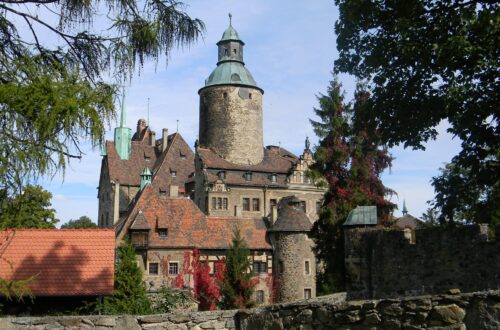
Czocha Castle Poland
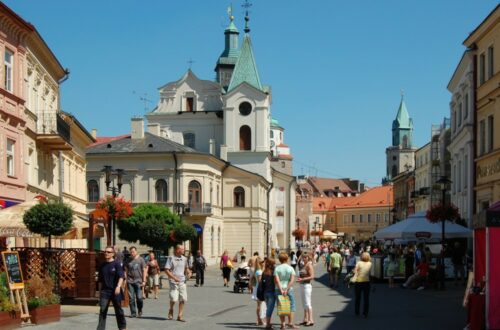
10 Top Things To Do In Lublin
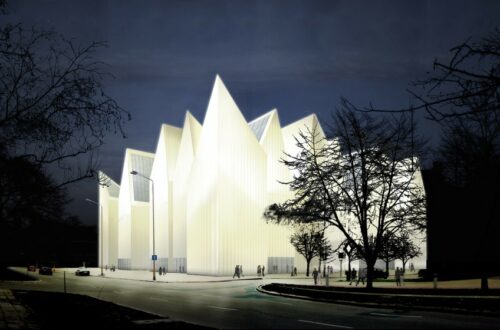
10 Top Things to Do In Szczecin
Hello, I really want to first appreciate your effort in putting this great website together and writing this article. Poland is a great country and a very beautiful place but I am still surprised that these places exist in poland. Gdansk is a place I have not visited before but you have ignited my interest with this well researched article. Thank you
I hqve been to Gdansk a few times and I must tell it’s one of the best place I have every visited,One place that made me fall in love with Gdansk is the fact that it home to the St. Mary’s Cathedral, which happens to be the largest brick church in Europe, with a capacity of 25,000 people,and also the fact that the city‘s special drink is the locally produced……..Golwasser liqueur with small flakes of gold floating in the bottle. It is believed that the elixir brings luck to those who drink it.
Leave a Reply Cancel reply
Your email address will not be published. Required fields are marked *

Best Places to Visit in Europe | Money
If you’re overwhelmed while planning for a European vacation, you’re not alone. There are so many popular destinations worth visiting that it can be difficult to pare down a list to chose from. How do you sort out which cities are too expensive, too crowded, or have the type of attractions you’re looking for?
Read on for an in-depth look at five European cities you might want to include in your travel itinerar y and check out our quick travel guide to help you plan the perfect European vacation.
Our Top Picks for Best Places to Visit in Europe
- Dublin, Ireland – Best tourist attractions
- Barcelona, Spain – Best theme parks
- Gdansk, Poland – Best historical destination
- Prague, Czech Republic – Best architecture
- Chania, Greece – Best beaches
Best Places to Visit in Europe Reviews
Best tourist attractions in europe: dublin, ireland.
- Free parks and hiking areas
- Accessible from other Western European destinations
- Inclement weather during off-season
Why we chose it : Dublin, Ireland is full of entertaining tourist attractions including castles, museums, free parks, historical sites and plenty of nightlife.
Dublin offers attractions to visitors of all stripes. Its well-maintained historical sites dating back to medieval times attract history buffs; its nightlife, whiskey and plentiful pubs make it a reveler’s delight, while its free parks and natural scenery make it an agreeable place for the whole family.
A few of Dublin’s most popular tourist attractions are:
- Trinity College Dublin : One of the oldest universities in Europe, with beautiful stone architecture and classical buildings. Several guided tours are available for a fee.
- National Botanic Gardens : World-renowned botanical gardens in the heart of Dublin. Entrance is free.
- Temple Bar : A popular nightlife district, centered around the famous Temple Bar Pub.
- Dublin Castle : A medieval castle that currently serves as a government complex. Tour costs vary by season.
- Phoenix Park : One of the largest enclosed public parks in Europe, free to visit.
On top of the attractions within Dublin’s city limits, you can also visit the castles, national parks, charming towns and beaches dotted throughout Ireland by renting a car or taking public transportation. Another advantage is that the city is highly accessible from other destinations — you’ll find affordable flights to Dublin from most major European cities.
Dublin can get crowded during the summer months and around the winter holidays. Prices for museums and tours also tend to increase during those months, so you’ll save money by traveling to Dublin in the off-season. Unfortunately, those winter months are when the weather can get unpleasant, blustery and rainy.
Despite the rain and cold, Dublin is an entertaining and accessible city to add to your itinerary as you explore Europe.
Best Theme Parks in Europe: Barcelona, Spain
- Sunny weather
- Good public transportation system
- Pricier than other destinations
Why we chose it : Barcelona has multiple amusement parks including the famous Tibidabo Amusement Park, one of the oldest theme parks in the world.
Barcelona, Spain is a bustling cultural center in Europe with plenty of attractions, including ancient architecture and world-class food. But the city’s whimsical side is also displayed in its variety of theme parks, water parks and rides.
Tibidabo Amusement Park is the oldest amusement park in Spain (and one of the oldest in the world). It’s situated on Tibidabo — the tallest hill in the area — with views of the surrounding city and ocean below. While there, you can ride the Ferris wheel and roller coaster or enjoy seasonal entertainment around Halloween and Christmas. Tickets cost €35 with the train ride up Tibidabo or €14 separately.
PortAventura Park, located about an hour outside of Barcelona, is another popular amusement park with rides, shows, restaurants and bars. It offers three hotel complexes, with one located inside the park — a fun option if you’re traveling with kids. Ticket costs vary by season but you can save money by buying them online before your trip.
Aside from theme parks, you’ll also find plenty of public parks, green spaces and sunny beaches in Barcelona. You should also be aware that, as part of the autonomous community of Catalunya, Barcelona stands out from the rest of Spain — residents speak Catalan as well as Spanish, the cuisine is unique to the region and prices are higher than in other smaller Spanish cities.
Best Historical Place in Europe: Gdansk, Poland
- Affordable destination
- Lively street markets
- Relatively cold, even in the summer
Why we chose it : In Gdansk, you can visit historical sites relevant to maritime history, World War II, the Solidarity movement and even medieval times.
Gdansk, Poland is a port city and historical merchant town on the northern coast of Poland. Although much of the city was destroyed during the Second World War, it has been rebuilt to match its original charm. The city’s Old Town maintains its Renaissance-style architecture, colorful buildings and street markets.
Along with Old Town, you can also visit Gdank’s many museums to learn about local history, including:
- Museum of the Second World War : Here, you’ll learn about the events of World War II from the perspective of Polish citizens.
- Museum of Gdansk : A Gothic/Renaissance-style building with modern and local art.
- Museum of Amber : Learn about the amber trade and its role in making Gdansk a thriving merchant town.
- Europejskie Centrum Solidarności : Roughly translated as the “European Center of Solidarity”, the museum is devoted to the history of Solidarity movement during Soviet rule in Poland.
Ticket costs to Gdansk’s museums vary by season but are generally less than $10 per person. Poland is one of the cheapest places to travel in Europe and has its own currency — you’ll pay less for attractions, food and lodging in Gdansk than in bigger cities like London, Berlin or Barcelona. However, that means you’ll have to exchange currency when you get there.
The weather also rarely gets warm, with average highs of only 63 degrees Fahrenheit in the summer. You also might encounter a language barrier in Gdansk as English isn’t as prevalent as in other major cities.
Best Architecture in Europe: Prague, Czech Republic
- Renowned Christmas markets
- Historical old town
- Cold and dark in the winter months
Why we chose it : Prague, Czech Republic is one of the few major Central European cities to make it through the 20th century with their historic architecture mostly intact, including its stunning Gothic and Romanesque buildings.
If you’re a fan of Gothic architecture, you’ll love walking the streets of Prague. The city’s Old Town is well-preserved from medieval times, with cobbled streets, winding alleyways and tall spires. Prague has an extensive and efficient public transportation system, so you can quickly get around the city without a rental car or taxi.
Some of Prague’s most notable architectural sites include:
- Charles Bridge : A medieval stone bridge spanning the Vltava River flanked by religious statues.
- Old Town Hall : Prague’s ancient city center with one of the oldest astronomical clocks in the world.
- Church of Our Lady Before Týn : An 11th-century Gothic-style church, open to public visitors.
- Schwarzenberg Palace : A Renaissance-era palace and current museum with Czech Baroque paintings.
There is no charge to walk around some of Prague’s most famous historical sites and take in the architecture, but you can pay for a guided walking tour to learn more about the history behind each building.
As beautiful as it is, Prague is also a very old city — you can see the impact of decades of pollution on the buildings, and the ancient, narrow alleyways can collect some litter. Prague can also be very cold in the winter months, making walking around and viewing the architecture less enjoyable.
Prague is more affordable than some Western European cities, so it’s a good destination if you want to visit Europe on a budget, even during the pricier summer months.
Best Beach in Europe: Chania, Greece
- Off the beaten path (compared to other destinations in Greece)
- Sunny weather even in the off-season
- Small streets can get crowded
Why we chose it : If you want to visit Greece’s crystal clear beaches without the crowds and high costs of other beach resort towns, try Chania, a harbor city on the island of Crete that offers beach weather even in late fall.
Chania, Greece — the second-largest city on the island of Crete — offers warm, sunny climate and hidden bays, making it a great destination if you’re looking for the best beaches in Europe. Unlike Mykonos and other popular Greek beach communities, Chania is off the beaten path for most tourists. Pleasant weather extends until late November, so you can beat the crowds and still enjoy plenty of warmth and sunshine.
While Chania itself is a port town with cobbled streets and wooden docks, there are plenty of sandy beaches within a short drive or boat ride from the city. The most popular beaches include:
- Elafonisi Beach : A white-sand islet, easiest to reach by boat.
- Balos Beach : A secluded beach accessible by road or boat.
- Falassarna Beach : A family-friendly resort area with a long, sandy beach surrounded by olive groves.
Chania offers affordable accommodations, diverse food options — including Jewish, Turkish and Middle Eastern cuisines — and fresh seafood. There is some nightlife, but the town is quieter than other destinations in Greece. You should also be aware that Chania doesn’t have the whitewashed, domed buildings or high cliffs other Greek towns are known for.
Other Places to Visit in Europe We Considered
Utrecht, netherlands.
- Less crowded alternative to Amsterdam
- Close to the Amsterdam airport
- Can be expensive
Utrecht, Netherlands has the cafés and canals of Amsterdam, minus the crowds and higher prices. It’s a quick train ride from Amsterdam Airport Schiphol and can be a stop on your Netherlands trip or a destination of its own. Although it isn’t quite as pricey as Amsterdam, the cost of food and lodging in Utrecht is still relatively high compared to other European cities.
Lisbon, Portugal
- Colorful architecture
- Great food options
- Crowded year-round
Lisbon, Portugal is one of Western Europe’s most popular tourist destinations. It is generally considered to have a laid-back vibe with charming cobbled streets, colorful buildings and spectacular coastal views. However, because it’s so popular, this city is crowded with tourists year-round.
Reykjavik, Iceland
- Abundance of natural wonders
- Vibrant nightlife
- Far from the rest of Europe
Reykjavik, Iceland is home to natural wonders like waterfalls, glaciers, volcanoes and even the Aurora Borealis. This is a great destination for nature-lovers but, if you’re planning on visiting multiple European cities on your trip, it might be challenging to work Iceland into your itinerary due to its distance from other European countries. Reykjavik might be best for a single-destination trip.
Places to Visit in Europe Guide
If you’re looking for the best international places to travel , you’ll find no shortage of bucket list destinations in Europe. Although it’s difficult to definitively rank the best cities to visit in Europe — or even the best countries to visit in Europe — we’ve compiled this quick European travel guide to help you plan your trip. Remember that the ideal destinations will depend on your priorities and when you’re traveling.
The basics of Europe
Before you start comparing the best airlines or best hotels for your trip, you’ll want to establish your priorities. It’s impossible to see every tourist destination in one trip but focusing on what you want to do and what your ultimate goals are for your trip.
Here are some things to consider to help you decide which European destination works best for your trip.
Europe has distinct regions based on culture, geography and language. The main generalized geographical areas of Europe are:
- Western Europe – This is where you’ll find some of the most popular European destinations including France, the Netherlands and the United Kingdom. These countries are often expensive to visit and can get cold in winter, but they also contain several global cities and important historical sites.
- Southern Europe – Spain, Italy and Portugal are all Southern European countries with typically sunny climates, Mediterranean cuisine and historic architecture.
- Central Europe – When visiting Germany, Poland or the Czech Republic you’ll find colder climates, as well as cultural and historic attractions.
- Eastern Europe – Estonia, Georgia and Croatia are examples of Eastern European destinations you might not have considered traveling to but that offer unique cultural experiences at an affordable cost.
Depending on the time of year you’re traveling, weather can make or break your trip. Western and Central European countries experience dark, freezing winters, making sightseeing challenging.
Despite being a relatively small geographical area, Europe contains hundreds of diverse cultures. You should expect different cultural norms regarding dining, public transportation and conversations everywhere you go. As a traveler, it’s always important to understand and respect the culture of the country you’re visiting.
Best time to visit Europe
Here are a few examples of seasons when you can make the most of your European vacation.
The best time to enjoy the weather in Europe
Weather in Europe varies drastically depending on the region you’re visiting. If you want the sunny beaches of the Mediterranean, you’ll enjoy the best weather between early spring and summer while late summer and fall bring higher temperatures and humidity.
The best time to backpack in Europe
If you plan to backpack and camp in Europe, you’ll want to travel in early or late summer. Pay attention to the rainy seasons! The United Kingdom, for example, is rainiest in spring.
The best time to cruise in Europe
Flying between European countries is fast and generally affordable, especially if you take advantage of some of the best airline rewards programs . But if you’re not in a hurry, a cruise can be a pleasant way to get to your next destination and do some sightseeing along the way.
Some of the best river cruises in Europe can take you through France, Italy or into Central Europe, with the best weather occurring during spring and summer. On the other hand, you might find discounted tickets for a cruise during colder seasons. If you don’t mind a little inclement weather, a cruise in the off-season can be an excellent way to save.
The best time to ski in Europe
For ski resorts, you’ll want to travel during winter or spring. Remember that mid-winter in Northern Europe means short days and long nights — you’ll enjoy more daylight if you travel in late winter or spring, toward the end of the ski season.
Best ways to travel Europe
One of the main differences between Europe and the U.S. is accessible public transportation in and between major cities. Train travel, boats and buses make it easy to get around without renting a car.
Budget airlines can be a good option if you’re visiting multiple countries. You might also get a good deal with the best airline credit cards .
Travel Europe by train
Train travel in Europe can be slow and luxurious or fast and efficient. For example, the Paris to Barcelona train is a direct route that takes less than a day and costs around €30. Many train routes in Europe are very scenic — plus, it’s a more environmentally friendly form of travel than airplanes.
Travel Europe by ferry
Ferries are an affordable option if you’re traveling around the Mediterranean or Baltic seas. You can find overnight ferries (for example, Helsinki to Stockholm) or quick trips, such as between Greek islands. If you plan on taking an overnight or multi-day ferry, book your ticket in advance and use the best travel credit cards to save money.
Travel Europe in group tours
All-inclusive European vacations can make it easier to plan your trip. Instead of booking multiple trips separately, you can book a group tour to see multiple countries with an organized schedule. Travel packages to Europe might be a little more expensive than an unstructured trip, but they remove the stress of planning and can be a comfortable option for an inexperienced traveler.
Things to consider when you travel to Europe
Here are a few more things to remember as you plan your European vacation.
Currency exchange
Many European countries use the euro, but not all of them do. Be sure to research the local currency in each destination country and be prepared to exchange cash. Remember that exchange rates are generally highest at airports and busy tourist areas.
Power adapters
Most of Europe uses a Type C outlet, and the United Kingdom uses Type G. A universal power adapter is a necessary purchase before any international trip.
Busy seasons
Most European destinations are busiest in summer when the weather is warm and kids are off from school. Travel during the busy season is fine, but you should know that attractions will be more crowded and potentially more expensive. If you can travel in the off-season, you might find better deals.
Conservation efforts
When traveling to a country known for its national parks, like Iceland, you’ll want to pay attention to local conservation efforts. National parks are periodically closed to protect sensitive wildlife.
This doesn’t just apply to natural scenery — museums and historical sites can also be closed for maintenance from time to time. Big Ben in London, for example, was closed to visitors between 2017 and 2023 to prevent it from wearing down.
Places to Visit in Europe FAQs
How do i plan a trip to europe, how much does a trip to europe cost, how many countries are in europe, how do i travel to europe on a budget, is it safe to travel to europe now, how we chose the best places to visit in europe.
To chose the European destinations covered in this article, we compared locations based on a few important factors, including:
- Safety : All destinations in this review have low crime rates and are safe to travel to.
- Reputation : We looked into the reputation of each of these cities based on reviews (and the author’s personal experience).
- Accessibility : You can reach these cities directly from the U.S. or major European cities.
- Things to do : We looked for cities that offer a wide variety of things to do, whether you’re traveling solo, as a group or with family.
Summary of Money’s Best Places to Visit in Europe
© Copyright 2023 Money Group, LLC . All Rights Reserved.
This article originally appeared on Money.com and may contain affiliate links for which Money receives compensation. Opinions expressed in this article are the author's alone, not those of a third-party entity, and have not been reviewed, approved, or otherwise endorsed. Offers may be subject to change without notice. For more information, read Money’s full disclaimer .
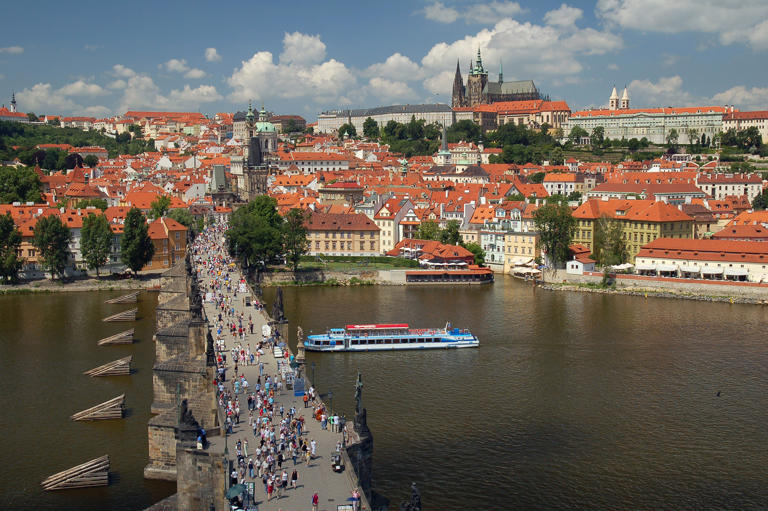

Promotions apply when you purchase
These promotions will be applied to this item:
Some promotions may be combined; others are not eligible to be combined with other offers. For details, please see the Terms & Conditions associated with these promotions.
Buy for others
Buying and sending ebooks to others.
- Select quantity
- Buy and send eBooks
- Recipients can read on any device
These ebooks can only be redeemed by recipients in the US. Redemption links and eBooks cannot be resold.

Download the free Kindle app and start reading Kindle books instantly on your smartphone, tablet, or computer - no Kindle device required .
Read instantly on your browser with Kindle for Web.
Using your mobile phone camera - scan the code below and download the Kindle app.

Image Unavailable

- To view this video download Flash Player
GDANSK TRAVEL GUIDE 2024: Unveiling the Historic Tapestry of Poland's Maritime Gem:Explore the rich history and cultural allure of Gdansk in 2024 Kindle Edition
Discover the Enchanting Wonders of Gdansk 2024: A Travel Guide by Catherine H. Hutchinson
Embark on an unforgettable journey through the heart of Gdansk with Catherine H. Hutchinson as your expert guide. This meticulously crafted travel companion is not just a guidebook; it's your passport to an immersive and extraordinary experience in this mesmerizing Polish city. Let the allure of Gdansk captivate your senses and transform your travel aspirations into unforgettable memories!
Unveiling gdansk's hidden gems, join catherine on a narrative-rich adventure as she unveils the secrets and stories behind gdansk's cobblestone streets, centuries-old architecture, and the pulsating energy of its cultural scene. immerse yourself in tales of the city's resilience, from its historic hanseatic league roots to its modern-day vibrancy., explore gdansk's highlights: your ultimate itinerary, - medieval marvels: wander through the picturesque old town, where every corner tells a story of the city's rich history., - amber elegance: delve into the world of amber at the amber museum, showcasing the golden gem that has been gdansk's treasure for centuries., - modern charms: experience the contemporary allure of gdansk shipyard and the european solidarity centre, where history meets the present., why this guide stands out, - fresh insights: catherine brings a local's perspective, ensuring you discover hidden gems that traditional guides miss., - up-to-date recommendations: navigate confidently with the latest information on restaurants, accommodations, and attractions., - traveler's toolkit: practical tips and tricks to make your journey seamless, from language essentials to local etiquette., secure your gdansk adventure today, ready to make your gdansk dream a reality order your copy now and receive exclusive access to catherine's curated tips, downloadable maps, and a bonus chapter on off-the-beaten-path adventures. elevate your travel experience and let gdansk's magic unfold before your eyes. don't just visit; immerse yourself in the soul of gdansk with catherine h. hutchinson's travel guide 2024, gdansk awaits - your adventure starts here.
- Print length 47 pages
- Language English
- Sticky notes On Kindle Scribe
- Publication date February 6, 2024
- File size 626 KB
- Page Flip Enabled
- Word Wise Enabled
- Enhanced typesetting Enabled
- See all details

Customers who viewed this item also viewed

Product details
- ASIN : B0CV5TJ6XC
- Publication date : February 6, 2024
- Language : English
- File size : 626 KB
- Simultaneous device usage : Unlimited
- Text-to-Speech : Enabled
- Screen Reader : Supported
- Enhanced typesetting : Enabled
- X-Ray : Not Enabled
- Word Wise : Enabled
- Sticky notes : On Kindle Scribe
- Print length : 47 pages
- #25 in Iceland & Greenland Travel
- #59 in General Poland Travel Guides
- #85 in 90-Minute Travel Short Reads
Customer reviews
Customer Reviews, including Product Star Ratings help customers to learn more about the product and decide whether it is the right product for them.
To calculate the overall star rating and percentage breakdown by star, we don’t use a simple average. Instead, our system considers things like how recent a review is and if the reviewer bought the item on Amazon. It also analyzed reviews to verify trustworthiness.
- Sort reviews by Top reviews Most recent Top reviews
Top reviews from the United States
Top reviews from other countries.
- Amazon Newsletter
- About Amazon
- Accessibility
- Sustainability
- Press Center
- Investor Relations
- Amazon Devices
- Amazon Science
- Sell on Amazon
- Sell apps on Amazon
- Supply to Amazon
- Protect & Build Your Brand
- Become an Affiliate
- Become a Delivery Driver
- Start a Package Delivery Business
- Advertise Your Products
- Self-Publish with Us
- Become an Amazon Hub Partner
- › See More Ways to Make Money
- Amazon Visa
- Amazon Store Card
- Amazon Secured Card
- Amazon Business Card
- Shop with Points
- Credit Card Marketplace
- Reload Your Balance
- Amazon Currency Converter
- Your Account
- Your Orders
- Shipping Rates & Policies
- Amazon Prime
- Returns & Replacements
- Manage Your Content and Devices
- Recalls and Product Safety Alerts
- Conditions of Use
- Privacy Notice
- Consumer Health Data Privacy Disclosure
- Your Ads Privacy Choices

IMAGES
VIDEO
COMMENTS
Gothic church in Old Town with a storied interior, historic astronomical clock, and panoramic city views from its towering bell tower. See ways to experience (45) 2023. 7. Oliwski Park. 701. Parks. Tranquil green space with mature trees, picturesque ponds, and canals.
Built in 1379 this church is meant to be the largest brick built church in the world. See ways to experience (45) 2023. 7. Oliwski Park. 701. Parks. By Prosiaczek. Park has its traditions and is blossoming from century to century, giving lot of relief for tourist coming to polish….
The original crane was believed to have been destroyed by fire in 1442, rebuilt two years later and is now a popular tourist attraction showcasing Gdańsk's maritime history. When standing under the crane, make sure to look up for the human hamster wheel, which powered the mechanism. 10. Peek inside Oliwa Cathedral.
Gdańsk's Old Town, rebuilt after the Second World War, is a trelliswork of streets skirted by tall patrician and merchant tenements, while hulking gates defend the landward and water-side entrances. Let's explore the best things to do in Gdańsk: 1. Trakt Królewski (Royal Way) Source: MoLarjung / shutterstock. Dluga Street, Royal Way, Gdansk.
When you are done exploring all the stunning buildings and museums of the Gdansk Old Town, visit Piwnica Rajców, a multi-tap bar, to taste a true Polish beer. 3. Visit the National Museum of Gdansk. The history and culture of Gdansk are best portrayed in the National Museum of Gdansk, one of the major museums in Poland.
Discover the best attractions in Gdańsk including Museum of WWII, European Solidarity Centre, and St Mary's Church. Lonely Planet. Destinations. Planning. Inspiration. Shop. Search. ... The most atmospheric of all Gdańsk's streets and one of Poland's most photogenic lanes is this length of cobbles between the waterfront St Mary's Gate and
The best things to do in Gdansk always include a visit to the Neptune Fountain. The beautiful sculpture of the Roman god of the sea is a must-see for any tourist, and it's a great place to take a photo. The fountain is located in the center of the city, and it's easy to find. Just look for the big statue of Neptune!
Things to Do in Gdansk, Poland: See Tripadvisor's 208,598 traveller reviews and photos of Gdansk tourist attractions. Find what to do today, this weekend, or in May. ... We thought we'd take a quick look as we had free entry with the Gdansk tourist card but ended up spending about 3 hours in there! Very interesting and we learnt a lot about WWII.
All in all, Gdańsk is one of my favorite cities in Poland, and I think it will become yours if you choose to visit. Table of Contents. Best Things to do in Gdańsk: City Icons. 1. Explore the streets of the Old Town. 2. Explore the famous canals of Gdańsk. 3. Visit the historic Town Hall.
Gdańsk is a major port city on the Baltic Sea coast in northern Poland. It is located at the mouth of the Motława River and lies in the Pomeranian Voivodeship, of which it is the capital and largest city. Gdańsk forms part of the Tricity metropolitan area and the nearby cities of Gdynia and Sopot. Gdańsk is in the Pomeranian Voivodeship, the province's capital and largest city, with a ...
17 Amazing Things to Do in Lublin, Poland. The Complete Guide to Visiting Slownski National Park, Poland. Visit Grudziadz - One of the Hidden Gems of Poland. Visit Sandomierz, Poland - One of the Prettiest Towns in the Country. Visiting Malbork Castle, Poland - the Largest Castle in the World.
Check out with Gdansk's attractions can you see free of cost with a Tourist Card. Read more ... Business tourism Thanks to its geopolitical location, access to the sea, rich cultural heritage and well developed network of sea and air connections, Gdansk is one of the fastest emerging and developing locations In Europe. ...
Top 20 Tourist Places to Visit in Gdansk, Poland. 1. Basilica of St. Mary (Bazylika Mariacka) This marvelous Gothic Basilica is among the three largest brick-built churches in the world. It was built in the 14th century and is still one of the most dominant structures you will come across during Gdansk sightseeing.
Poland, Europe. Like a ministate all to itself, Gdańsk has a unique feel that sets it apart from other cities in Poland. Centuries of maritime ebb and flow as a major Baltic port; streets of distinctively un-Polish architecture influenced by a united nations of wealthy merchants who shaped the city's past; the toing and froing of Danzig ...
Inspirational. Gdansk is an exceptional city and houses two of the best museums in Poland, the Second World War Museum and this, on the Solidarity Movement and Lech Walesa's extraordinary leadership which led to first steps to democracy in a nation oppressed by aggressors. We were fortunate to have a local guide provided by our group tour.
It houses many of Gdansk's main attractions, a good selection of restaurants, cafes and bars and a nice range of hotels. ... 17 Top Tourist Attractions in Poland. 15 Top Tourist Attractions in Krakow, Poland. Primary Sidebar. Search this website. Latest. The 10 Best Things to do in Rab, Croatia.
1. The European Solidarity Centre. Building, Museum. Share. Add to Plan. The European Solidarity Centre is a very new museum, situated in the Gdansk shipyard. However, it has already become one of the best tourist attractions in the city. It is spectacular in both its design and the exhibitions it contains.
Getting to Gdańsk, Poland: Transportation Options and Travel Tips. Traveling to and from Gdansk is a breeze with affordable train options (around $10 USD) connecting you to the city, conveniently located just a 10-minute walk from the Old Town. The FLXBUS is an economical alternative for traveling within Poland.
10 Best Things to Do in Gdansk. 1. Walk the Length of the Long Market. One of the most notable tourist attractions in Gdansk, and one you shouldn't miss, is the Long Market. It got its name from the length of the strip that draws a 500-meter straight line across Gdansk Old Town, stretching from the Green Gate to the Golden Gate. The Long Market ...
Additionally, the Gdansk Tourist Card covers entry into many sights. Gdansk Tourist Card. The Gdansk Tourist Office offers three money-saving cards for attractions in Gdansk: Family, Sightseeing and Active. The cards offer entry into some of the best things to do in Gdansk, Poland! Go to the Gdansk Tourist Card website for more information.
Known as one of Poland's most important port cities, doused in a blend of old-world architecture and modern features, Gdansk has numerous activities and attractions that will entice even the most well-traveled adventurer into falling in love with this historic city. Start your adventures walking into the historic center of the city like the Polish monarchs through The Golden Gate, and make ...
10. Monument to the Fallen Shipyard Workers. The northern edge of the Old Town in Gdansk's has its name stamped in the history books of the city. It is home to the Monument to the Fallen Shipyard Workers. Formerly known as the Lenin Shipyards, this attraction was built to honor the worker's struggle in December 1970.
Dublin, Ireland - Best tourist attractions; Barcelona, Spain - Best theme parks; Gdansk, Poland - Best historical destination; Prague, Czech Republic - Best architecture; Chania, Greece ...
Buy GDANSK TRAVEL GUIDE 2024: Unveiling the Historic Tapestry of Poland's Maritime Gem: ... - Up-to-Date Recommendations: Navigate confidently with the latest information on restaurants, accommodations, and attractions. - Traveler's Toolkit: Practical tips and tricks to make your journey seamless, from language essentials to local etiquette. ...